

How to Spend Two Weeks in Cuba: An Itinerary for First-Time Visitors
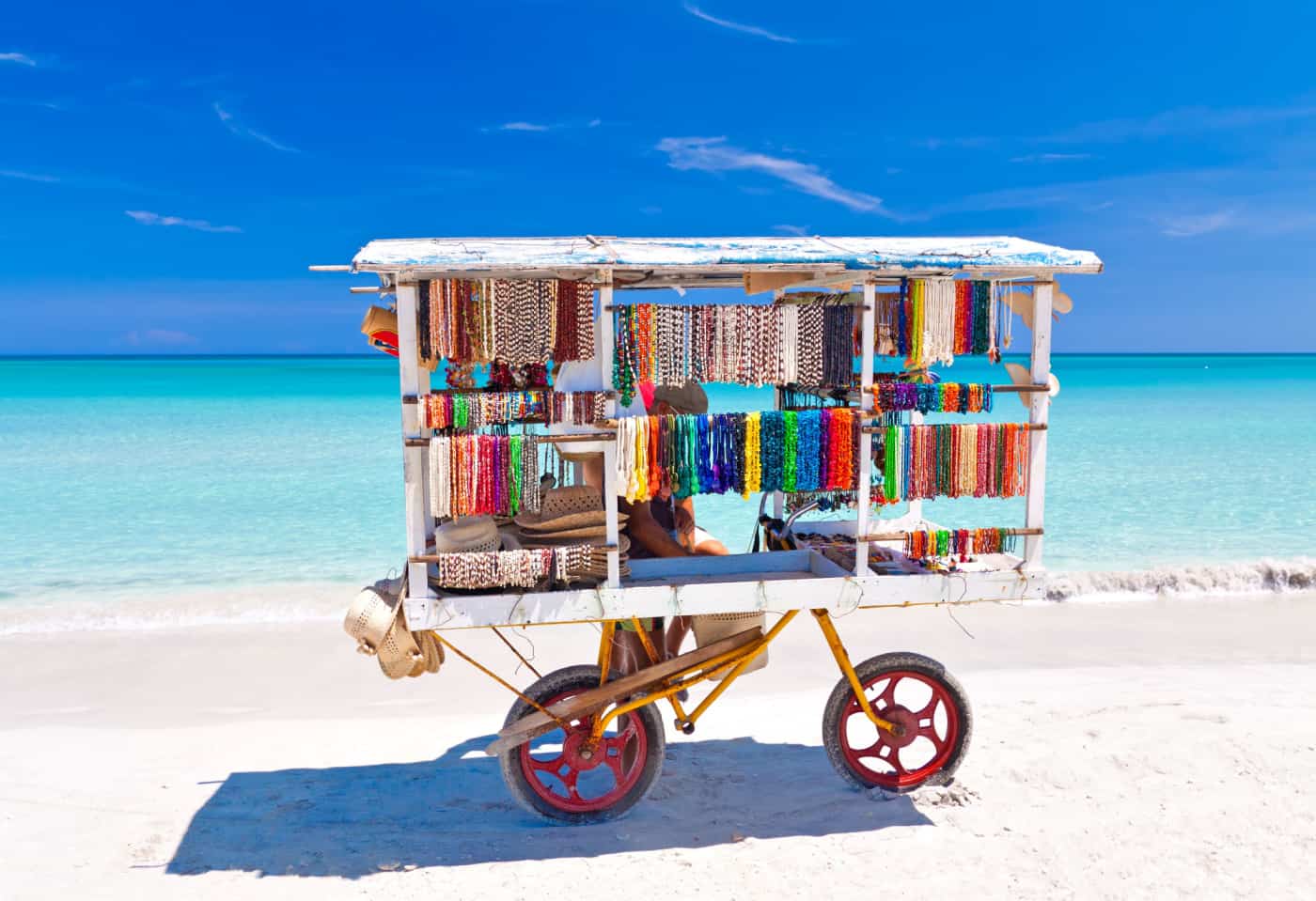
Cuba is entirely unique.
From the crumbling facades of Havana old town to the lush valley of Vinales and the pristine beaches of Varadero, there’s a lot to fit into two weeks in Cuba. You will fall in love with the salsa rhythms of the warm Caribbean evenings, find modern paladares with some amazing Cuban cuisine, and explore a surprisingly biodiverse country full of secret waterfalls and dense jungles.
But it’s the people of Cuba that are the most welcoming. Spending just 14 days in Cuba gives you a sense of an entirely unique culture that’s resourceful and resilient, but above all, happy. A turbulent history of revolution, communism and trade embargoes has given this island a ‘stuck-in-time’ feel that many of us in the Western world long for.
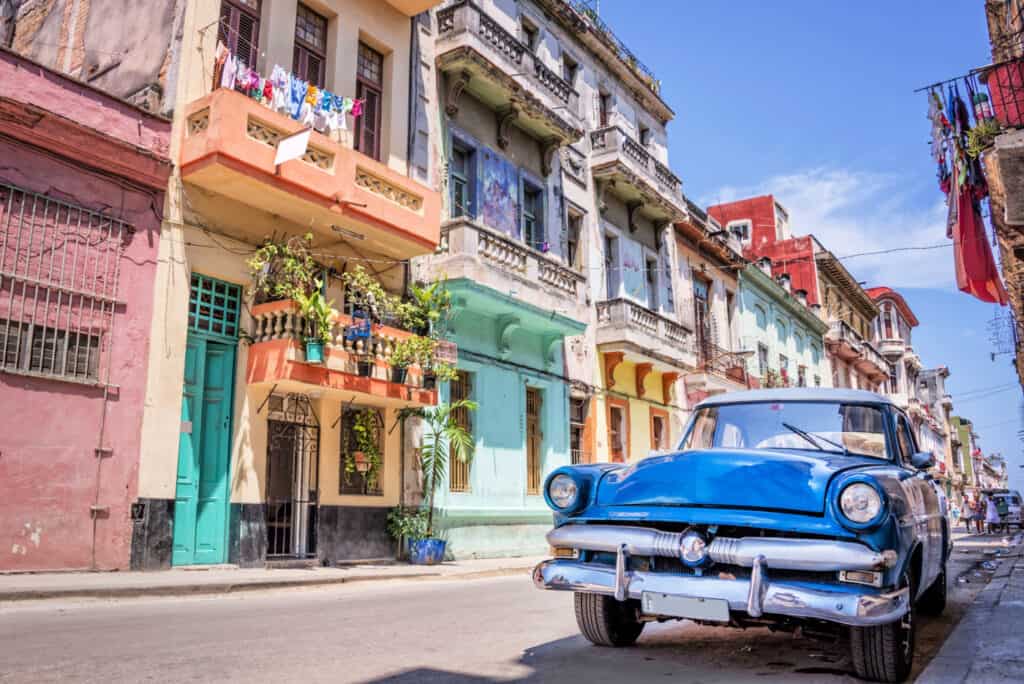
Getting Around in Cuba
Of course, it isn’t exactly a small country, and you couldn’t possibly fit everything into just two weeks in Cuba. Especially with the Cuban transport and road network being the way that it is. But if you focus on specific places that each show a different aspect, you can get a great insight into this wonderful country.
Cuba doesn’t have a fantastic rail infrastructure like Japan or the cheap overnight buses of South America . Getting anywhere takes a long time, it’s best to hire a local driver or book buses through a hotel if you’re traveling around Cuba for two weeks.
Rather than trying to fit a lot into your Cuba itinerary, enjoy spending a little time in each place. Of course, the slow pace of life does have its benefits; Ernest Hemingway came for a short visit and stayed twenty years!
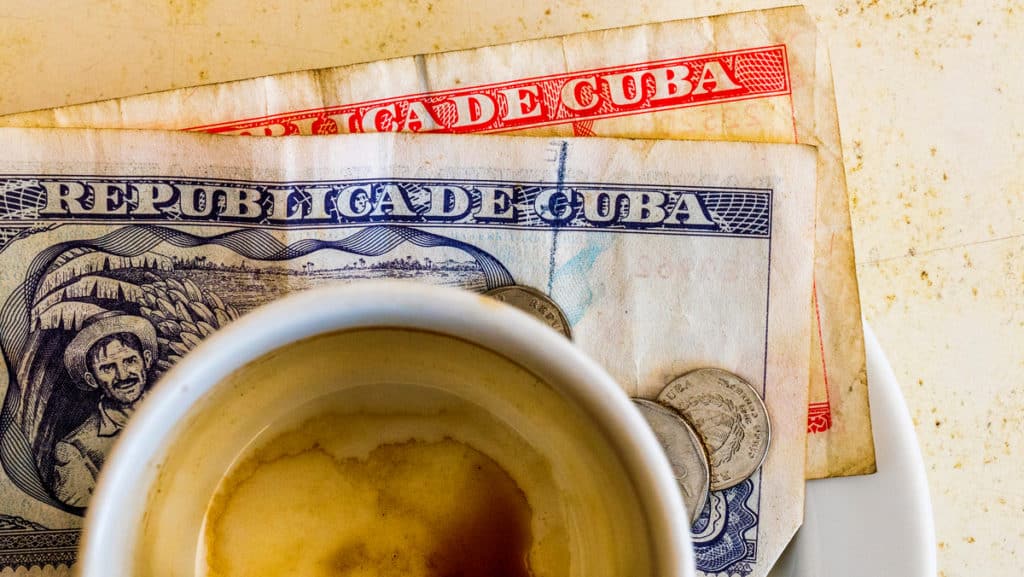
Money in Cuba
There used to be a tourist currency (CUC) and a local currency (CUP), but thankfully this confusing system has been phased out by the government leaving just Cuban pesos as the sole currency. You can’t buy Cuban currency outside of the country or with an American bank account so make sure to take enough cash to exchange. ATM’s can be found in the cities, but are few and far between in remote areas and in various states of disrepair. Cards are not widely accepted either due to the lack of reliable internet connections. I have a detailed guide to travel costs in Cuba if you’re keen to read more.
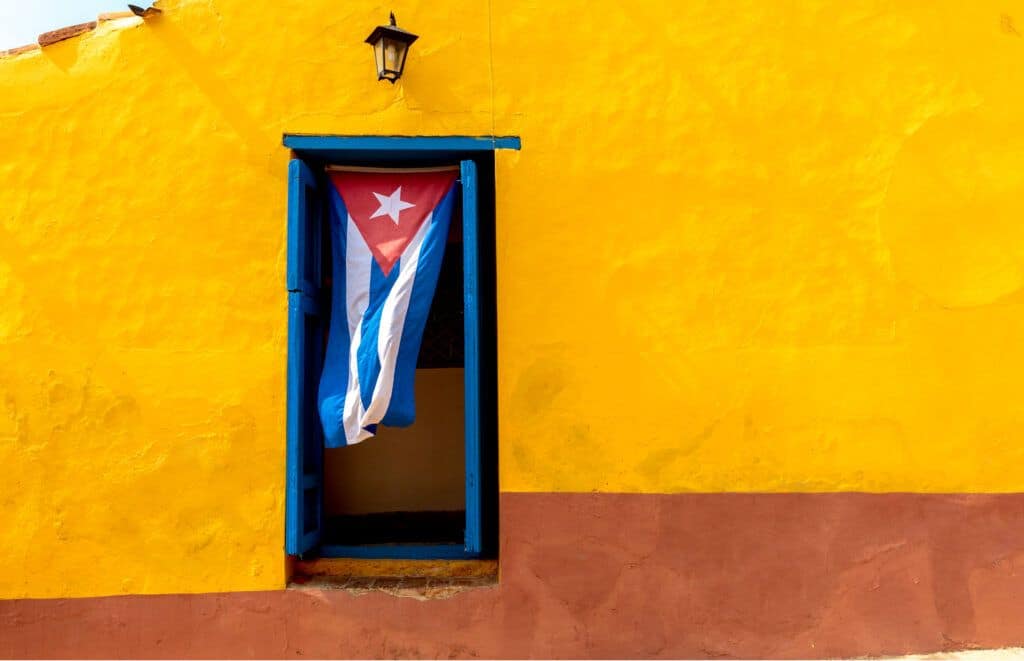
How to Spend Two Weeks in Cuba
Our Cuba itinerary starts with 3 nights in Havana, then heads out to cigar country in Viñales for a 3-night stay. We then spend 2 nights in Cienfuegos, 2 nights in Trinidad, and take time out with a 3-night beach retreat at Varadero. Finishing with the last night in Havana, to ensure we can easily make it back to the airport on time!
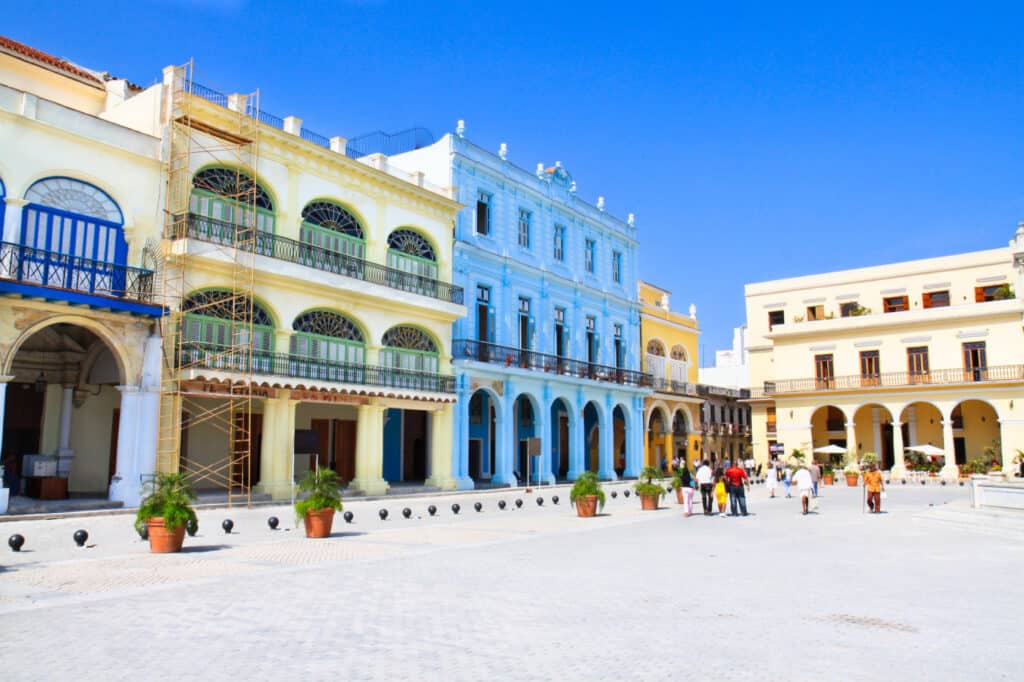
Day One: Arrive in Havana and Acclimatize
Cuba can be a bit of a culture shock. Even if you’re an accomplished traveler, Cuba has unique oddities that separate it from the rest of the world. Firstly, say goodbye to being connected 24/7, or maybe even at all.
Although there is some Wi-Fi in big hotels (like Hotel Inglaterra in Havana), the rest of the country remains disconnected. Wi-Fi hotspots in places like Vinales see crowds of teens huddled around them, desperate to stay updated with the outside world.
So, you can forget about getting any updates unless you want to relive the dial up speeds of the late ‘90s, but it does have its benefits. Cuba gives you a chance to disconnect from modern life and get back to seeing a place through your own eyes rather than distorted through a screen.
Spend the first day easing yourself into the pace of life in Havana. I recommend staying in the old town. It’s touristy, but it’s also close to everything. In my mind it’s not worth wasting time bartering with taxis or getting lost on public buses when you can stay right in the heart of it all.
Wander the cobblestone streets and head over to the old town square Plaza Vieja. Built in 1559 this square is full of the crumbling facades and colorful paintwork that make Havana so iconic. Pop up to Cámara Oscura for an unusual view of the city, then head over to retro 50’s bar La Vitrola for some of the best cocktails around. The food is a mix of Spanish tapas and traditional Cuban cuisine.
A great place to stay in the old town is Residencia Santa Clara . The rooftop terrace is great for evening drinks, with great views over the city. The hosts are wonderful, and they make you feel like you are part of the family.
The house itself is well designed, spacious and each room comes with a bathroom with a rainfall shower. I love that the hotel offers such a generous breakfast, and the coffee is super strong!
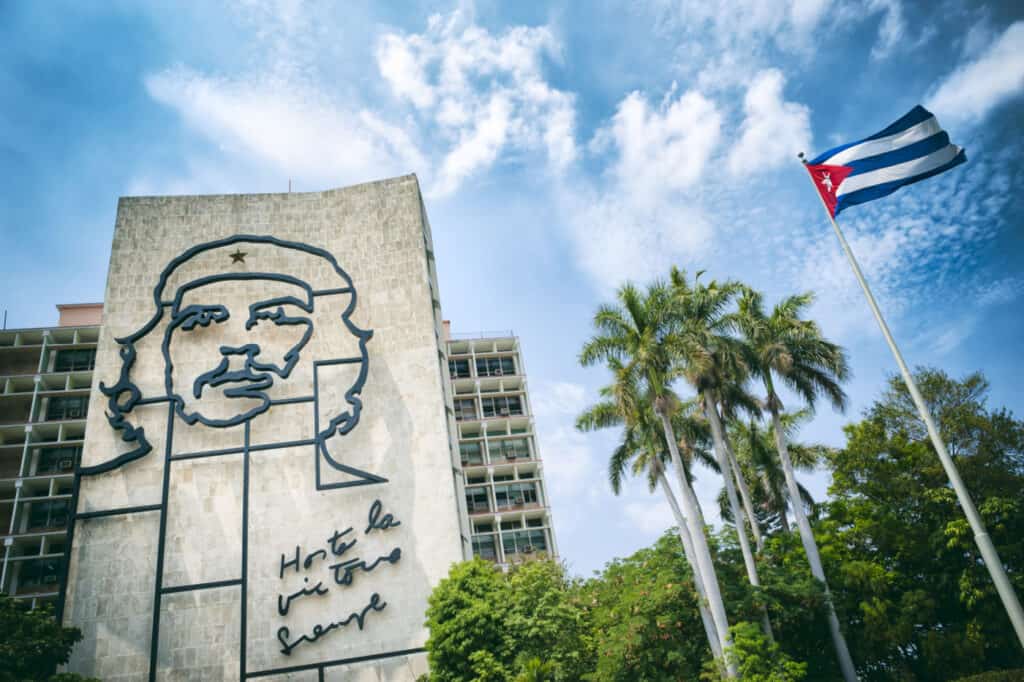
Day Two: See the Sights of Havana in a Vintage Car
A great way to get your bearings and fit in a lot of the more spread-out sights in Havana is by taking a classic car tour. Pick the best-looking vintage car from the parade at Parque Central and tour the city in style. And yes, my choice always is a bright, Barbie pink!
Seeing the city in the way easily beats the Havana hop-on-hop-off bus that’s also available in nearly every other capital city.
We were so enamored with our 1950’s Ford Thunderbird that we neglected to check that the driver could speak English on our second visit to Cuba. And so, my biggest tip here is that if you want an informative tour, always check your drivers spoken language and tour route before you hop in!
The driver will usually take you out to Vedado, past many beautiful colonial buildings and wide boulevards. A stop at Plaza de la Revolución is a must to grab snaps of the great monuments to the imposing revolutionaries of Cuba. These include the iconic portrait of Che Guevara, heroic guerrillero Camilo Cienfuegos, and the José Martí Memorial. The square serves as the base of the Cuban government and hosts large-scale political rallies and events like the pope’s famous visit.
You will also likely visit a small park with a familiar Liverpudlian seated on a bench. Although he never visited Cuba, John Lennon Park was created by the communist Cuban leader Fidel Castro as an ode to a “fellow dreamer”. There’s also a full-time security guard loitering around the bench, looking after Lennon’s iconic glasses.
Back at Parque Central you can’t miss the grand golden cupola of the National Capitol of Cuba. The whole area is full of baroque buildings that wow at every turn. Spend the evening next door, catching a show at the Grand Theater of Havana. The impressive architecture of the palatial theater built in 1838 is worth the entry fee alone.
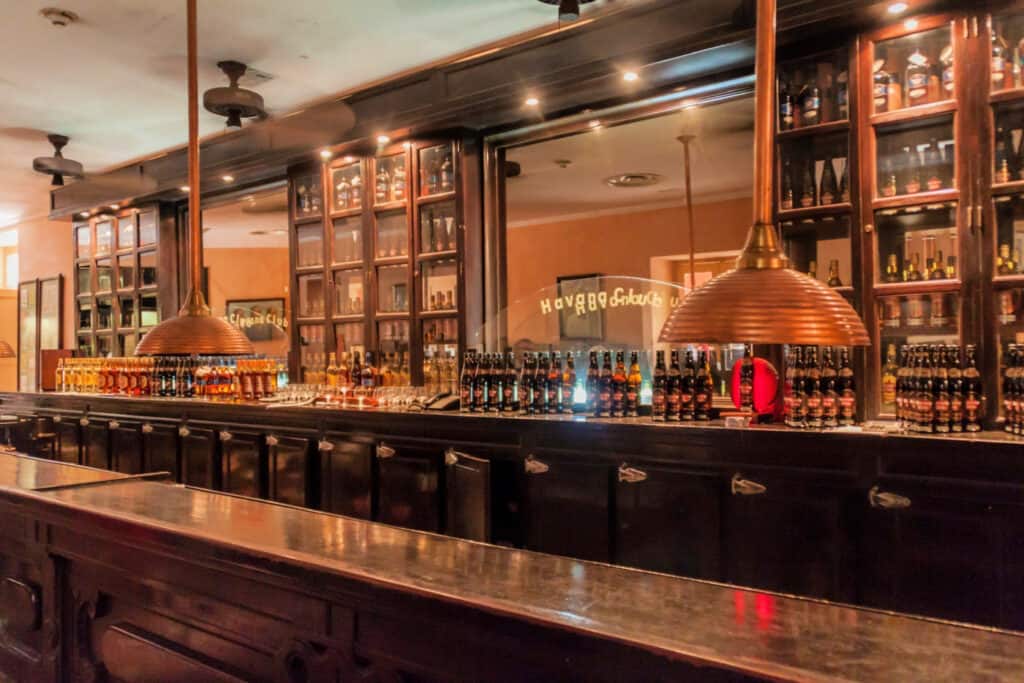
Day Three: Visit the Museums of Havana
For your third day in Havana, dig a little deeper by visiting some of the best museums in the city. The Museo Nacional de Bellas Artes holds some of the most important art in Cuba. There are 24 rooms with more than 45,000 works, there are also art pieces from the ancient world with collections from Rome, Greece, and Egypt.
Head over the road to El Floridita Bar for a quick refreshment at one of the most famous bars in the city, you might not get a table as this place gets super busy, but the interior is worth a look if you’re nearby.
Remaining on the drinks theme, Havana Club Museo Bar is the place to learn all about the globally exported tipple. Havana Club Rum is a big deal in Cuba, learn all about the rum-making process, from the sugar cane itself to a scale model factory. Tasters are usually free too!
You can also visit the Museum of the Revolution housed in the former presidential palace. This museum pays homage to the country’s greatest revolutionaries as well as Fidel Castro’s famous yacht. Another option that’s great for children is the Natural History Museum or ‘Museo Nacional de Historia Natural de Cuba’ located in the center of Havana at the Plaza de Armas. It’s full of natural wonders and a great place to learn about the diverse life on this island.
Spend the late afternoon climbing the bell towers at La Catedral de la Virgen María de la Concepción Inmaculada de La Habana. Get some great views over the city and explore one of the best churches in Havana. It’s advised to wear long pants as a mark of respect, or wraps are provided to cover bare legs.
Havana has some of the best food in Cuba, so don’t miss eating at one of the many great restaurants, or paladares, while you’re in the city. Try Ropa Vieja (shredded beef) at La Lluvia de Oro restaurant or for some of the best traditional Cuban cuisine visit Los Mercaderes.
For evening drinks there’s no better place than La Bodeguita Del Medio. It’s one of the most famous watering holes in Havana, with walls covered in messages and pictures of famous visitors. There’s only one thing to drink here, a mojito. A popular spot with the mint cocktail loving author, Ernest Hemmingway, this place is usually busy with tourists, but the music and the friendly staff always make everyone feel welcome.
Of course, for a real slice of Havana life, visit the Malecón at sunset. Spot couples out on a date, families taking an evening walk and businessmen on their way home from work. All walking along the promenade taking in the last sun kissed views of the city before nightfall.
You can arrange your onward travel by bus through a hotel or tourist information point or arrange a collectivo (share taxi) or private driver through your casa particular.
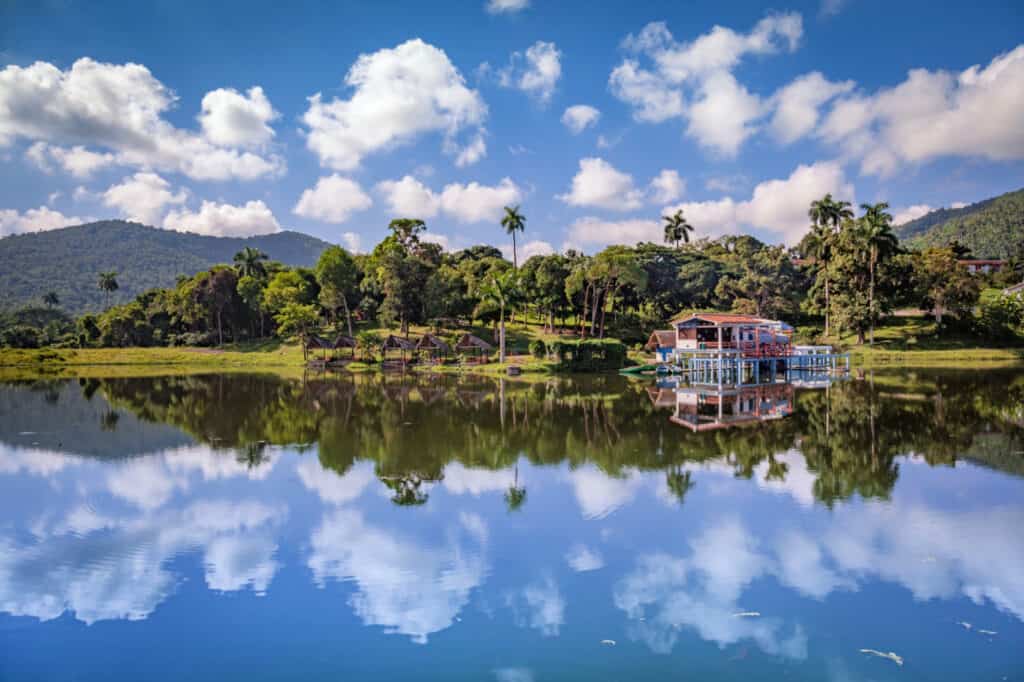
Day Four: Stop at Las Terrazas on the Way to Vinales
On the way to your next casa particular in Vinales, stop off at Las Terrazas. Started in 1968 as an ecotourism project, the area contains over half of Cuba’s native birds; it’s home to 117 species of birds in total, and 12 of them are endemic.
Fidel Castro enlisted Camilo Cienfuegos’s brother to build 1,360 kilometers of terraces to combat erosion, resulting in a self-sustaining community with roads, homes, and schools. Locals include an entire artist colony, who live and work in the area full time.
The community planted an astonishing seven million trees between 1968 and 1978. Then it was designated a Biosphere Reserve by UNESCO in 1984. It’s the perfect stop for lunch and a hike. Las Terrazas is located in the Artemisa province in the Sierra del Rosario mountains, on the way from Havana to Vinales.
Many tourists never stop here, but locals often visit Las Terrazas as a day trip from Havana. Visit community projects like the Aire Libre café, the Casa-Museo Polo Montañez and the Moka Hotel. There’s also Cuba’s first zipline, with six lines surrounding the local village, and horseback riding along the San Juan River.
If, like us, you love hiking, the Sierra del Rosario has some amazing options. Climb Taburete Mountain, visit the ruins of the San Ildefonso and El Contento coffee plantations, or take the easy six kilometer hike up to the Santa Serafina Coffee farm. It’s best to hire a local guide for all of these though, as the trails aren’t marked and it’s pretty easy to get lost!
Then travel onto your casa particular in Vinales to relax for the night. Stay in the heart of town to be close to everything. Casa Esperanza Tuta features air conditioning, private bathrooms, and mountain views. We loved the hosts – they went above and beyond to make our stay as comfortable as possible. And the continental breakfast, with locally grown fruit, is amazing.
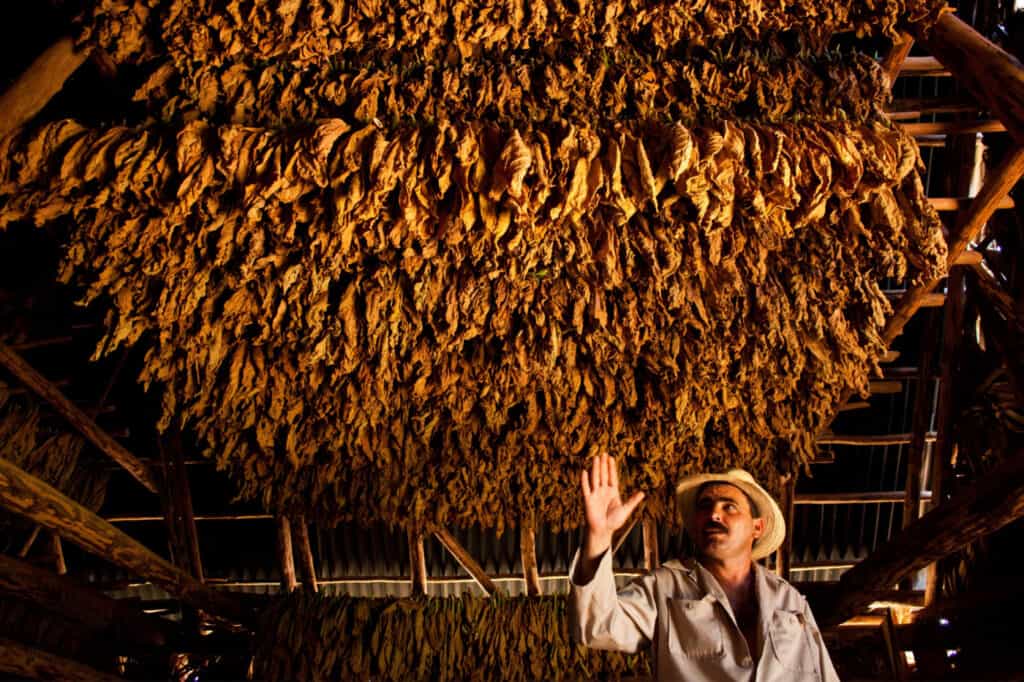
Day Five: Discover Where Real Cuban Cigars are Made
Vinales is a beautiful part of Cuba to visit, with its lush green valleys and large limestone outcrops. These towering cliff-like structures are known as mogotes, they can rise as high as 300 meters in this area and dominate the landscape.
Vinales is best known for its tobacco and coffee plantations, take a tour to find out how the locals grow, harvest, and produce these vital commodities. These aren’t the polished, flashy coffee tours of Costa Rica or the organized tours of coffee plantations in Colombia .
These tobacco and coffee tours are the real workers taking you around their farms. There’s usually a healthy amount of rum involved! And of course, at the end you have the chance to buy their products straight from the source (at heavily discounted prices, which I can highly recommend).
Avoid buying fake cigars from street sellers in places like the Malecon in Havana and get them here instead. Cuba is of course well known for its cigars, but if you’ve never tried the coffee be prepared for a kick! It’s some of the strongest coffee in the world.
A mixture of how the beans are grown and how the coffee is made makes for an intense caffeine hit. Even the most avid caffeine addict might get a shock from the strength of Cuban coffee.
In the afternoon hire a bike to explore Vinales, you can visit the nearby Mural de la Prehistoria and see the many beautiful views of the valley. Explore the backstreets and get a sense of the quiet country life in Cuba.
Return to your casa to enjoy a beautifully home cooked meal. There are usually three choices; chicken, pork or lobster, served with rice and a tasty assortment of local vegetables and fruit. You will probably get to try them all if you’re in Cuba for two weeks.
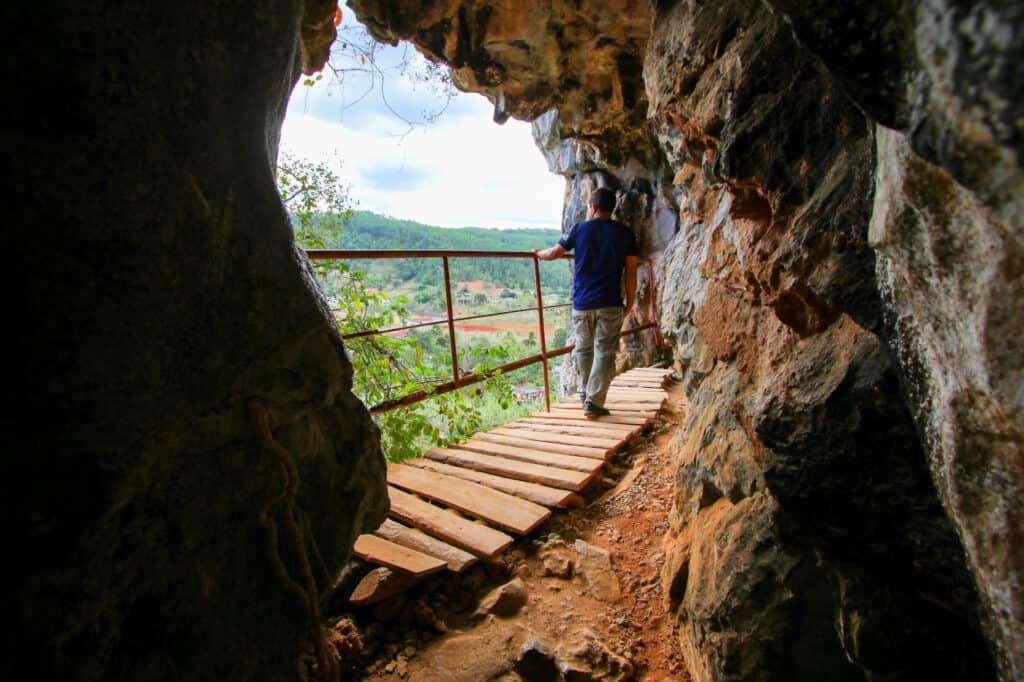
Day Six: Go Caving in Vinales
On your last day in Vinales, you could do other farm tours or simply relax around town. But for something a bit different, take a day trip from Vinales to visit the largest cave system in Cuba.
Gran Caverna de Santo Tomás is just a 30-minute drive away and is composed of more than 46 km of galleries in eight different levels. Take a 90-minute guided tour to see the stalactites and stalagmites, underground pools, and other interesting rock formations.
Your casa particular should be able to arrange a driver, and maybe even the tour. Cubans are entrepreneurs and everyone knows each other in these small towns. Don’t be surprised if you find one person doing multiple jobs; tour guide, driver, cook, entertainer!
In the evening make sure not to miss the music and dance venues that line Cisneros Street. 3J Bar Tapas is a great place to grab a rum, pull up a rocking chair, and watch the world go by.
Vinales is the perfect place to get a sense of Cuban life outside the city. There may not be an amazing internet connection or public transport, but everyone is smiling, and help is never too far away.
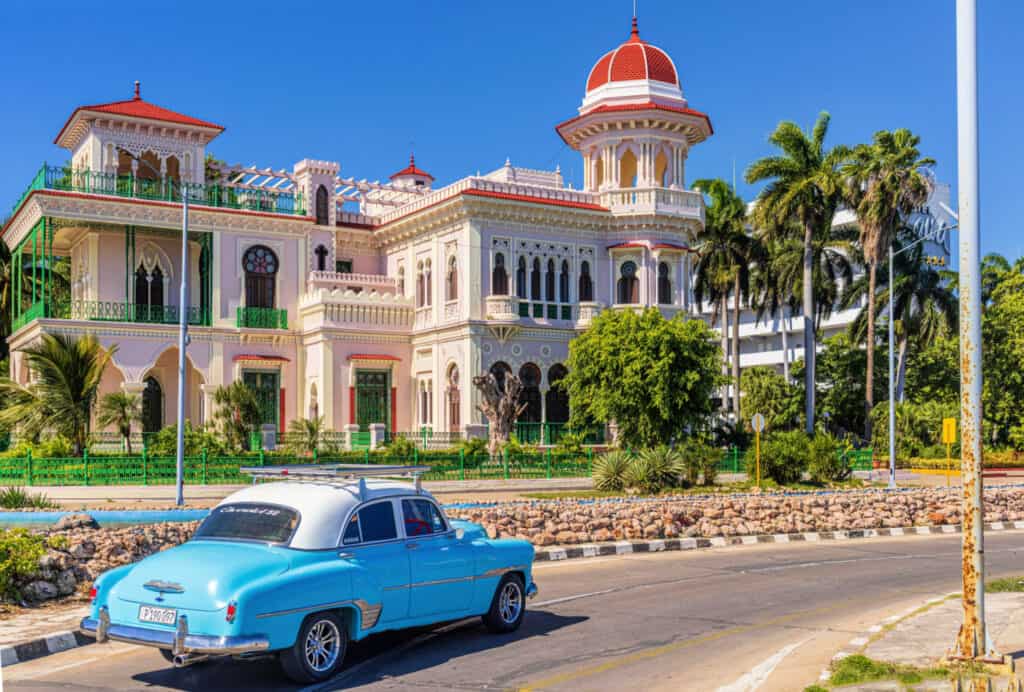
Day Seven: See the Architecture in Cienfuegos
Next up is a visit to Cienfuegos, which translates to ‘One Hundred Fires’. The city was founded in 1819 by French immigrants from Bordeaux and Louisiana, and you will notice the buildings have strikingly different architecture to the rest of Cuba.
There is an unusual combination of Baroque, Gothic and Moorish styles. Visit the Jose Marti Park and the central plaza on your first day to get a taste of the city. Many say it’s the most beautiful main square in Cuba.
A visit to La Reina Cemetery is also a must while in the city. Declared a national monument in 1990, the impressive statues and headstones make it one of the most interesting places to visit in the city.
In the evening head to the well-known Te Quedaras restaurant for traditional Cuban food, great drinks, and a lively atmosphere. We loved the pina coladas, and the Cuban music playing well into the night.
Stay at the Casa Buena Vista for bright airy rooms right in the center of Cienfuegos. The eclectic design, with everything from old vinyls to patron saints stuck to the walls, made us fall in love with this home from home. The terrace and lively bar are also fantastic for meeting other guests.
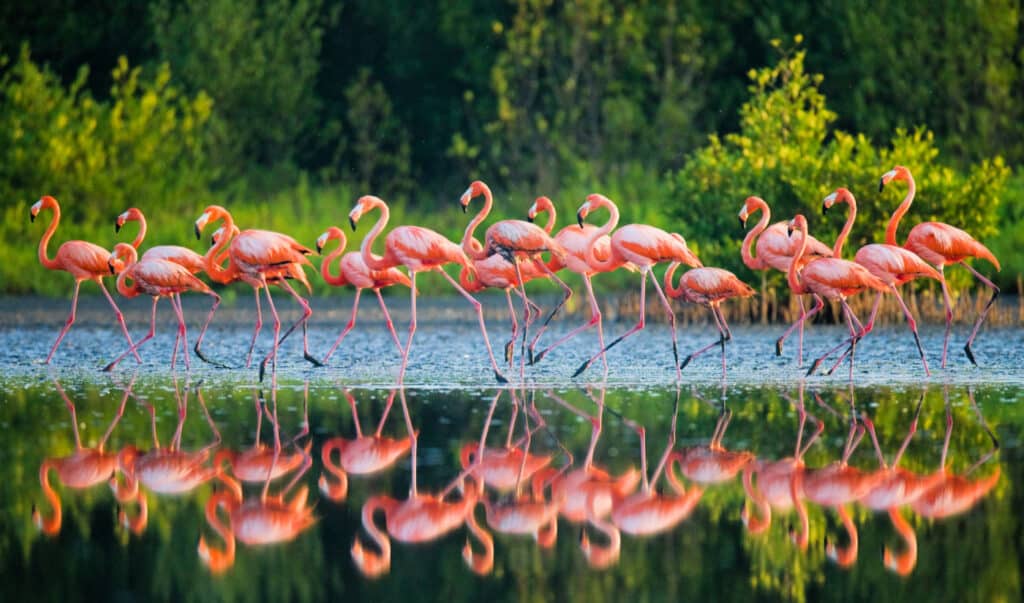
Day Eight: See Flamingos and Bathe in Waterfalls in Cienfuegos
On your second day in Cienfuegos, explore the surrounding area with its diverse landscapes and abundant wildlife.
For a chance to spot pink flamingos head to Laguna Guanaroca, just a 30 minute drive out of the city. Take a guided tour of the lake to learn about the local wildlife, flora, and fauna that make this part of Cuba their home.
Another option to get out of the city for a while is a visit to El Nicho, a beautiful and popular swimming hole fed by waterfalls. A round-trip taxi will cost you about U.S. $30 from Cienfuegos center. It’s a great way to cool off in the summer heat and hang out with the locals.
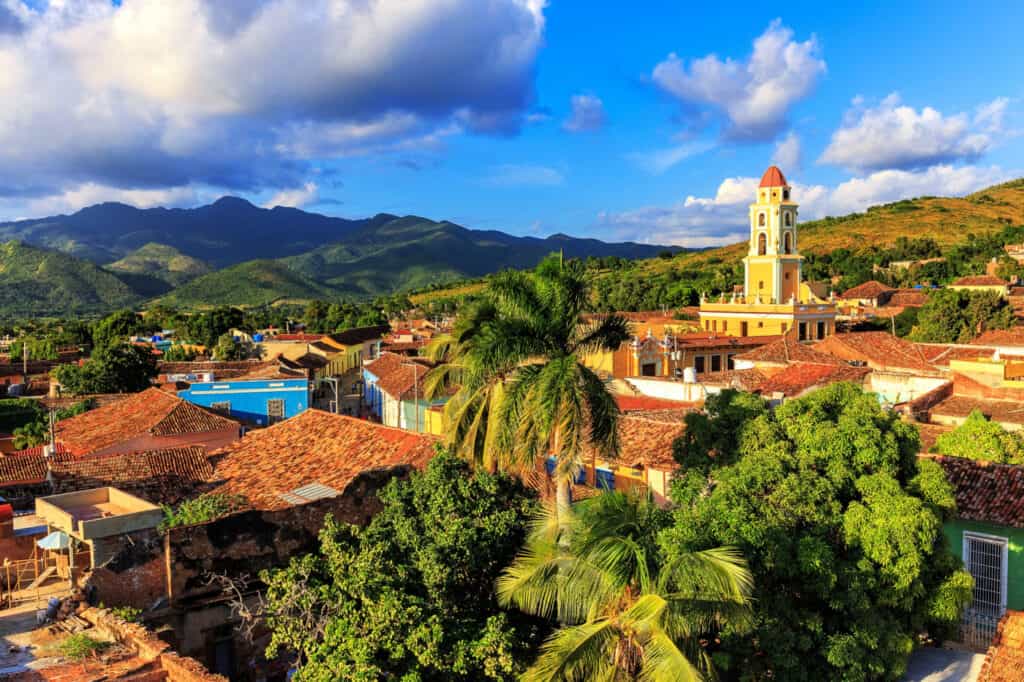
Day Nine: Visit the Historic City of Trinidad
Travel east to Trinidad on day nine, and the furthest point on your trip around Cuba.
Trinidad is the Cuba you’ve always imagined. Colorful houses, straw hats and cigar toting locals. It’s the second oldest city on the island. Trinidad was founded in 1514 and declared a UNESCO World Heritage site in 1988.
Visit Plaza Mayor to see the beautiful 17th-century structures and get to the heart of the local culture. Grab a coffee and watch the world go by as you soak in the atmosphere in this lively, picture-perfect town. Or take a walking tour of the area.
Get some of the best views over town from Museo Nacional de la Lucha Contra Bandidos. Then in the evening visit one of the music venues hidden in an underground cave, like Disco Ayala.
Stay at Casa Barmarin , located in the pedestrian area of Trinidad, right between the markets. The tranquil gardens and rustic rooms are stylish and full of eco-friendly little touches, but the casa still retains its Cuban charm. A highlight is the outdoor terrace and seating area, the perfect place to unwind from a busy day’s sightseeing.
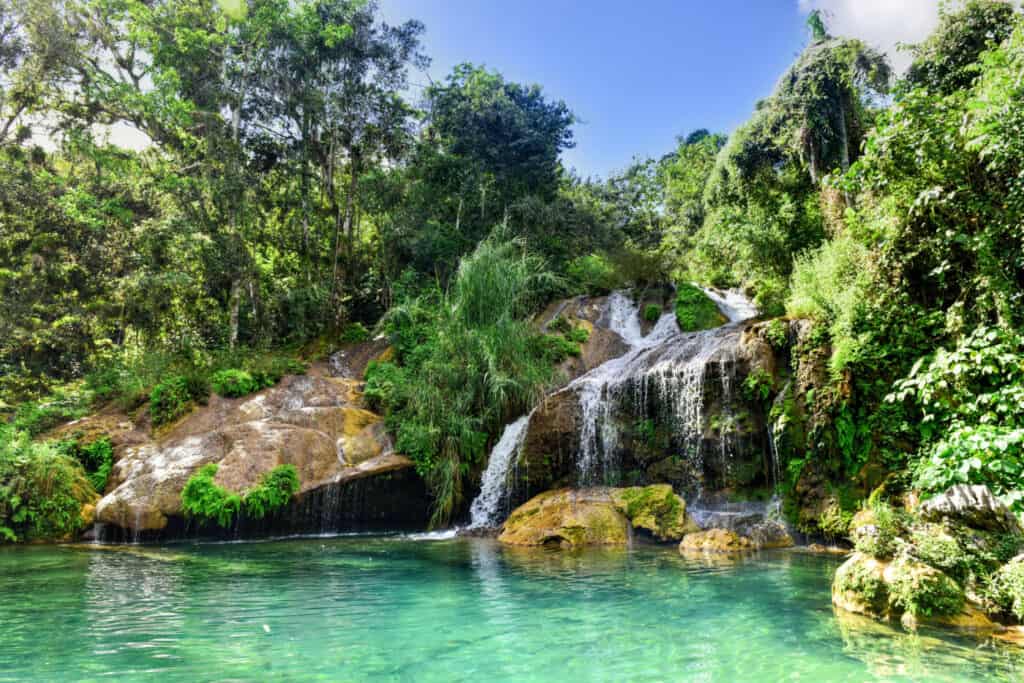
Day Ten: Day Trips from Trinidad
There’s plenty to do outside of Trinidad too. If you’re feeling energetic, visit the stunning mountains of Topes de Collantes. Take a seven kilometer round trip hike to Salto del Caburni, a 60-meter-high waterfall with impressive views of the surrounding area.
Another great thing to do near Trinidad is to take a steam train ride to visit the abandoned sugar plantations at Valle de Los Ingenios. It was the center for sugar processing and refinery and brought a lot of wealth to Trinidad during the 17th and 18th centuries.
There were 56 sugar mills in total powered by more than 11,000 slaves, bringing with it Afro-Cuban heritage like Santería, a syncretic religion between Catholocism, and Yoruba beliefs.
If you can, fit in a visit to the untouched reefs at Playa Ancon, and chill by the sea. Head back to Trinidad to try some of the local catches at the best paladares, like fresh snapper at Restaurante San José, or grilled octopus at Vista Gourmet.
In the evening try a Canchánchara, a potent rum cocktail, at the Taberna La Canchánchara. It’s one of the four drinks that Cuba’s best known for along with the mojito, daiquiri, and Cuba libre.
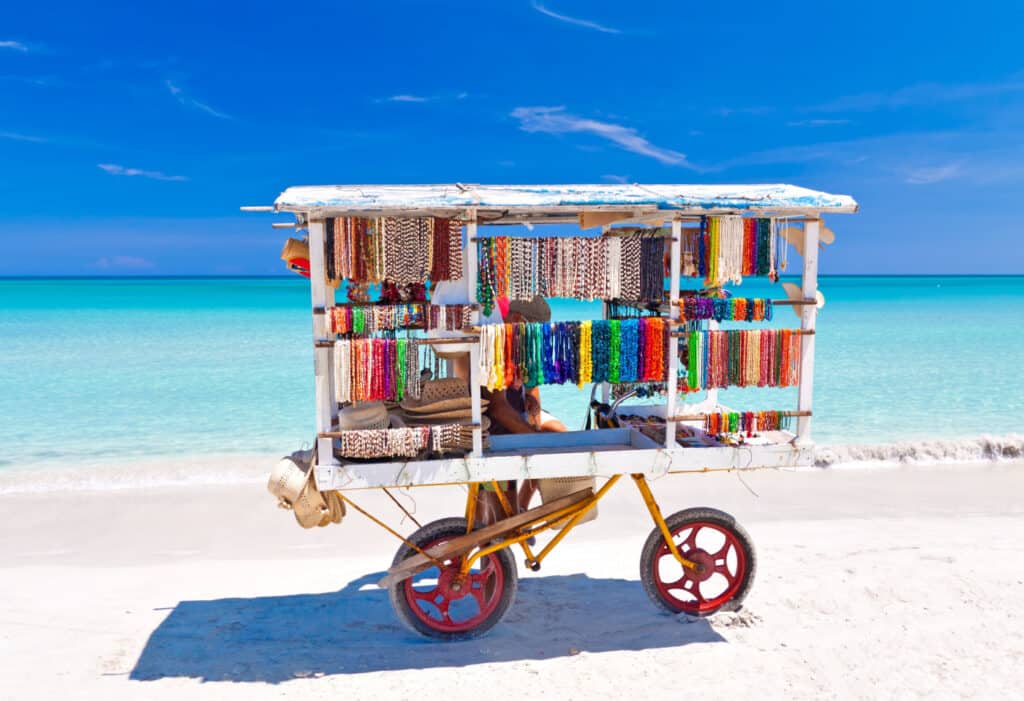
Day Eleven: Take a Trip to the Beach in Varadero
Spend the last few days in complete contrast to the rest of your trip to Cuba by visiting the largest tourist resort in the Caribbean. Located on the 20-kilometer long Hicacos Peninsula, Varadero boasts over 60 hotels (mostly all inclusive). It’s famous for its white sand beaches and is a vital part of Cuba’s tourism industry.
Playa Varadero offers all of the western comforts the rest of Cuba lacks, like public toilets as well as conveniently located cafes and beach loungers. It’s the perfect place to unwind and relax in total peace and quiet, with a mojito in hand of course!
But it’s not all beaches and cocktails. Visit the landscaped gardens of Parque Josone, the old Hershey chocolate factory, or the nearby town of Matanzas to get to know the area better.
Stay at the relaxed Casa de Betty y Jorge right in the middle of Varadero. This place has everything you need for a peaceful stay, plus there’s a great Italian restaurant next door. One of the highlights of this casa is the location, you can easily grab a bite to eat in town and head out to Varadero Beach.
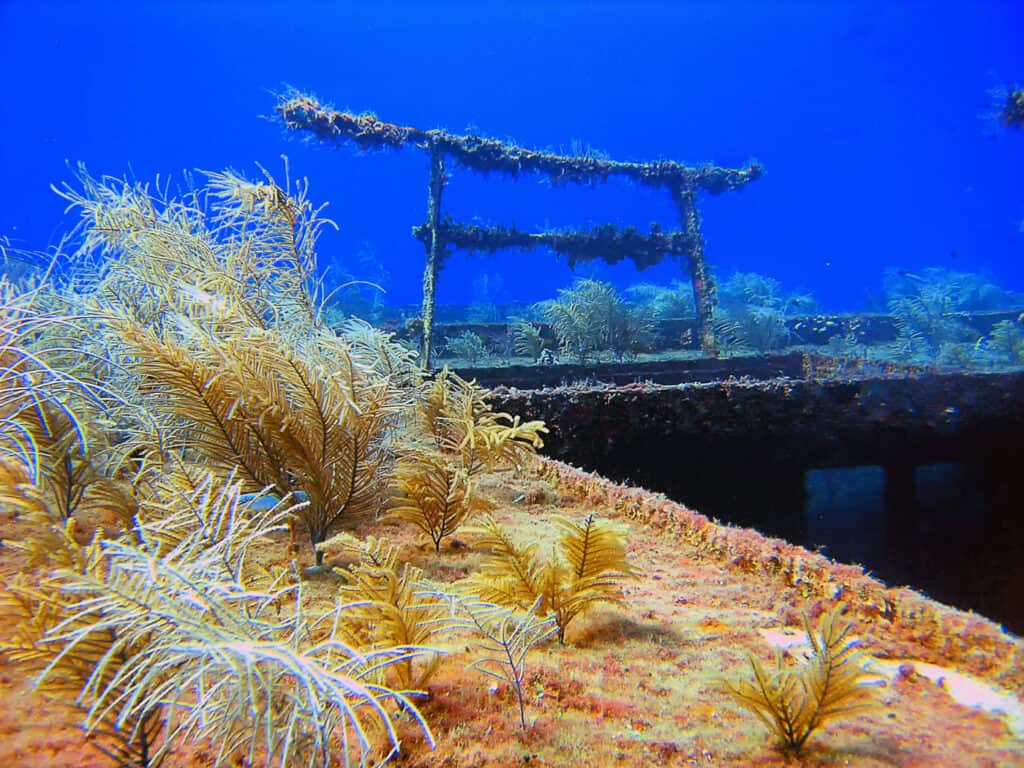
Day Twelve: Go Scuba Diving in Varadero
For me, one of the main reasons to go to Varadero is scuba diving. Visit Cayo Piedras del Norte located five kilometers north of Playa las Calaveras to dive a sunken towboat, a missile carrying gunship, an airplane and the Coral Negro yacht.
The marine park here was created during the 90’s and has since attracted a plethora of sea life. You can also snorkel some sites or take a glass bottom boat tour of the area.
There are some fantastic dive sites dotted around the many cayes and coves surrounding Varadero. Tours are easy to book from your hotel reception, and don’t break the bank either.
Fill your day with all of the underwater wonders of Cuba, this is the Caribbean after all.
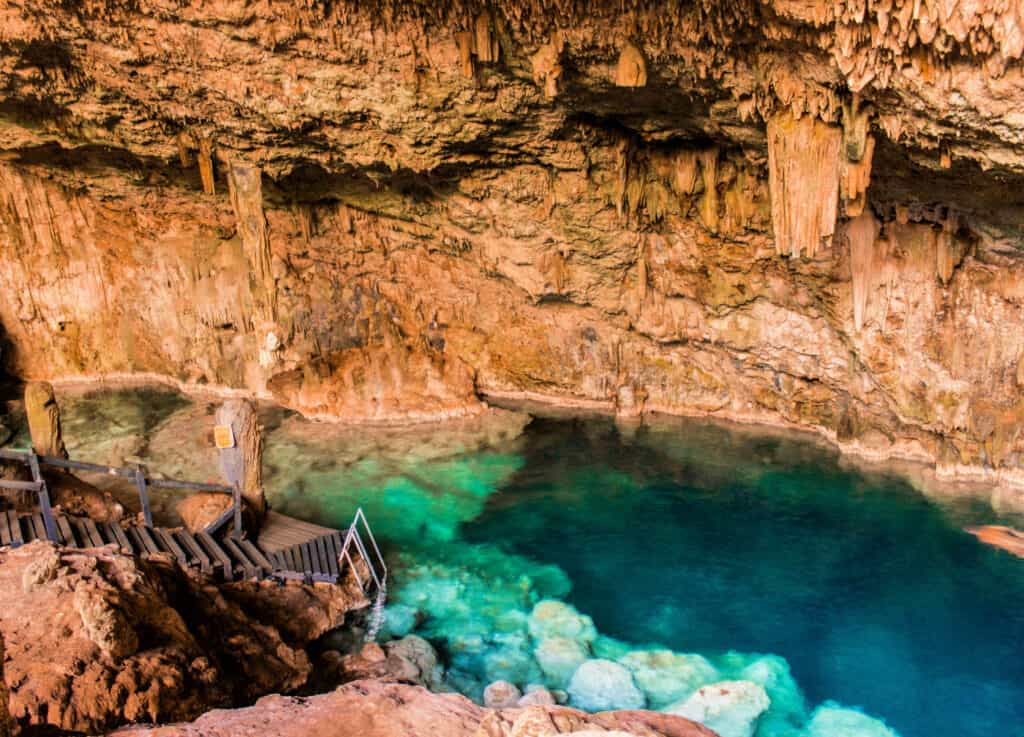
Day Thirteen: Off the Beaten Path Things to do in Varadero
If you get tired of the pristine beaches and out of this world diving, there are plenty of other things to do in Varadero too.
Visit 47 pre-Columbian cave drawings in Cueva de Ambrosio. Only recently found in 1961, they are thought to be around (an astonishing) 2000 years old. Then head to the Varahicacos Ecological Reserve to uncover 2,500-year-old human remains as well as ancient pictographs.
You can also take a day trip to explore the cenote at Cueva Saturno or visit the amazing coral reef at Playa Coral, just a 30-minute drive away in Carbonera.
The great thing about Varadero is the crowds of tourists don’t tend to leave the resorts, so you can have the beautiful surrounding area all to yourself!

Day 14 Havana: Spend the Last Night Sipping Mojitos and Salsa Dancing in Havana
Head back to Havana for a fitting end to your time in Cuba. It’s hard to fit in everything this city has to offer and there are a few extra things to do on the last day here. Visit the Almacenes San José Artisans’ Market, one of the best in the city, for local handicrafts and produce to take home as souvenirs.
After a day checking off anything you missed the first time around, get the ferry over to Casablanca. There are fantastic views over the old town, and the neighborhood feels very different to the rest of the city. My favorite spot is the Christ of Havana statue.
Visit La Cabaña de Che Guevara (Che Guevara’s modest house) and the Fort of San Carlos of the Cabin. Don’t miss the “Cañonazo”, a nightly event in which ceremonial soldiers re-enact the historical firing of the cannon that once announced the closing of the city gates. Try to arrive around 8pm for a good view as the cannon is fired at around 9pm.
Another option is to head to one of the most famous spots in Cuban musics’ history. The Legendarios del Guajirito Buena Vista Social Club is the place to be on your last night in the city. If you haven’t heard the album or seen the film don’t worry, you will be familiar with the Buena Vista Social Club by the time you leave Cuba. Eat before you arrive as the food is nothing to write home about, but the music and dancing is a great way to end your time in Cuba.
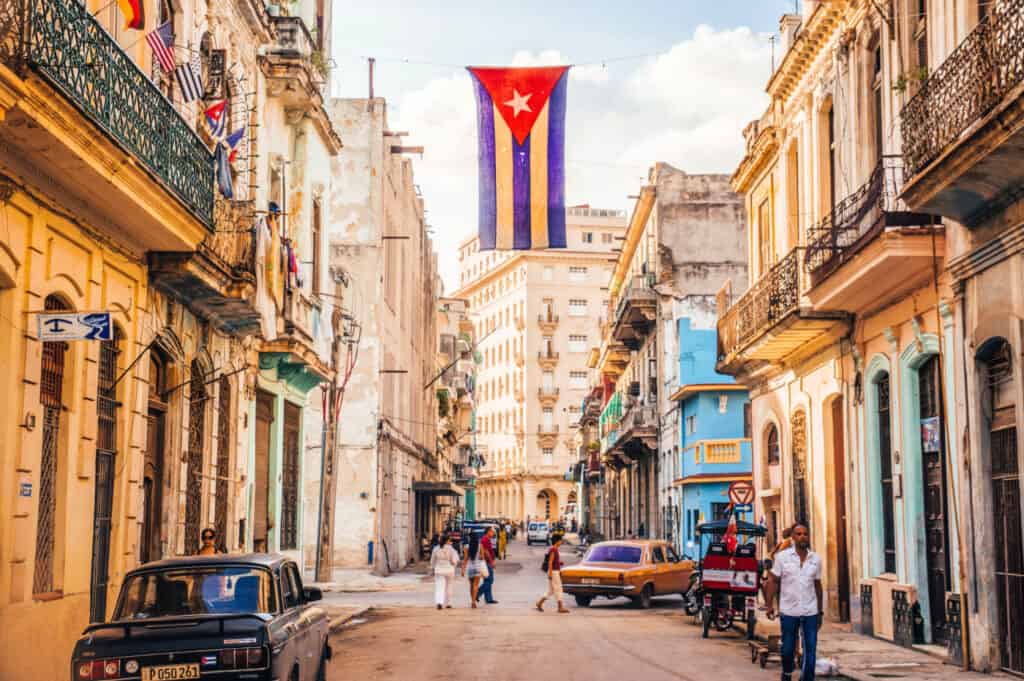
That’s How to Spend 14 Days in Cuba!
This is an easy way to spend two weeks in Cuba. Fit in some of the major sights, a few off the beaten path adventures, and some cultural highlights.
You could cut down some beach time in Varadero if you have less time or alternatively spend more time in Trinidad. But remember, if you are going it alone don’t try to fit too much in. Allow plenty of time for last minute changes and “Cuba time”, things might just take a bit longer than you were expecting!
Lauren Juliff
Lauren Juliff is a published author and travel expert who founded Never Ending Footsteps in 2011. She has spent over 12 years travelling the world, sharing in-depth advice from more than 100 countries across six continents. Lauren's travel advice has been featured in publications like the BBC, Wall Street Journal, USA Today, and Cosmopolitan, and her work is read by 200,000 readers each month. Her travel memoir can be found in bookstores across the planet.
Related Posts

How to Spend One Week in Mauritius: An Itinerary for First-Time Visitors

How to Spend Two Weeks in Belize: An Itinerary for First-time Visitors

How to Spend Three Magnificent Days in Tbilisi, Georgia: A 2023 Itinerary

How to Spend Three Perfect Days in Delhi: An In-Depth Itinerary

How to Spend Three Magical Days in Cusco, Peru: A 2023 Itinerary

How to Spend Two Amazing Weeks in Peru: An Itinerary for First-Time Visitors
Leave a reply cancel reply.
Your email address will not be published. Required fields are marked *
Meet Lauren Juliff

The Best Cuba Itinerary – Sightseeing, Activities And More
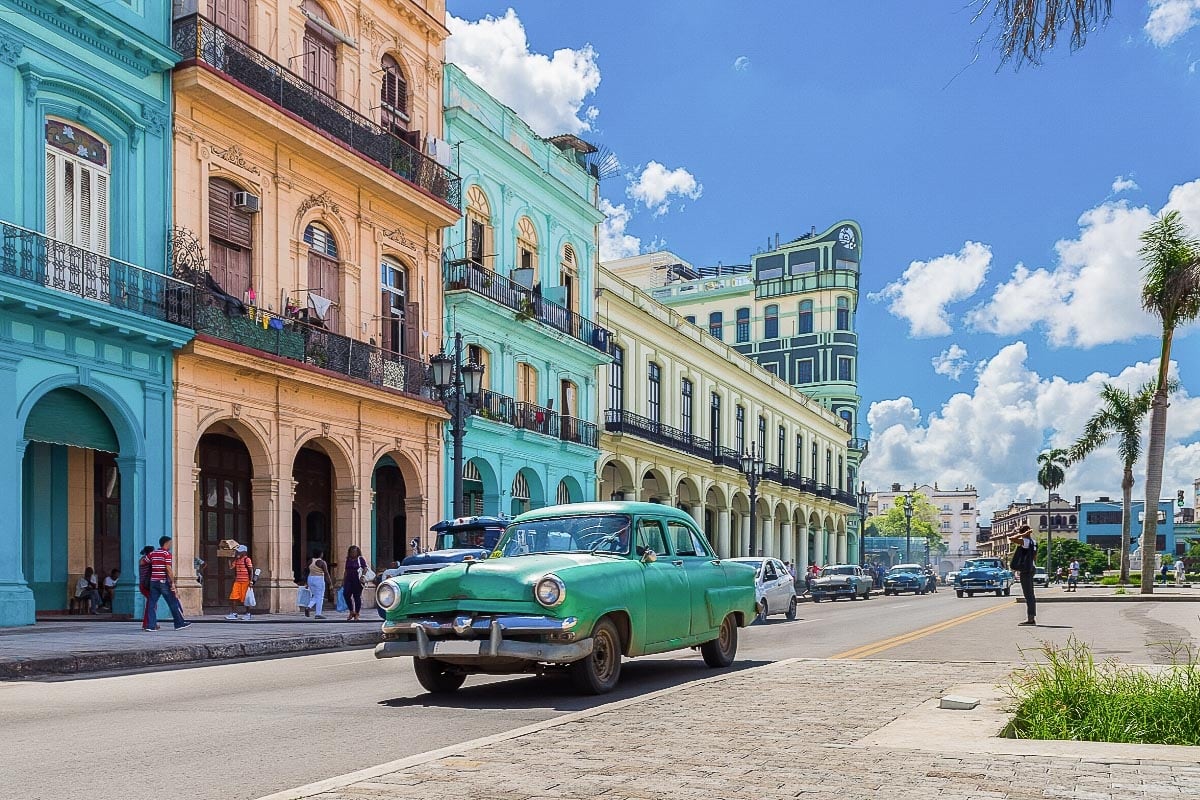
From visiting the colourful capital of Havana, to relaxing on Varadero’s pristine beaches, and exploring quirky Trinidad, this Cuba itinerary is the perfect introduction to the country.
Ready for a big dose of holiday inspiration?
So it looks like Cuba is well and truly open to to the world! For many years, the country was inaccessible to many, but things are changing… and fast! The fascinating Caribbean island is known for its colonial cities, white sandy beaches, tobacco plantations and revolutionaries like Che Guevara.
It’s somewhere you can spend your days drinking daiquiris, spotting dolphins, hiking through rainforests, visiting historic museums or salsa dancing with the locals. There really is something for everyone.
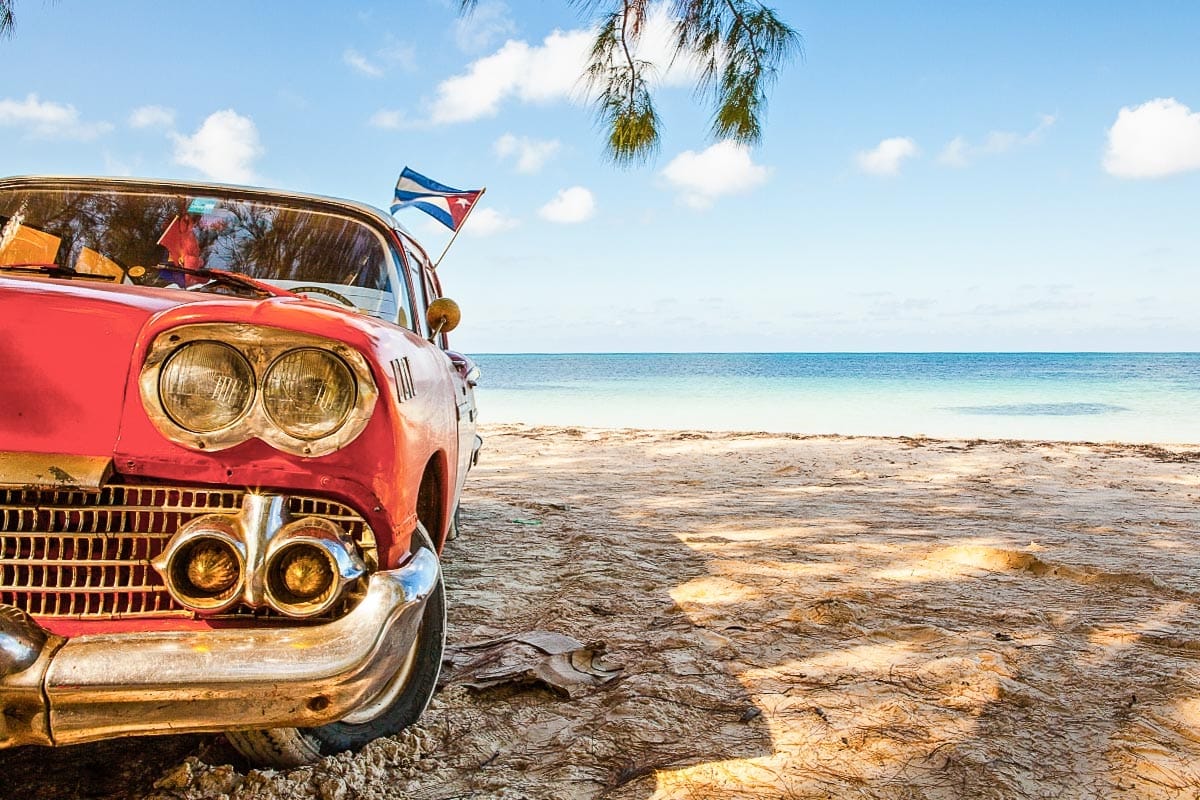
Cuban cities are diverse. From the hustle and bustle of old Havana to the cobbled streets and colourful Colonial houses of Trinidad, there’s plenty to fall in love with. Then there are the beaches. Prepare yourself for palm-fringed beaches with white powdery sand, leading to bright turquoise waters. Oh and don’t forget the island’s rugged rainforests, which hide a network of caves, cascading waterfalls and rare species of flora and fauna.
So, whether you fancy a laid-back beach break or want to explore some lively cities, you’ll find it all in Cuba.
Cuba Itinerary: 3 Days In Havana
Havana is Cuba’s vibrant capital, packed with colourful architecture, a cutting-edge arts scene and narrow streets which echo with rhythmic Cuban music.
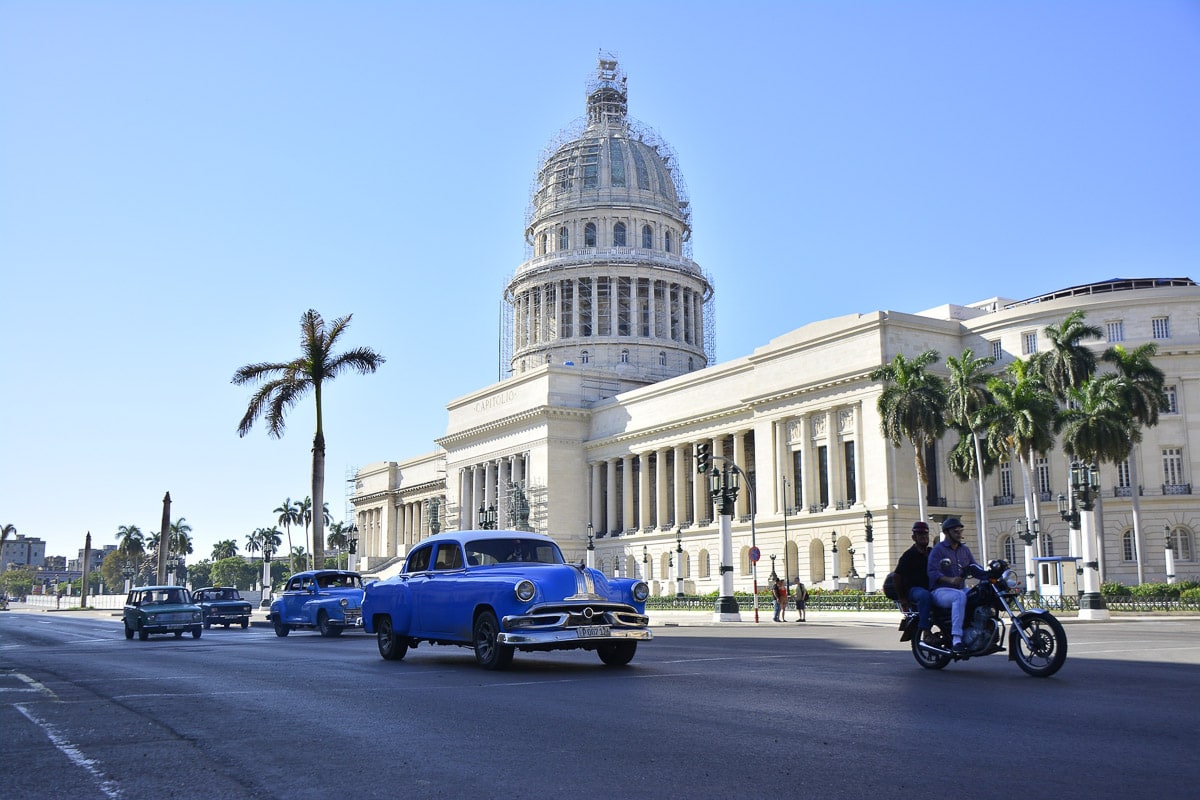
If you’re visiting Cuba for the first time, then there are a few things you just have to do.
Drink mojitos and daiquiris in bars once frequented by Ernest Hemingway, take a Havana vintage car tour along the Malecón (the city’s seafront promenade) and enjoy a meal in Habana Vieja (the city’s old town).
Main squares are flanked with buildings displaying images of Che Guevara, traditional restaurants (also known as paladares) serve up delicious local cuisine and the city’s buzzing nightlife continues until the sun comes up.
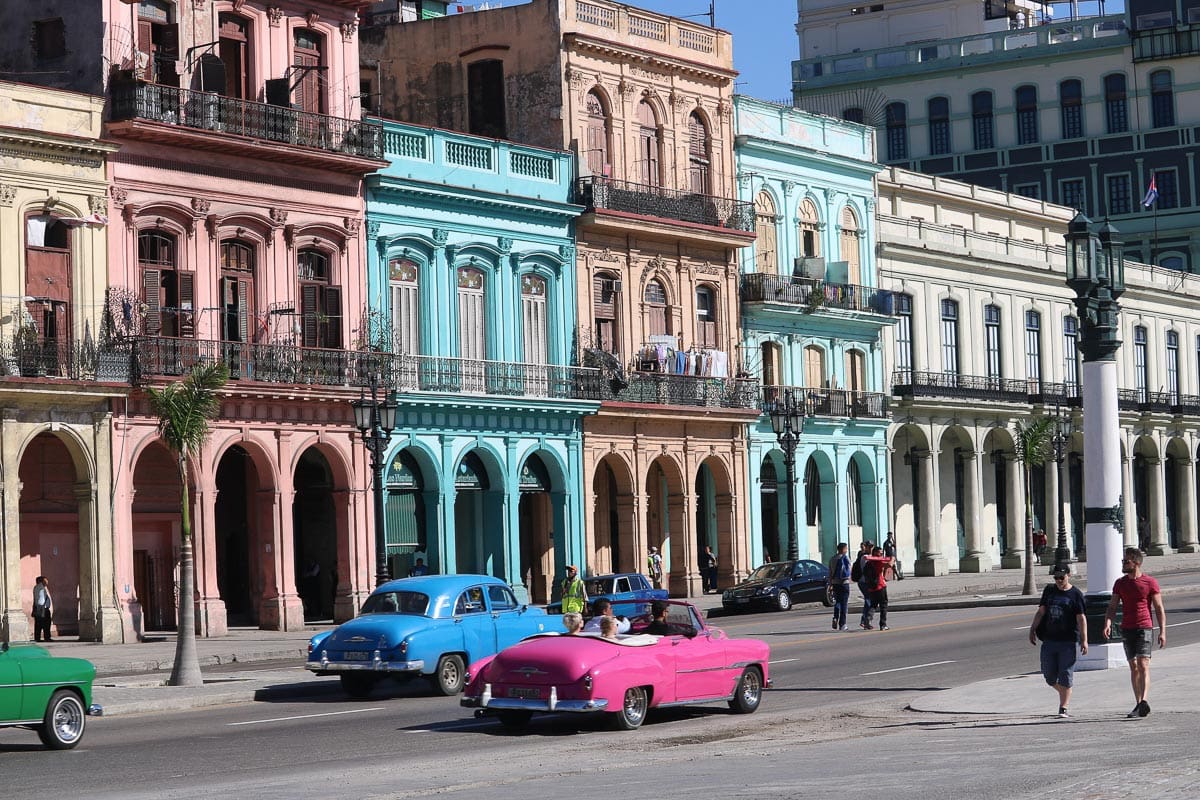
If you plan to base yourself in Havana for the duration of your stay, there are plenty of places to visit in Cuba which are doable in a day.
As part of your Cuba itinerary you could take a day trip from Havana to Vinales, enjoying a spot of horseback riding past tobacco plantations, or spend a day in bustling Trinidad, a Colonial town with cobbled streets and bright coloured houses.
Read More: 24 Hours In Havana, Cuba
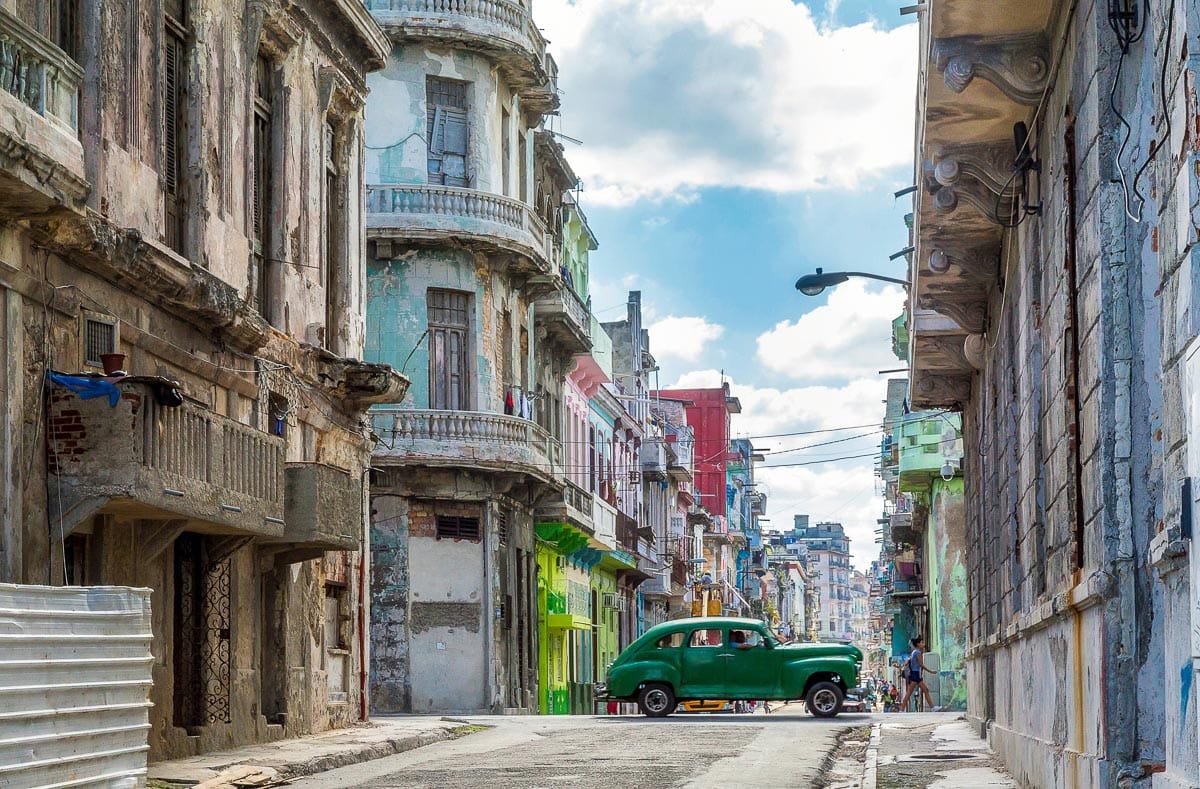
Cuba Itinerary: 3 Days In Varadero
Just over 2-hours drive from Havana is the popular beach resort of Varadero. It’s the perfect place to relax and unwind after a few days in the capital.
Although not as culturally rich as some Cuban towns and cities, it’s a great spot if you want to kick back and enjoy some beach time, shop for souvenirs or enjoy one of Cuba’s larger resorts.
If you fancy time away from the beach, you could head out on one of the hiking trails in Varahicacos Nature Reserve.
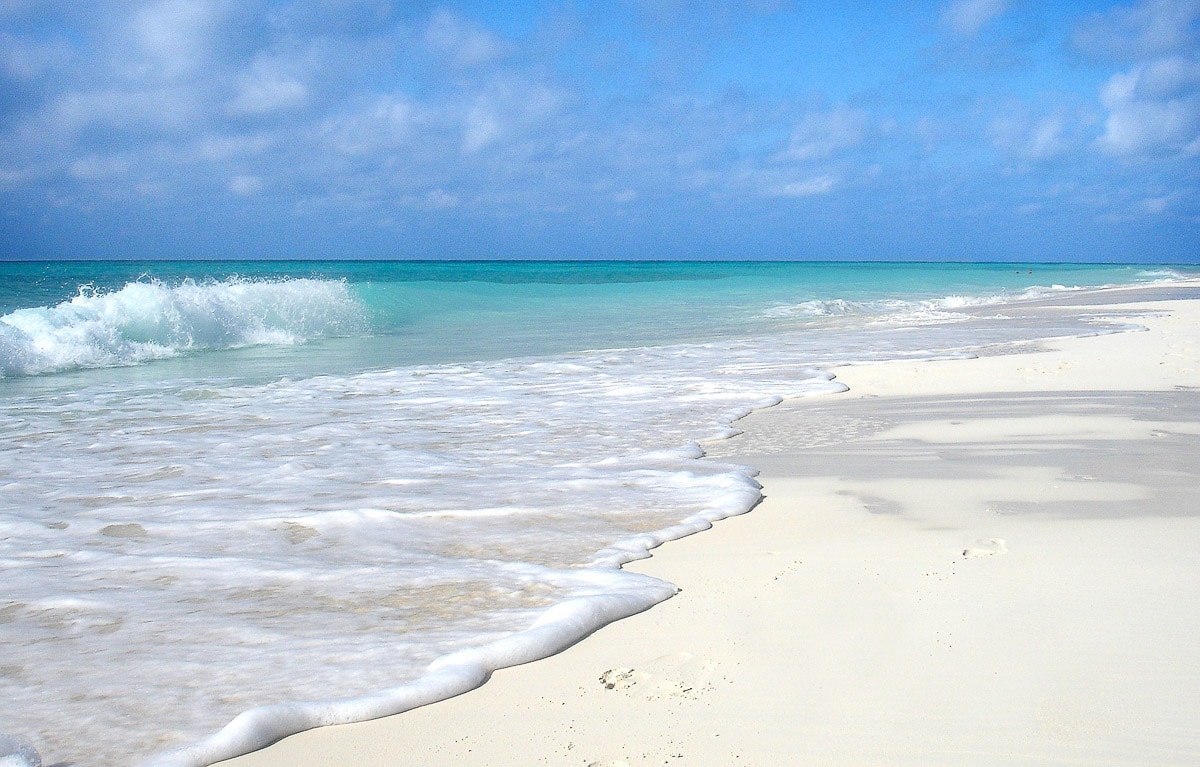
There are plenty of beach resorts in this area, with a few recognisable names including Melia, Iberostar and Barcelo. I’d avoid the Barcelo Solymar hotel like the plague, unless it’s changed dramatically since my trip! It was closer to Fawlty Towers than a fancy place for a holiday!
If you love getting out on the water, Varadero is a great place to visit. From snorkelling and sailing, to kite surfing and jet skiing, there’s plenty to keep you busy.
There are a few great day trips on offer too, including one from Varadero to Guamá – which includes a cruise along the Hatiguanico River, a chance to snorkel in the tropical waters at Punta Perdiz, and a trip to a traditional village to learn about indigenous Cubans.
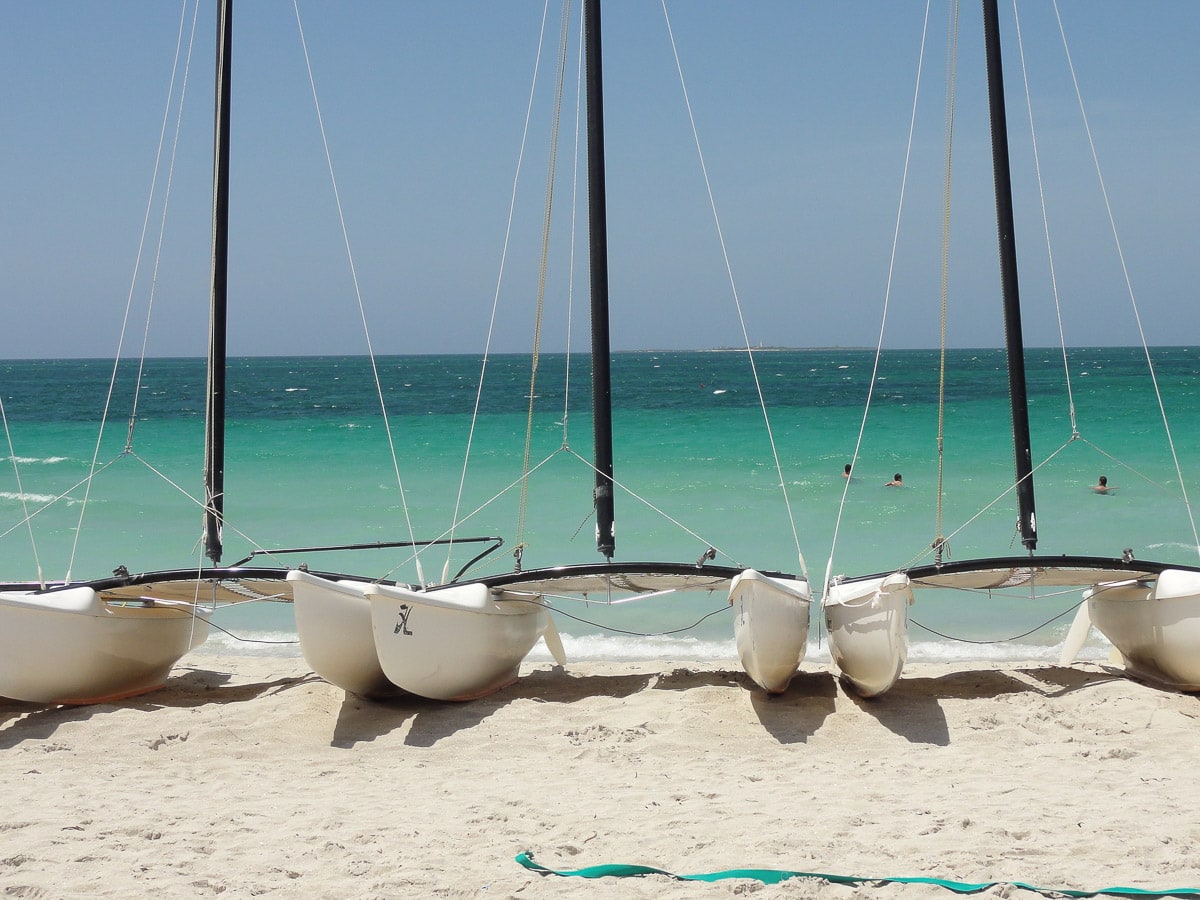
If it’s lively nightlife you’re after, Varadero is a really fun town. I remember drinking, dancing and enjoying live music while I was there. There are even outdoor clubs where you can party under the stars!
While there are plenty of all-inclusive resorts in this area, I’d recommend getting out and about. Mix with the locals, get to know the culture, and check out some of the great bars and restaurants away from the other tourists.
If there’s a group of you travelling together you could split the 90 CUC taxi fare (approx. £70 / $90 USD) from Havana to Varadero. Or, if you’re travelling on a budget, you can travel from Havana to Varadero by public transport using the Viazul bus. A ticket costs around £8 or $10 USD.
Cuba Itinerary: 2 Days In Vinales
If you’re looking for dramatic scenery, then add Vinales to your Cuba itinerary. Located around 2.5 hours from Havana, it’s an area steeped in natural beauty, with beautiful hills, tobacco plantations and flat plains.
While it’s possible to take a day trip from Havana to Vinales, I’d recommend staying longer to immerse yourself in the area’s lush countryside – it’s a nice contrast from the hectic streets of Havana too! You could hire bikes and cycle through tobacco plantations, learn how to roll your own cigars or go horseback riding.
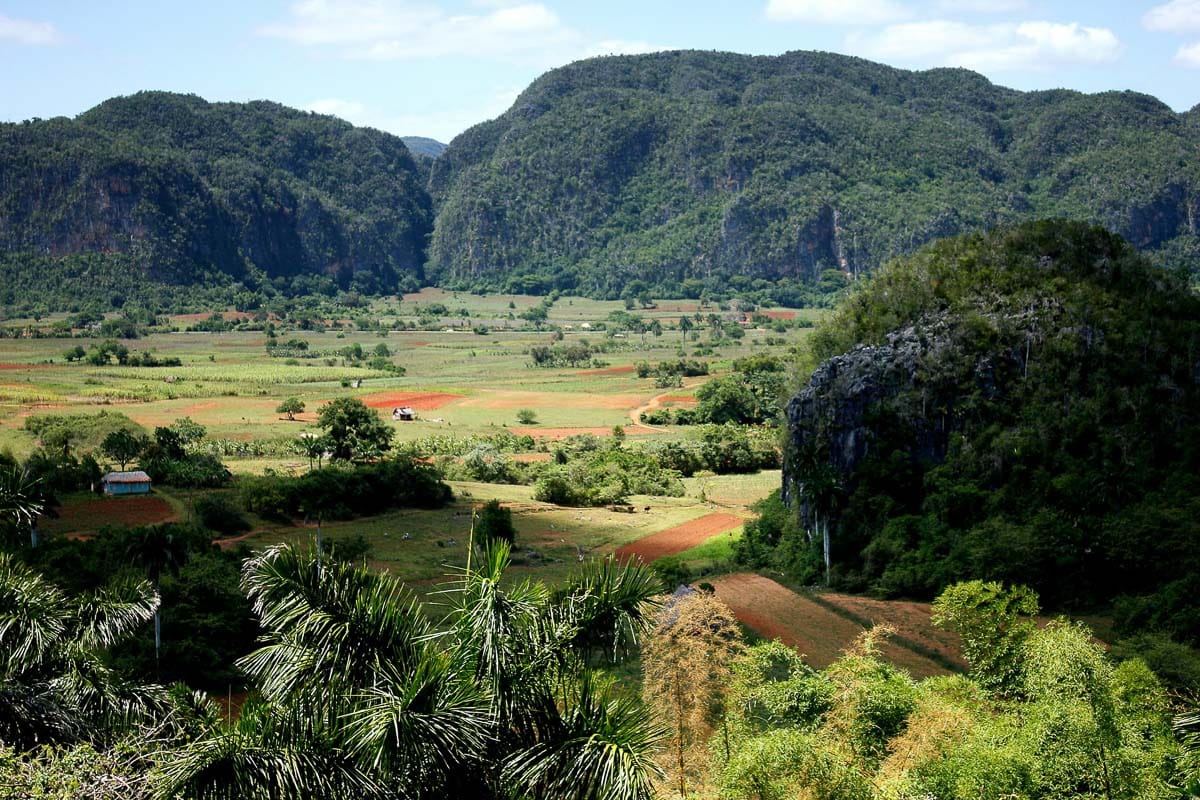
Interestingly, the area is also home to labyrinth cave networks and the Mural de la Prehistoria – a detailed mural painted on a rock face. If you stay in Vinales a while, no doubt you’ll catch one of the area’s spectacular sunsets over the limestone mountains.
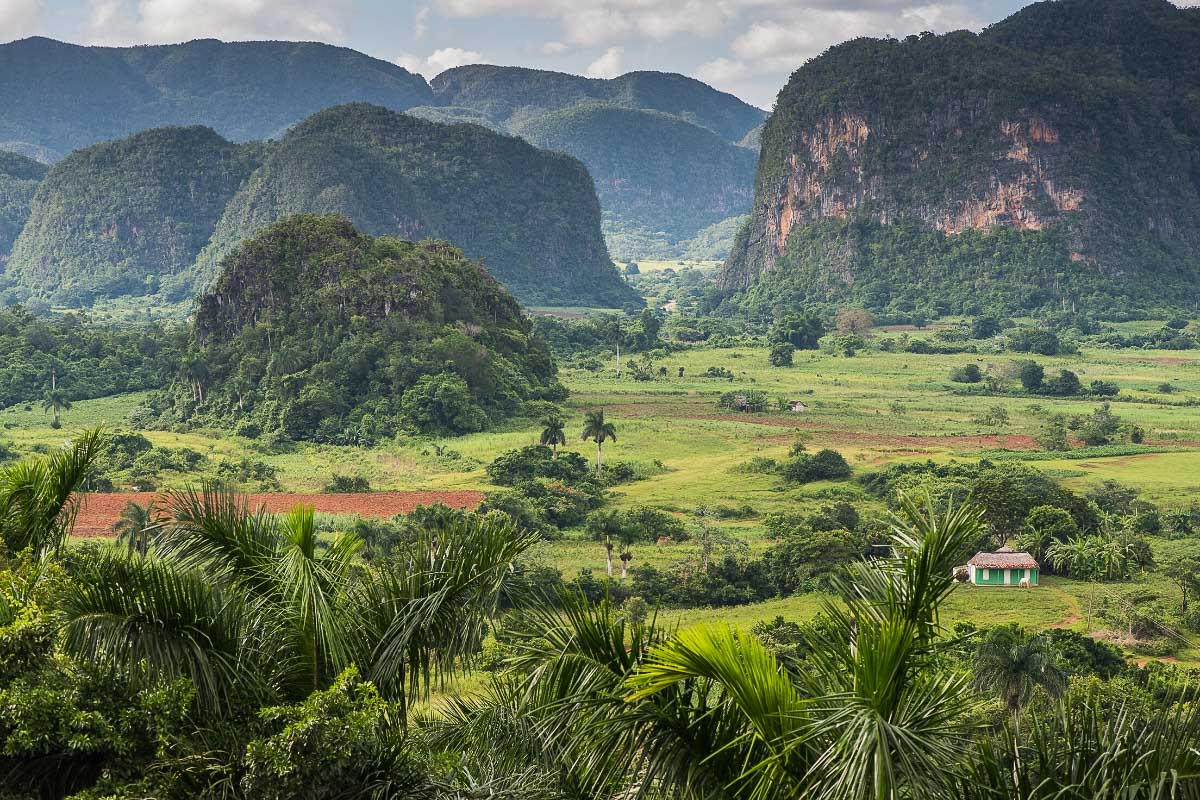
Foodies will enjoy the restaurant scene here, with lots of great local joints serving Cuban classics at very reasonable prices. It’s also relatively cheap to travel from Havana to Vinales by bus (around £9 / $12 USD), plus guest houses cater to budget travellers, so you’ll have no trouble if you can’t afford the more expensive touristy regions of Cuba.
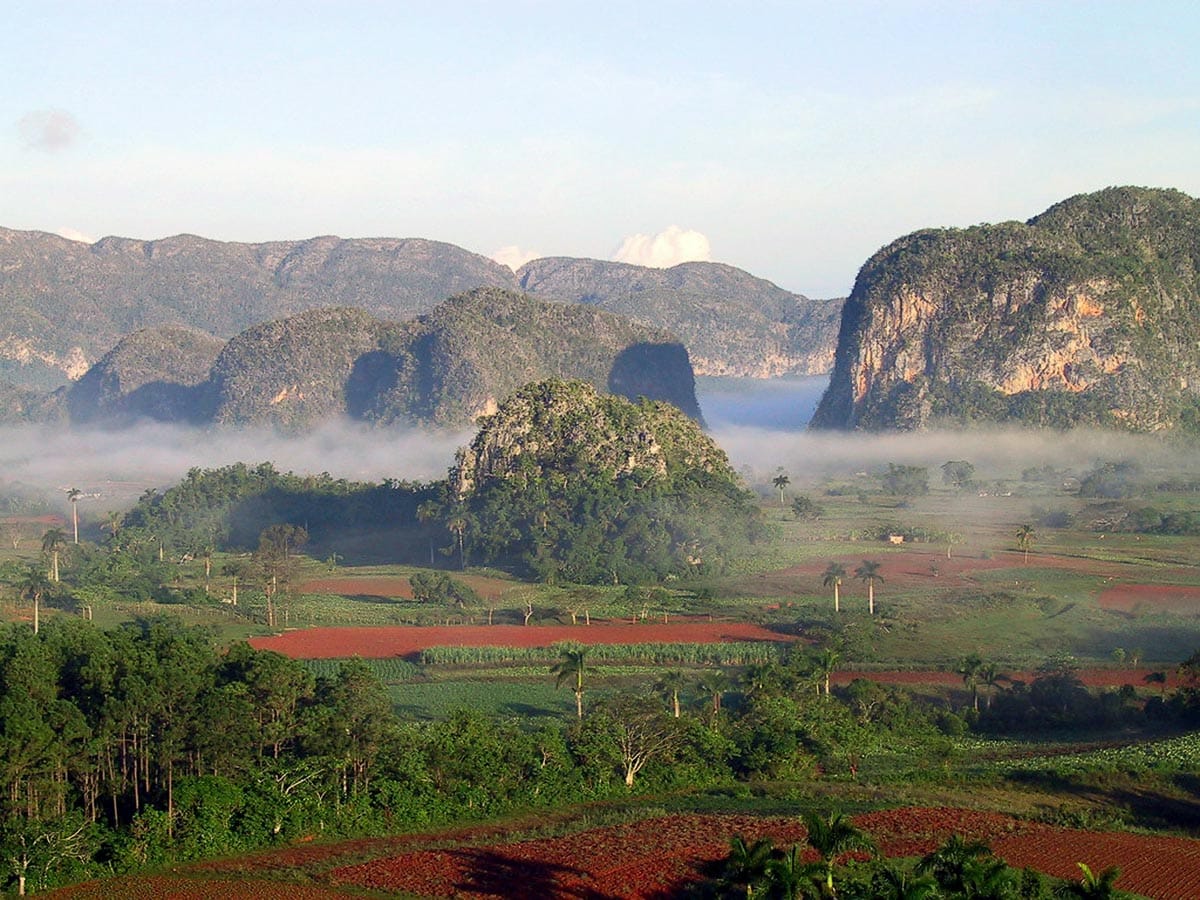
Cuba Itinerary: 2 Days In Trinidad
Don’t forget to add historic Trinidad to your Cuba itinerary. This charming town was once famous for its sugar cane mills and has some of the most beautiful colonial architecture on the island.
A great way to immerse yourself in Cuban life in Trinidad is to stay in a casa particular. These local home stays are cheaper than many hotels, and offer a traditional and relaxed introduction to the area. Bonus – you can brush up on your Spanish with the hosts! You can take a look at some of the options on offer here . Prices start from around £8 / $10 USD per night, so it’s a great option if you’re visiting Cuba on a budget.
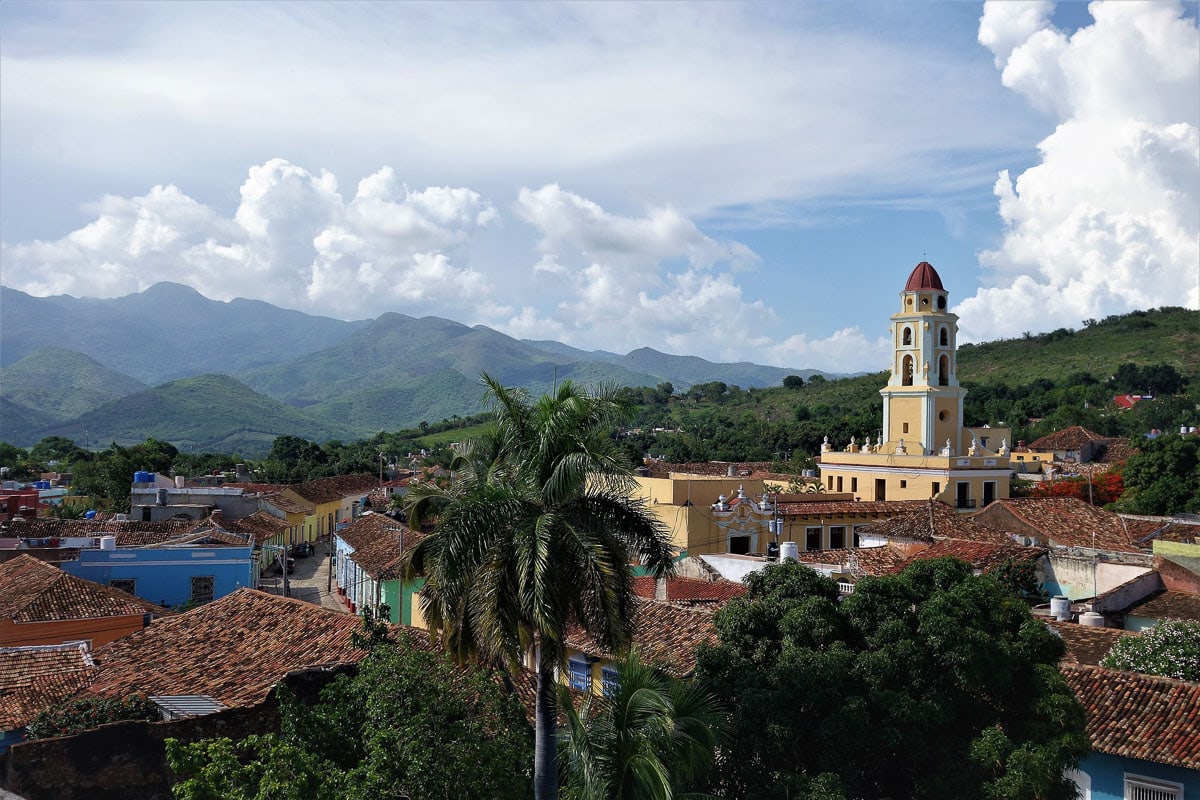
If you are only staying few days in Trinidad, head to the top of the church bell tower for the best views. There’s also a museum showcasing artefacts from the revolution in the church.
If you’re keen on having some beach time then Playa Ancon is only 15 minutes away, and boasts white sands and clear waters perfect for swimming and snorkelling.
Adventure lovers will enjoy a rainforest trek where you’ll be able to see the area’s waterfalls or take a swim at Topes de Collantes National Park. After dark, hang out with the locals in one of the town’s restaurants or enjoy some Cuban music at one of the lively bars.
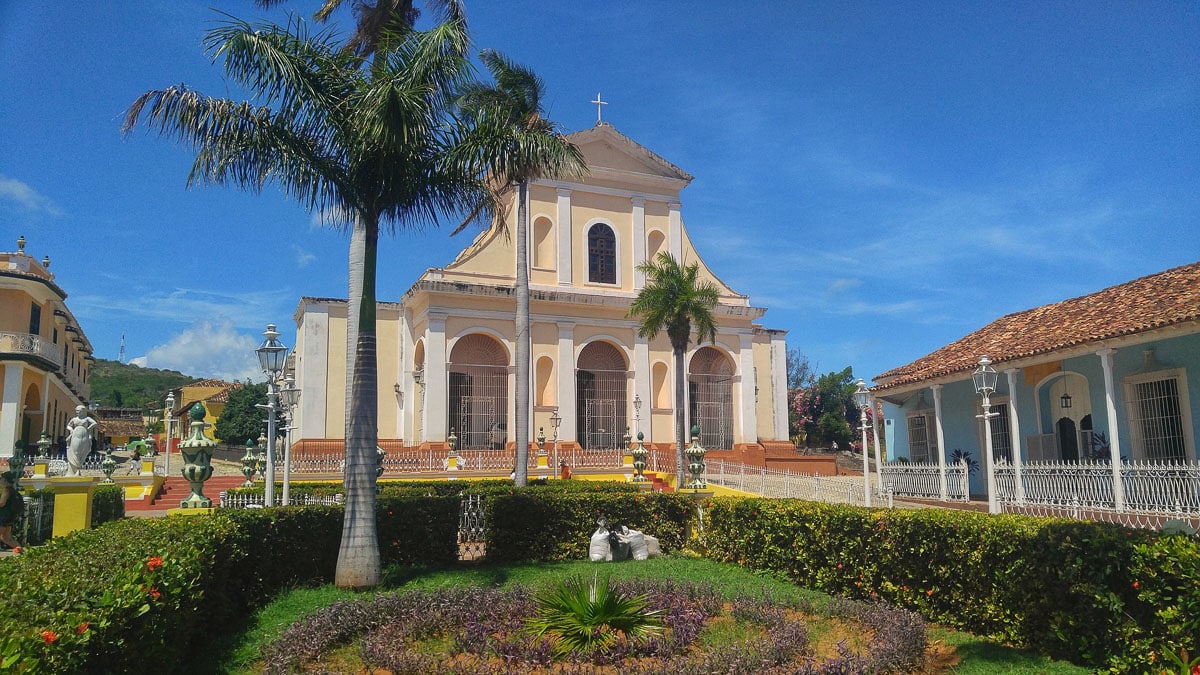
Cuba Itinerary: 2 Days In Santiago De Cuba
Located on the eastern shores of the island, Santiago de Cuba is Cuba’s second largest city. Known as the birthplace of the Cuban Revolution it’s a popular stop for history lovers, as there are plenty of museums and fortresses to check out.
The beating heart of the city is Parque Cespedes, a tree-lined main square and popular meeting spot. It’s THE people watching spot, so grab a coffee, enjoy some live music or, if you’ve not got two left feet like me, you could even get up and have a dance!
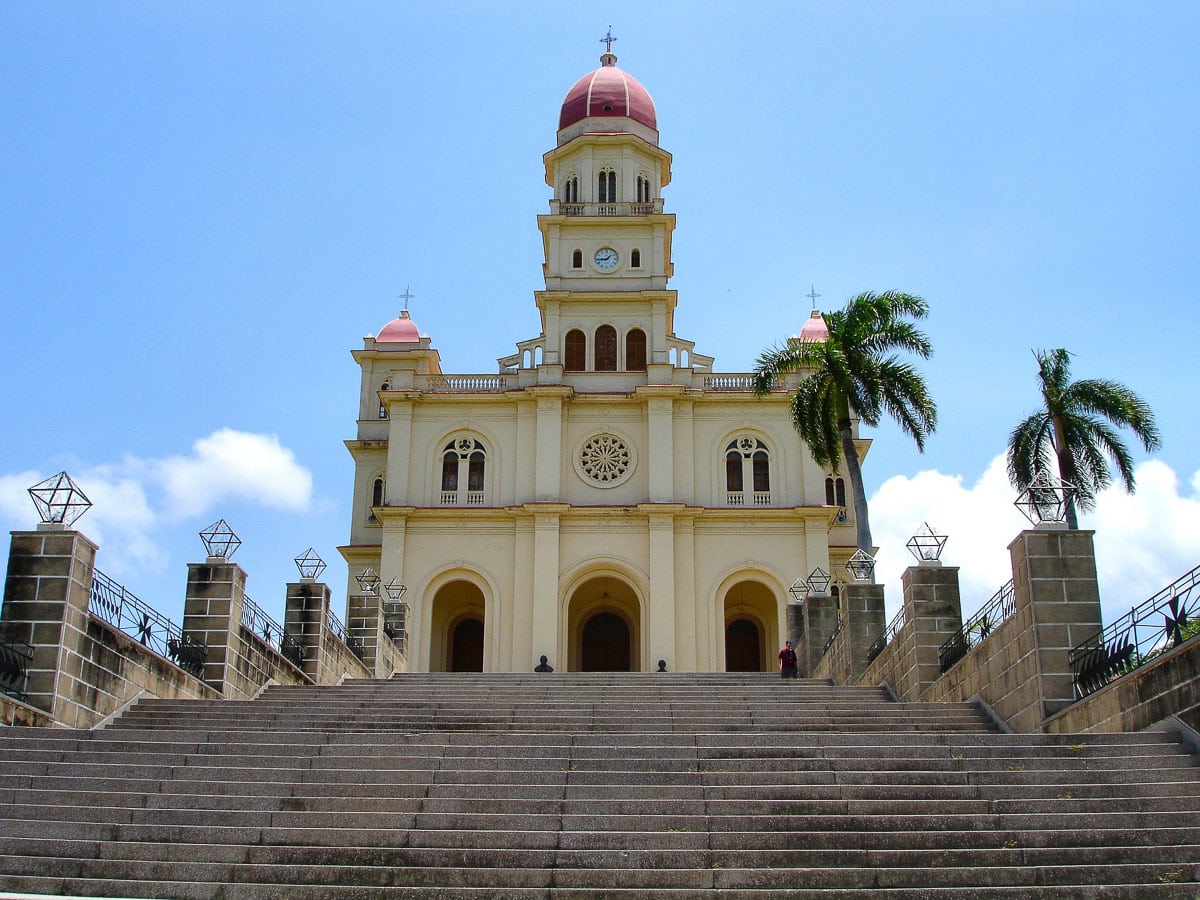
Alternatively, delve into history at Plaza de la Revolucion, where Castro delivered his speeches. Then explore Cuartel Moncada where Che Guevara, Fidel and Raul Castro stormed the building to seize weapons, signalling the start of the Cuban Revolution.
If you time your visit to Santiago de Cuba for mid-late July, you’ll experience the biggest and best carnival in Cuba! With brightly decorated floats, food stalls and a real party atmosphere, this is one celebration not to be missed!
If you are heading to the capital Havana afterwards to continue your holiday, you’ll get 2 festivals for the price of 1, as Havana’s lively carnival begins in early August.
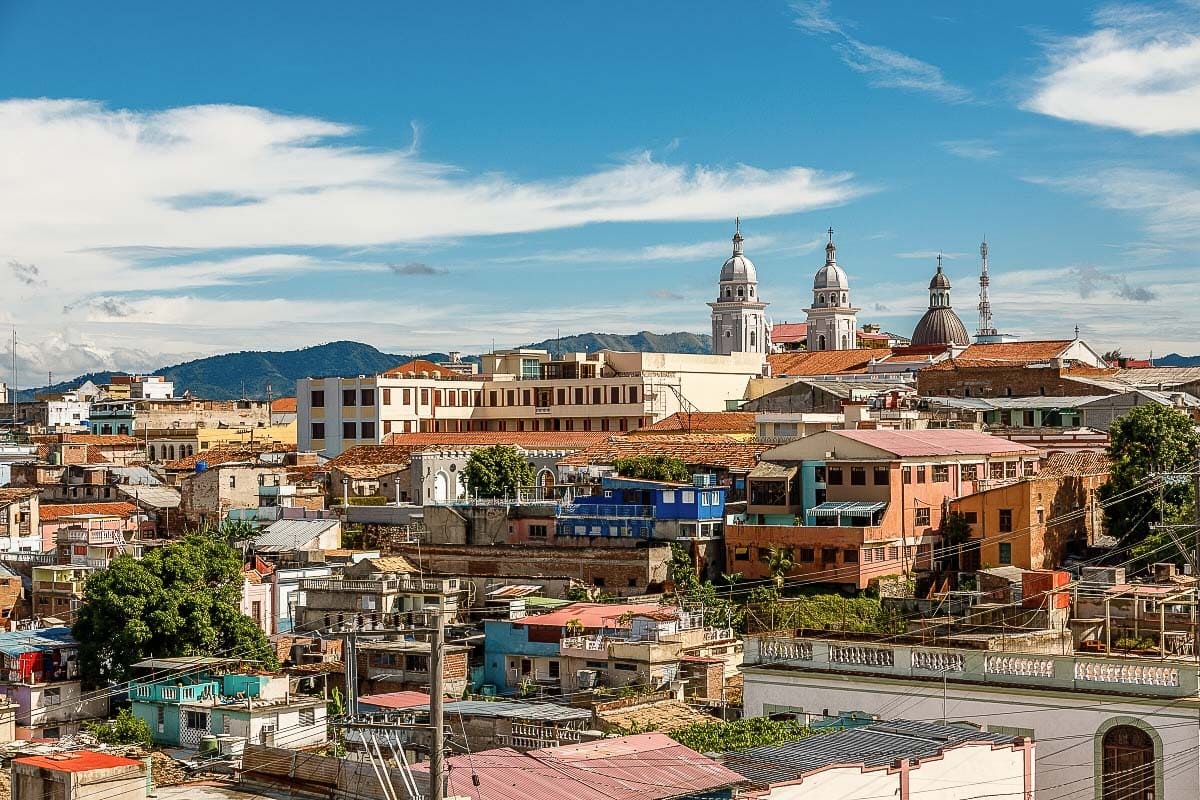
Cuba Itinerary: 2 days In Cayo Coco / Jardines Del Rey Or Jardines De La Reina
I’ve added these in as they’re amazing additions to your Cuba itinerary. However, bear in mind they’re a little harder to reach than the other options so far!
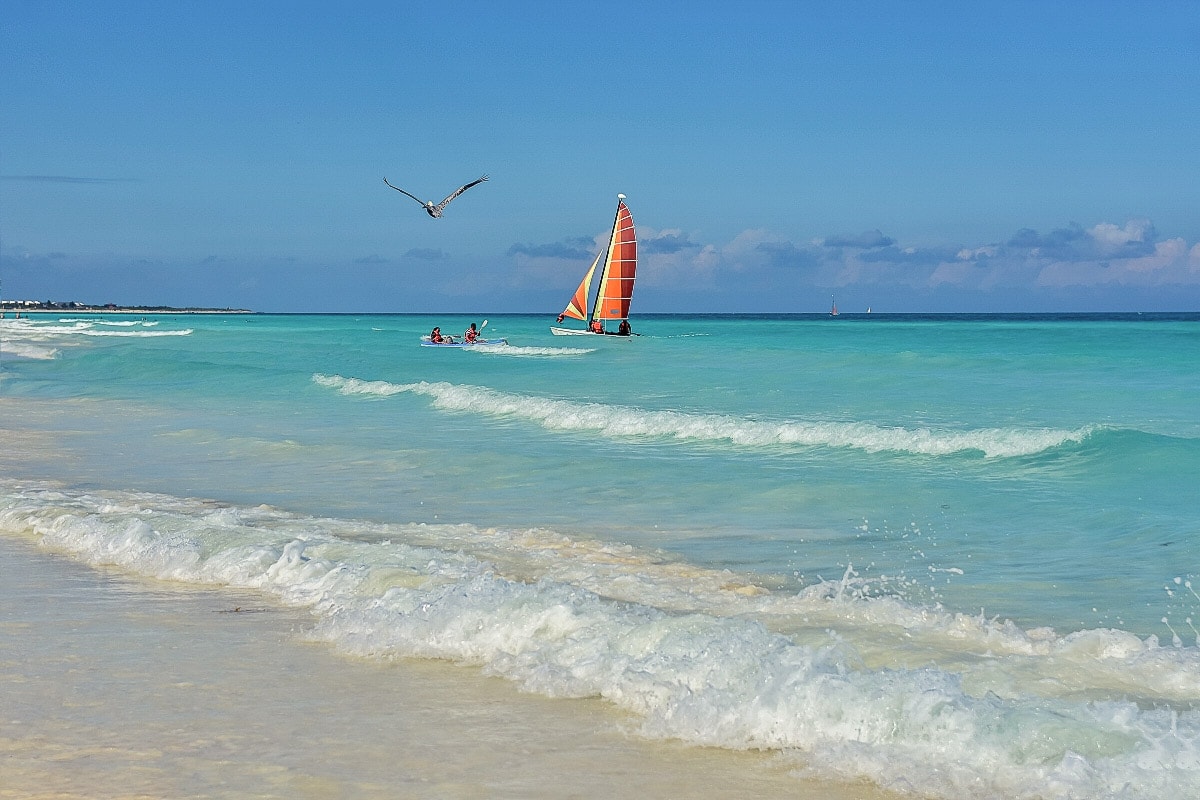
Cayo Coco is a tropical island in the Jardines del Rey archipelago (north of the mainland) and a great place to soak up the Caribbean sunshine on soft white sands, spot flamingos and dolphins in their natural habitats.
The area is pretty touristy, with several big hotel resorts, so while it’s not a great destination for a flavour of authentic Cuba, it’s a great option if you’re looking for a relaxing break! If you’re into scuba diving, this is one of the best places in Cuba for tropical marine life.
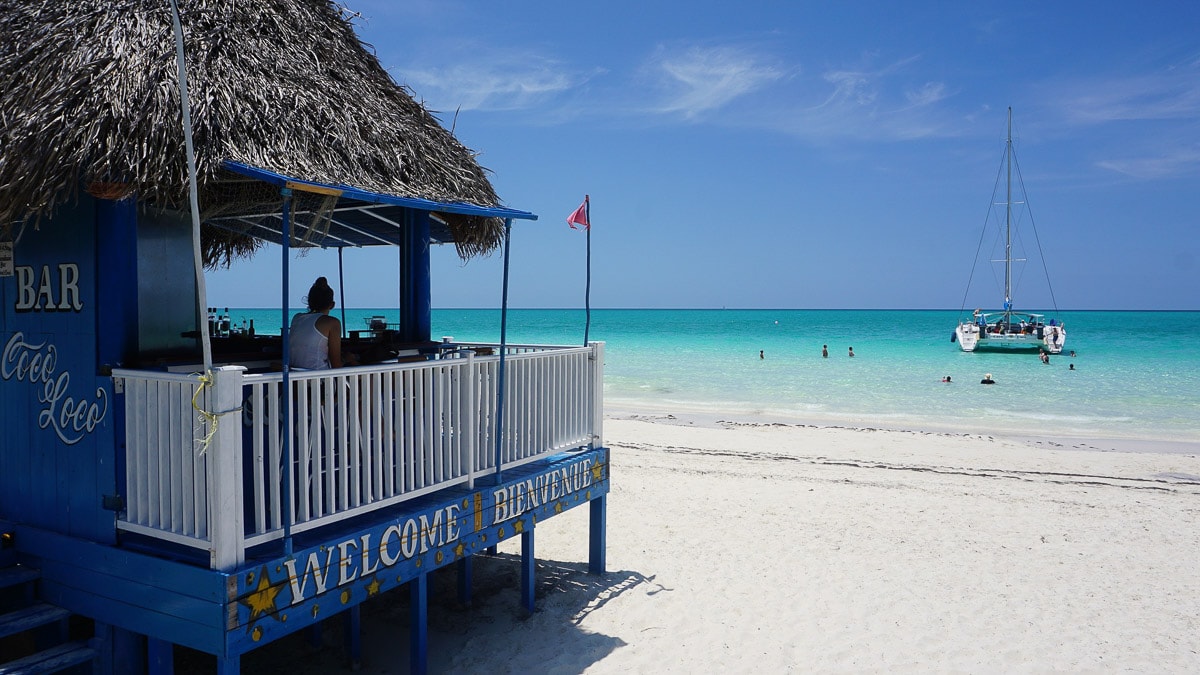
If you’re looking for an adrenaline fix, head to Jardines de la Reina (a different archipelago off the southwest coast). Here you can spot Caribbean reef sharks and silky sharks, plus there are plenty of dive tours available for all levels of expertise. Don’t forget a GoPro or underwater camera!
There’s no easy transport to get to either of these archipelago, so you’ll need to research routes using taxis and boats. For Cayo Coco, there’s a causeway, so taxis can reach the island. For Jardines de la Reina, you’ll need to catch a boat from the port of Jucaro.
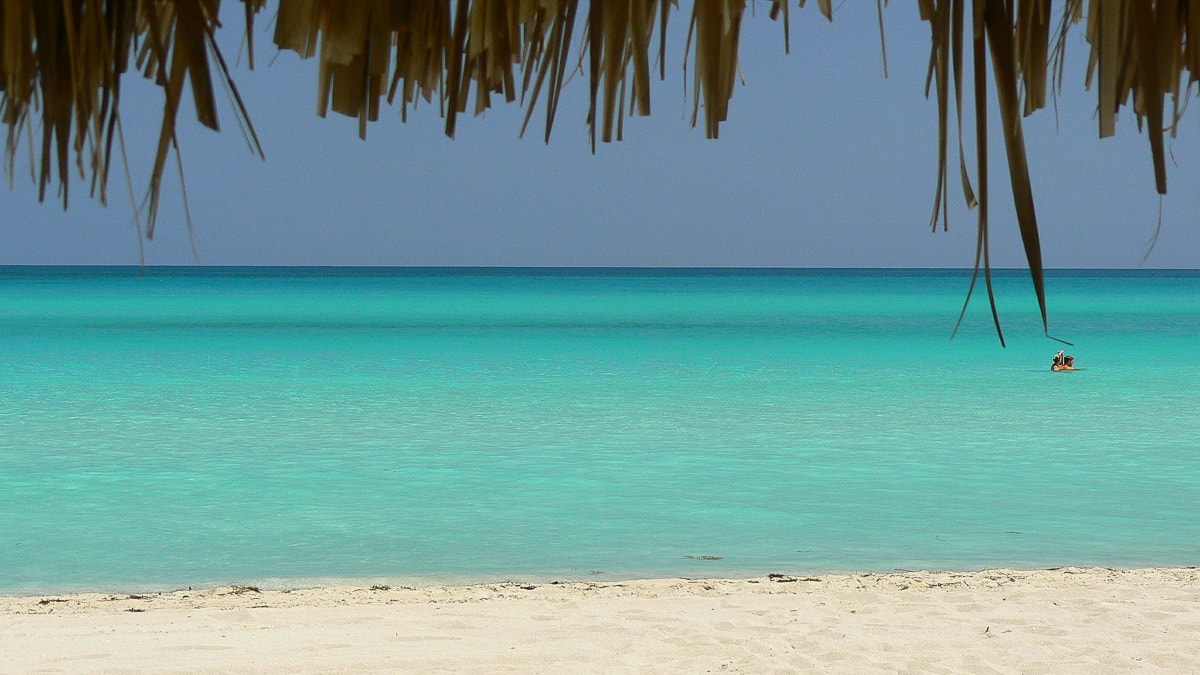
When Is The Best Time To Visit Cuba?
If you want warm days, sunshine and blue skies, then the best time to visit Cuba is between December and May. These are also great months for diving, as visibility is clear and sea conditions are calm. However, hotels and flights tend to be more expensive during peak season, so be sure to book accommodations and travel in advance to save money.
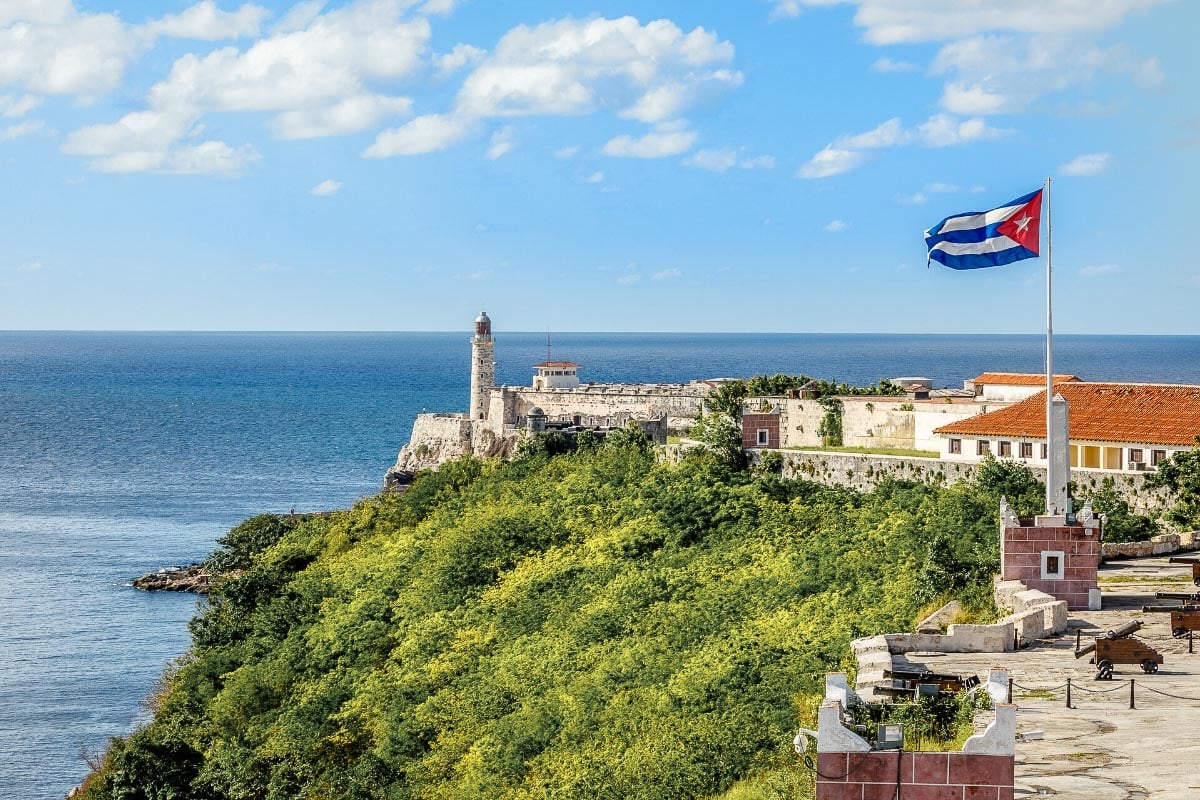
When Can You Miss The Crowds In Cuba?
If you don’t mind a little rain as you tour the island and want to benefit from a few cheap hotel deals in Cuba, time your trip for between June and October. You might not see blue skies every single day, but areas like Vinales and Topes de Collantes are lush when it’s rainy, plus you could enjoy the carnivals in Santiago de Cuba and Havana too.
I hope this Cuba travel itinerary has given you lots of ideas for your holiday on the island. If you’re heading to Havana, make sure you read my guide to spending 24 Hours In Havana, Cuba .
Found this Cuba itinerary helpful? Pin it for later…

Chloe Gunning
With a passion for food, fun and adventure, Chloe is the content creator behind one of the UK's top travel blogs Wanderlust Chloe. From volcano boarding in Nicaragua, to sailing around Sicily and eating her way around Japan, her travels have taken her to some of the coolest spots on the planet. Named Travel Influencer of the Year in 2022, Chloe regularly works with a number of tourism boards, producing inspirational travel content across multiple platforms. Find out more about Chloe here.
Leave a comment Cancel reply
Last updated on January 22, 2024 by Shannon

Less than a hundred miles off the coast of the United States, Cuba is a step into a seemingly lost era. Travelers dreaming of visiting Cuba conjure images of classic fifties cars set against crumbling Spanish colonial facades. They picture lively street-side musicians and miles of gorgeous coastline. And that’s largely what you find when you visit the country.
Cuba boasts some of the best Spanish-Colonial architecture in the Americas, the most pristine coral reefs in the Caribbean, and a fascinating, vibrant culture. Cuba is one of the more intriguing places in the Caribbean.
Although the decades-long U.S. embargo shielded Cuba from much American influence, Cuba hosts millions of travelers from Europe and Latin America each year. Many tourists opt for luxury resort hotels, but it’s possible to independently travel the country on a much lower budget. Particularly if you plan to travel independently, it’s important to understand Cuba’s complex history, as well as the current political situation since these will crop up in small ways throughout your visit.
I had mixed feelings about the country when I first visited; the locals were in a downswing on trusting the government and were afraid to talk with tourists. Recently, travel friends reported that much has changed and independent travelers will find opportunities for fascinating conversations and local experiences all over the island nation.
Cuba is safe for travelers, including families—a big factor for indie travel. And there are a lot of fun moments to discover: the local obsession with baseball, the fluidity of time, the love for soul-satisfying beats. Also, all travelers should realize that the transportation infrastructure in Cuba is rough, and you should make a strong commitment to understanding responsible travel considerations unique to Cuba .
This travel guide focuses on helping those taking independent route through Cuba’s major travel spots, and it highlights the most important historical situations and pressing issues you’ll need to know. It also includes city recs and responsible travel options, too !
Table of Contents
Things to Know Before Traveling to Cuba
Understanding these pieces of Cuba’s recent history is an important part of ensuring that conversations with locals are undertaken with thoughtful and considered opinions.
Cuba’s earliest known inhabitants date back to 3,000 BC, yet much of its pre-Columbian past remains shrouded in mystery. The arrival of Columbus in 1492 marked the beginning of a new era, with Spanish colonization profoundly influencing Cuba’s culture and aesthetics for four centuries until 1899.
Postcolonial Cuba emerged as a leading sugarcane producer, relying heavily on African and Chinese labor, which significantly impacted its cultural landscape. This era also gave birth to the island’s signature Afro-Caribbean Latin music, a fusion that resonates globally.
1959 was a pivotal year, witnessing the Cuban Revolution led by Che Guevara and Fidel Castro, which toppled the U.S.-backed Batista regime and established Castro’s Communist rule. This period also saw the Cuban Missile Crisis, which severed U.S.-Cuba relations and led to a trade embargo, pushing Cuba closer to the Soviet Union. The Soviet Union’s collapse in the 1990s brought hardships, including food shortages and power cuts, prompting many Cubans to flee to the U.S.
The 1990s also marked Cuba’s opening to tourism, a development met with mixed feelings, especially among Cuban-Americans wary of supporting the Cuban government. The U.S.-Cuba relationship began thawing in December 2014, a process initiated under Obama’s administration, although it has faced challenges and is still evolving.
For travelers, understanding these pieces of recent history is an important way to ensure that conversations with locals are undertaken with thoughtful and considered opinions. The Wikipedia page has a full history. For a quick overview, I rather like this BBC timeline or this Vox piece .
Fast-Facts About Cuba Travel
Cuban convertible peso (CUC) and Cuban peso (CUP). CUC is the tourist currency and pegged to the USD; the CUP is the local currency ( current exchange rate ).
Americans should bring all their cash (in Euros) to exchange as you can’t count on working and debit cards (as of May 2019, the U.S. embargo still prohibits most banking transactions with Cuba).
All other visitors can withdraw money from ATMs, but call your banks to be sure they offer withdrawals in Cuba. All travelers should bring cash as a safety net.
Electricity
127V/60Hz (American plug). You may find 220V outlets as well, but most hotel outlets label outlets nowadays.
Primary Airports in Cuba
- Havana (HAV)
- Santiago de Cuba (SCU)
- Varadero (VRA)
- Santa Clara (SNU)
- Holguin (HOG)
Can you drink the water in Cuba?
No, the water is not safe to drink in Cuba. Drink bottled water, bring a reusable water bottle to refill at your guesthouse, and/or consider the merits of a SteriPen or LifeStraw on your trip.
Spanish is the national language and you’ll have a much better trip if you learn some basics. The Cuban accent is also pretty strong, so it can take a few days to suss it out if you plan to trot out that high school Spanish.
You should also download a language app on your smartphone to grease the wheels of communicating locally.
Hows the wifi and internet in Cuba?
WiFi increasingly common and national data plans were introduced in 2019. You can use internet cafes, or there are a number of WiFi hotspots located throughout the country, including in hotels, restaurants, and public squares.
To connect to a WiFi hotspot, you will need to purchase a WiFi card, which can be purchased at most hotels or at an ETECSA (the state-run telecommunications company) office.
But really, you should make plans to have reduced access while you’re traveling in Cuba, and you might be lucky and find it a couple times. (And that also means making sure you have all travel documents and specifics saved offline!).
Festivals of Note
- The Carnaval de Santiago de Cuba takes place annually in Santiago, Cuba (July)
- Habanos Cuban Cigar Festival takes in Havana (February)
- Others are listed here .
How much should you budget for Cuba travel?
The accommodation is quite expensive, so plan on a higher daily spend rate than in many developing countries. Plan on $45-$65 for a solo traveler, $66-$100 if you’re splitting expenses. These posts provide couple , solo , and general travel budgets for Cuba.
Accommodation
Expect hotels to vary widely in quality. The infrastructure in Cuba is old, so read reviews and go with an open mind. Throughout the country, you used to have to use very specific local booking engines to find local casa particulares (sites like Cuba Booking Room and Your Casa Particular.
Now, however, there are heaps of more mainstream options on services were you likely already have an account— Booking.com and Expedia are now in the marketplace and it’s made it easier but a bit more soulless. Now the hotels and casa particulares are mixed on the platforms, and even Airbnb entered Cuba in 2015 and has listings across the country.
Note that casa particulares are still budget options and cost between $20-30 USD a night, and even with the easy increased access to booking sites, you should book accommodation ahead of time—increased tourism demands are stressing the country’s accommodations. Specific recommendations for cities are below.
Visas for Cuba for Americans
This is a fast-changing situation. As of 2016, Americans could legally enter Cuba as long as they travel for one of 12 listed reasons, more on that here and here . Tourism is not one of those reasons, but it’s still possible (as of May 2023) to schedule independent travel under the Support the Cuban People Category.
Cuba will not stamp your passport if you’re not visiting under one of the 12 OFAC travel licenses—instead, they stamp a piece of paper when you enter the country. You can sometimes buy a visa/tourist card at the airport for $20 USD; you purchase the tourist visa from the airline at the gateway airport to Cuba.
This post gives a rundown of the process and requirements for Americans . For other countries, check your visa requirements here .
Possible Issues Traveling in Cuba
Airport immigration spot-checks for travel insurance according to online buzz—pick a good travel insurance. I usually go with IMG Global . Then print your proof before you board your plane.
Socially Responsible Travel
Start your Cuba trip with a stop at Cuba Libro bookstore in Havana and they will give you the skinny on everything you need to know about this side of the Cuban travel industry. In fact, email before your trip to see if they need any supplies you can bring with you.
Food Considerations
The food scene is going through a renaissance as the government allows family-run paladares to operate. Outside of those places, government-run establishments leave a lot to be desired (:: cough cough ::).
Vegetarian food is tricky on the independent travel route, but the AlaMesa app is a good place to start for all travelers. Many tourist restaurants are heavy on fish, and the beans have animal fat at the very least. The fresh fruit is gorgeous and eggs are plentiful. Vegetarians should bring nutritious snacks. You can find a few types of ubiquitous, cheap street food, like pizzas. If you go this route, remember to follow these street-food safety principles .
How to Travel Around Cuba
Cubana Airlines offers easy flights from Cancun, a popular route to Cuba. You can arrive in Cancun and usually book a Cuba-bound flight for the next day—give wiggle room in high season of a couple extra days.
Commercial flights from the U.S. began in August 2016 with several major airlines. The bulk of flights still leave from New York and Miami, but there are now direct flights for a dozen other U.S. cities, too. Departure taxes are now included in your air tickets, which is handy.
Within the country, tourists should only use marked tourist taxis. Buses between all the cities are great for independent travelers. Roads lead to all the major towns, but Cuba’s infrastructure is crumbling so expect poorly paved roads outside of the popular towns. You’ll use Viazul to get to anywhere in the country. Hitchhiking is also common for the adventurous, but can be an exercise in futility for those traveling in Cuba on a visitors visa.
Is Cuba safe for travelers?
Cuba is safe. You can walk around at night and the country is proud of the very low rates of violent crime and theft. Be wary of hustlers in Havana, however. There are a few tourist scams, and they will surely recommend places where they get a commission. Just exercise normal caution when meeting new friends.
That said, you should absolutely have travel insurance to be sure you’re covered if something happens. I recommend IMG Global , here’s why .
World Travel Planning Resources
From the best travel gear to how to pick travel insurance—a detailed list of resources, tips, and advice to help you plan an amazing trip.
Pre-Trip Reading Inspiration: Books About Cuba
Fiction and Nonfiction Books About Cuba
- The Other Side of Paradise: Life in the New Cuba . Makes a good history read, but a little more accessible. Published in 2014, it’s the most recent and gives a great overview of the modern Cuba visitors will find.
- Cuba, What Everyone Needs to Know . If you’re interested in a deeper accounting of Cuban history, this is accessible and thorough enough to flesh out any gaps in your understanding—while still being compact.
- Dirty Havana Trilogy . Tales from a former journalist on some raunchy (mis)adventures in Havana. Published in 2002, it’s a good contemporary read about modern Havana.
- Adios, Happy Homeland . A collection of stories, the author uses modern myths and Cuban commentary to build a fascinating and unique complementary collection of stories.
- Dancing to “Almendra”: A Novel : If you like getting a dose of history through fiction, this story weaves together fascinating characters and elements of 50s Cuban history.
Podcasts and Online Reads about Cuba
- RadioLab: Los Friskis : A fantastic podcast episode about a group of eighties Cuban misfits who found rock-and-roll and created a revolution within a revolution, going into exile without ever leaving home.
- Our Human Planet: Cuba : A long-time traveler and filmmaker explores the various facets of Cuba now that it’s opening to tourism, and offers a niche look at everything from transportation to traditional games.
- NPR’s Brief History of U.S.-Cuba Relationship : NPR takes all the highs and lows over the past 100 years and makes it easy to understand and consume.
- Claimed : Fascinating profile on Slate about the claims U.S. citizens and companies have over property in Cuba. I didn’t know that these unpaid claims were the foundation of the U.S. embargo—it’s a good read.
- In Pursuit of the Wild Cohiba : This is narrative presents backstory on Che Guevara, cigars, and an intriguing, unseen side of Cuba.
- Cuba, in Clothes : This presents an interesting way to use the lens of fashion to learn about the Cuba that is just now emerging after the U.S. lifted the embargo and more money is flowing into the country.
- Word of Memory Stick : Without email and Facebook, how would you communicate? This article looks at how Cubans share their lives and stories when the rest of the world uses technology.
- Cinefilia en Habana : A look at how one Cuban filmmaker bucks the revolution and reimagines Utopia.
Read all my Cuba travel blog stories and find more regional fiction and nonfiction books and long-reads .
Recommended Guidebook
The Lonely Planet Cuba is handy. It’s good to find a guidebook that is hot off the press. I like to have a paper guide as a backup, especially in a place like Cuba, which has little internet access.
Best Things to Do in Traveling in Cuba
Unlike other guides on this site, this one won’t break down the recommendations by city, but instead present a list of activities and where you can partake in each one. Cuba is quite small, so some travelers choose to take weekend or day trips from Havana.
I spent a week in Trinidad and a week in Havana—with better weather (boo February, boo) we would have ventured further. Here are the highlights!
My Favorite Cuba Experiences
- Slurping down a cone from Coppelia Ice Cream in Havana—it’s a Cuban institution.
- Starting each day with delicious guava juice and a plate of mamey fruit.
- Watching kids play baseball in every open space.
- Wandering the colorful streets of Trinidad and learning salsa to the beats of Afro-Caribbean music.
- Photographing the crumbling colonial buildings in Habana Vieja.
Don’t forget to book travel insurance for your trip —a great policy provides coverage in case of medical emergencies, lost or stolen gear, adventure sports riders, and more. I’ve used IMG Global for more than a decade highly recommend it !
Things to Do in Havana
Wander Old Town Havana.
Old Town Havana is like stepping back in time to the colonial era of Cuba. This historic neighborhood, also known as La Habana Vieja, is a UNESCO World Heritage Site.
Havana just oozes charm, and there’s unique architecture and sights around every corner. You’ll spot Baroque, Neoclassical, and Art Deco buildings, and each reflects different periods of Cuba’s history. And as you admire the buildings, it’s hard not to feel a hit of nostalgia when vintage American cars from the 1950s roll by you.
Plaza de la Catedral is, perhaps, the most iconic landmark in Old Town Havana. The majestic Havana Cathedral (Catedral de San Cristobal) dominates this vibrant square.
Explore the city with this detailed laminated city map , updated in late 2016. Since Cuba is changing quickly, it helps to have a solid map to get around. This company also has a detailed map for all of Cuba , which ideal if you are road-tripping across the country.

Visit the Museo del Chocolate.
It was unseasonably wet and cold when I visited Havana, so I took refuge in this delicious smelling shop and loved their hot chocolate and various treats (churros!).
Shop Havana’s street markets.
If you’re in Havana for a few days, it will be hard to miss one the city’s lively street markets. These are not only good fun just for the vibes, but you can find handmade crafts, cigars, and Cuban souvenirs. Don’t miss the chance to engage with the friendly locals, who are often eager to share stories about their city and way of life (but brush up on your Spanish, because you’ll need it to truly get the most out of your market visit.
Walk the Malecón.
The long stretch of Havana’s Malecón is quintessentially Cuban. Like a lot of the country, it’s best to plan for a long stroll and give yourself time to relax and just enjoy. Cubans have a delightful sidewalk culture —life is lived in the open, so give yourself time to people watch the locals as they socialize, and soak it all in as you stroll this seven-kilometer long stretch of promenade that passes everything from Baroque to Art Deco architecture—and a lot in between.
The route you should take is a walk from Old Town to the National Hotel along the Malecón and plan on finishing here just before sunset so you can grab a drink and watch the sunset over the water.
Things to Do in Trinidad
Photograph the charming historic center.
Trinidad is renowned for its beautifully preserved Spanish colonial architecture. The city’s historic center, known as the “Casco Histórico,” is a maze of narrow cobblestone streets lined with colorful houses, grand mansions, and stunning plazas. The architecture reflects the city’s prosperous past as a center of the sugar trade during the 18th and 19th centuries.
Admire the cobblestone streets and colorful houses.
Wander the streets of Trinidad and shop the tiny side roads. This is a beautiful, low-slung colonial town. The picturesque cobblestone streets are lined with houses painted in vibrant pastel colors, adorned with wrought-iron grilles, and often featuring beautiful courtyards filled with flowers. Explore Calle Cristo and hang out at Plaza de Armas—walking this area is a delightful way to soak up the city’s unique atmosphere.
Hang out in Plaza Mayor.
Plaza Mayor lies at the heart of Trinidad as a vibrant central square surrounded by buildings significant to the city. It’s a UNESCO World Heritage Site with a lot to admire. Visit the neoclassical-style Iglesia Parroquial de la Santísima Trinidad, an impressive church dating back to the 19th century. You can also explore the Museo de Historia Municipal, housed in the Palacio Brunet, which showcases Trinidad’s history and exhibits artifacts from the colonial era.

Beat the heat and take in a museum.
Although there are several museums and galleries where you can delve deeper into the city’s history and cultural heritage, I really enjoyed the Museo Nacional de la Lucha Contra Bandidos. The museum tells the story of the Cuban Revolution and the guerilla warfare against counter-revolutionary groups. It’s a fascinating place to stop, and also offers really gorgeous views.
If that’s not your speed, the Museo Romántico, housed in the Palacio Cantero, provides a glimpse into the affluent lifestyle of Trinidad’s past. You can also visit art galleries featuring local artists, showcasing traditional and contemporary Cuban artwork.
Take in the sun at Playa Ancón.
If you’re looking for sun, sand, and turquoise waters, head to Playa Ancón, which is pretty close to Trinidad. This pristine beach stretches for several kilometers and it’s a relaxing way to spend an afternoon. You can swim, sunbathe, and splash about in the beach, or even go snorkeling or diving to explore the coral reefs teeming with marine life.
Visit the Valle de los Ingenios.
A local Cuban man runs ethical horse trips to this area just outside of Trinidad. You can also board a vintage 1907 American steam train to travel through gorgeous UNESCO-recognized valleys outside of Trinidad and end at the sugar estate of Manaca-Iznaga. Climbing the Manaca-Iznaga tower provides panoramic views of the valley and its surrounding landscapes, allowing you to appreciate the area’s natural beauty. The train ride is more touristy, the horse day trips are an amazing way to get out and explore the region. Either way, you get to explore more deeply a beautiful area that was once a major sugar production.
Seek out live music and dancing.
Trinidad is known for its vibrant music and dance scene. You’ll find phenomenal live music performances at Casa de la Música or Casa de la Trova—talented musicians play traditional Cuban music such as Son cubano and salsa. The best part is that you can also join in on the dancing and learn salsa steps from the locals. It was so enjoyable to pass the evening here. Locals come out to interact with tourists, play music, and its just a big salsa party.
Things to Do Across Cuba

Visit the artwork of Salvador Gonzalez.
Pass through Callejón de Hamel in Centro Havana to see the quirky street art and murals from Salvador Gonzalez, a local artist. Go at noon on a Sunday for an experience that you’ll remember forever—drums, rhythms, and Afro-Cuban music for hours.
Take in the waterfalls near Cienfuegos.
Head to Cienfuegos for the El Nicho Waterfalls and revel in the pretty, lush green as you hike and swim.
Experience the Holidays with Las Parrandas celebrations in Remedios.
Remedios is a quaint enough town on it’s own, but if you find yourself in Cuba over Christmas, no where else can you experience something like their celebrations, called Las Parrandas.
Hike and zipline in a UNESCO biosphere reserve.
An eco-tourism project done right, Las Terrazas in the Sierra del Rosario Biosphere Reserve (a UNESCO site) offers everything from hiking to ziplining.
Relax in Viñales for a few days
Head to Viñales ; friends of mine count this as one of their favorite spots to visit. You can swim in caves or just enjoy the pretty scenery.
Visit Cuba’s first settlement.
Baracoa was the first settlement in Cuba. I didn’t make it here but I will return for it. From here you can raft, hike, or just enjoy El Yunque Biosphere Reserve and Parque Nacional Alejandro de Humboldt.
Find a slice of Cuban life in Santiago de Cuba.
Hightail it to Santiago de Cuba for a different slice of Cuban life. It’s quite far from the tourist trail but pairs well with a visit to Baracoa. You’ll find a bit gritty and less touristy side of Afro-Cuban culture.
Splurge on a stay at Hotel el Salton.
Go off the path at the gorgeously placed Hotel el Salton , which located in the n the heart of Sierra Maestra mountain range and a short two hours from Santiago de Cuba. An ALA reader says this spot has “everything you can possibly want for some authentic experiences, getting lost in the jungle, and getting away from the city.”
Dive pristine reefs.
Plan a scuba dive at María la Gorda—it’s a popular spot because it has a perfect combination of clear waters, gorgeous dives, and a great dive operation.
You should also find a way to be among the mere 500 annual divers permitted on the pristine reefs of Jardines de la Reina .
Bike across Cuba’s interior.
Book a bike tour to experience rural Cuba—although you could theoretically bike the country yourself, companies like WoWCuba have bike routes that take you through the highlights, while stopping in family-run guesthouses and restaurants, which offers a great way to infuse money directly into the local economy.
10 Best Cuba Travel Tips

Book a Tour Before You Leave Home
If there’s something you just absolutely need to do when traveling to Cuba, book that experience ahead of time. Companies like Cuban Adventure and WoWCuba allow online booking and that is one of the only ways to ensure your adventure actually happens (since the internet is scarce to research and book one you are there). For everything else though, day trips are easy to book and your casa particular owner is often very amenable with recommendations for things in the area.
Get Familiar With the Viazul Bus Network
Use the Viazul bus network to easily visit anywhere in Cuba. Viazul is a reliable option, but in the height of tourist season you may need to book ahead.
You May Need to Exchange Money
Cuba has a dual currency system. The Cuban Convertible Peso (CUC) is primarily used by tourists, while the Cuban Peso (CUP) is used by locals. Exchange your currency to CUC, but carry some CUP for small purchases and interactions with locals.
Don’t Count on Using a Card
Cash is king and credit and debit cards from non-Cuban banks are not widely accepted. It’s essential to carry enough cash (preferably in CUC) to cover your expenses throughout your trip.
Don’t Count on Having Reliable Internet Access
Internet access can be limited and expensive in Cuba. Wi-Fi hotspots are available in certain public areas, but you’ll want to purchase an internet access card from ETECSA, the state-owned telecommunications company, and use it at designated Wi-Fi zones. That said, you should embrace the chance to disconnect from constant connectivity and enjoy the slower pace of life in Cuba.
Understand the Layers of Accommodation Options
In addition to hotels, budget travelers will stay in casa particulares, which are privately-owned bed and breakfast accommodations. These provides a more authentic experience and an opportunity to interact with local hosts.
You’ll Need Some Spanish
Spanish is the primary language spoken in Cuba, and although you’ll find English-speaking locals in the most touristy areas, once you step a bit off-the-beaten path it becomes a lot less likely. Learn a few basic phrases to ease your travels—it will also enhance your interactions with locals and show your appreciation for the culture.
Carry Your Own Toiletries Into Cuba
Due to limited availability, bring essential items like toiletries, medications, and sunscreen from home. It’s better to have them on hand than rely on finding them in local stores.
Take Your Time and Don’t Rush It
Cuba operates at its own rhythm, so patience is essential. Service may be slower than what you’re accustomed to, and be prepared for transportation delays or schedule changes. Flights, buses, and even taxis may not always run on time, so it’s best to have some flexibility in your travel plans. Basically, relax and embrace the laid-back atmosphere.
Don’t Flash Your Money
Cuba is generally a safe country for travelers, but you’ll want to take normal precautions. Keep an eye on your belongings, avoid flashing valuable items, and use reputable transportation services.
Essential Travel Planning Resources
❗ Yes, you need travel insurance . IMG Global is the travel insurance I’ve used for well over a decade of traveling solo, and with kids. Here’s why .
🧳 Smart packing can save your trip. Shop my favorite travel gear , including all of the packing essentials for world travel , gear to keep you safe on the road, my favorite travel books , and more.
🛏️ Find great accommodation . Booking.com is essentially the only hotel booking site that I use. It has a wide and affordable selection of traditional hotels, but also hostels and vacation rentals, too. Use these pro tips to find the best travel accommodation .
📍 Navigate more effectively. Rome2Rio is super handy to assess the full range of transport options between two cities—shows everything from flights to trains, buses, minibuses, and more. If you’re booking a rental car, I’ve always found the best deals on RentalCars.com .
✈️ Book affordable flights. Expedia is one of the first places I look for low-cost flights .
☕ Peruse all of my tips for round the world travel , or learn how to move and live abroad .

2 Weeks In Cuba Itinerary for the Independent Traveller
01 apr 2024 13 feb 2024 | dan.
Explore the very best of Cuba’s west with our 2 weeks in Cuba itinerary for the independent traveller , taking in the highlights of Havana, Viñales, Playa Larga, Cienfuegos and Trinidad.
Sipping a mojito at sunset, watching vintage cars cruise Havana’s seaside boulevard, the Malecón , time seems to slow to a crawl.
Two weeks in Cuba could easily stretch to two months, wandering the evocative streets of the cities, and watching rural life play out in the serene countryside. Ernest Hemingway came for a visit and stayed twenty years.
The fact is though, most of us have limited travel time and Cuba is a deceptively big island. Two weeks might feel like a good amount of time to explore most of the country, but when travel between some of Cuba’s cities can take the best part of a day, having a realistic itinerary can mean the difference between a great trip, and one you need a vacation from.
With this in mind, the plan for our two week itinerary for Cuba was to seek out the country’s distinctive history and culture, spend some time outdoors in nature and on the beach, and get underwater on a scuba dive.
After plenty of research, we decided to focus our time in the island’s western half, flying in and out of vibrant Havana, and travelling by bus and collectivo (shared taxi) to rural Viñales, beachside Playa Larga, and the World Heritage cities of Cienfuegos and Trinidad.
With this Cuba itinerary, we had time in each place to explore, immerse, get active and relax as well.
Sound like your kind of travel? Here’s our guide to what we got up to and our recommendations if you’re planning on independently travelling or backpacking Cuba over 2 weeks.
We aim to keep this post updated where we can but this is Cuba and things are ever-changing. Also, fuel shortages, supply issues and power outages are a reality right now, which is having an impact on transport and tourism services. Be sure to check ahead where you can and have contingencies in your plans. Let us know about your own trip in the comments at the end of this post!
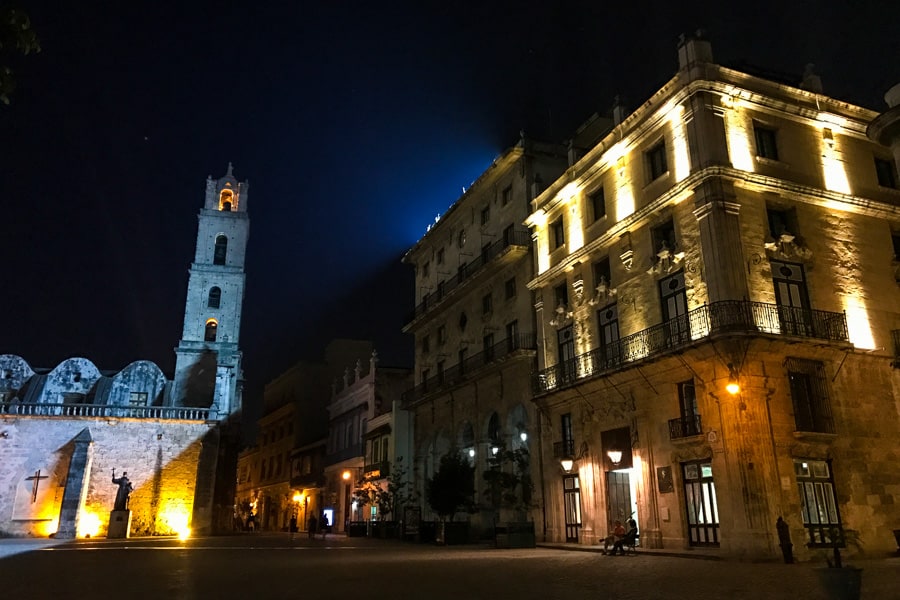
2 Weeks in Cuba Itinerary Snapshot Start & Finish: Havana, Cuba Distance: appx. 1,060km (660 miles) plus tours and day trips. How long do I need: This is a two week itinerary for Cuba, focusing on the island’s western half. Overnight stops: 3 nights in Havana, 3 nights in Viñales, 2 nights in Playa Larga, 2 nights in Cienfuegos, 2 nights in Trinidad and 1 night back in Havana.
What’s in this post?
Preparing for a Cuba trip Travelling to Cuba What’s the route? 2 weeks in Cuba Itinerary Day 1 – Arrive in Havana Day 2 – Havana Day 3 – Havana Day 4 – Viñales Day 5 – Viñales Day 6 – Viñales Day 7 – Playa Larga Day 8 – Playa Larga Day 9 – Cienfuegos Day 10 – Cienfuegos Day 11 – Trinidad Day 12 – Trinidad Day 13 – Return to Havana Day 14 – Depart Havana
This post contains affiliate links. If you choose to buy through these links we may earn a small commission at no extra cost to you. This helps us to keep Two for the World running. Thanks for your support.
Preparing for a Cuba trip
For us, travelling around Cuba felt a little bit like our younger backpacking days, when internet cafes were just emerging, our only insights into a place came via other travellers and a brick-sized Lonely Planet guide, and we carried a wad of travellers cheques.
Things aren’t quite as old school as that in Cuba (and internet access is apparently getting better and better), but there are still various things you need to be aware of, and be ready for, before you visit.
We’ve pulled together information on some of the practicals like visas, money, internet, getting around and accommodation in this Planning a trip to Cuba post.
Travelling to Cuba
Havana is the start and finish point for our Cuba trip and you can fly to Havana direct from various cities in Europe, the US, South America, the Caribbean and Mexico.
It’s important to check in with your home government’s travel advisory body and your nearest Cuban embassy or consulate for specific information on the requirements and documents you’ll need to travel to Cuba.
This can vary depending on your nationality, your purpose for travel to Cuba, as well as where you’ll be travelling to Cuba from (and where you’re headed after you leave).
Also, things change often, so please do research this thoroughly, and well in advance of when you plan to go.
What’s the route?
If you spend 2 weeks in Cuba following this itinerary for independent travel on the island, you’ll start with a couple of days in Havana, exploring the highlights of this vibrant city.
From Havana, you’ll make your way by bus to the spectacular karst country of Viñales, where colourful colonial houses line the streets and tobacco is still farmed in traditional ways. After a couple of days getting out and about in this World Heritage valley, you’ll travel by collectivo (shared taxi) to the low-key coastal town of Playa Larga on the infamous Bay of Pigs for time on the beach, in the sea and in the surrounding nature.
From Playa Larga, you’ll head east by collectivo and bus to the World Heritage cities of Cienfuegos and Trinidad, taking a couple of days to explore each of these beautiful colonial towns and their historic and natural attractions.
Finally, you’ll make your way back to Havana by bus, with time to enjoy one more afternoon and evening in the city before you farewell Cuba.
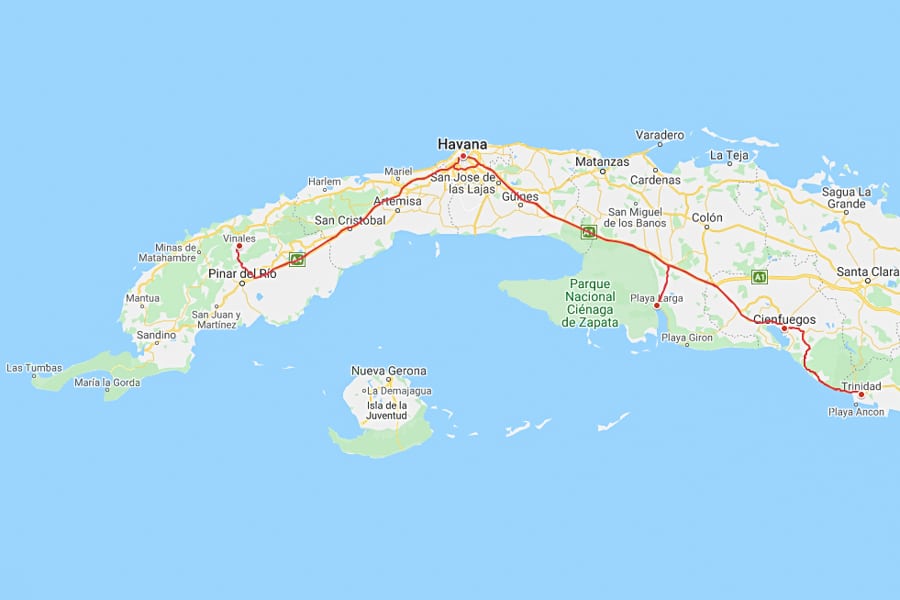
2 Weeks in Cuba Itinerary
Day 1 – arrive havana.
Highlights: City street wander | Sunset on the Malecón Overnight: Havana
Welcome to Havana! Today is set aside for arriving in Havana and getting settled into your accommodation.
Havana’s José Martí International Airport is around 20km (12 miles) south-west of the city centre. You can arrange a taxi when you arrive at the airport, or book a transfer in advance here .
Cuba’s 500-year-old capital is a crumbling, eclectic, photogenic and incredibly evocative city.
While the old town of Habana Vieja is the city’s tourist heartland, the colourful streets of Vedado and Habana Centro are buzzing at all hours as locals go about their business and socialise on their front steps.
We arrived in the early afternoon and, once we’d dropped our bags at our charming casa particulare (a private home that rents rooms), we set out to explore by foot.
Havana is a city to be walked. If you have time on your first day, we recommend doing the same and getting a feel for the city with a wander through the streets of Habana Centro and Habana Viejo.
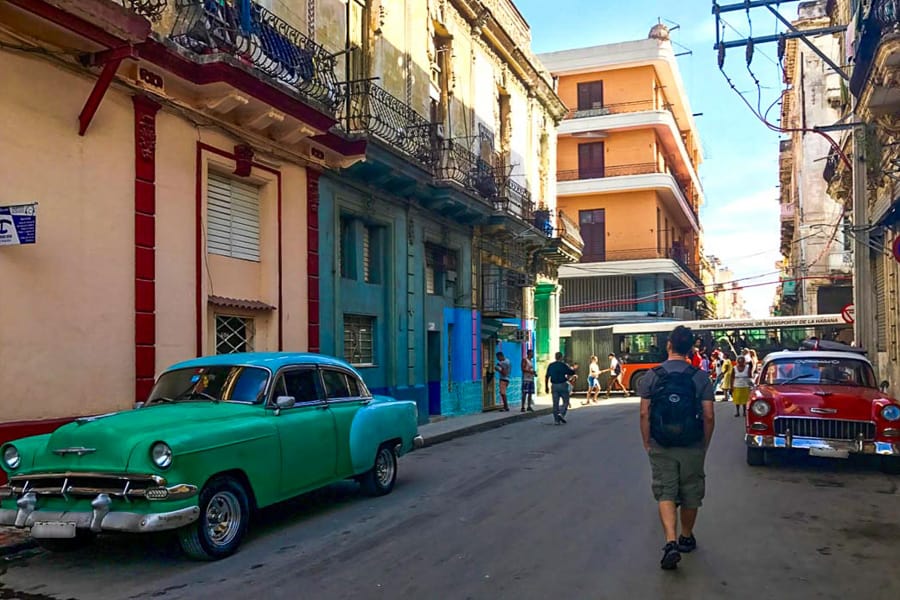
As the sun drops, make your way to the Malecón , the city’s 8km (5 mile) seaside boulevard on the north side of town.
The seafront strip comes alive in the late afternoon and early evening as locals gather and vintage cars cruise the stretch. Grab a mojito in one of the bars along the street and soak up the atmosphere. This was the moment for us that it really sunk in we were in Cuba!
Where to stay in Havana
The city of Havana covers a large area but most visitors will stay in and around the vibrant centre, in the neighbourhoods of Habana Viejo (Old Havana), Habana Centro and Vedado .
If you want to be based close to the major sites and in the heart of the action, look to Habana Viejo. Vedado is a little further out, but it’s a lovely, tranquil area full of beautiful historic houses. Between the two is Habana Centro which, while a little frayed-around the-edges, is a good spot for budget stays.
You’ll find a huge range of accommodation options in Havana, from cheap and cheerful casas particulares (rooms or areas in privately owned homes) through to high-end hotels and resorts.
Our stay in Havana, Casa Mirador La Colina , was a wonderful little oasis with a rooftop terrace in the suburb of Vedado, opposite the grand buildings of Havana University. While it was an easy taxi ride to Habana Vieja, we also enjoyed the 45-minute walk via Habana Centro.
Travel tip: Book your onward bus travel today. During your time in Havana, preferably on your first day if possible, book your forward bus ticket to Viñales. Buses can fill up quickly in Cuba, and buying tickets can be a less-than-straightforward process, so it’s important to get this organised at least a full day in advance. It’s also important to be aware that Cuba is currently experiencing fuel shortages, which may impact public bus and taxi services. Be ready with a back-up plan, just in case. There are a few bus companies in Cuba, but the main two we used are Viazul and Cubanacan/Conectando. Viazul has a website with an online ticket purchase function, though we haven’t used it and we’ve read it can be glitchy, not all routes are available, and you can’t use the website to buy tickets once you’re in Cuba without a VPN. In theory though, you could look at buying your tickets online before you arrive in Cuba (or make sure you arrange a VPN before you arrive – actually, do that anyway). Once in the country, Viazul bus tickets can be bought at the Viazul bus station in each city, which is also where the buses depart from. In Havana, the bus station is near Plaza de la Revolución. When we were in Cuba, tickets for Cubanacan/Conectando could only be bought at ticket desks in some hotels and travel agencies, and at last check this still seems to be the case. These buses do, however, pick up from certain hotels, which can be more convenient than travelling out to the Viazul bus station. Alternatively, you can travel between cities by shared taxis called ‘collectivos’, which can usually be arranged through your casa particulare or hotel. This can be a more expensive option than the bus but it’s convenient, and especially awesome if you end up with a vintage car for the journey, as we did on a couple of occasions. For more information about transport and travel in Cuba, check out our Planning a trip to Cuba post.
Day 2 – Havana
Highlights: Guided walking tour of Habana Vieja | Colonial plazas and streets | Taquechel Pharmacy | Havana museums Overnight: Havana
On Day 2, immerse yourself in Havana’s cultural highlights . The city is full of diverse period architecture, historic forts, vintage cars and a range of museums. Many museums are in beautifully-restored colonial mansions worth a visit for their architecture alone.
For a guided introduction to the city and to get beyond the façade of historic Habana Vieja, we recommend joining a guided walking tour. There are a couple of free walking tours in Havana, including this 3 hour tour of the city’s colonial highlights .
Afterwards, discover more of this area with a wander through the colourful streets, popping into the small galleries and peeking into the courtyards of shops along the way.
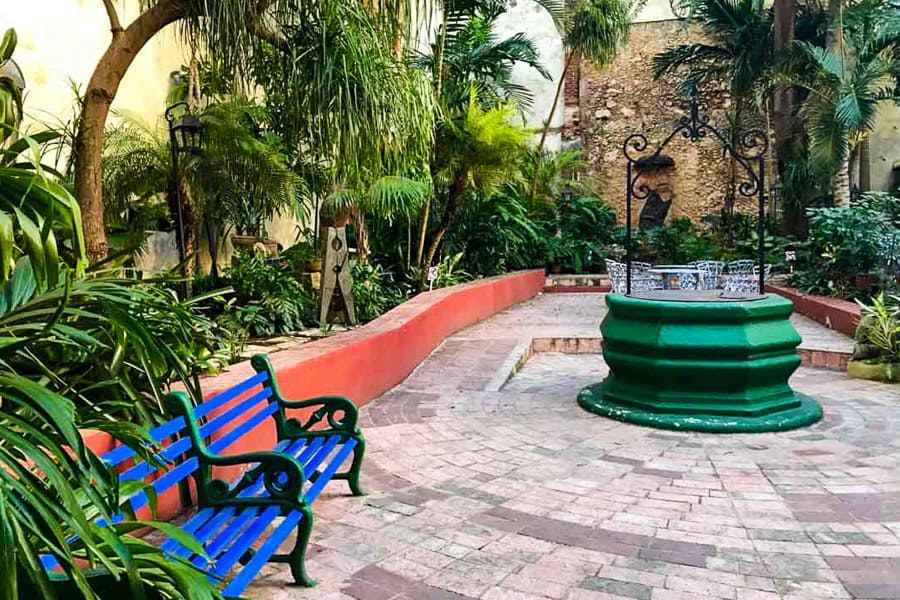
Be sure to visit the city’s beautiful squares – Plaza Vieja , Plaza de la Catedral and Plaza de San Francisco de Asis , where you can visit the historic San Francisco de Asis convent.
Check out the Museo Nacional de Bellas Artes (also known as the Museo de Arte Universal) for a foray into Cuban art, and pop into Taquechel Pharmacy Museum to see its beautiful colonial woodwork interior.
If you want to know more about Cuba’s political story and the revolution of 1959, head to the Museo De La Revolución , located in the old Presidential Palace in Habana Vieja.
We also recommend a visit to the Museo Napoleónico in Vedado, a beautiful Florentine Renaissance-style mansion now housing an excellent Napoleonic collection.
There are also a range of themed tours that will help you delve further into the street food, music and dance, culture and history of this vibrant city.
Don’t worry if you don’t get to see everything you want to in your first couple of days in Havana, you’ll have a bit more time in this ambient city at the end of this Cuba 2 week itinerary.
For more ideas on what to do while you’re in Havana, we’ve captured ten of our favourite Havana highlights in this post .
Day 3 – Havana
Highlights: Plaza de la Revolución | Necrópolis Cristóbal Colón | Cristo de Habana statue | Sunset over Havana skyline | Fortaleza San Carlos de la Cabaña Overnight: Havana
On the morning of Day 3, head out to explore some of the sites outside of Havana’s city centre.
One way to do this is aboard the hop-on-hop-off bus . There are mixed reviews about the bus as a tour in and of itself, but we found it a useful way to see some of the city’s more residential areas and to get to sites such as the Plaza de la Revolución and the Necrópolis Cristóbal Colón .
The Necropolis is the city’s sprawling, marble mausoleum-filled cemetery. It was a surprise highlight for us, and worth at least an hour of exploring. You can pick up a guidebook and map at the entrance to the necropolis and go your own way. Or join this free guided tour .
If you stay on the bus, the full loop takes around two hours. If a hop-on hop-off bus isn’t your thing, you could taxi to the Plaza and the Necropolis instead.
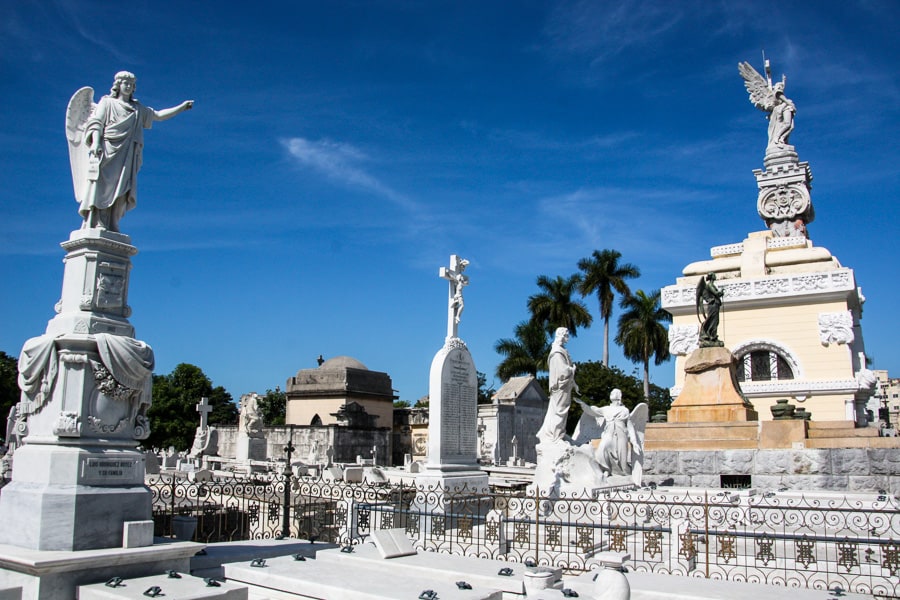
In the afternoon, make your way to the public ferry terminal a couple of blocks south of the Basilica San Francisco de Asis in Habana Vieja.
Take the ferry to Casablanca across the bay and walk up to the iconic marble Cristo de Habana statue with its panoramic views. Time your visit right and enjoy the views over Havana as the sun sets behind the city.
From there, you could head to the sprawling walled fortress of Fortaleza San Carlos de la Cabaña , the largest fortress in the Americas and part of Havana’s vast, World Heritage-listed fort system. There’s plenty to explore within the sturdy walls of the fort, which was built in the 18th century to protect this prize city from pirates, buccaneers and covetous imperial nations like Great Britain. It’s open late and there are some restaurants, bars and several museums within the walls.
Hang around for the 9pm Cañonazo , a nightly ceremony in which soldiers re-enact the historical firing of the cannon that once announced the closing of the city gates.
You can also see more of the sites around Casablanca with a guide before heading into the fortress on this late afternoon free guided Casablanca Neighbourhood tour .
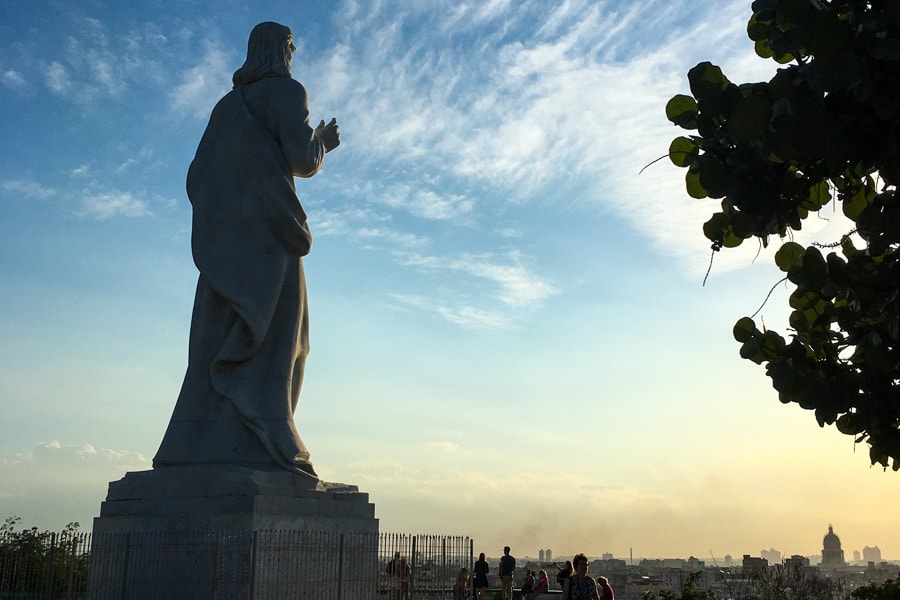
Day 4 – Viñales
Highlights: Viñales town wander Overnight: Viñales
On the morning of Day 4 of your Cuba travel itinerary, board your booked bus from Havana to picturesque Viñales. It’s a journey of around three to four hours to the south-west.
Charming Viñales is without doubt one of the best places to visit in Cuba. Life moves more slowly in this small rural town, and you can too. But there’s also plenty to do in the beautiful surrounding countryside . Three days gives you the chance to do both.
On your first afternoon, get to know this colourful town with a wander . Pop into the shops and stop for a spot of people watching in the main square as locals go about their day. Swing by the small handicrafts market off the main street, and drop by the small, lovingly-tended botanical garden at end of the road.
This is also a good time to swing by the local tourist offices in town and check out or book activities and excursions for the coming days.
Where to stay in Viñales
While the Valle de Viñales is more than 130 square kilometres (50 square miles), the town of Viñales feels more like a friendly village. It’s centred around the long main street, whereabouts you’ll find most of the restaurants, bars and services.
We stayed at Casa Campo Gladys Suarez , a fifteen minute walk from the centre, with a rooftop terrace overlooking the town and the valley’s mogotes, and sensational breakfasts and dinners prepared by the wonderfully hospitable Gladys.
Day 5 – Viñales
Highlights: Guided horseback (or walking ) tour to Valle del Silencio | Coffee and tobacco farms Overnight: Viñales
For our second day in Viñales, we set off into the countryside on a guided horseriding tour to the evocatively-named Valle del Silencio . We organised this through the casa particulare we stayed at, and we absolutely recommend this experience while you’re here. If you’d prefer to book ahead, check out this Viñales horse riding tour .
On our tour, we visited a small cave, a coffee farm and, of course, a tobacco plantation, where we learned the art of producing and rolling a classic Cuban cigar.
The Viñales Valley is also a wonderful place for hikes into the countryside, so an alternative to horse riding (or as well as horse riding) is a guided hike like this one to the Cave of Silence.
Wrap up your day with a home-made mojito at sunset on the porch or rooftop of your casa.
Travel tip: If the skies are clear, be sure to pop outside at night while you’re in Viñales. With little light pollution, the stargazing here is amazing.
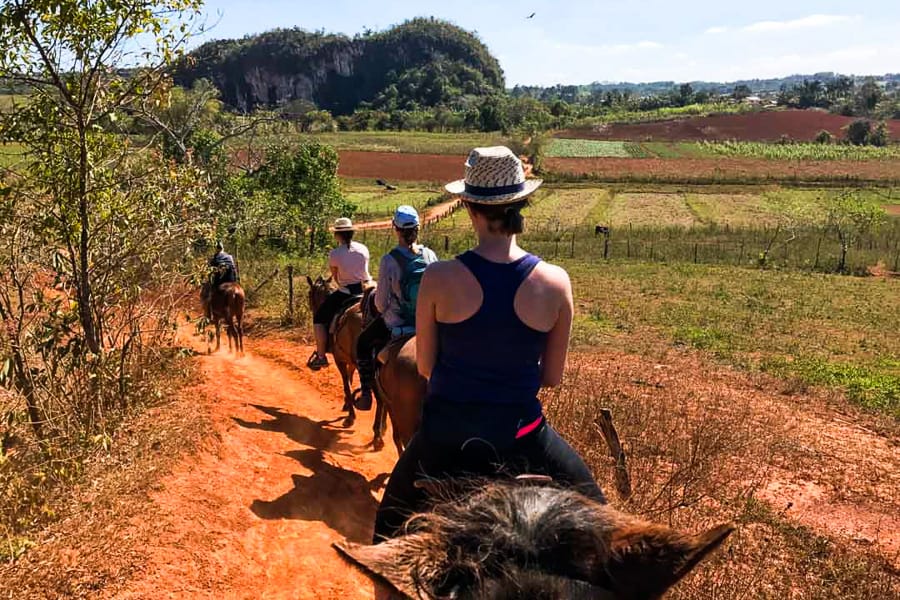
Day 6 – Viñales
Highlights: Cave tour | Bike ride through Viñales National Park | Mural de la Prehistoria | Los Jazmines lookout Overnight: Viñales
Kick off your third day in Viñales with a cave tour. The Viñales valley is scattered with mogotes , limestone outcrops that are riddled with caves.
We took a taxi out to Gran Caverna de Santo Tomás , just 15 minutes from town, where we donned head torches for a 90-minute tour of Cuba’s largest cave system. We organised our tour through the local Infotur office in the centre of town.
Travel tip: You’ll find Infotur tourist information offices in all of Cuba’s main towns. These offices provide free information on the destination and things to do, including tours and activities that you can book.
If you’ve still got energy this afternoon, consider a hike through Viñales National Park , or hire a bike and explore the valley by pedal power.
We hired a bike in town and cycled out to the region’s quirky Mural de la Prehistoria . Rather than try and describe this unusual, 120 metre-long cliffside painting, we say go see it for yourself. There’s an entry fee although it can be seen well enough from the road.
It’s a lovely ride to the mural, with fantastical mogotes rising from the landscape and tobacco drying houses making for a very photogenic scene.
From the mural, we biked our way up to the lookout at Hotel Horizontes Los Jazmines . It’s a solid ride uphill; if you’re after something less strenuous, take a taxi or the hop-on-hop-off bus but don’t leave town without checking out the spectacular valley vistas from this viewpoint.
We biked around independently but you can go with a guide on this Viñales Valley bike tour .
If you’d rather spare your legs altogether, there’s a hop-on hop off bus which is apparently a great way to get to a number of the sites around Viñales, including the Los Jazmines lookout and the Mural del la Prehistoria, as well as other attractions such as the Cueva del Indio , where you can take a short boat tour through the caves, the Canopy zipline park, and a couple of tobacco farms. The bus departs from Parque de Viñales on the main street at various times throughout the day (check the bus signs at the square).
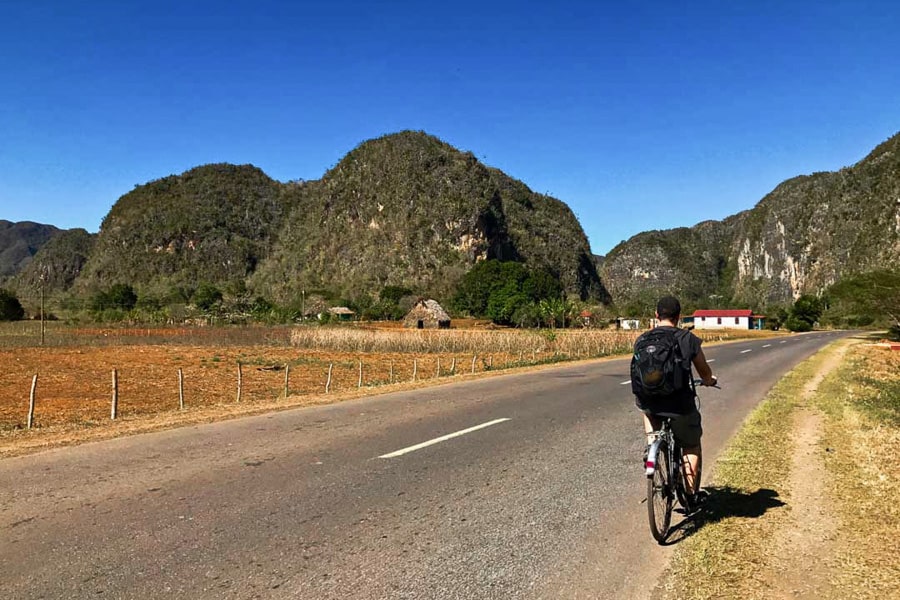
Day 7 – Playa Larga
Highlights: Afternoon on the beach | Freshly caught seafood dinner Overnight: Playa Larga
You could easily spend more days enjoying the country life in Viñales, but it’s time for a change of scenery. Next up on our 2 weeks in Cuba itinerary is some beach time at Playa Larga on the south coast.
As Playa Larga is off the main city-to-city routes, we found the easiest way to get there is by collectivo (shared taxi). We organised our collectivo through our casa particulare in Viñales. It’s a journey of around five hours door-to-door, and you’ll likely have a car swap en route (we did), as the first collectivo will be doing the Viñales to Cienfuegos run and will meet up with a taxi from Playa Larga on the way.
Playa Larga is a charming beachside fishing village on the shores of the infamous Bay of Pigs. Further south, the village of Playa Girón is the site of the Bay of Pigs invasion of 1961, a failed attempt to overthrow Fidel Castro.
This afternoon, after checking in, explore the town, take a walk along the shore, maybe chill out on the beach. Watch the sun set and then enjoy a delicious home-cooked feast of fresh lobster at your casa. The seafood meals we had in Playa Larga were epic.
Where to stay in Playa Larga
Playa Larga is a very small town with a couple of restaurants and bars. Many locals have converted their homes into warm and welcoming casas particulares with outdoor terraces.
Some, like our accommodation Casa Mesa , are literally on the beachfront. Our two-day stay here rates as one of our favourite Cuba highlights.
Find out more about staying in Cuba’s casas particulares in our Planning a trip to Cuba post .
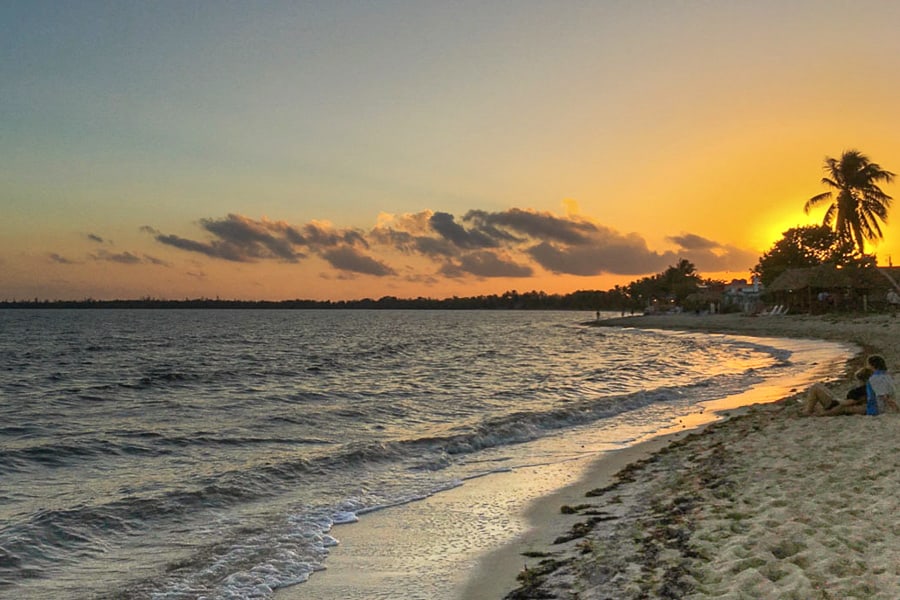
What about the beaches in Varadero? If you haven’t already heard of it, you will very likely come across Varadero in your Cuba trip planning. Varadero, on the island’s north side, is home to the country’s most famous stretches of pearly white sand and crystal clear water. Varadero is very popular with tourists seeking a tropical island holiday and a no-fuss, all-inclusive beach resort break. By all accounts though, while Varadero is a beautiful beach escape, it’s a world away from the real Cuba. Which is why we decided not to include it in our itinerary. Cuba’s south also has some gorgeous beaches and Playa Larga, which is not at all upmarket, is off the beaten track, low-key and very local. We also include beach time in this itinerary at pretty Playa Ancon in Trinidad and Rancho Luna beach in Cienfuegos. If you’re keen to include a stay in Varadero during your Cuba trip, you might consider adding a couple of days at the end of this itinerary. Or check out this day trip to Varadero from Havana. Alternatively, you could skip Playa Larga and do a couple of days in Varadero instead on the way back to Havana.
Day 8 – Playa Larga
Highlights: Diving or snorkelling in Bay of Pigs | Nature tour or activity in the afternoon Overnight: Playa Larga
Today we’re exploring the highlights in and around Playa Larga.
This is the gateway to Cienaga de Zapata National Park , a vast wetlands area of mangroves, seagrass beds and reefs, and a UN Biosphere Reserve. There’s plenty to see and do, from walking and birding tours to diving and snorkelling.
We opted to spend the morning scuba diving in the glassy waters of the Bay of Pigs.
If you have your own snorkelling gear, you can head straight off the beach, but organised scuba and snorkelling trips, including gear, can also be arranged through your accommodation, which is what we did. If you’re after specific dive sites, it’s best to make your own arrangements direct with your selected dive company.
Alternatively, or this afternoon, you might consider some of the other sites and activities around Playa Larga, a few of which we’ve outlined below.
- Guided tours of the Zapata Wetlands or the Bermeja Forest Reserve in the National Park can be arranged at the National Park office in Playa Larga.
- To the south of Playa Larga, you’ll find the Cueva de los Peces , a deep cenote that can be snorkelled and dived.
- Further south still, near Playa Girón, is the Sendero Enigma de Las Rocas , where you can join a guided nature hike to spot endemic wildlife and flora (tours here may also include a swim stop at Cueva de los Peces).
- For the Cuban take on the Bay of Pigs invasion, head to Museo Girón in Playa Girón (if you don’t speak or read Spanish, have Google Translate handy as the interps at the museum are in español).
- To the north of Playa Larga, there’s a crocodile breeding centre, Criadero de Cocodrilos , established to protect the Cuban and American species which were nearly wiped out in Cuba. We didn’t go here and we’ve read mixed reviews so we suggest doing your research before you go.
We really enjoyed Playa Larga and we’d love to go back and explore this fascinating area further. For us though, our short time here proved a very welcome rest stop ahead of our next destination, Cienfuegos.
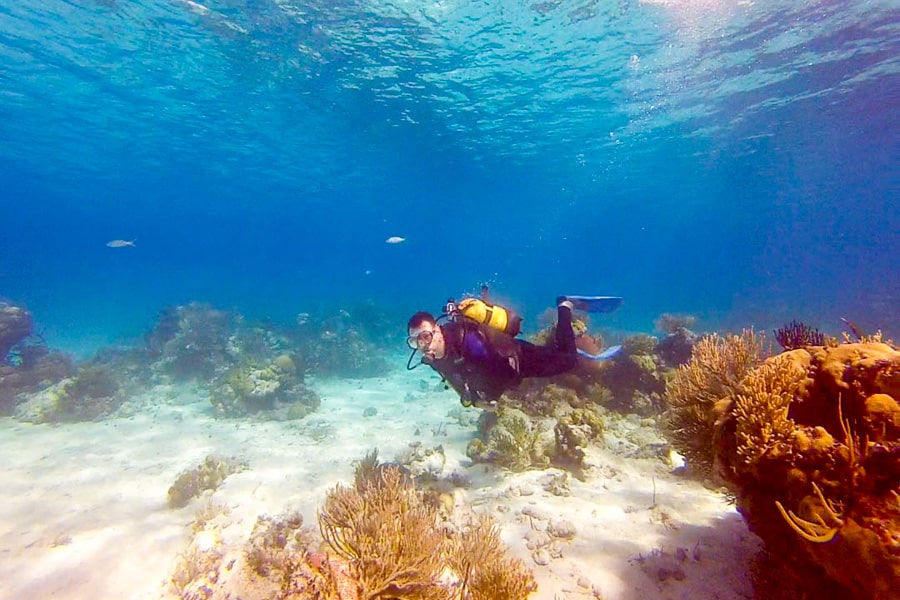
Day 9 – Cienfuegos
Highlights: Parque José Martí | Paseo del Prado | Museo de las Artes Palacio Ferrer | Teatro Terry | Malecón wander | Rooftop drink at Palacio de Valle Overnight: Cienfuegos
Founded by French migrants in 1819, the World Heritage city of Cienfuegos is around 90-minutes from Playa Larga and an easy collectivo ride.
We organised a shared taxi through our casa particulare and – unexpectedly – made the journey in a beautifully restored vintage Chevrolet Bel Air. Definitely the coolest taxi we’ve ever been in.
Historic Cienfuegos is centred around the lovely Parque José Martí . Spend today strolling the streets around the park and the wide, column-lined Paseo del Prado , snapping the French-inspired neoclassical architecture, and admiring the historic buildings that line the square.
Keep an eye out for the triumphal arch, the Arco de Triunfo (also called the Arco de los Obreros, or the Worker’s Arch), and the Palacio del Gobierno .
Head into the Museo de las Artes Palacio Ferrer to see its beautiful interiors and take in the views from the rooftop. Also on the square is Teatro Terry , worth a visit for its elegant marble and timber decor.
For a guided insight into the culture and history of this World Heritage city, check out this free 2.5 hour walking tour .
This afternoon, wander the Malecón seaside promenade around the bay to Punta Gorda , a neighbourhood of beautiful, eclectic old mansions. Pop into the Spanish-Moorish-style Palacio de Valle for a drink at the rooftop bar overlooking the bay, before heading back into town for dinner.
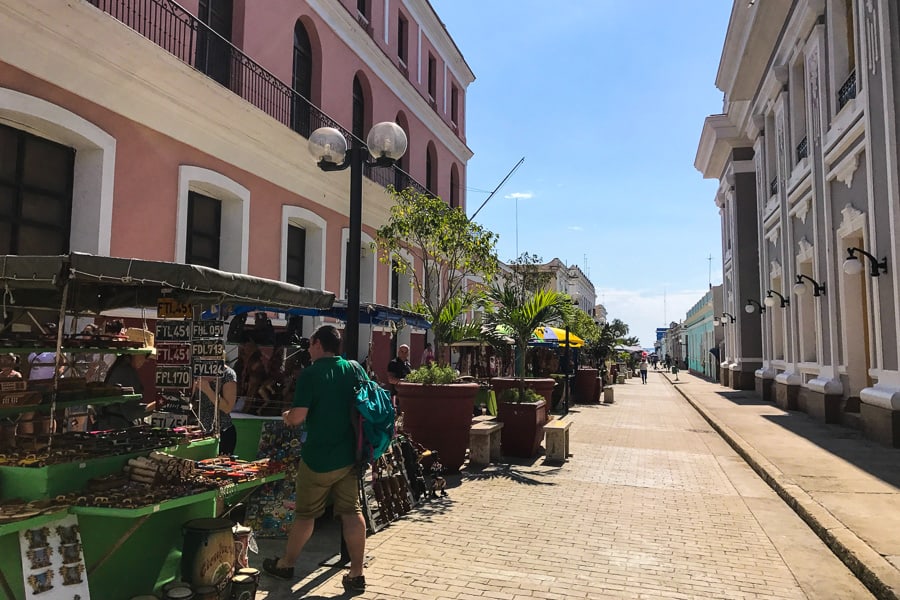
Where to stay in Cienfuegos
After Viñales and Playa Larga, Cienfuegos will feel like the bigger town it is. As we have just two nights here, we recommend staying within walking distance of the historic centre.
For a unique casa experience, and if you can get a booking, we recommend a stay at Casa El Patio Andalú , a highly rated casa particulare around 15 minutes’ walk from Parque José Martí. The hosts are artists and perform Cuban music and flamenco in their garden, where they also serve up delicious meals.
Travel tip: Book your forward bus travel to Trinidad today. If you’re planning on travelling from Cienfuegos to Trinidad by bus the day after tomorrow, then at some point today (and if you haven’t already sorted it out), arrange your onward bus travel as you need to buy your ticket at least a day in advance. You can either head to the Viazul bus station in Cienfuegos or find a Cubanacan desk to buy Conectando bus tickets. Your accommodation provider should be able to tell you where you can find a Cubanacan desk; they’re usually in the hotels where the Conectando bus picks up from. Alternatively, as it’s only a 90 minute trip, consider joining another shared taxi for this journey.
Day 10 – Cienfuegos
Highlights: Laguna Guanaroca | Castillo de Jaguan | Rancho Luna | Sunset drink at Hotel la Union Overnight: Cienfuegos
On your second day in Cienfuegos, explore some of the highlights surrounding the city. Hire a taxi for the day (easily organised through your accommodation) and plan an itinerary to suit your interests.
We visited three sites over the course of the day, starting at the mangrove-lined Laguna Guanaroca . There, we enjoyed a short walk to the lagoon where we boarded a row-boat for a trip out to see the site’s famous pink flamingoes.
Next, we ferried over to Castillo de Jaguan , a beautifully restored fortress built in the 18th century to protect the coast from marauding pirates.
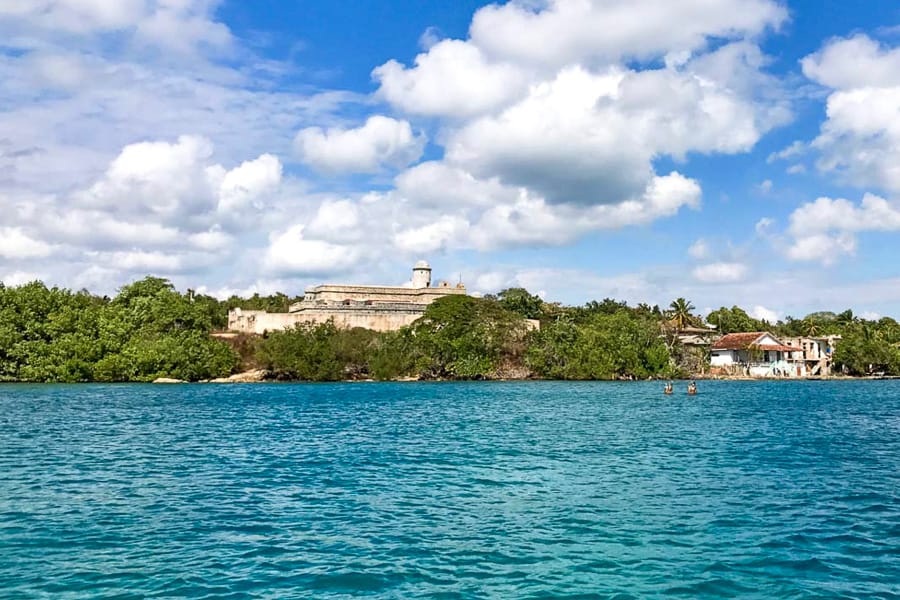
Our last stop was Rancho Luna , a pretty beach resort, for a late lunch and some time on the sand.
While we found it easy to sort out our experiences as we went, and did it all in a day, you can book guided tours in advance for both Guanaroca Lagoon and Castillo de Jaguan (this is a longer trip that also includes a cruise around the Cienfuegos bay).
An alternative experience for today, and one we’re sad we didn’t have time to squeeze in, is a day trip to the waterfalls of El Nicho , in the jungles of the Escambray Mountains. Check out that cool guided trip here .
However you roll today, wind up your day back in Cienfuegos with a drink at the rooftop Bar Terrazas at Hotel la Union. It serves up impressive views over the city and the bay.
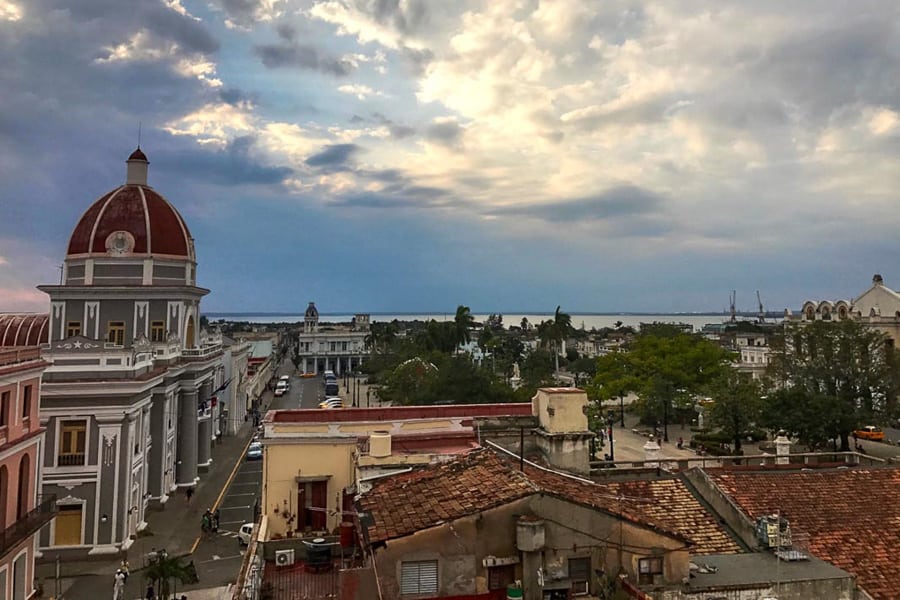
Day 11 – Trinidad
Highlights: Plaza Mayor | Iglesia Parroquial de la Santisima Trinidad | Museo de Arquitectura Colonial | Bell tower of Iglesia y Convento de San Francísco de Asís Overnight: Trinidad
The penultimate destination of our 2 weeks in Cuba itinerary is Trinidad, another World Heritage site and the second oldest city on the island.
Trinidad is only 90 minutes from Cienfuegos. If you’re taking the bus from Cienfuegos, you’ll need to have organised your bus ticket to Trinidad at least a day before you travel. Alternatively, you could organise a collectivo ride through your accommodation.
Spend your first day in Trinidad wandering the cobblestone streets of the city. More than five centuries of history weave their story through the town’s brightly painted homes, colonial mansions and towers.
In the heart of this historic city is Plaza Mayor , framed by beautifully restored colonial buildings and churches. Head into the impressive Iglesia Parroquial de la Santisima Trinidad , and also swing by the Museo de Arquitectura Colonial for an insight into what these wonderful old colonial buildings looked like inside in their heyday.
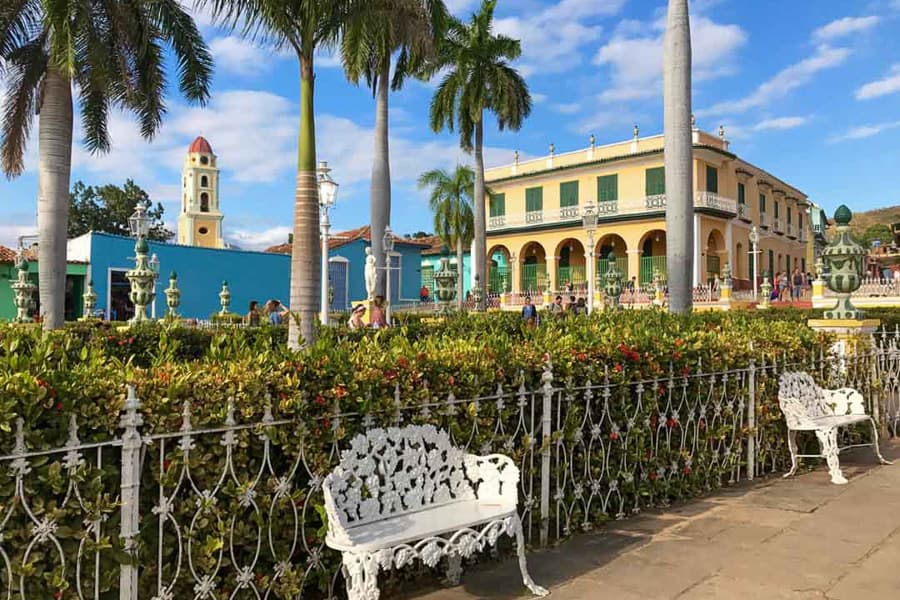
Climb the bell tower of the Iglesia y Convento de San Francísco de Asís for beautiful views over the town. Inside the former convent, you’ll also find the Museo Nacional de la Lucha Contra Bandidos , a curious military museum.
If you’d like to learn more about historic Trinidad in the company of a guide, book your spot on this free guided walking tour .
Plaza Mayor and the surrounding streets are usually buzzing with people throughout the day and evening. Walk a couple of blocks away from the main square though, and you’ll find yourself in Trinidad’s quiet backstreets; just you, a handful of locals, maybe a horse.
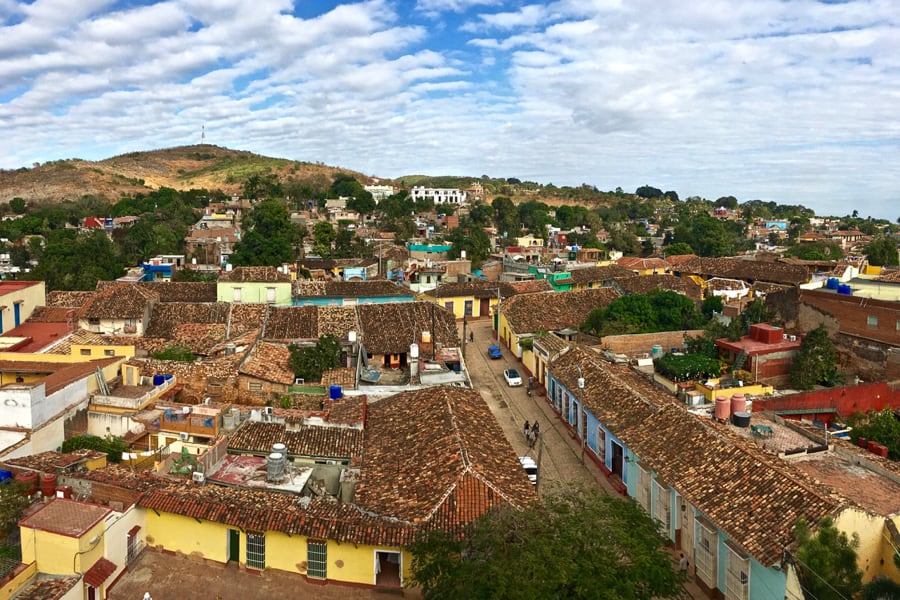
Travel tip: Book your bus back to Havana today. As buses departing Trinidad fill up quickly for all destinations, we recommend sorting out your bus back to Havana the day you arrive in town. Ask your accommodation where you can find the nearest Cubanacan desk for Conectando buses, head to the Viazul bus station to buy tickets, or visit the local Infotur office for information.
Where to stay in Trinidad
Lovely Trinidad is a small town centred on the historic area around Plaza Mayor. Even on the outskirts of town, you’ll only be a 20 minute walk from the main square.
Our casa particulare here was a lastminute switch from our first choice after a guest fell ill and couldn’t check out. Hostal La Esperanza is a charming little green house with a terrace, just five minutes’ walk from Plaza Mayor.
Day 12 – Trinidad
Highlights: Tour of Valle de los Ingenios | Afternoon at Playa Ancon Overnight: Trinidad
On your second day in Trinidad, arrange a tour to see some of the sights in the World Heritage Valle de los Ingenios (Valley of the Sugar Mills), a stunning landscape scattered with the ruins of sugar mills, the source of Trinidad’s once-great wealth.
On our day trip, we toured the historic ruins at San Isidro de los Destiladeros , and climbed the soaring watchtower at Manaca Iznaga before stopping for lunch there.
Having a guide for some or all of your visit to the Valle de los Ingenios is recommended. The history of the sugar mill industry and the stories of the people who owned them and the many thousands of slaves who worked in them form an important and complex weave in the fabric of Cuba.
While we arranged our own transport to the Valle de los Ingenios, and guides at the sites, there are organised guided tours from Trinidad that you can join, as well as guided horse riding tours through the valley.
We’ve also heard about a tourist train that runs trips through the valley but this wasn’t rolling when we visited, and we’re finding it difficult to confirm whether it’s running at present. Check with a tourist office in Trinidad if you’re interested in doing this.
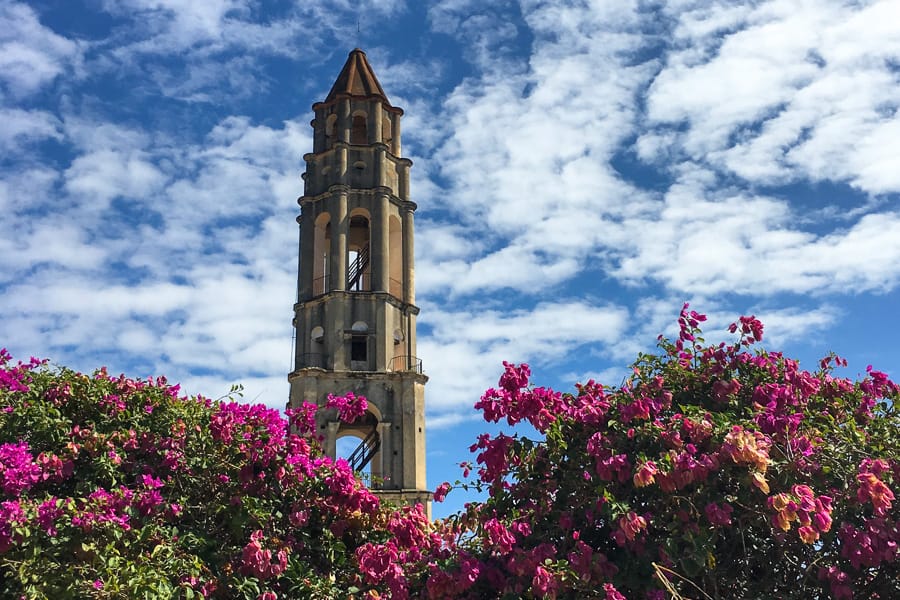
In the afternoon, make your way by taxi to Playa Ancon for a couple of hours relaxing on the beach. This is said to be one of the loveliest stretches of sand on Cuba’s south coast. There are some bars and restaurants at the beach, and you can rent umbrellas and sun lounges.
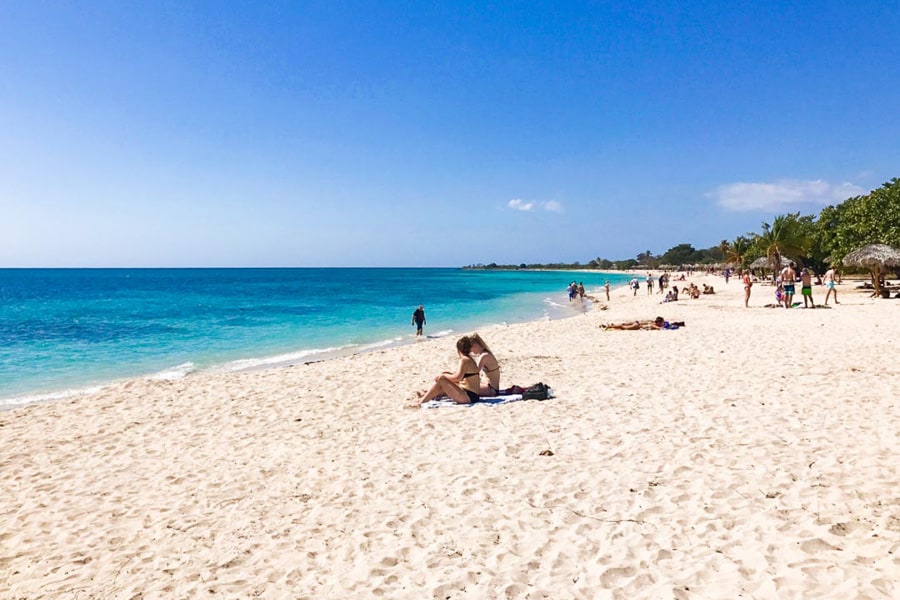
Travel tip: There’s lots to do around Trinidad so if you have more time, we suggest adding an extra day or two to your Cuba travel itinerary and spending longer here. You can hit the white sands of Playa Ancon and enjoy more time chilling on the beach, just 15 minutes from town. Or you could join a guided hiking tour in Topes de Collantes , a nature reserve in the Escambray mountains. While we didn’t get to do it ourselves, we also heard great things about the challenging 7km (4.4 mile) round-trip hike to Salto del Caburni , a 60-metre high waterfall with a natural pool to cool off in.
Day 13 – Return to Havana
Highlights: Hit up those sites or activities you didn’t get to on your first days here! Overnight: Havana
The last night of our two weeks in Cuba is spent back where we started, in Havana.
As the bus journey from Trinidad to Havana can take anywhere from 5 to 7 hours, aim to be on the earliest bus you can out of Trinidad so that you arrive in Havana in the afternoon.
Once you’ve dropped your bags at your accommodation, head out for a final afternoon and evening of sightseeing. Head to that museum you didn’t get to last time, or sample Havana’s famous local tipple on a tour of the Museo del Ron Havana Club .
If you’re a classic car apprecianado , you could take the opportunity to do a vintage car cruise along the Malecón at sunset, or enjoy a final mojito overlooking the promenade at Havana’s famous Hotel Nacional .
Day 14 – Depart Havana
Sadly, we farewell Cuba today.
Give yourself plenty of time to get to the airport. The car journey will take around half an hour or more, depending on traffic. Book your transfer back to the airport here .
If your flight leaves later today, make the most of your final hours in Havana and tick off any last sites or attractions you’ve been wanting to see.
Otherwise, wrap up your trip back in Habana Vieja with a daiquiri at Hemingway’s favourite haunt, Floridita , and reflect on an amazing two weeks in Cuba.
Then start planning your return to explore the island’s east!
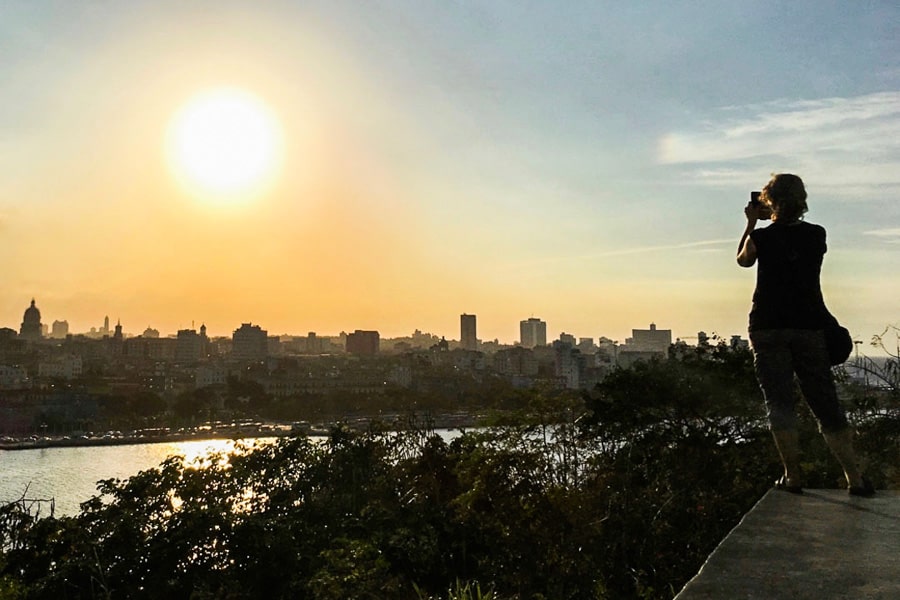
If you have any questions or comments about our 2 weeks in Cuba itinerary, drop us a message below. For more tips on travelling to Cuba , check out some of our other posts, including our Planning a Trip to Cuba guide .
11 thoughts on “2 Weeks In Cuba Itinerary for the Independent Traveller”
That’s a great article. I’m going to be travelling to Cuba in March and will be following a similar route. I’m getting my budget together. Roughly how much does it cost to hire a taxi for the day?
Hi Anne, thanks so much for your message. Taxi costs can be a bit of a grey area as they are often negotiated per trip, some taxis (collectivos) are shared, some are private, etc. Prices can also vary between cost per kilometre or set rates, depending on whether you’re travelling around a city, travelling between cities or hiring a taxi to day trip to different sites. The hosts at our casa particulares were always happy to help us arrange taxis too. When we daytripped the Valle de Ingenicoes from Trinidad, we arranged a taxi for the day with a couple of other travellers staying at our casa to share the costs. That was around USD20 per couple for the day, though prices have likely gone up since. There are some posts online with detailed taxi cost breakdowns that you may find useful.
All the very best for your trip, we hope you have a wonderful time! Dan
Thanks Dan.
Great information, it is really helping us plan our trip.
One question: when did you go? Specifically, what time of year? I ask this because you seemed to book a lot of things last minute, but as we are going in December (no choice), we are trying to work our if that is feasible for us.
Thanks. Ian
Hi Ian, thanks for your feedback and questions! We visited Cuba in late January/early February so well and truly within the peak period, but we are conscious that Cuba is becoming ever more popular as a destination and the first quarter 2023 tourism statistics bear that out. Were we to visit again, we would certainly be inclined to book ahead where possible. Actually, we’ve been finding we need to book ahead more often just about everywhere we travel post-Covid! All the best with your planning and your trip – Cuba is a fantastic destination. Happy travels!
Great itinerary,
Although I have visited Cuba twice already, there are still plenty of things I’d like to do.
Thanks for giving me some fresh ideas for my next trip!
Thanks very much for the kind comment, we’re really glad you found the post useful.
Like you we’d love to go back and see more – I hope we both do.
All the best John and Danielle
Hi John & Dan, your itinerary looks amazing and it looks like you did a great job in maximizing your time there! May I ask what time of year you were in Cuba?
Hi Nic, thanks for your lovely feedback! We travelled through Cuba in February during the dry season. We lucked out with bright sunny days for most of the trip and daytime temps in the mid-20s Celsius. Hope you have a chance to visit. Happy travelling! Dan & John
Hey this is a great review and sounds exactly like the kind of trip I’d like to do next year. Would you specifically recommend any of the ‘casa’s you stayed in? Thanks!
Hey Liz, really glad you found the post helpful. While I’m sure the accommodation scene in Cuba is changing rapidly, of the places we stayed, the ones that really stood out were Casa Mirador la Colina in Havana (we stayed here twice and the owner Aymee really looked after us amazingly), and Casa Mesa right on the beach at Playa Larga (home cooked lobster to die for) – right next to the well known Hostal Kiki which also looked pretty good and we think is owned by the same family. We’re sure you will find Cuba as amazing as we did and would love to hear how you go.
All the best, John and Dan
Leave a comment Cancel reply
Save my name, email, and website in this browser for the next time I comment.
No products in the basket.

21 things you need to know before travelling in Cuba
Updated On 14th January, 2022
Are you going to Cuba and looking for top tips for travelling in Cuba? Then look no further! In this blog post, I’m going to highlight all the best Cuba travel tips and everything you need to know before travelling to Cuba, one of the best places to visit in North America. We’re going to cover everything from what to pack before you go, currency when you arrive, what to expect from the food, and more!
Cuba is a fascinating country that is on many people’s bucket lists. A visit to this nation is guaranteed to feel like a time traveling experience, with countless, colourful old towns to visit, and vintage cars that go back to the 1930s to ride in.
On top of its rich and visible history, Cuba boasts a wide variety of natural beauty, from waterfalls to rainforests, mountains to wetlands and of course, the white sand beaches and turquoise waters typical of any Caribbean location. This, all combined with the endless music, mojitos and salsa dancing spilling onto the streets, easily makes this country one of my favourite destinations in the world.
However, travelling in Cuba tends to be slightly different to other places, so if you’re planning a trip to this beautiful Caribbean island, here are my Cuba travel tips including everything you need to know before you go…
- St Lucia: the Body Holiday
- The best things to do in Costa Rica
- The best outdoor adventures in Argentina
- 15 best USA National parks to visit
- A 2-day itinerary for Zion National Park
- Cenote diving on the Yucatan Peninsula in Mexico
- The best things to do in Argentina
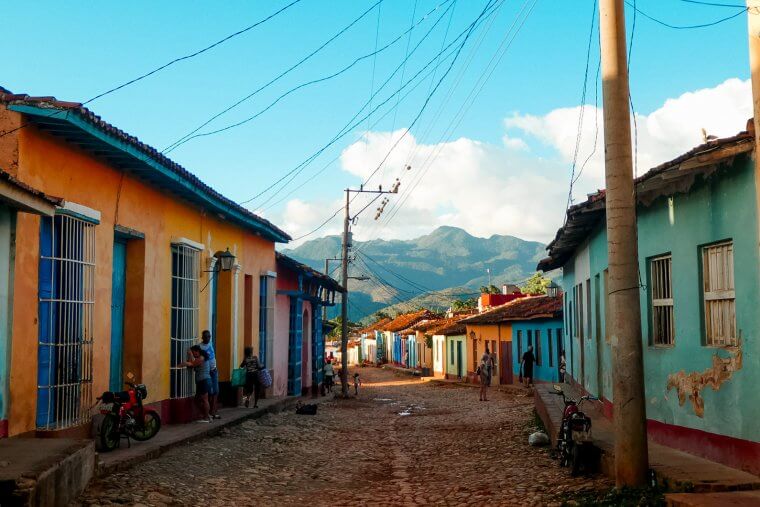
Cuba travel tips: 21 things you need to know...
1. visit cuba in shoulder season for the best balance of weather and prices.
If you’re wondering when to visit Cuba or when the best time to visit Cuba is, then I would say shoulder season, in March / April.
Cuba has a hot, sunny, tropical climate with dry and wet seasons: the dry season runs from November to April, the wet season from May to September. However, even during the wet season, you can still expect hot temperatures – people who travel at this time say the rain doesn’t last long!
Peak times to travel to Cuba are mid-December to mid-March, and all of July and August.
March & April are the best months to visit Cuba if you’re looking for a good balance of nice weather and reasonable prices without too many crowds!
2. Check visa requirements for Cuba
Anyone who does not have Cuban residence is required to have a visa to travel in Cuba. You can apply for the visa through the Cuban embassy, through your airline, or through several websites. Find out more details through your airline or your local government website.
Note that travel from the US to Cuba for solely touristic purposes is banned, and you need to travel for one of these 12 reasons .
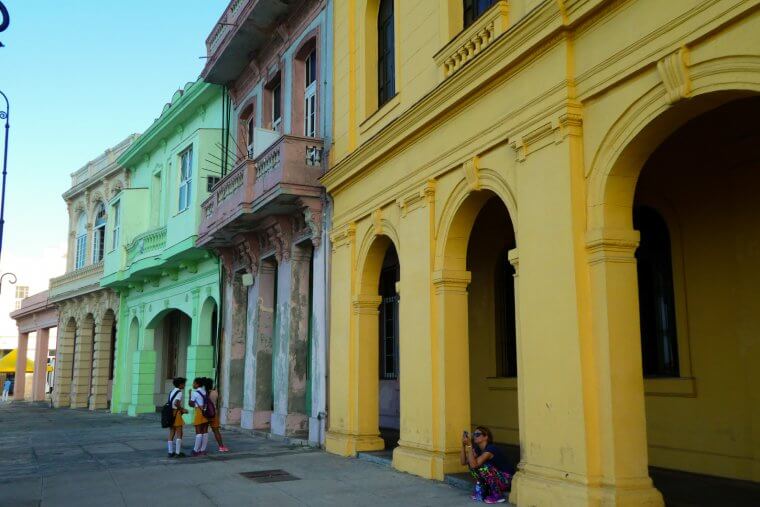
3. Bring print outs of all required documentation
With internet roaming charges being high, another of our Cuba travel tips is bringing print outs of all documentation you will need to show at the airport: boarding passes, vaccination certificates, visas, accommodation bookings, health insurance, and an onward flight booking.
Keep these documents safe in case you need them during your stay and you can’t get to them online!
4. Cuba is a communist state; be mindful of talking politics
Cuba is a communist state, and very different to what we are used to in the west. Seeing this can be fascinatiing, but you need to be mindful.
There is no advertising or branding, and the internet is censored. Even coca-cola is banned! Food and other items are bought using ration tokens and due to import sanctions, there isn’t a whole lot of it. You may also notice the little maintenance that has taken place in the country, with some buildings even left crumbling into the street.
You’ll likely be curious about the history and politics of the state, so maximise your experience by attending museums, but be aware that all the information put out is state-controlled. It is also important to remember that while politics may be interesting for you, many Cubans are not comfortable speaking openly about the government and these topics should be dealt with sensitivity.
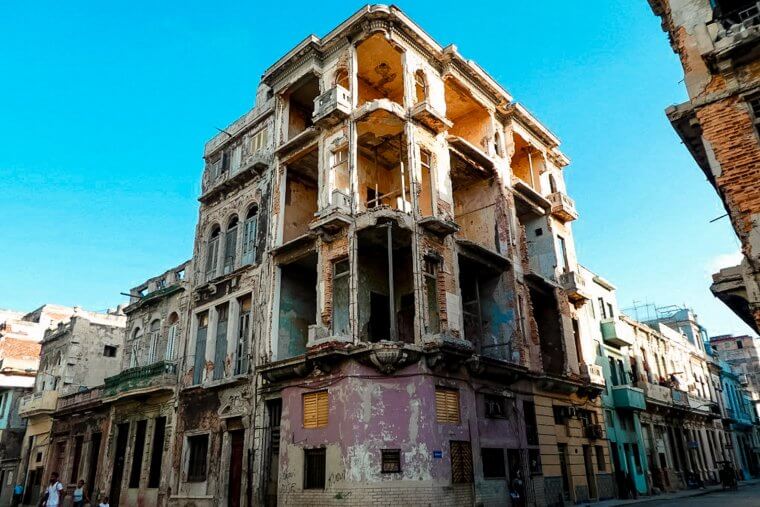
5. Pack everything you need: rationing and import sanctions can mean supplies are limited
Due to the import sanctions, stores in Cuba are different to what you’re probably used to. They might have very little stock, especially in terms of anything fresh, but are also extremely expensive where you might not expect it. To avoid paying upwards of £10 for one pack of toothpaste and some shampoo, one top tip for travelling in Cuba is to pack all the toiletries and goods you may need, including medication, before coming to Cuba.
Tap water is not clean enough to drink in most places and bottled water is wasteful and expensive, so bring a water steriliser if you have that too!
You might also want to pack some little toys or candy to ive to the local children as a gesture, as you may not always have the coins to give to those in need. You won’t have much luck finding these items in a store in Cuba, so pack some before you head off on your travels.
6. Don't bring a drone to Cuba
Drones are banned in Cuba, so to avoid having it taken away at customs and paying a holding fee to collect it on your way out, don’t bring yours!
7. Book your accommodation in advance
At least for the first few nights…! With the internet being expensive and not always easy to access, and there sometimes being problems with apps like Airbnb, Cuba is a destination where I’d suggest booking accommodation in advance. You usually need to show an accommodation booking at the airport customs.
Having said that, owners of casa particulares often know someone else in another town, so they can sort you out with a local recommendation if you dare to be more spontaneous!
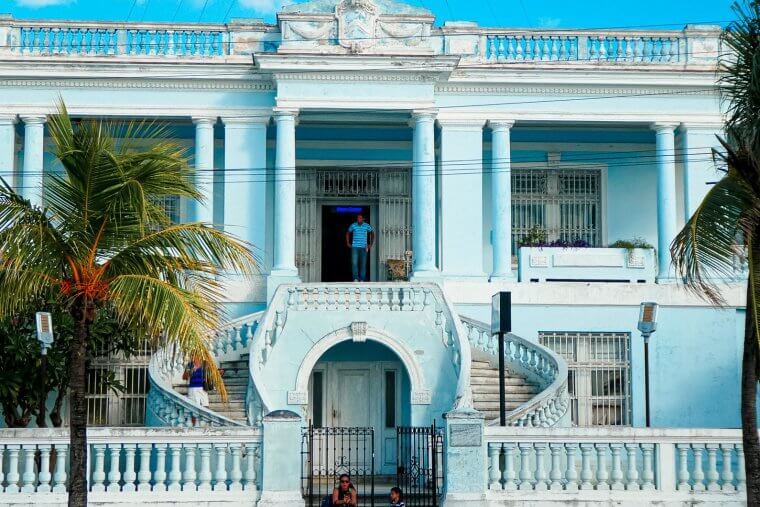
8. Live with locals in casa particulares
Despite some things separating tourists and local Cuban people, there are many ways to share experiences and get to know the country more authentically. While you’ll likely be more than welcomed to play dominoes with them, try your salsa moves with them or practice your Spanish over a mojito, the best experiences I had came from sitting around a dinner table together.
Under the system of casa particulares, host families are allowed to open up spare rooms in their homes as accommodation for tourists – like a B&B, but usually in the owner’s home. You are likely to come out of your stay with a new friendship and local knowledge, as Cubans are such welcoming, kind and friendly people. This was an absolute highlight of my trip and one of the best things to do in Cuba – I even remember shedding a few tears as I parted from my Havana host family because they were that amazing!
You can book casa particulares on booking.com , Airbnb , hostelworld , or turn up and see what you find! I’d recommend booking in advance where you can, at least for your first stay – you usually need to show an accommodation booking at the airport customs. If you use Airbnb to book a casa particular while you are in Cuba, use the browser because the app doesn’t work well.
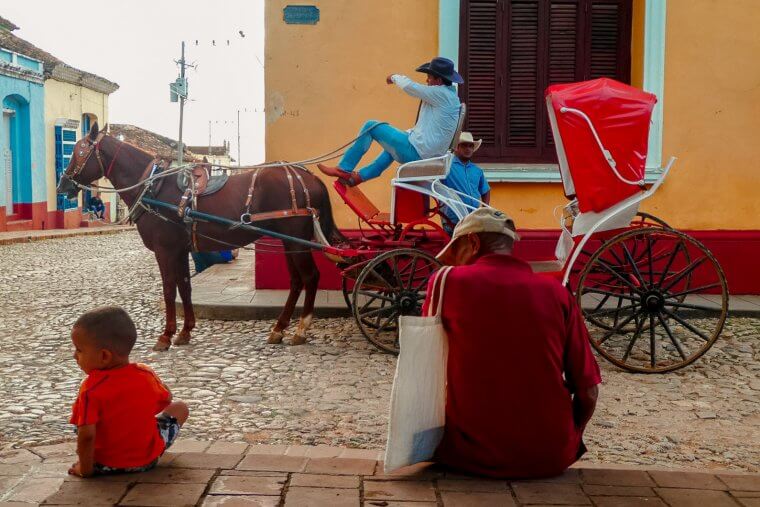
9. Plugs in Cuba are 110v.
Many hotels and other accommodation providers will have a plug converter, but one of my Cuba travel tips is to pack one just in case!
10. Currency in Cuba is the Cuban Peso (CUP) - bring all the cash you want to exchange
Cuba recently underwent an economic reform, so there is now only one currency in Cuba: the Cuban Peso (CUP). There are a few shops that will also only sell in “hard currency” (euros, GBP, dollars) or with credit cards in these currencies.
You cannot buy CUP outside of Cuba; the best way to get money is to bring cash with you in euros, GBP or Canadian dollars, and exchange at the airport. You’ll need to look for the CADECA office (you will also find these offices in larg towns like Havana).
While paying by bank card and using cash machines is becoming more common, ATMs can be far and few between and usually have significant surcharges so bring as much cash as you can (maybe bring a money belt or stash some in a suitcase pocket).
More Cuba travel tips in terms of money include…
- American owned cards are not accepted so bring a Visa or other card.
- Euros, GBP and Canadian dollars will get a better exchange rate than US dollars (there’s an extra 10% fee on US dollars).
- Don’t expect the same low prices as other neighbouring Central American and Caribbean countries – Cuba can be surprisingly expensive for this region.
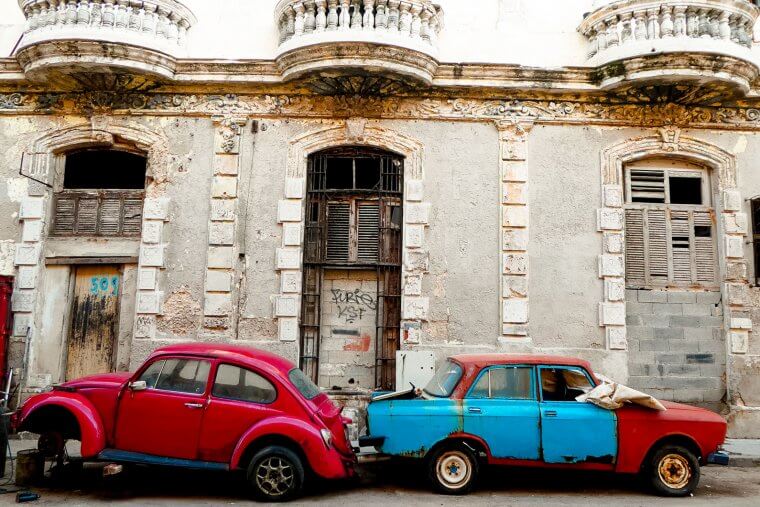
11. Internet access can be limited in Cuba
Internet is more accessible than it used to be, but still somewhat restricted in Cuba. Whilst it is not totally unavailable, you certainly won’t be able to access it at all times or without a steep price, so be prepared to spend some time off the socials and away from the work emails. Another of our top tips for travelling in Cuba is to check with your accommodation as to whether there will be wifi; it’s becoming more common, but don’t take it for granted that it will be there.
If you find yourself in a park and everyone is looking at their phone, you’ve likely hit a public wifi hotspot. Public internet hotspots in Cuba are mostly in parks or other gathering spots. This is the cheapest way to get access to the internet in Cuba (SIM cards and data roaming are expensive). You can see a complete list of all the public wifi spots in Cuba on the ETECSA website .
To access wifi at public hotspots, hotel bars or gathering places, you’ll need an internet card to connect to the internet. These Cuba internet cards, called NAUTA cards, can be purchased at ETECSA stores. You can also purchase them from people near public hotspots, but they are often more expensive. They have a password on the back which you enter on your internet browser, and will give you a certain time period in which to use the internet on your deveice’s browsers/apps.
Less frequent internet access also means less researching on the ground, or if you are like me, less scouring at reviews on Google Maps while you are strolling through a city. A travel guide, a printed/downloaded map and some research before you land will definitely stand you in great stead when visiting Cuba. I urge you to do all three of these things because as useful as the travel guides can be, their recommendations see price inflations over time and you will be totally lost if you misplace the one book you have to guide you around the country!
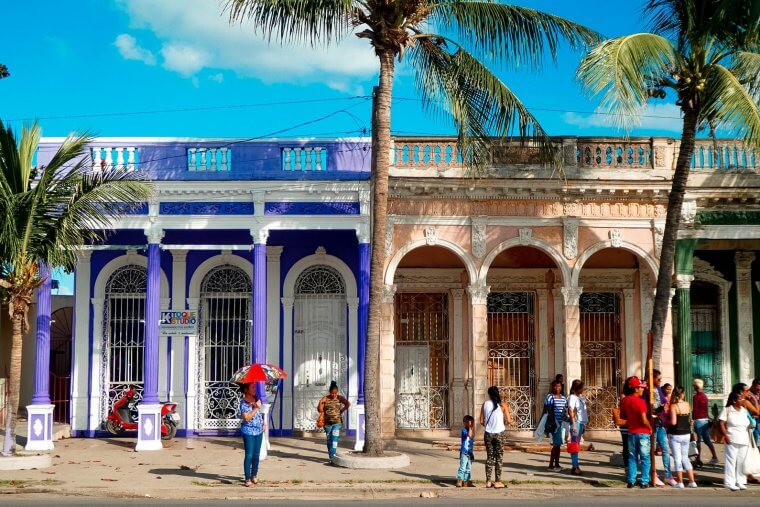
12. Cuba is an extremely safe country
Cuba is an extremely safe country. Not only are crime rates very low, but in my experience, Cubans were some of the kindest people I’ve ever met and there is a sense that people are more prepared to look out for you, than ever hurt or harm you.
On top of that, you can also feel extremely safe in terms of your health. With the health insurance that you purchase before travel you’re in safe hands with Cuban doctors if you get sick. (Note: bring over-the-counter medication with you for ease).
The only experience that took me by surprise at first, was the (quite relentless) catcalling. Yet, after some research, including listening to Chen Lizra’s TedX talk on the culture of seduction and flattery in Cuba, I came to realise that this country of Salsa and Rumba, has a different attitude towards catcalling.
In a place where there is no advertising and images of supermodels on every other building or product, beauty is recognised and appreciated in everybody. When I noticed how being called ‘linda’ and ‘preciosa’ was occurring to women of all ages, shapes and sizes, I began to recognise it for it’s more innocent meaning, which is flattery or ‘piropos bonitos’.
Obviously, this is a very different culture to what many are used to. It’s not to say you must agree with it, but simply to highlight the general harmlessness of catcalling in Cuba. I can confidently say that despite all the attention, I never felt threatened or in any danger in these situations, unlike how I feel about catcalling elsewhere in the world, where it can be more rude, sexually threatening and certainly have more malicious intent.
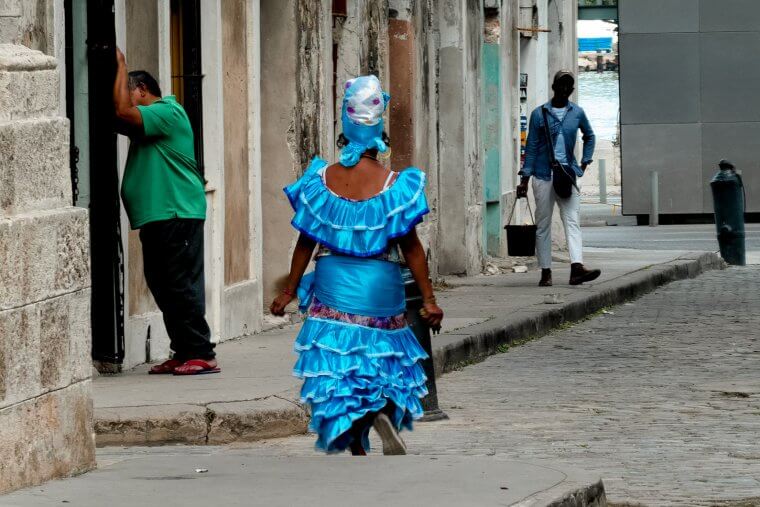
13. Travelling around Cuba by bus is easiest
Travelling in Cuba is really easy by public trasnport; the tourist buses are run by a company called Viazel. The roads in Cuba are good, the bus fares are reasonable, and the drivers are sensible.
A top tip for travelling in Cuba by bus is to bring some layers with you – they often blast the air con and it can get chilly!
14. Use the Cuba-Taxis in Havana
These nifty, little cabs are the Cuban’s take on the tuktuk. They are the most bizarre, but worthwhile mode of transport to take you through Havana, as they whiz through the crowded streets with unrivalled navigation and speed. Not only will they fulfill your thrill-seeking needs, but they cost half as much as the vintage taxi! Definitely a money-saving Cuba travel tip you need to know!
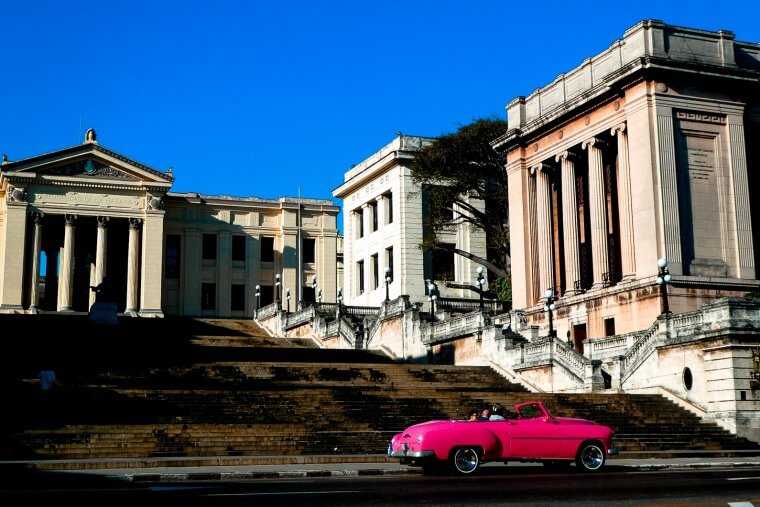
15. Tourists and locals have different experiences
You may notice a difference in where and what tourists and locals can go and do. Since the monthly Cuban salaries are around $25 a month, a $10 meal in a restaurant won’t be bought by many locals. In the same vein, transport and certain areas can often be separated so don’t be shocked if you are rejected for a local bus or area for being a tourist; it is just the way things function in Cuba. In part, this can make travelling feel less free, especially as travelling ‘off the beaten path’ can be more difficult and expensive.
However, as long as you avoid all-inclusive resort destinations such as Varadero you are bound to have an authentic Cuban experience.
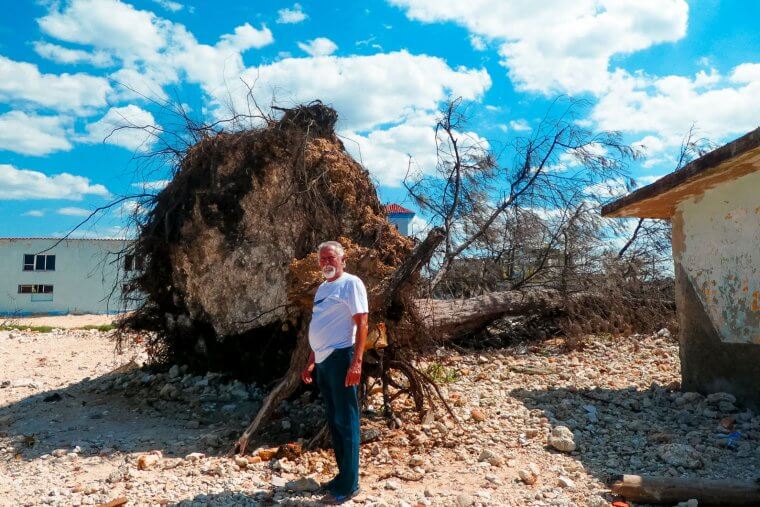
16. The food and coffee are different to what you might expect... and don't drink tap water in Cuba.
Don’t go to Cuba expecting the type of street food you’d get in Mexico, regardless of how close the two are. Due to import sanctions and rationing, food is quite limited and often pretty simple – get used to rice and beans!
Also, coffee always seems to be on the weak side – ask for a double shot or extra strong if you rely on your coffee like I do.
Remember that you cannot drink the tap water in Cuba, so either drink bottled water (which can be expensive and hard to find – check petrol station shops if the local supermarket doesn’t have any) or, to save on plastic, one of our Cuba travel tips is to bring a water steriliser with you.
You might be able to cook in your casa particular but it’s more likely that the family will offer to cook for you. In my experience, this was mainly a breakfast service which was a great way of trying local, homemade cuisine, plus the portions were always extremely generous and fuelled us well for our long days out in Cuba.
Having said that the food is plain in many places, more restaurants are opening up and we did eat some great food at the following places:
- Lamparilla 361, Havana – amazing tacos.
- Cafe Real, Trinidad – great food and live music.
- Cafe Arcángel, Havana – cutest interior!
- Lo de Monik, Havana – best Cuban sandwiches.
- Cafe Laurent, Havana – great fish.
- Los Toneles, Holguin – Family run, lovely atmosphere.
17. Don't forget to tip
Many professions in Cuba such as waiters, taxi drivers, tour guides and cleaners rely on tips to support their income. One of our Cuba travel tips is to always carry some coins with you to tip local staff, e.g. waiters in restaurants, taxi drivers (the ones you have a meter – if they don’t they are private drivers, and you should negotiate the rate before you leave), and toilet attendants.
Just bear the exchange rate in mind before you tip – wages for these kind of jobs are often around 20-30 USD a month, so 1-3 USD tips are very generous without ruining your budget.
18. Bring mosquito repellent for the sandflies at the beaches
You might not think to bring mozzie repellent for the beach typically, but this is one of our top tips for travelling in Cuba. You’ll find sandflies at the beach and protecting yourself against them will stop them ruining a relaxing day in the sun!
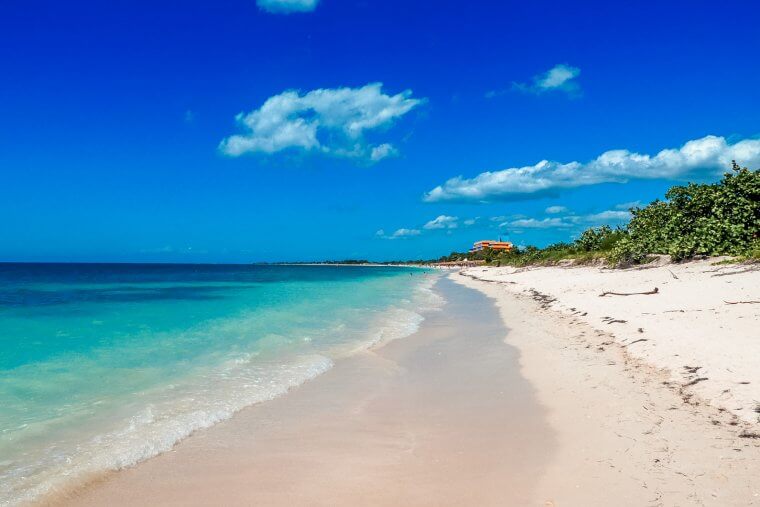
19. Go to El Nicho Waterfalls with a local tour guide
The incredible Cascate El Nicho is not the easiest and cheapest spot to get to in Cuba, but make it happen if you can, it’s worth it as it’s one of the best things to do in Cuba. I found the best option was to go with a group and a guide, which included the transport, food and access to the waterfalls for the whole day. There are several falls in this lush forest, and the guides are great at explaining all the flora and fauna around you. There are plenty of swimming and rock-jumping to enjoy in the emerald waters of el Nicho, so it’s the perfect addition for a bit of adventure in your Cuban itinerary.
20. Bring your dancing shoes!
Cuba is home to Salsa – one of the most beautiful, sexy and exciting dances in the world, and you can tell this nation is its origin… On practically every street corner of Havana there will be some music playing and people dancing and singing. So bringing your dancing shoes / outfits or confidence – whatever is necessary, and start twisting those hips! My favourite places to do this were:
- Disco Ayala el Cuevo, Trinidad – a nightclub inside a cave!!
- Bar restaurant 1838
- Club de la music, Trinidad
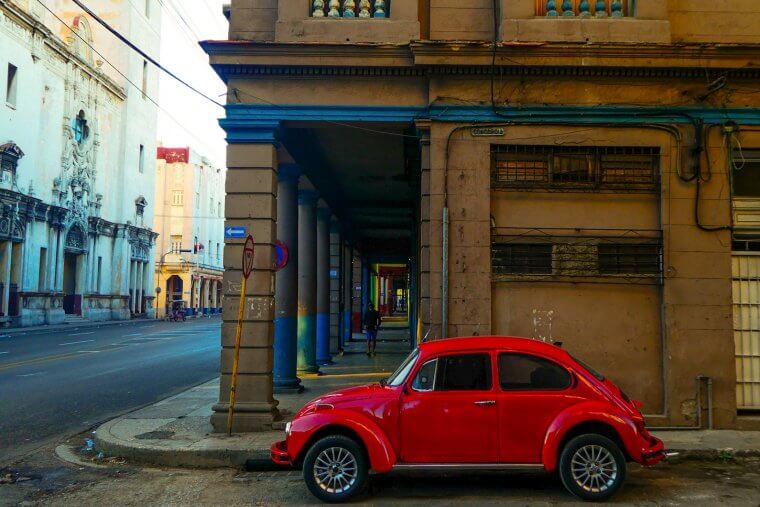
21. Brush up on your Spanish before you go
Very few Cubans speak more than basic English, if at all, and Spanish is a relatively straightforward language, so start practising your Spanish or bring a little Spanish dictionary – it’ll certainly make life easier! Learning Spanish is one of our top tips for travelling in Cuba that can also come in handy all over the world, as Spanish is an official language in 21 countries!
One of our favourite apps for learning languages on the go is Duolingo. Check out other useful travel apps here!
What are your top tips for travelling in Cuba?
Have you been to Cuba before ? Any Cuba travel tips you’d add?

Hi, my name is Natty! As a third culture kid – raised by parents of French, American, Chinese and South African descent, trapsing the world and acting as a global citizen has always felt natural to me. Despite being only 21 years old, and not yet finished with my Economics degree at the University of Manchester, I have managed to make travelling happen whenever and wherever possible.
Did you find this post helpful? I’d love you to share it for me.
Pin and save this blog post for later…
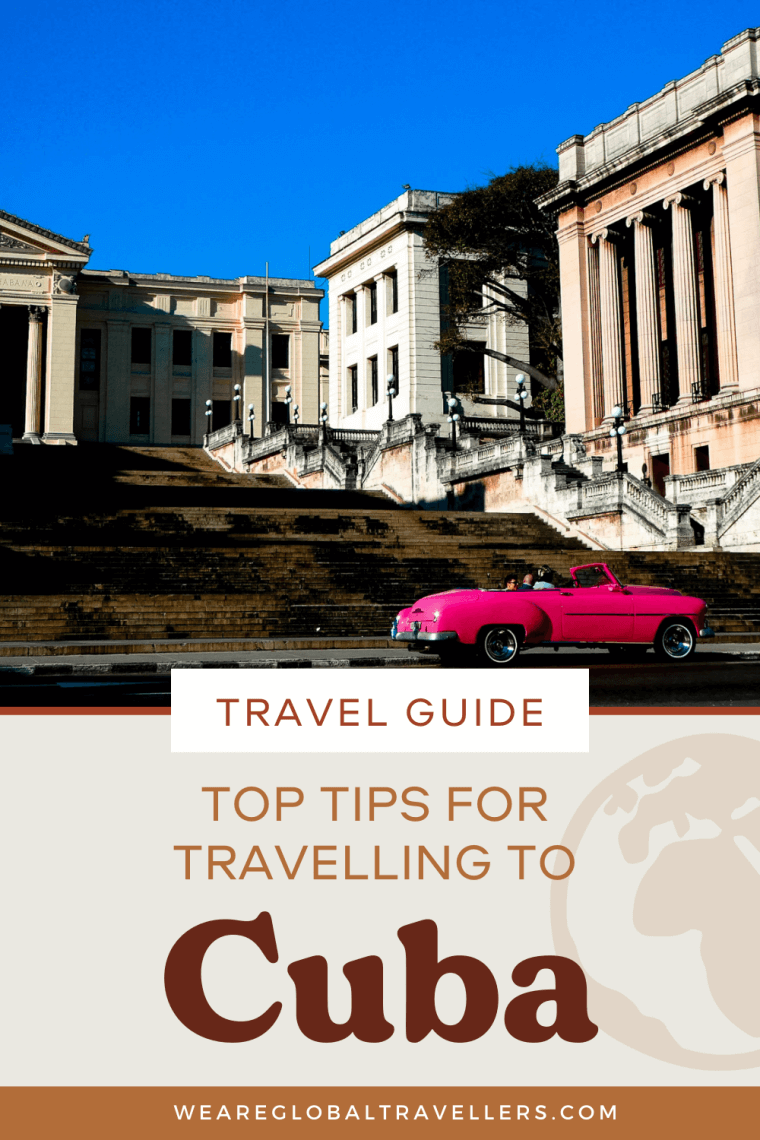
IT’S LOVELY TO MEET YOU
I’M MOLLIE AND I STARTED THIS BLOG BACK IN 2013 WHEN I HEADED OUT ON MY FIRST BACKPACKING ADVENTURE.
I’D LOVE TO SHARE THE JOURNEY WITH YOU, WE’VE GROWN A LOT SINCE THEN!
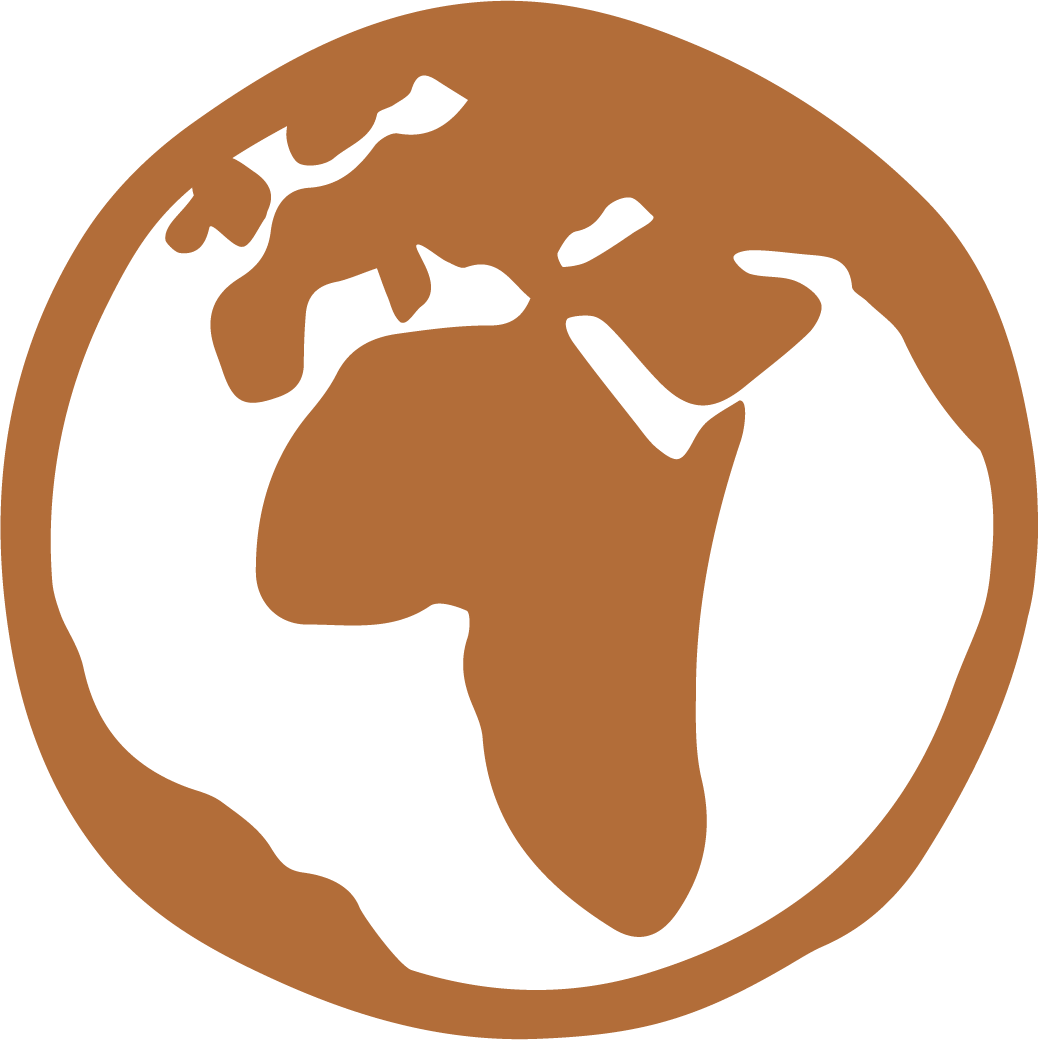
Shop the google map legends
Search by adventure type, active travel, backpacking, budget travel, love and relationships, once in a lifetime, packing tips, solo travel, weekend getaways, where's mollie newsletter, travel shop, search by destination, other posts that you may like....
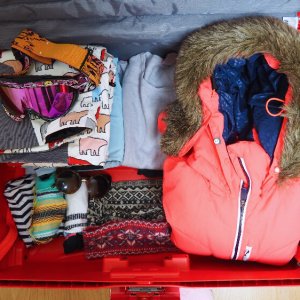
What to pack for a ski trip
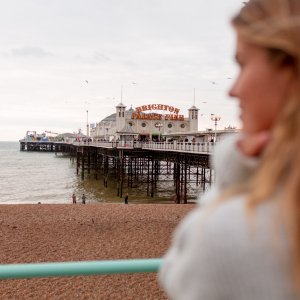
A weekend guide to Brighton, England

Glacier adventures: Columbia Icefields & Banff National Park
A 3-day itinerary for leeds, uk.
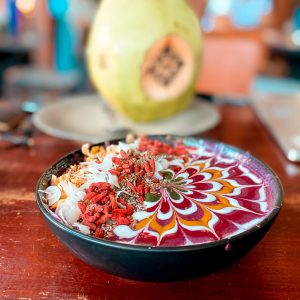
The best brunch and coffee spots in Canggu, Bali
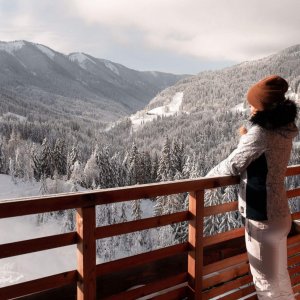
A winter weekend at Forsthofalm Hotel and Spa, Austria
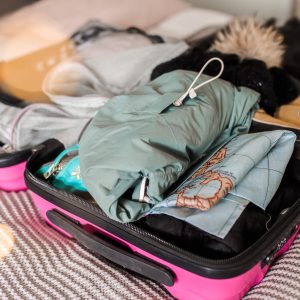
How to pack a weekend city break into a carry on suitcase
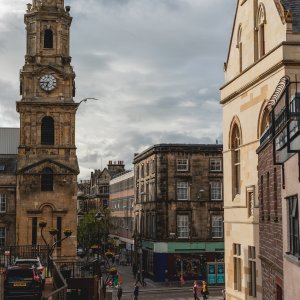
The best things to do in Inverness, Scotland
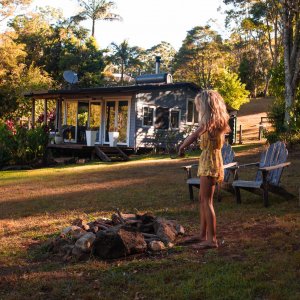
Our 3 day DIY retreat in the Hinterland of Byron Bay
Privacy overview.

- What’s In My Travel Bag?
- Travel Tips
- Destinations
- Travel Guides
- Virtual Consult
5 Days in Cuba: Your Complete Travel Itinerary
- March 20, 2024
Disclosure: This post may contain affiliate links, which means we’ll receive a commission if you purchase through our links, at no extra cost to you. Please read full disclosure for more information.
Have you been considering a trip to Cuba? I have you covered with the best way to spend 5 days in Cuba.
Cuba, the largest island in the Caribbean, sits just 90 miles from the United States.
Positioned between the Bahamas and Jamaica, it’s not your typical Caribbean escape - it’s a deep dive into a unique culture.
Get ready to step outside of your comfort zone to truly experience the heart and soul of this island, where every corner tells a story and every moment is a chance to learn and connect.
Tourism plays a significant role in Cuba’s economy, turning your visit into a means of supporting local communities.
The Cuban people, known for their kindness and resilience, welcome you to explore the diverse landscapes, from lively cities to tranquil beaches and picturesque valleys.
And while we’ll certainly dive into the classic Cuban cigars, mojitos, and daiquiris, this article will uncover a wealth of experiences beyond the iconic favorites.
I traveled to Cuba last November, tracing the history of Havana, wandering through the vibrant streets of Trinidad, and discovering the natural wonders of Vinales.
With this firsthand experience, I’m sharing practical tips and insights for those planning a 5 day trip to Cuba.
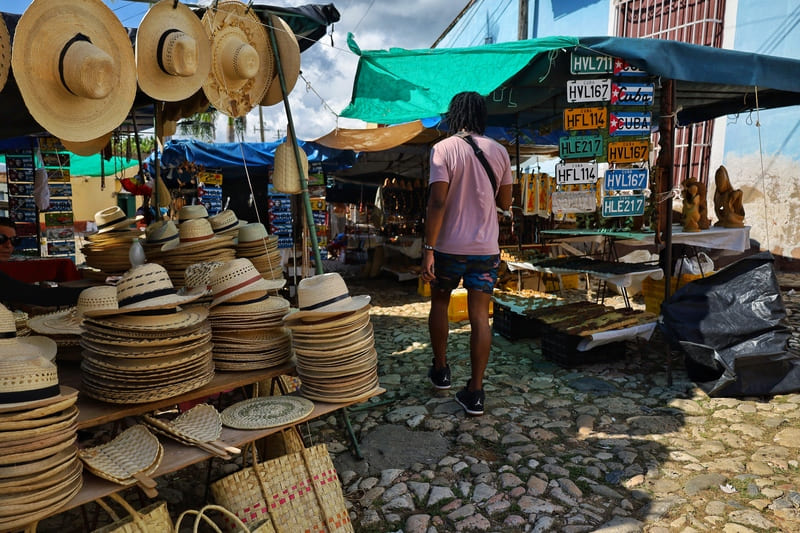
If you’re looking for genuine recommendations and guidance to maximize your trip, I’m here to help you navigate this culturally rich destination.
Keep reading to see exactly how you can travel through Cuba in 5 days!
Planning Your Next Trip?
🤩 Discover all the must-know tips before visiting Cuba > Explore Cuba Travel Guide
🤩Find cheap flights and get cashback > WayAway
🤩 Book affordable hostels > HostelWorld
🤩 Get the best carry-on bag > GOT Bag
🤩 Pack lighter with this > Cosy Collection Neck and Bag pillow
🤩 Explore ways to maximize hotel points > Awayz
🤩 Easily learn the local language > Babbel
🤩 Protect your online security abroad > ExpressVPN
🤩 Get the best travel shoe & travel jacket > TropicFeel
Table of Contents
How Do You Get to Cuba from the US?
Getting to Cuba from the United States as an American is a bit different than other Caribbean destinations - it’s the only one that asks for a visa.
If you’re an American, you’ll need a Cuban tourist card, and you can get one at the airport or conveniently order it online in advance through Easy Tourist Card .
Remember, if you’re a U.S. citizen, they won’t let you board your flight to Cuba without this card.
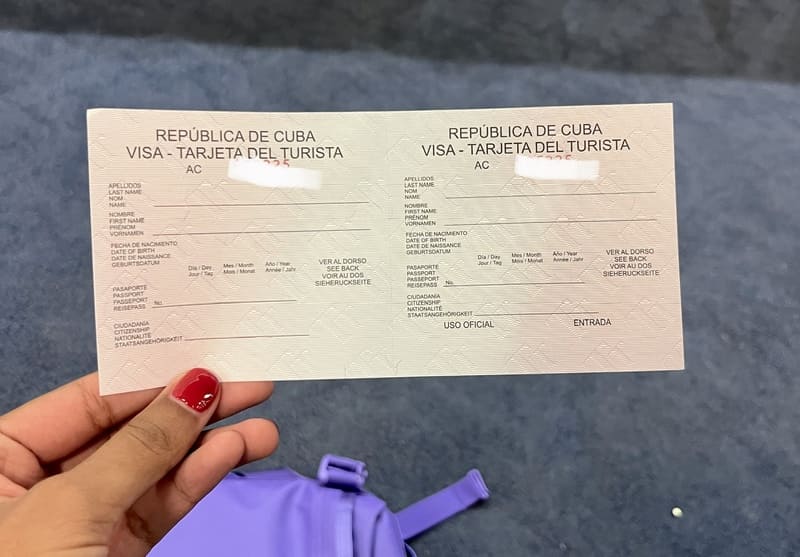
Major U.S. airlines offer flights to Cuban cities. We opted for American Airlines and flew into Havana.
Keep in mind that health insurance coverage in the area is a must for anyone heading to Cuba.
American Airlines included the necessary health insurance as part of our ticket costs.
Be sure to double-check the fare, taxes, and fees section when purchasing your flight for health insurance details.
If you are uncertain about whether insurance is included, contact the airline directly for clarification and guidance on the next steps.
We also had to complete the required health screening form in advance of our flight, as well.
You may also need to show this health form upon landing in Cuba.
It’s a good idea to bring screenshots of all your important documentation since you may not have phone service as soon as you arrive in Cuba.
For a detailed, step-by-step guide on entering Cuba as an American and handling all the necessary steps, check out our comprehensive article that covers all the details.
RELATED ARTICLE: Ultimate Weekend in El Salvador Itinerary
DAY 1: A Day in Havana
In this itinerary, I’ll take you through our experiences in Cuba and provide insights into what you can explore and enjoy during your trip.
Arrival in Havana
Arriving in Havana marks the beginning of your Cuban adventure.
As your plane touches down at José Martí International Airport , the first step is navigating through Cuban customs.

While still at the airport, you should exchange a portion of your currency for Cuban pesos.
This initial exchange will be useful to purchase a Wifi card, which is important to have if you plan to stay connected during your travels.
Upon landing in Cuba, phone service and Wifi will not be readily available.
The Wifi card can be bought with cash at the airport.

In order to use your Wifi card, you have to find a designated Wifi area.
If this sounds any bit confusing, we give you the full rundown on exactly where to get a Wifi card and how to use the Wifi card inside our “ Explore Cuba Travel Guide .”
Given restrictions on car rentals for Americans in Cuba, we found shared taxis, known as colectivos, to be the most convenient mode of transportation.

In our guide , we provide our trusted colectivo driver recommendations and bus options to facilitate seamless transportation from the airport to your accommodation and beyond.
RELATED ARTICLE: Is Spirit Safe to Fly?
Havana Casa Particular
Once you leave the airport, you’ll be checking into your “casa particular.”
This accommodation involves staying in the private homes of local Cubans.
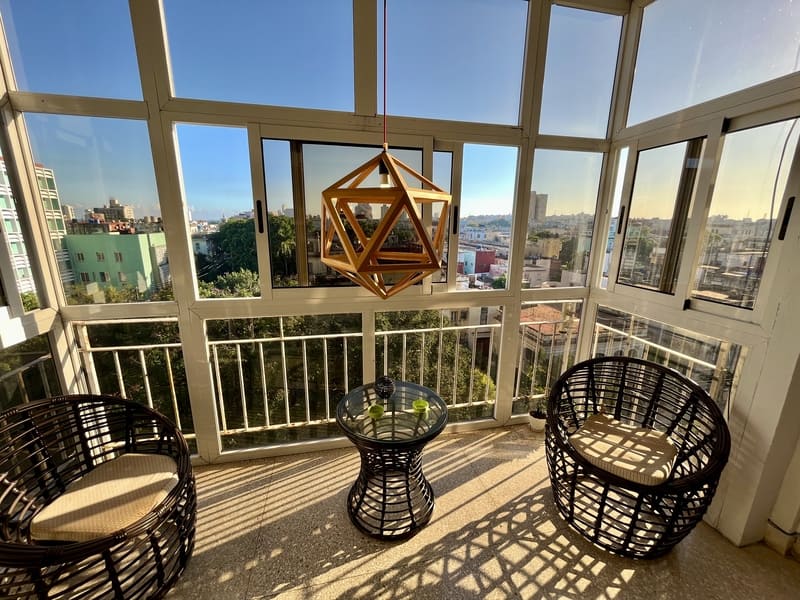
Whether you choose a separate rental or a shared space in their home, staying in a “casa particular” is a requirement for American visitors under the “Support for the Cuban People” visa category.
When you meet your casa particular host, you should ask about currency exchange, as they might offer you a more favorable rate.

However, be aware that, during our visit, many places preferred USD over the local currency, and in some instances, they didn’t accept their own currency.
For this reason, it’s not advisable to exchange a large amount of your cash, and it’s a good idea to discuss the preferred currency with your host beforehand.
Keep in mind, that American credit cards and debit cards do not work in Cuba, so cash will be king.
Now that you’ve gotten a chance to settle into your casa particular, get ready to experience the authenticity of Havana, the largest city in Cuba.
Havana welcomes you with classic cars, weathered buildings, lively streets, and a unique blend of history and culture.

RELATED ARTICLE: Step-By-Step on How to Get to Machu Picchu Without Hiking
Revolution Square (Plaza de la Revolucion)
As you explore Revolution Square, you’re bound to see the Ministry of the Interior building and Communications building, characterized by massive steel murals of revolutionary leaders (ie. Che Guevara) on their facades.
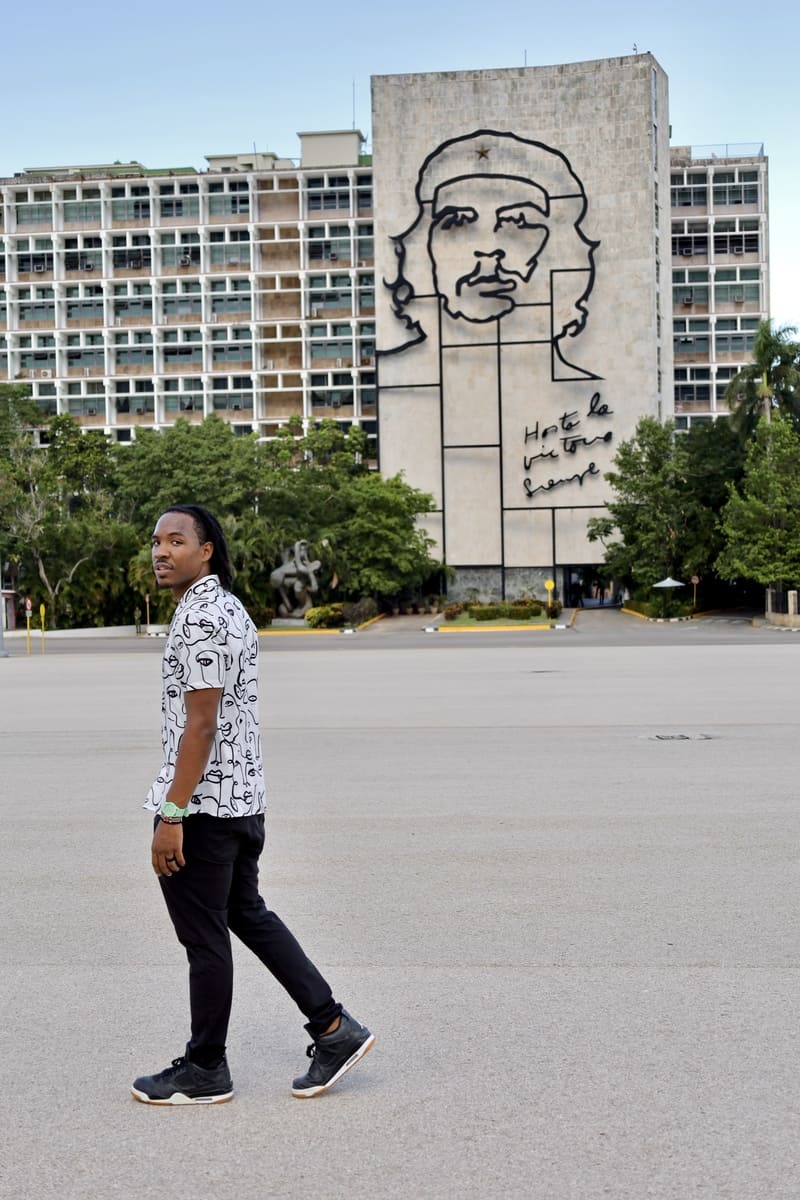
These iconic structures not only contribute to the square’s historic and political ambiance but also serve as powerful symbols of Cuba’s revolutionary spirit.
As you walk through the streets surrounding Revolution Square, you’ll likely come across charming local restaurants, offering a small taste of Cuban cuisine.
It’s essential to manage your expectations, as some restaurants may not have every item listed on their menus.
Everything is rationed in Cuba, so be mindful of that.
Engage with the friendly staff and ask about available food items so you can be sure of your meal options.
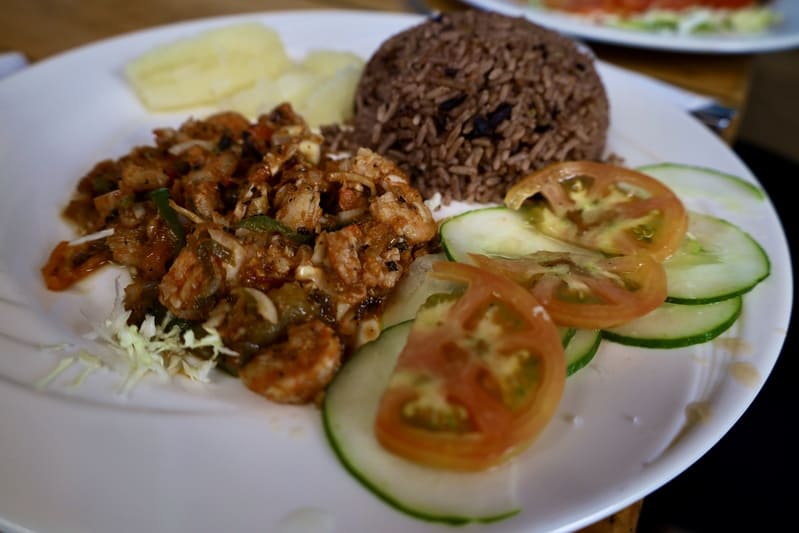
Cuban restaurants operate within the constraints of limited resources, and understanding the concept of rationing is crucial for you to gain insight into the daily realities of life on this historic island.
RELATED ARTICLE: Where to Find Authentic Aruban Food
El Cristo de la Habana
Head to the Christ of Havana (el Cristo de la Habana) for a breathtaking sunset experience.
This big statue of Jesus looks over Old Havana (Havana Vieja) and the water, creating a stunning view.

When I went, there were lots of people singing and dancing.
If you walk down a bit from the hill, there's a truck selling coco frio (cold coconut water in a coconut) which is a refreshing treat.

Continue walking towards the water, and you’ll spot a ferry, the most budget-friendly way to return to Old Havana.
But, if figuring out a ferry isn't your thing, or you'd rather not take a boat, you can also arrange a ride with a colectivo driver beforehand.
RELATED ARTICLE: Is Turks and Caicos Expensive?
Plaza Vieja
As you walk through Plaza Vieja in Old Havana (Habana Vieja), you can’t help but notice all the many restaurant options in this area for dinner.

For more food guidance, we have included over 30 restaurant recommendations in our “ Explore Cuba Travel Guide ” so you can find the perfect spot that suits your tastes.
After dinner, treat yourself to some delicious gelato from Pistacchio Havana.
Continue down to Avenida del Puerto for the final activity of the night.
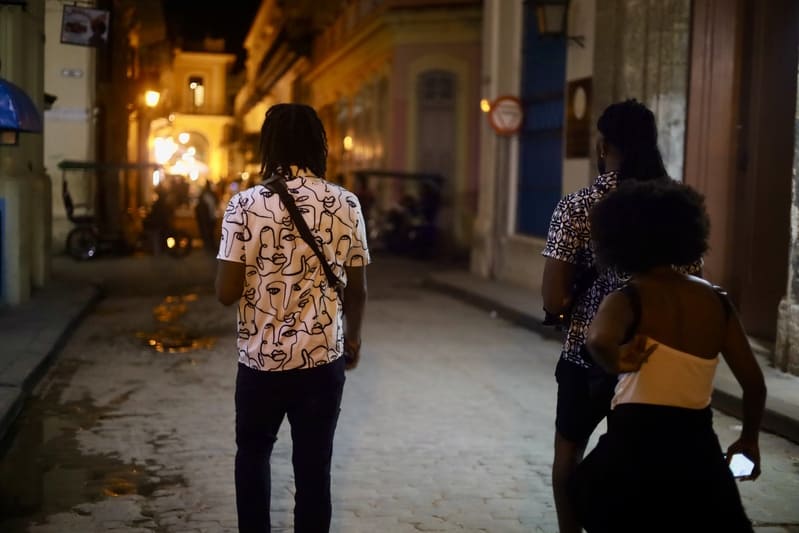
RELATED ARTICLE: How to Visit La Fortuna on a Budget
Havana Cannon Fire
Every night at 9 pm there is a cannon that fires off at Fortaleza de San Carlos de la Cabana (Fort of San Carlos of the Cabin) which is near el Cristo de la Habana.
You can get a view of this happening from across the water near the Malecon. It happens at 9 pm sharp.
Arrange your transportation ahead of time or head back towards the main plaza to get a colectivo back to your casa particular for the night.
DAY 2: Vinales Day Trip from Havana
Navigating Cuba as a tourist can be challenging, but experiencing the country from the perspective of a local adds a whole new dimension.
We had an exceptional day trip from Havana to Vinales with Alizandra who is a Cuban native with excellent English speaking skills.
She doesn’t hold back on lesser-known facts about life in Cuba, and she provides you with a better understanding of the Cuban way of life.
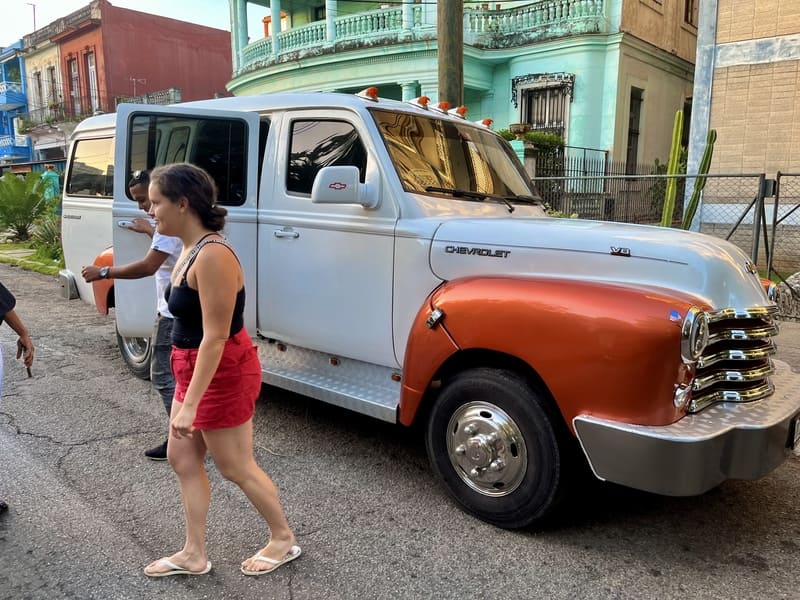
Alizandra not only coordinated our entire trip from Havana to Vinales, including transportation, entrance fees, and food recommendations, but she also became more than just a tour guide - a genuine friend.
Vinales is a UNESCO World Heritage Site and a must-visit during your 5 day trip to Cuba.
RELATED ARTICLE: 4 days in Puerto Rico: Lajas, Guanica, & Cabo Rojo
Cueva del Indio (Indio Cave)
Our day trip with Alizandra kicked off with a visit to the captivating Cueva del Indio after we stopped for breakfast.
Picture an amazing boat ride winding through ancient caves adorned with prehistoric drawings.
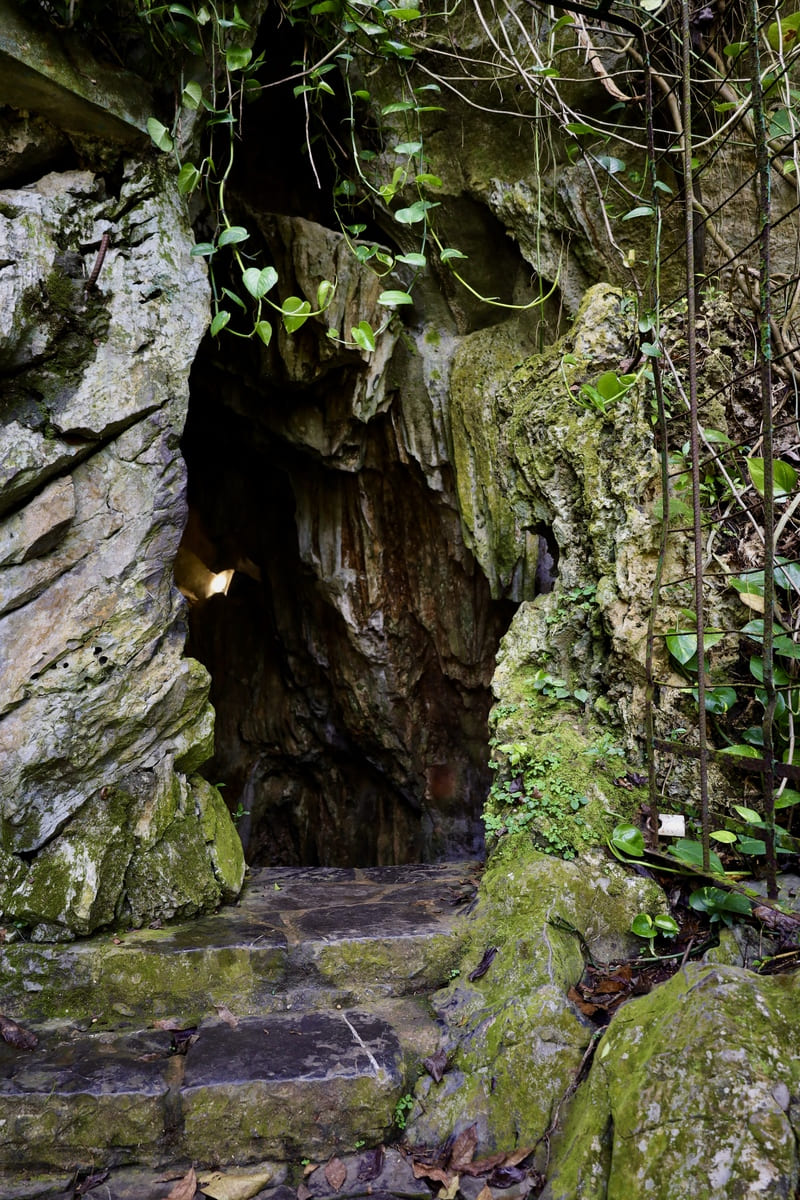
The boat guide flashes his light to make sure you don’t miss a single detail of those fascinating drawings on the cave walls.
It’s like stepping back in time as you cruise down the San Vicente River before heading toward the end of the cave and emerging from this incredible underground adventure.
Once you get off the boat, tables are set up with all sorts of souvenirs to check out. Don’t miss the chance to grab a refreshing cup of sugar cane juice before you head out, too.

RELATED ARTICLE: Top Travel Mistakes to Avoid
Vinales Tobacco Farm
Now it’s time to explore the heart of Vinales with a visit to a local tobacco farm - a must during your 5 days in Cuba.
Get ready for a unique horse riding tour through the farm, soaking in the beautiful views.
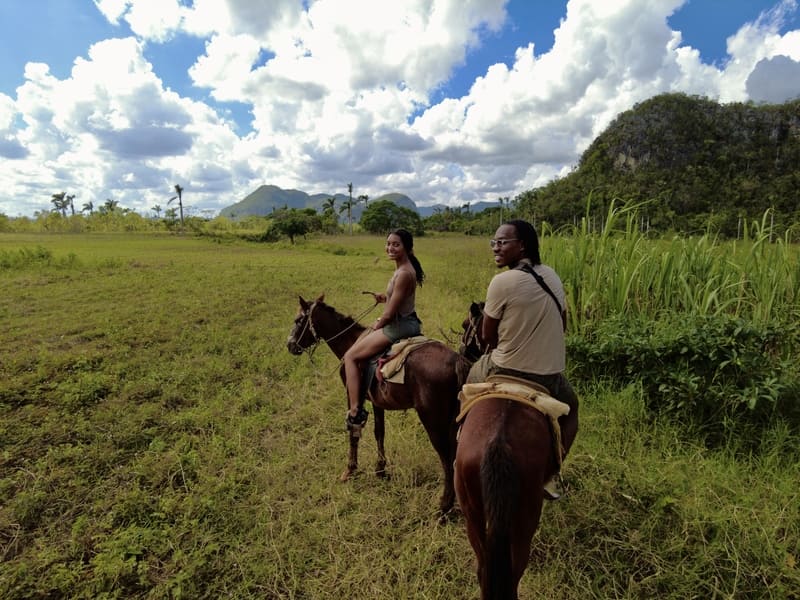
Whether or not you’re into horseback riding, you’ll learn all about how they grow tobacco and other crops at the farm.
The best part? You’ll learn the art of rolling Cuban cigars and picking up the tricks from the experts.
You’ll also hear all about the farm’s history and the stories behind these special tobacco leaves.
There is also an opportunity to purchase Cuban cigars directly from the locals here.
Just keep in mind that there are limitations to what you can bring back to the United States .

RELATED ARTICLE: Best Things to Do in Lajas Puerto Rico
Mural de la Prehistoria
El Mural de la Prehistoria (prehistory mural) is exactly as it sounds.
It is a massive mural depicting prehistoric times.
It was painted in 1960 on a towering mogote that reaches 160 meters and is a significant attraction in Vinales.
This vibrant mural illustrates dinosaurs co-existing with humans, and it is an awesome sight to see.
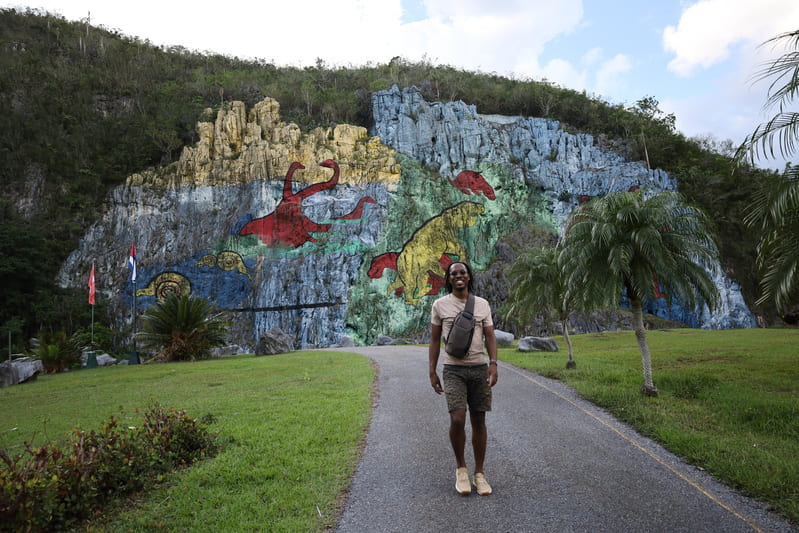
After taking pictures here, we went on to lunch at El Sabor Kirenia nearby and had an excellent family-style meal before heading back to Havana.
The journey back to Havana was filled with engaging and highly informative conversations with Alizandra.
Night in Havana
After a full day of exploring Vinales with Alizandra, you can grab a quick dinner in Old Havana before heading to your casa particular to rest up for tomorrow’s early adventure.
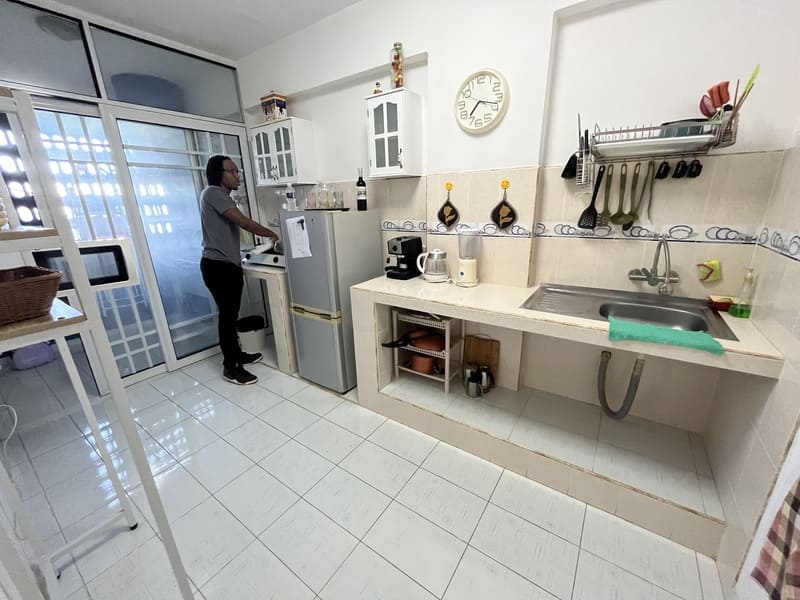
RELATED ARTICLE: Panama Trip Planning Tips
DAY 3: Havana to Trinidad Cuba
If you’re seeking a standout destination in Cuba, look no further than Trinidad.
It is one of the oldest cities in Cuba, and our personal favorite.
This Spanish colonial gem has charming cobblestone streets, picturesque beaches, vibrant buildings, and tucked-away waterfalls.
Recognized as a World Heritage Site since 1988, Trinidad’s historical significance in the sugar trade adds to its allure and makes it a destination rich in both beauty and heritage.
How to Get to Trinidad from Havana
Start your day early for the journey to Trinidad from Havana.
We had it all sorted with a colectivo arranged to take us.
We set out in the morning and smoothly reached Trinidad five and a half hours later in the afternoon.
While the ride might sound like a lot , it turned out to be the best opportunity to bond with our group.
We went to Cuba with @ whereisbree , @ barringtonodyssey , @ flyingphirstklass , and @ trini_dondada .

Even though we were already acquainted as creators from Instagram, our first in-person meeting was on this trip!
The extended journey from Havana to Trinidad turned out to be the perfect setting for authentic friendships to grow.
Chew Tip: Group travel not only fosters friendships but also allows for cost-sharing—an added perk to enhance your experience. #SeeTheWorldSaveADollar
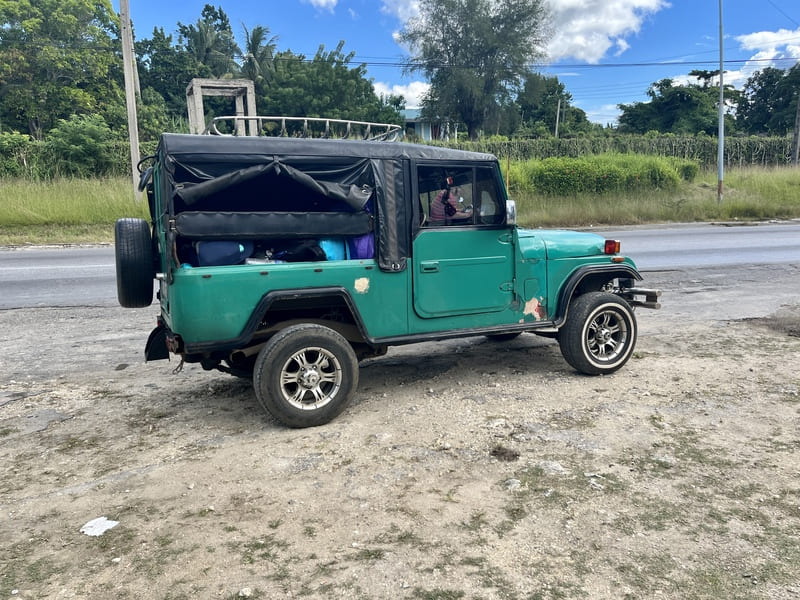
For those planning their own venture from Havana to Trinidad, our “ Explore Cuba Travel Guide" offers essential insights into bus costs, routes, and schedules, providing practical information for a seamless road trip.
The guide also features contact information for our personal drivers, ensuring you have the necessary tools for a memorable and well-organized adventure.
Trinidad Casa Particular
In Trinidad, you can find comfortable and spacious choices for casa particulares.
Our 3-bedroom stay even served breakfast in the morning.
Once you check in, drop off your things, and freshen up a bit, it’s time to step out, grab a bite to eat, and explore the surroundings.
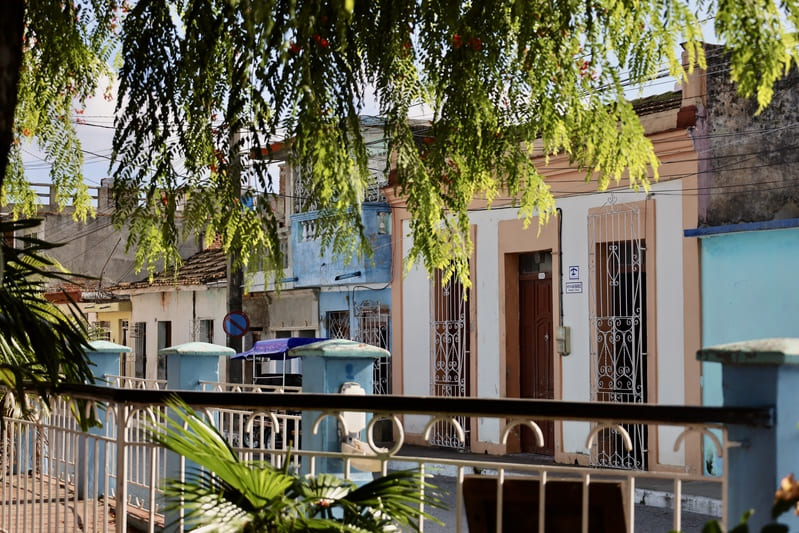
Playa Ancon
Playa Ancon, or Ancon Beach, stands out as one of the most beautiful beaches in Trinidad, Cuba.

When it comes to getting to Playa Ancon, mastering a bit of Spanish can be a game-changer, especially when negotiating a colectivo.
Having a grasp of the language not only adds to the richness of your Cuban experience but also opens doors to more affordable transportation options.
Colectivos are a popular means of travel in Cuba, and being able to communicate in Spanish puts you in a favorable position during negotiations.

Locals appreciate the effort to speak their language, and it often leads to a friendlier exchange.
By investing in learning some key Spanish phrases , you not only enhance your travel experience but also empower yourself to navigate the local transportation system more efficiently.
Once you arrive at Ancon Beach, enjoy the calming waves and unwind on this beautiful beach.
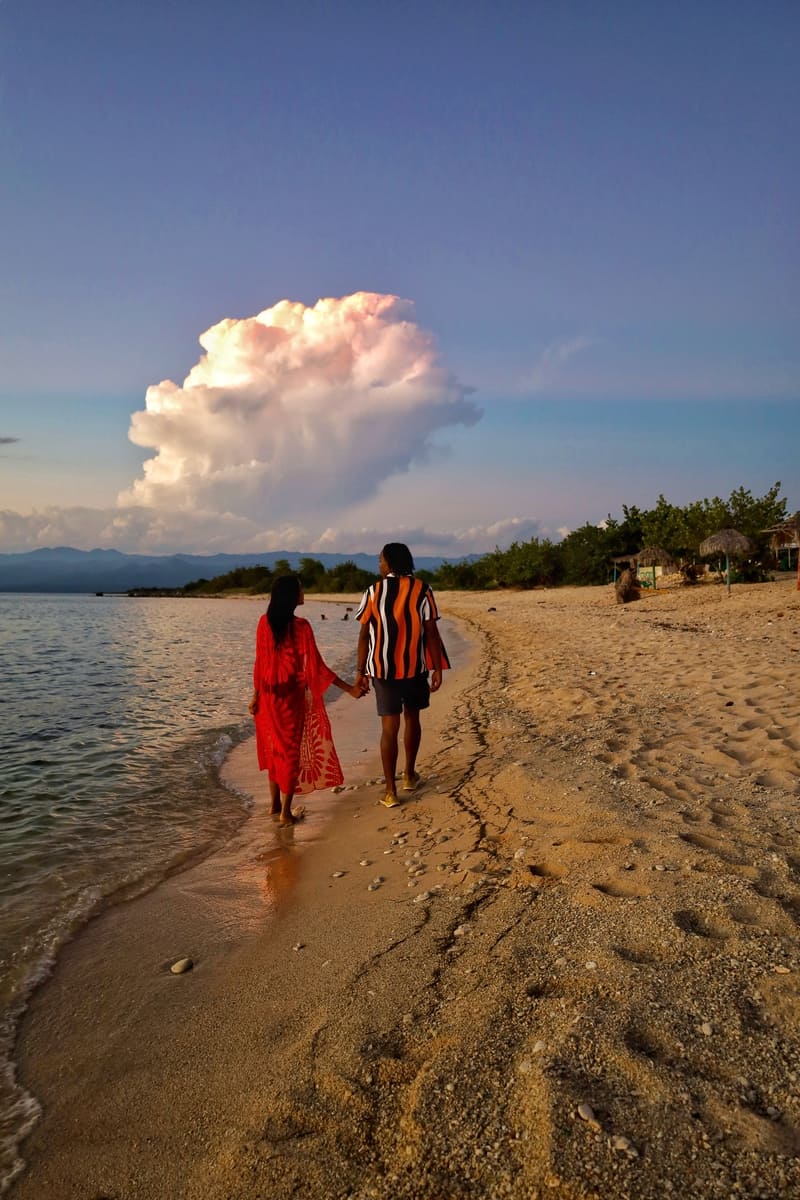
Catch the sunset, and take it easy before heading out for dinner in Trinidad.
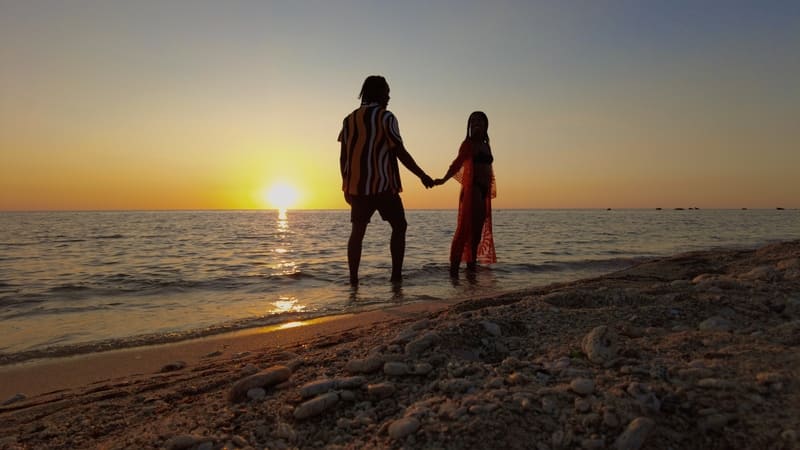
Trinidad Cuba Nightlife
As the sun sets, the night is barely just beginning in Trinidad. Get yourself to Casa de la Musica for a round of salsa dancing to live music.
And yes, you should definitely jump in!
Afterward, make your way to Disco Ayala, a cool nightclub tucked inside a cave.
It’s a one-of-a-kind experience with a mix of energetic locals and fellow travelers.
Enjoy the moment before heading back to your casa particular for a cozy night’s rest.
DAY 4: Trinidad, Cuba
We started our morning with a delicious breakfast at our casa particular in Trinidad.
You’ll want to eat well because you’re in for an adventure today.
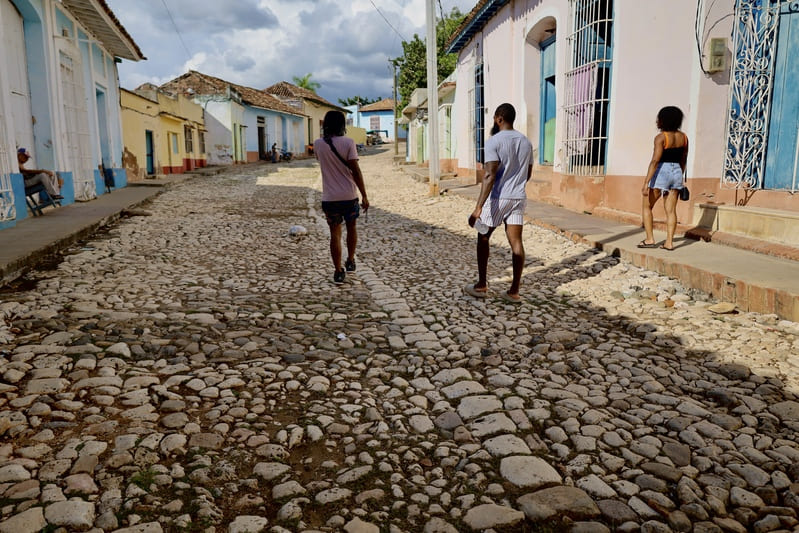
Javira Waterfall
Hop in a colectivo to El Cubano Natural Park - the starting point for your hike to Javira Point Waterfall.
The trail is pretty straightforward but includes a river crossing.
But here is where it gets interesting with money. We had exchanged a lot of USD for Cuban pesos, ready to pay at the park entrance.
Surprisingly, they wouldn’t accept their own currency. With American credit cards not working in Cuba, we faced a dilemma.
Luckily, a European tour group arrived at the same time, and they kindly used their credit cards for our entrance fee, and we reimbursed them in Cuban pesos.
Quick tip: if you’re American, bring USD to Javira Waterfall.
The waterfall is incredible and worth the easy 1.5-mile (2.5 km) hike.
RELATED ARTICLE: Ultimate Guide to Pulhapanzak Waterfall

The water is refreshingly cold for a swim, and there’s a cool spot at the top of the hill to jump into the water.
While my husband and friends explored deep into the cave, I preferred recording the adventure since cliff-jumping wasn’t my thing.
They provide life jackets on-site which is great because the water gets deeper near the waterfall.
I can swim, but it’s always nice to chill with a life jacket.
The 45-minute walk back dries you off quickly, thanks to the hot Trinidad weather.
After the waterfall experience, arrange for your colectivo driver to take you to a nearby spot for some food.
RELATED ARTICLE: Everything to Know About San Ramon Waterfall
Playa Maria Aguilar
Discover another beautiful beach to unwind and soak in the peaceful views at Maria Aguilar Beach (Playa Maria Aguilar).
There’s a bar where you can grab some drinks here, as well.

RELATED ARTICLE: Ultimate Things to Do in Paracas
Plaza Mayor
Post-beach relaxation, we went back to our casa particular to freshen up, then made our way to the heart of Trinidad - Plaza Mayor.
Our quest for a delicious dinner led us to the rooftop restaurant, Bistro Trinidad where we had traditional daiquiris and mojitos.
Afterward, we swung by La Canchanchara to try out another traditional drink - la canchanchara which is a combination of rum, lime, and honey.
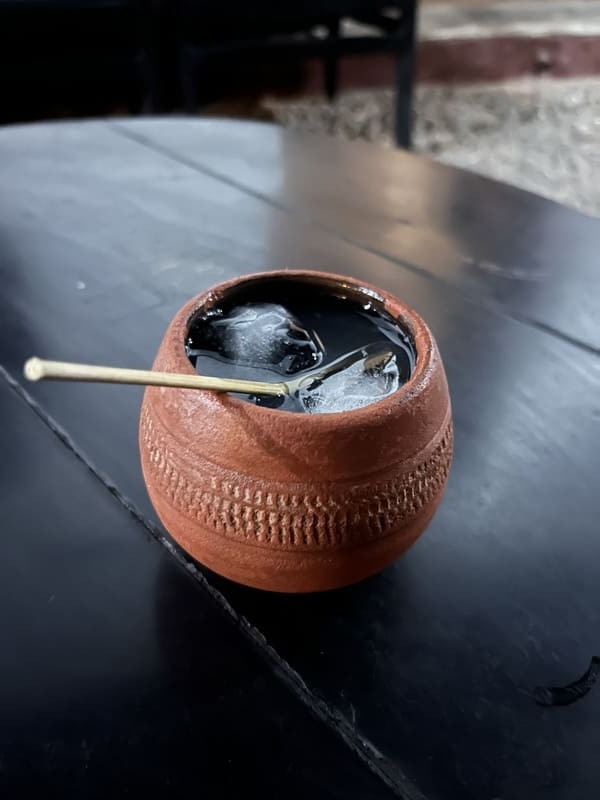
We strolled through the charming streets around Plaza Mayor before wrapping up the night at our casa particular.
RELATED ARTICLE: Free Things to Do in Peru
DAY 5: Trinidad to Havana
This morning marked our last breakfast at the Trinidad casa particular, and we couldn’t resist grabbing some delicious fish sandwiches from the stand around the corner for the road.
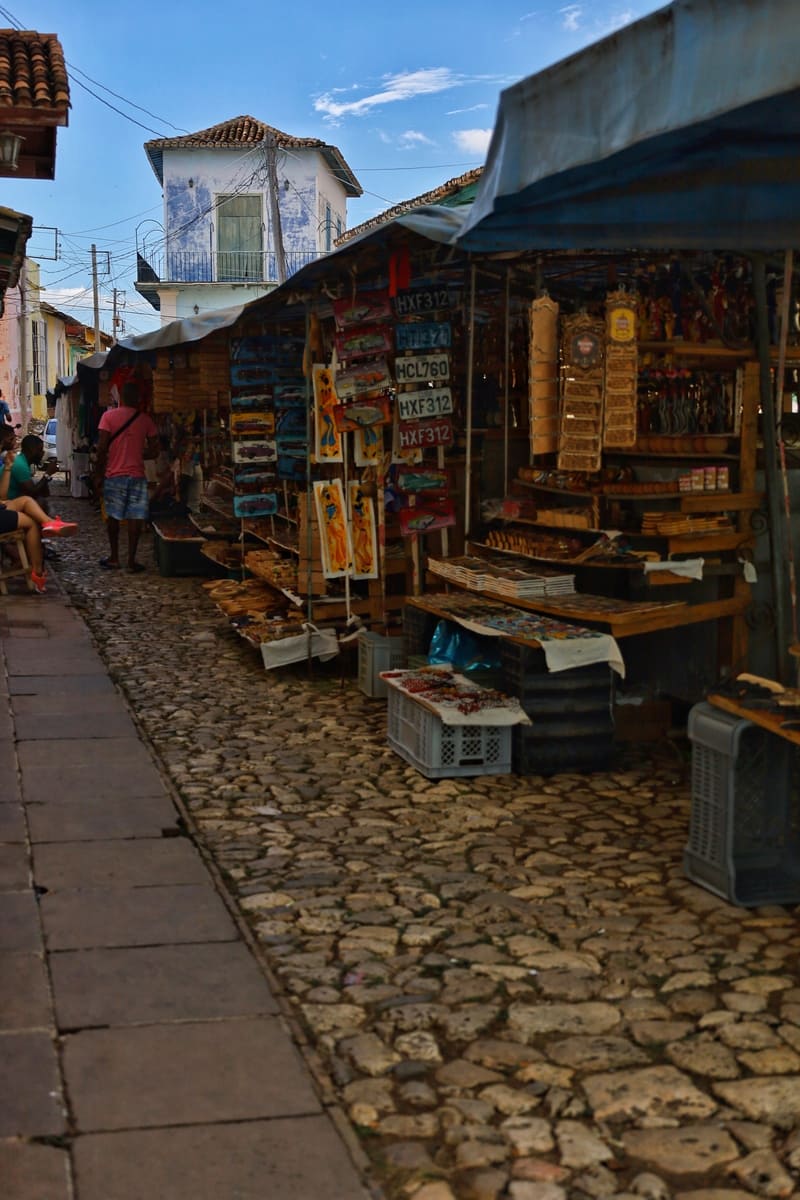
With an early start, we headed on another 5.5-hour road trip back to Havana from Trinidad – granting us plenty of time for more close bonding along the way.
We walked around the National Capitol, resembling the US Capitol building.
Lunch led us to El Dandy, a quaint spot. Just be sure to check what’s available before diving into the menu.
Just up from El Dandy, we stumbled upon a basketball court.
My husband took it back to his college basketball days and joined in a game with the locals.
Across from the court was Pistacchio Havana Gelato, so another round of gelato was a must before a leisurely walk to Callejon de Hamel.
This street features a narrow alley in Havana adorned with vibrant murals and sculptures crafted from bathtubs, hand pumps, and pinwheels.
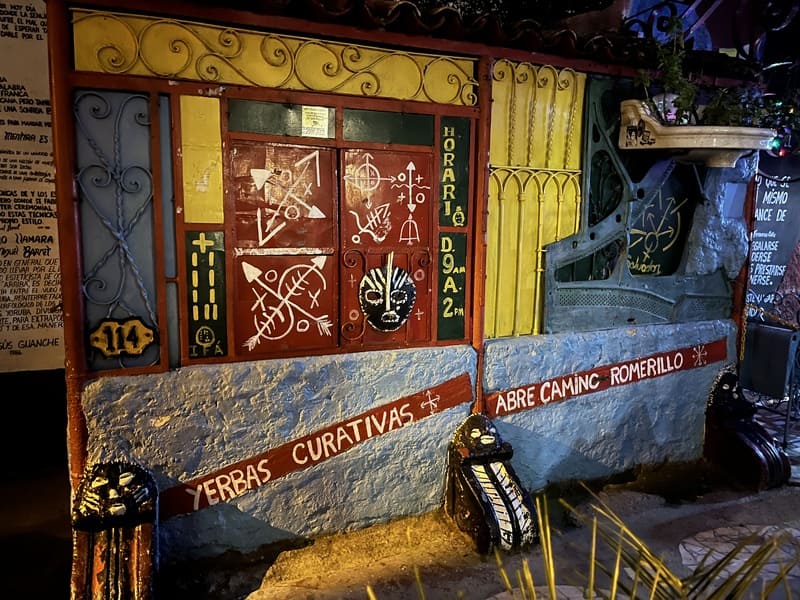
It provides a glimpse into the local art scene of Cuba’s capital.
It’s incredible to see renowned Cuban artist Salvador Gonzalez Escalona’s abstract Afro-Cuban artistic style.
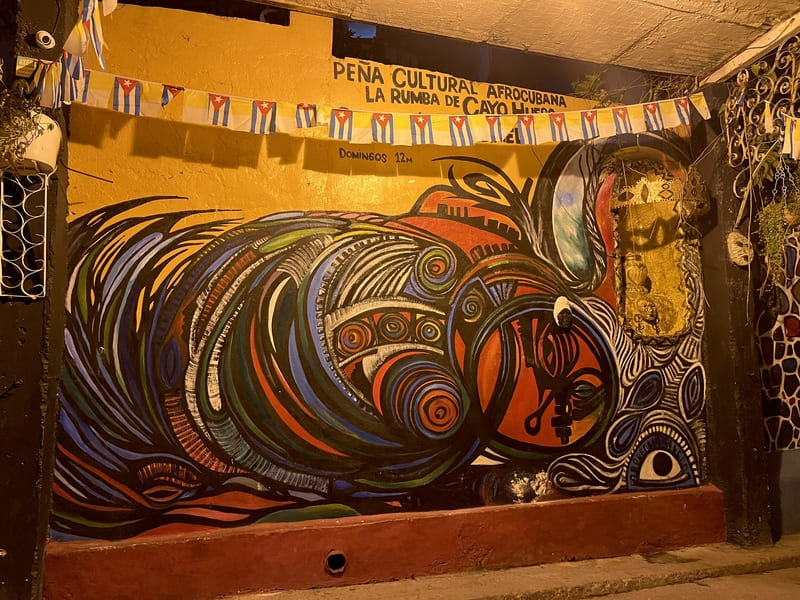
Afterward, we made our way back to our Havana casa particular to make sure we were fully packed and ready for a very early morning departure to the airport.
RELATED ARTICLE: What to Do in Huacachina
Tips for 5 Days in Cuba
- Entry - Make sure you have a valid passport, complete the required health screening forms, and apply for your tourist visa in advance or at the airport before you board your flight.
- Documents - Keep screenshots of important documents including health forms, and the address of your casa particular.
- Internet Access - Purchase a Wifi card for internet access in designated areas. Be prepared for a more unplugged experience in Cuba since you may not always be in a Wifi zone. Be sure to download offline Google Maps before getting to Cuba so you can more easily navigate the country.
- VPN - Many websites (including Airbnb ) are blocked in Cuba. If you use a VPN you can gain access to different restricted websites and apps. Just be sure to download the VPN prior to getting to Cuba, and the VPN works as long as you are connected to Wifi.
- Transportation - Colectivos (shared taxis) and Viazul buses are popular modes of transportation. Confirm the price of your colectivo with the driver before getting into one. Plan your routes and book in advance, especially for longer journeys. Check our “Explore Cuba Travel Guide ” for colectivo drivers and info on the bus systems. Keep in mind that Americans can't rent cars in Cuba.
- Accommodation - Book your casa particular in advance for an authentic Cuban experience. If you're an American traveling to Cuba on a support for the Cuban people visa, technically you are required to stay in a casa particular. We have over 30 recommended casa particulares included in our “Explore Cuba Travel Guide .”
- Food - Set realistic expectations for food. While you can find good places to eat, keep in mind that the availability of options may be limited due to food rations in Cuba. It's a good idea to ask the available choices before getting too excited about the menu.
- Currency - Be aware that American credit cards and American bank cards are never accepted. While Cuban pesos are the local currency, there's a preference for euros for USD. It's advisable to bring sufficient cash for your entire trip since accessing ATMs will not be an option for withdrawals if you are American.
- Medication - Leveraging my experience as a pharmacist, I'd highly recommend packing enough of your prescribed medications and any over-the-counter (OTC) meds you might need. Keep them in their original containers, and bring enough to account for any travel delays. This way, you'll be well-prepared for any unexpected situations, especially considering the limited availability of medications in Cuba.
- Cultural Respect - Embrace the rich cultural diversity in Cuba, which is likely different than what you are used to. Instead of passing judgment, take the time to understand and appreciate local ways of life. Keep an open mindset and always show respect as you explore.
RELATED ARTICLE: What Not to Miss in Peru
5 Days in Cuba FAQs
Yes, you can go to Cuba for 5 days, especially if you want to explore one city. Be sure you have the required visa or tourist card.
The ideal duration for a Cuba trip depends on your preference. Many find 6-10 days sufficient for a well-rounded experience.
Budgets vary, but bringing $100 USD per day is a reasonable estimate for accommodation, meals, and activities.
Cuba is safe for tourists, with a low crime rate and strict regulations on weapons and drugs. We felt secure throughout our 6-day trip.
Explore Cuba Travel Guide
We have carefully curated a wealth of itinerary ideas tailored to major destinations throughout Havana, Trinidad, Vinales and Varadero in our comprehensive 31-page “ Explore Cuba Travel Guide .”
Dive into over 80 insightful suggestions covering everything from must-visit attractions to hidden gems.
What sets our guide apart is its thoughtful organization by budget, empowering you to make the most of your journey while keeping your wallet happy.
See the World and Save a Dollar with the valuable insights and practical tips found in our “ Explore Cuba Travel Guide. ”
Your Cuban experience is about to get even more extraordinary!
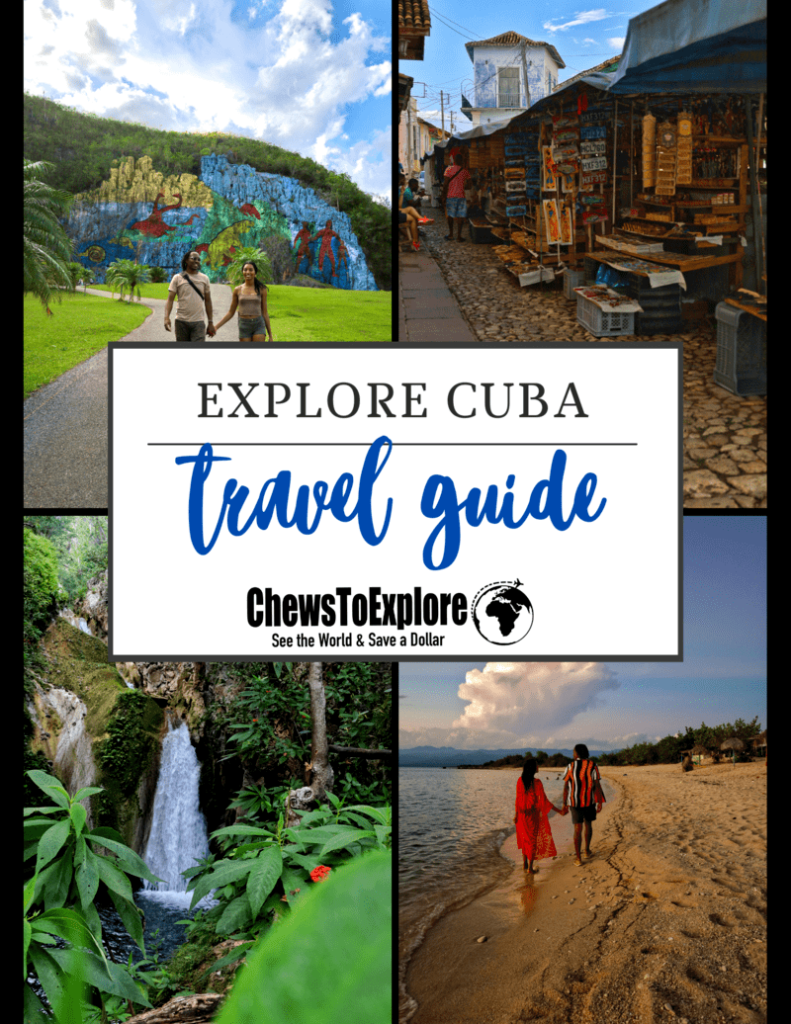
Are you considering traveling to Cuba, but unsure of where to start planning?
This 38-page digital guide breaks down every detail you need to know before exploring Cuba, even as an American.
Info on Havana, Trinidad, Viñales and Varadero are all included.
This one-of-a-kind travel guide is filled with first-hand experience and insider tips that will save you time planning your dream trip!
What's inside:
- How to get a visa
- What to pack
- How to access Wifi
- Private taxi driver numbers
- Over 20 unique things to do (many are FREE!)
- Over 30 top-rated places to eat
- Over 30 casa particular recommendations
- Sample 5-day itinerary through Cuba
Our recommendations are organized by budget, so as always, we'll help you "See the World, Save a Dollar!"

Cuba Travel Guide
Your ultimate cuba travel guide, with tips, things to do, and best things to see in cuba. great for first-time and returning travelers..
Located on the largest island of the Caribbean, Cuba is a very popular tourist destination and for good reason.
Cuba is home to beautiful white-sand beaches, impressive rainforests and waterfalls, vibrant culture, and lively cities .
Due to various trade restrictions over the years, Cuba has many described by many as like walking into a time capsule and is now a unique blend of the past and present, where vintage cars roam around colorful historic buildings and towns.
The birthplace of salsa music, Cuba is also full of rhythm. Add in its sub-tropical climate, and it is a great place to vacation.
This Cuba travel guide will help you plan your next vacation.
Popular Guides
- Things to do in Havana
- Cuba Photos
Our Highlight
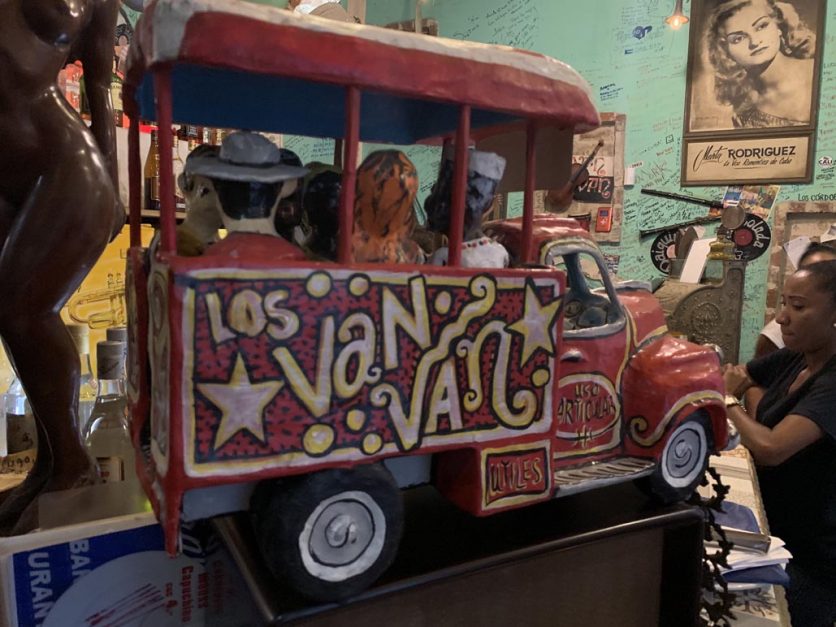
Table of contents
Table of Contents
Fast Facts about Havana
- Power voltage is 110V-220V at 60 Hz. Type A, B, C, and L.
- Cuba’s two currencies are the Cuban Peso and the Cuban Convertible Peso, mainly used for tourists.
- 1 Cuban Convertible Peso is equal to 1 USD.
- The best way to get around Cuba is by bus or taxi. If taking a taxi, make sure the taxi is licensed before riding.
- You need a tourist card to enter Cuba, as well as a passport that is valid for two months after your trip ends. The tourist card allows you to stay in Cuba for up to 30 days.
- The most popular cellular networks in Cuba are Cubacel and Digicel and both offer SIM cards. It should be noted the SIM cards can only be used on unlocked GMS phones. To rent a SIM card, you need a passport and your IMEI (phone ID) number.
- Cuba has a sales tax rate of 2% on wholesale sales and a 10% rate on both retail sales and services.
- SIM Cards : Cuba has very limited Internet and the best bet for visiting Cuba is to unplug, relax and if you have to, use your hotel’s limited WiFi for emergencies.
- It is advisable to download offline maps and any apps offline that you use to travel.
Things to See and Do in Cuba
- Hike Through Sierra Maestra: Cuba’s largest mountain range and the start point of the Cuban Revolution. Take a tour to learn more about Cuba’s history and enjoy a beautiful hike and great mountain views.
- Varadero Beach: Visit this pristine and popular beach in Sol Palmeras. Walk through the sand, swim in the clear waters, get to know other tourists or locals, or simply relax and take in the beautiful views.
- Old Havana: Old Havana is the city center of Havana is considered a crucial part of any trip to Cuba. Stroll through one-of-a-kind historic streets and buildings to see the history of Cuba.
- Tropicana Club: Head to the famous Tropicana Club for some great nightlife entertainment. Get dinner and enjoy the thrilling cabaret show that’s been running since the 1930s, featuring lively song and dance numbers.
Cuba Travel Guides
- 36 Fantastic Things to do in Havana, Cuba
Accommodation
Budget: Cuba offers family-run bed and breakfasts (or casas particulares) for around 15 to 25 pesos per night.
Mid-Range: For mid-range hotels, expect to pay roughly 70-130 pesos per night.
High-End: Upscale hotels will cost about 150-250 pesos per night.
Check out our favorite booking platforms Booking.com , Tripadvisor and VRBO for the best deals on accommodation.
If you’re on a budget, you can find options for pizza or spaghetti at around 3-4 pesos each.
Coffee lovers can find delicious cups of coffee for around 0.10 pesos. Restaurants are a good way to learn more about Cuban cuisine.
Expect to pay around 10-15 pesos for a meal at a restaurant.
The Best Ways to Get Around Cuba
Getting to cuba:.
Getting to Cuba: While there are 10 international airports in Cuba, the Aeropuerto Internacional José Martí in Havana is the main one, with the Gualberto Gómez International Airport in Varadero being a close second.
Flights: You can check for the best flights to Cuba on Skyscanner .
Transportation:
Transportation: Look for the Viazul buses, which are made especially for tourists and feature air-conditioning. Great for long distances, you can travel from Trinidad to Havana in six hours for just 25 pesos.
You will want to arrive at the station in advance to get a spot.
Trains : The train system in Cuba runs the length of the island and is a good way to meet the locals.
Go from Havana to Santa Clara for just 20 pesos, or from Santa Clara to Santiago de Cuba for 50 pesos. Be advised that the trains only run every few days, so planning ahead is key.
Taxis: Taxis are an alternative way to get around Cuba.
Fares start at 1 peso as a flat rate and increase by 1 peso for each kilometer traveled.
To travel from Old Havana to Miramar, for example, costs 8 to 12 pesos.
Car Rental: It is possible to rent a car in Cuba, but it is expensive and can be convoluted. Take care when you do. Check rates and availability here.
When to go To Cuba
Between November and April is the most popular time to go to Cuba, as temperatures range from 78 to 85 degrees Fahrenheit and skies tend to be blue.
You can find higher temperatures (up to 90 degrees) and lower hotel rates in August but note that hurricane season is between August through October.
Where to Stay in Cuba
Iberostar Grand Packard – Located on the Malecon and walking distance to Old Havana, this is the premier place to stay in Cuba.
Hostal Las Palmas :One of the most highly rated bed and breakfasts in Trinidad. Explore Trinidad and the Playa Ancon beach, which are both close by.
Suite Florencia : Built-in 1940, this colonial house turned hotel in Santa Clara is right in the middle of everything. Descend the white marble staircase into this romantic hotel.
Enjoy beautiful views of Santa Clara from your room, or roam about Santa Clara and visit the nearby restaurants and bars.
What to Pack for Cuba
Cuba has a tropical climate so you can count on it being hot and humid.
- Swimsuit: With Cuba”>
- Sunscreen: Protect your skin from the powerful sun with some sunscreen.
- Cash: As you may not be able to withdraw money from your bank accounts while in Cuba, make sure to bring an appropriate amount of cash based on what you think you’ll spend.
- We didn’t have a problem withdrawing from ATMs in Havana, but it is better to be safe
Cuba Travel Guide: Best Booking Resources
Whenever we travel to we make sure to start with these companies. We have tried a lot of different ones over the years and all of these have consistently proven to be the best when it comes to offering great prices.
We have used every one of these personally and continue to do so.
- Booking.com : This is our go site to when comparing prices for accommodation. It usually has the cheapest prices, especially in Europe and we love their interface. Not to mention you get free cancellation and you are guaranteed the best price.
- Trip Advisor : What we like about Trip Advisor is that we can look at all the reviews and then book our accommodation. TripAdvisor is where we go when we want to compare prices with multiple accommodation providers.
- VRBO : is the main search engine we use when we are looking for a home or apartment rental. It can sometimes be cheaper than hotels and it is the best way to stay in areas that offer a more local feel.
- Hostelworld : With one of the largest databases of hostels in the world, Hostelworld is the go-to site when you are looking for budget accommodation.
- Skyscanner : This is the first place we check for flights. It consistently comes back with the cheapest and best options. It allows us to compare a lot of airlines to get the best price.
- Rome 2 Rio : If you want to see how to get somewhere by plane, train, bus, ferry or car Rome2Rio lays it all out for you as well as related costs.I love how they show it all to you on a Google Map and it works offline.
- Get Your Guide: For all your day trip and city guide needs, we use Get Your Guide. It has the world’s largest collection of things to do with more than 30,000 activities in 7500 destinations.
- World Nomads Insurance: When traveling to Italy you should always have travel insurance. We have found the best bang for your buck is by far World Nomads.
Cuba Travel Guide: Related Articles
To browse all our articles and guides about Cuba Click Here.
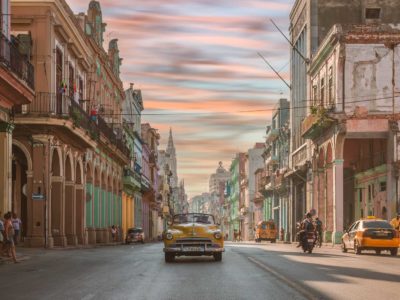
19 Unforgettable Places to Visit In Cuba in 2024
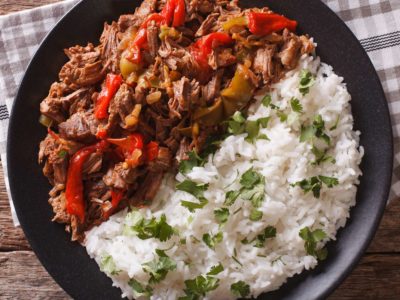
Cuban Food: 23 Cuban Dishes You Can Try at Home
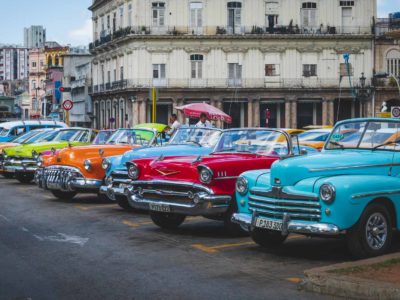
19 Fun Facts About Cuba You Never Knew
Cuba in 4 days, the ultimate itinerary

Sometimes all you need is a weekend getaway to recharge one’s batteries. If you live in the U.S., a 4 days trip to Cuba could be the perfect option for your break. Right now is the best moment to visit the island. Cuba is now more accessible since many airlines have resumed their regular routes between the United States and Cuba after Biden lifted the ban imposed by Trump over two years ago. Plus, the winter season offers the best weather to discover this fascinating island known for its beautiful colonial cities, dreamy beaches, tobacco plantations and revolutionary past.
After many years of helping travelers to explore Cuba, we can confidently say that a 4 days Cuba tour is enough to give you a glance at the authenticity of the island . We know this is a bold statement and you might still be wondering, “how is it possible to get to know Cuba in 4 days?” The secret is to plan and design a good schedule. Based on the experiences of thousands of clients, Espíritu Travel has designed a 4 days trip to Cuba which covers the most popular sights . Do you want to know more? Keep reading. Here are Espíritu Travel’s recommendations on what to see in Cuba in 4 days.
Day 1 – Discover Old Havana and try the Cuban Cuisine
If you are visiting Cuba for only a short period, we suggest that you spend some time in Havana experiencing its culture and visiting the historic sites of the city. O ld Havana is the most iconic area of the capital and covers some of the most important sights such as Plaza de Armas or Plaza de la Catedral.
When you start getting hungry, get immersed in Cuban gastronomy by trying out one of the outstanding family-run paladares in Havana . If you still have some energy, experience Havana’s nightlife by booking some dancing lessons with a salsa instructor . Salsa is a big part of the Cuban culture and something you should definitely consider including in your 4 days Cuba tour.

Day 2 – Explore Havana inside and out
Start the day by visiting one of the most famous tobacco factories in the country: Partagás. Learn everything you need to know about the art of making and smoking Cuban cigars and take home some high-quality examples after your 4 days trip to Cuba. Once the visit is over, hop in a vintage American convertible car for a fun experience driving along the Malecón. This huge promenade is one of the most authentic and famous avenues in all Cuba. In the evening, have an extraordinary experience by visiting a unique community art project: Fusterlandia . You could also arrange a private visit to a local artist’s studio or go shopping for vintage jewelry and handmade artisan products.
Day 3 – Day trip to Parque Nacional Viñales
Just a few miles away from Havana, you can find a spectacular reservoir: Parque Nacional Viñales. A unique landscape formed by limestone outcrops (known as mogotes), and the perfect place if you are into nature and want to include outdoor sports such as horseback riding while you visit Cuba in 4 days. Parque Nacional Viñales also offers you the possibility of visiting a real tobacco plantation , a great activity to get to know the history of the country.
Even though we strongly recommend that you give Parque Nacional Viñales a try, there are other activities that you can do on the third day of your 4 days Cuba tour. For example, you could relax on one of the white sandy beaches near Havana or go on a cultural visit to Hemingway’s House . There are plenty of options, so it is up to your needs and desires!

Day 4 – See you later Cuba
On the last day of your 4 days trip to Cuba, it would be time to get your luggage ready and check out of your accommodation. Depending on your flight itinerary, you might still have time to continue exploring Havana at leisure , using your new local knowledge to get you around town or ask us to organize something for you. By the time you catch your flight, we are sure you will be full of good memories of Cuba and wishing you can get back soon!
Even though this suggested itinerary includes some of the most requested locations and sights in Cuba, every trip that we offer at Espíritu Travel is customizable. Meaning you can let us know what kind of trip you would like and we will custom-design it for you . Do you want to get to know Cuba in 4 days? Contact Espíritu Travel and we will get you sorted!
Leave a Reply Cancel reply
Your email address will not be published. Required fields are marked *

Our Trips to Inspire
- Long weekend in Havana
- Havana & Viñales
- Havana & Varadero
- Week in Cuba
- Uncovering Cuba
- Explore Cuba
- Scuba Diving in Cuba
- Santiago & Eastern Cuba
- Havana Imagined Photography Workshop
Plan your Trip
- Accommodations in Cuba
- Flight information
- Itinerary disclaimer
- Cuban money
- Passports and visas
- Custom and private trips to Cuba
Additional Information
- Responsible tourism policy
- Travel Insurance
- Terms and conditions
- Privacy policy
- Cancellation policy
Espíritu Travel Offices
32a Stonehouse Lane Keene, NH 03431 +1 800 387 1370 [email protected]
Calle Apodaca #352 Old Havana 10200 [email protected]

Where to Stay in Havana, Cuba
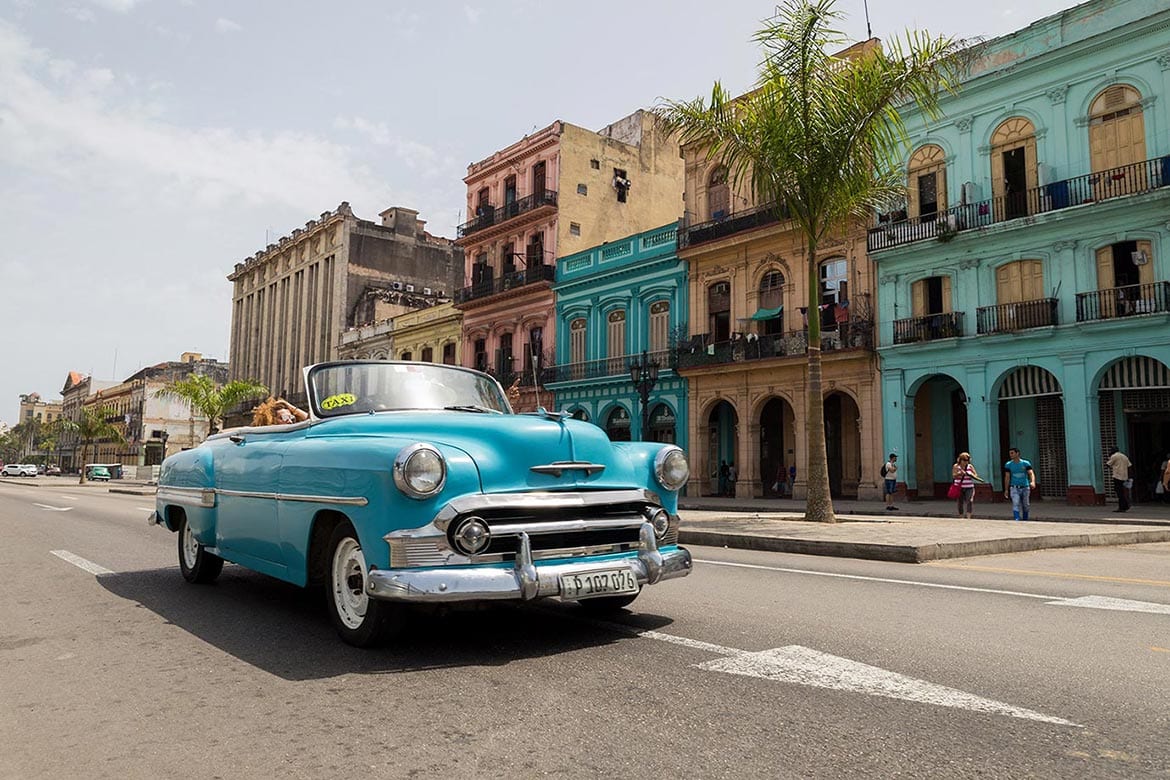
Are you looking at where to stay in Havana, Cuba? From Hotel Nacional de Cuba to Residencia Santa Clara, these are some of the best hotels in Havana!
22 best things to do in havana, cuba.
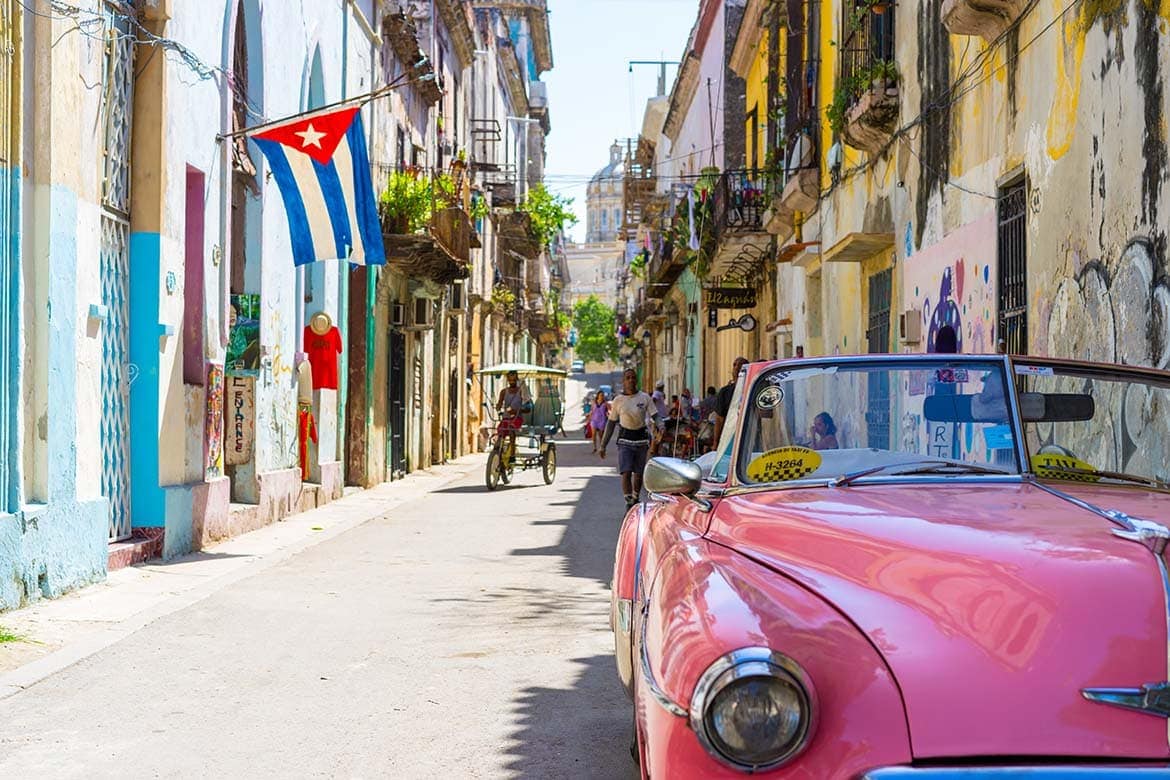
Are you looking for some of the best things to do in Havana? From driving around in a classic car to drinking daiquiris, this is what to do in Havana, Cuba!
Cuban beauty: pictures of cuban people in havana.
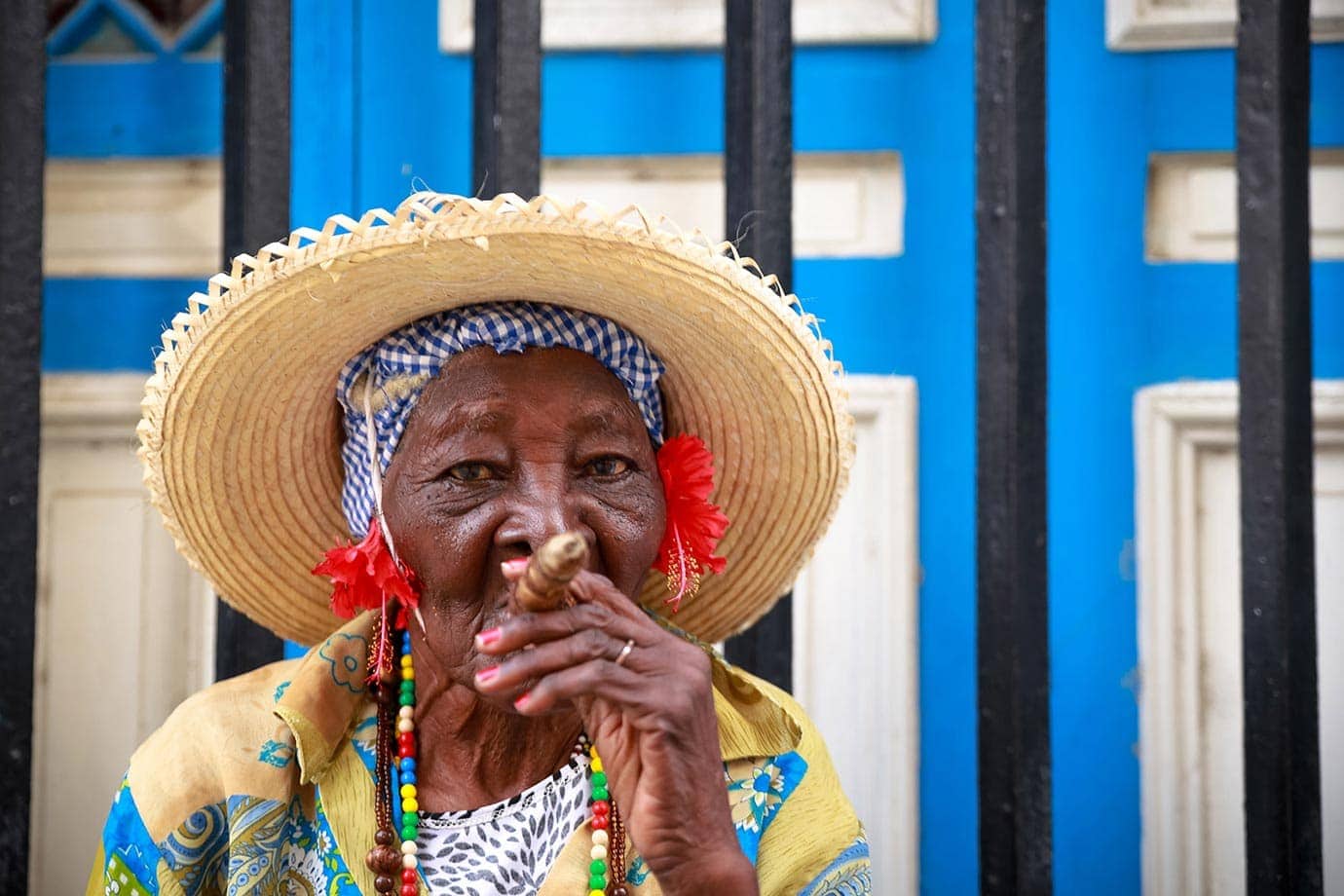
My trip to Havana was all about capturing the true Cuban beauty of the Caribbean. Hopefully these pictures of Cuban people showcase that!
How to get a last-minute tourist visa for cuba.
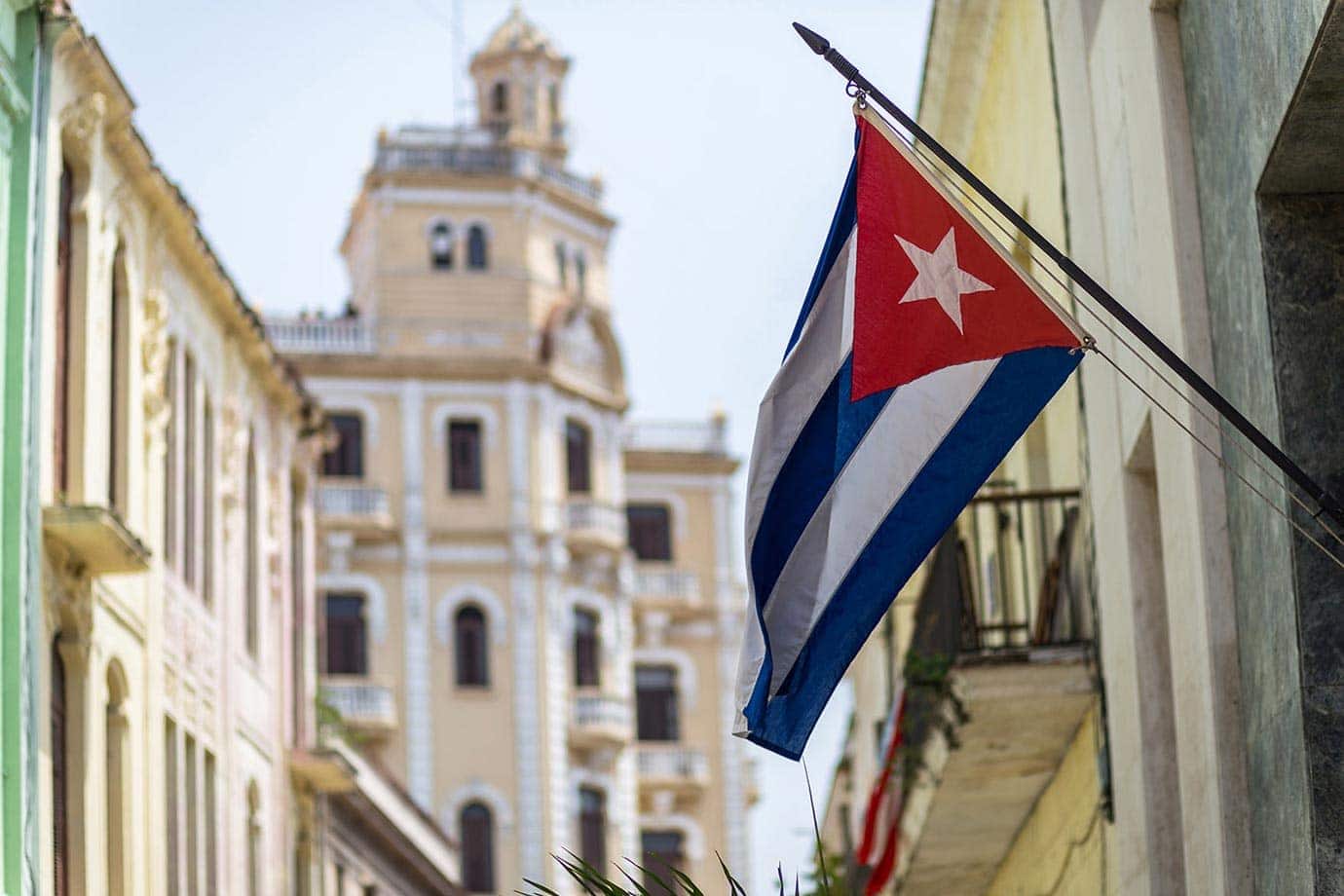
Do you need a Cuban tourist visa at the last second? Don’t worry, I’ve got your back. Here’s everything you need to know about getting a tourist visa for Cuba!

Havana, Cuba: A Local’s Guide for Travelers [2024]
What feels like a thousand complex layers of history, culture, religion, and cuisine combine in messy, magical Havana, Cuba. More than just a layover on the way to Cuba’s spectacular beaches or the chance for the perfect Instagram, an experience visiting Havana is an opportunity to peel back the layers – just wait until you see what you find!
As locals, we’ve had no greater pleasure than calling Havana home – and a home away from home, experiencing it like fewer others get the chance to. Read on for everything you’ll need to know as you plan a visit to Havana, Cuba, including our local insight into the best things to do in Havana , where to stay , and when to visit – plus special guidance for American travelers hoping to (finally!) visit Cuba.
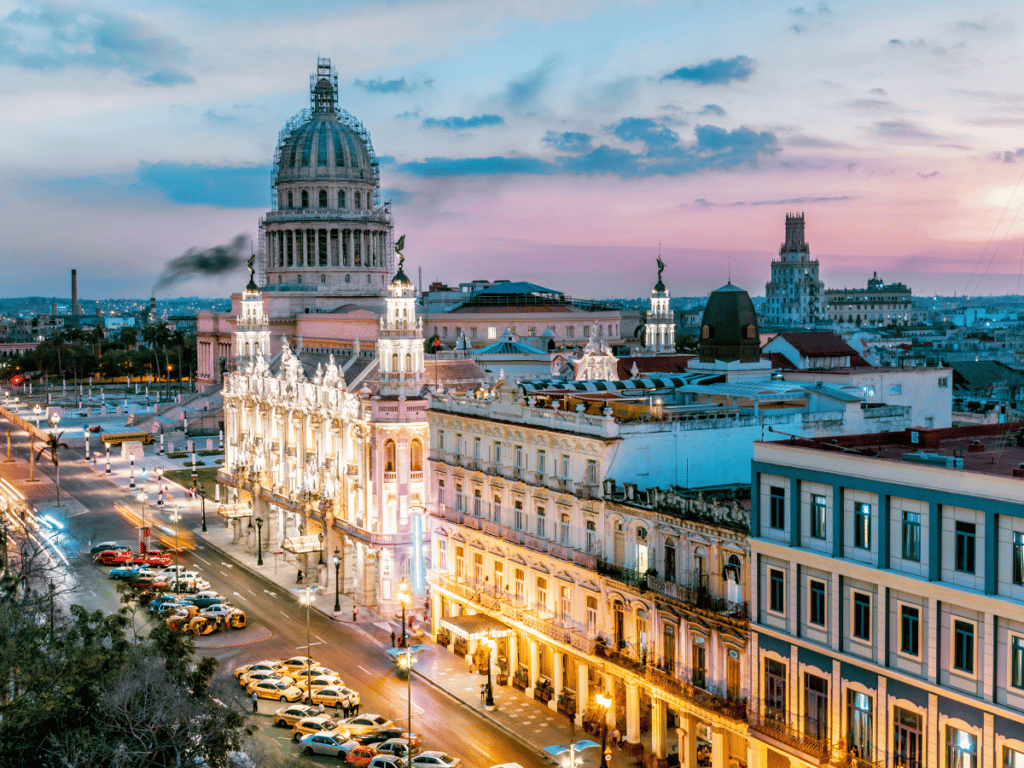
This post contains affiliate links that may reward me monetarily or otherwise when you use them to make qualifying purchases – at no cost to you. As an Amazon Associate, I earn from qualifying purchases. For more information, please read our disclosure policy .
Havana, Cuba
Ask anyone about Havana, Cuba, and they’re sure to mention a few special things that characterize the city: Cars. Cigars. Colorful casas and colonial castles. Communism, perhaps. There are a million things Havana is known for , but the experience of exploring Havana firsthand is so much more than that.
Bar hop alongside local mixology masters. Learn about revolution at a presidential palace riddled with bullet holes turned museum. Dance the night away to DJ sets by international superstars at a mixed-use arts space named one of the best places to visit in the entire world . These are just a few of the best things to do in Havana that are transforming the stereotypes – and making Havana more desirable for travelers than ever.
For those looking for a Caribbean vacation but are unsatisfied with the idea of being confined to a resort, planning a trip to Havana might be the perfect solution. Spend a few days exploring Havana before heading off to the nearby beach town of Varadero . It’s a classic vacation that mixes the richness of one of the world’s great cities with one of the best beaches in the Caribbean.
Havana makes for an incredible and quick getaway from Mexico, the Caribbean, or the United States, even as a great long weekend option; traveling to Havana from Miami is a quick 45-minute flight!
However, you can just as easily spend five or more days exploring Havana before heading out to the rest of the country to explore favorite destinations like Viñales , Trinidad , Baracoa , and more. It’s the perfect starting point to discover the best things to see and do in Cuba .
Read More: 3 Days in Havana: Ultimate Itinerary
Cuba Travel 101
- Currency in Cuba: A Local’s Guide for Travelers
- How to Get Wifi in Cuba [Updated!]
- Is Cuba Safe? Updated Cuba Safety Guide
- Ultimate Cuba Travel Guide – A Local’s Advice for Travelers
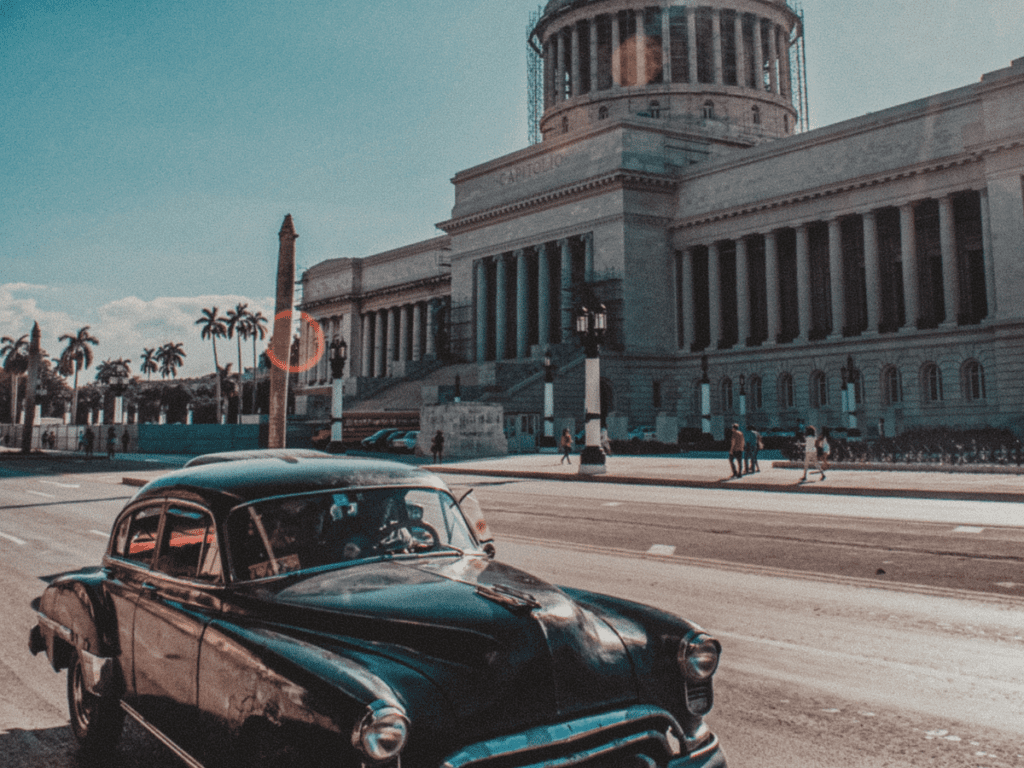
Is Havana Safe?
Take it both from personal experience and from statistics: Havana, Cuba is safe for travelers! Even as a woman, I’ve never felt unsafe or uncertain when traveling in and around Havana – even alone. The city of Havana and the country of Cuba overall are known for being extremely safe for travelers , and you won’t have much to worry about here.
When traveling anywhere, make sure to take some basic safety steps and take basic measures to protect yourself against petty crimes like pickpocketing. However, you can visit Havana feeling confident and safe as you travel.
Read More: Is Cuba Safe? Ultimate Local Guide for Travelers
Can Americans Travel to Havana, Cuba?
Yes, Americans can travel to Havana! It may come as a surprise to learn, but it’s actually quite easy and 100% legal to travel to Cuba as an American. For most travelers from the United States, it’s no more difficult to travel to Havana than it is to travel anywhere else – check out our guide to traveling to Cuba from the United States for details.
However, it’s important to be aware that the U.S. imposes some restrictions on U.S. travel to Cuba that you’ll have to keep in mind when traveling. The U.S. allows “ Support for the Cuban People ” travel, meaning that you’ll need to plan to support local Cuban small businesses while traveling rather than businesses run by the Cuban government.
One important detail of this is that many hotels in Cuba are at least partially owned by the Cuban government, making them off-limits to American travelers . Check out our guide to where to stay in Havana for some excellent places to stay in the city you’ll have no trouble booking.
American Travel to Cuba
- Can Americans Travel to Cuba? – Legal Travel to Cuba from the USA
- Support for the Cuban People – Travel for Americans to Cuba
- 10 Things To Do on a Support for the Cuban People Trip
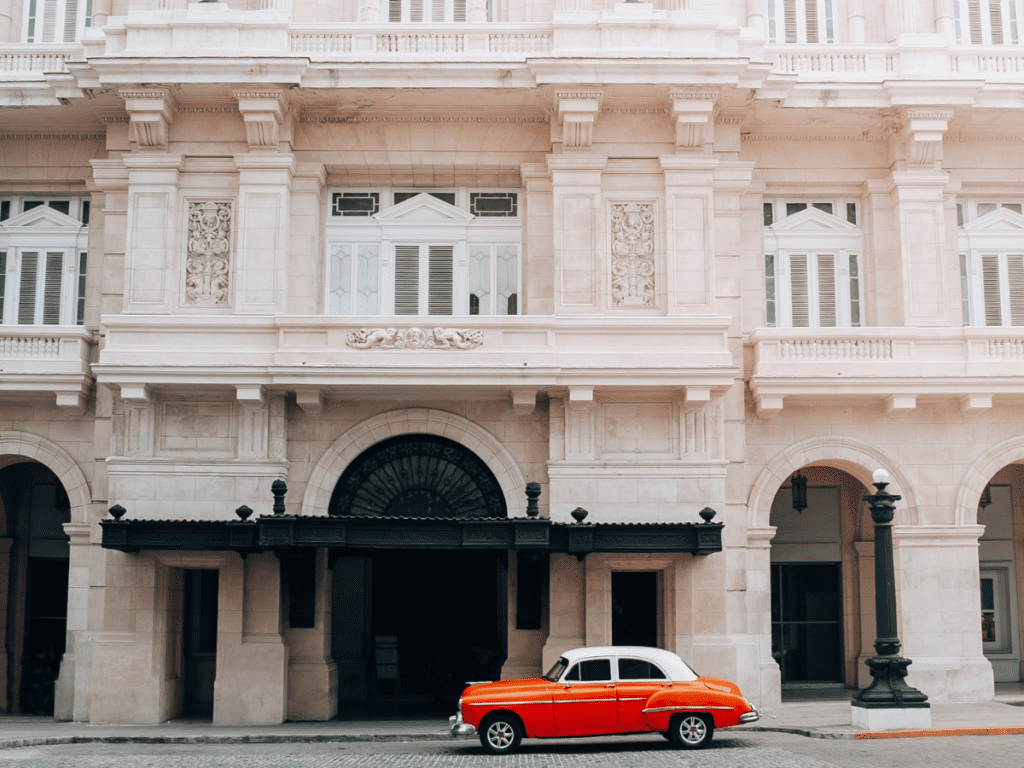
Best Time to Visit Havana, Cuba
Havana is magic year-round. However, with Cuba’s year-round hot weather, it’s best to plan a trip during the relatively cooler, drier months of the year. Late November or December through April or May tends to be the best time to visit Havana for nice weather.
- High Season: December – April
- Shoulder Season: May – June, October – November
- Low Season: July – September
However, December through April also correspond with the high season of travel. Havana never feels overrun with tourists, though this season is certainly busier. Prices for everything rise, particularly around the festive season in late December.
If you’re looking for that sweet spot of nice weather, smaller crowds, and lower prices, aim for the shoulder seasons, particularly May and June , before Atlantic Hurricane Season picks up and rainy weather starts in earnest.
Read More: Best Time to Visit Cuba: Month By Month Breakdown
More Guide to Exploring Havana
- 45+ Best Things To Do in Havana, Cuba
- Where to Stay in Havana
- 6 Best Resorts in Havana, Cuba
We created a detailed Havana map to help visitors explore the best of the city. Here you’ll find our favorite Havana restaurants , hotels, the best things to do, and the destinations you can’t skip when in Havana. Click on the Havana map to zoom, explore, and download for your Havana travel experience.

Things To Do in Havana, Cuba
Whether you’re looking to explore Havana’s historic landmarks, dive into its culinary scene, or even experience its cultural scene, there are plenty of things to do in Havana for travelers of every interest.
We can’t dive deep into all of them here – check out our exhaustive guide, 45+ Best Things To Do in Havana , for more of that. However, these are a few favorite things to do in and around Havana you can’t skip during your visit:
1. Explore Old Havana
Exploring the bucket list destination of Old Havana is hands down the best thing to do in Havana. With its early 20th-century buildings in bright colors, classic American cars, and winding cobblestone streets, it’s incredibly enchanting.
A popular place to start a self-guided walking tour is in the Plaza Central, from which you can head down the bustling Calle Obispo that cuts through the center of Old Havana. Or, sign up for a free tour of Old Havana or a private guided tour to explore with the guidance of locals.
Trace a route between Havana’s four historic plazas (Plaza Vieja, Plaza de la Catedral, Plaza de Armas, and Plaza de San Francisco) to cover most of the old city . Make sure to also take a stroll on the Paseo del Prado heading towards the Malecón sea wall, especially towards the evening, to enjoy the sunset over the ocean.
One thing that makes Old Havana so unique? People actually live here! While parts of Old Havana have been transformed into museums and apartments for rent to visitors, you’ll still see Cubans living their everyday lives – kids playing in the streets, fruit and vegetable markets filled with locals, and more.
Read More: Top 10 Apps to Download for Travel to Cuba
2. Shop at Clandestina
Clandestina is a Cuban design brand based in Havana that is taking Cuba and the rest of the world by storm . Based out of its charming storefront in Old Havana (located at 403 Villegas near El Capitolio), Clandestina is one of the first and only Cuban brands to market and sell its products online worldwide.
Clandestina’s design store carries hand-printed clothes, posters, items for the home , and much more. Not only do these items make perfect souvenirs with their often tongue-in-cheek Cuba-related themes , but you’ll also be supporting a groundbreaking Cuban small business.
Travel Insurance
Cuba requires that all travelers have proof of a comprehensive travel insurance policy in order to enter the country. Check out our guide to travel insurance for Cuba for more details. We recommend these brands for Cuba travel insurance:
- Visitors Coverage : Coverage for Cuba travel available to citizens of all countries, though not currently available to residents of New York and Maryland in the United States.
- Insubuy : Coverage for Cuba travel available to citizens of all countries and states of the United States.
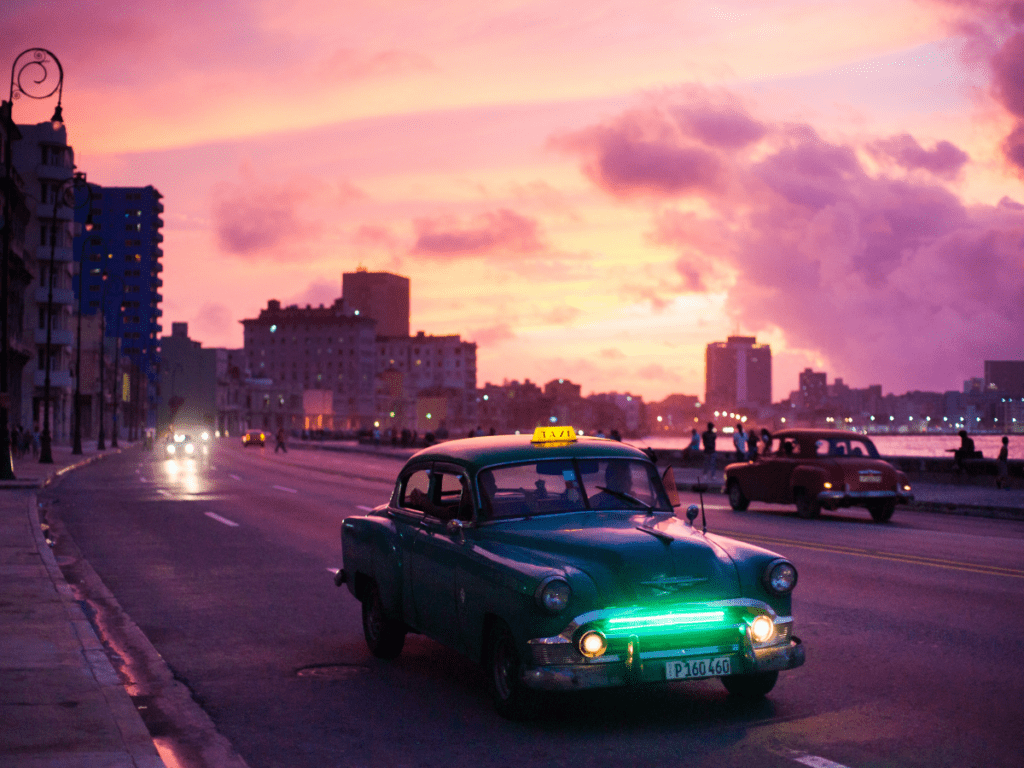
3. Walk – Or Drive – Along the Malecón
The Malecón is Havana’s emblematic oceanfront promenade. It has long been a favorite gathering spot in Havana, especially in the evening and to watch the sunset . It’s one of the most iconic images of Havana, and no visit to the city is complete without strolling on the Malecón.
This coastal highway is also famous as the route for the most famous of all things to do in Havana – taking a ride in one of the city’s many candy-colored vintage convertibles. This activity is one of the most iconic things to do in Havana for a reason – it’s really cool! You can book a ride in a classic convertible in Havana ahead of time for a hotel pickup and to avoid haggling over prices, or find drivers in Havana’s Parque Central.
4. Explore El Vedado
The Havana neighborhood of El Vedado is packed with great places to eat, as well as plenty of fun bars and clubs . This makes the neighborhood one of the best places to stay in Havana . It also means you should definitely plan on exploring the neighborhood whether you stay here or not!
While visiting El Vedado, try out some of our favorite Havana restaurants like El Idilio, Fonda La Paila, or El Cheverongo. Mamaine in El Vedado is one of my personal favorite cafes in Havana and has a great range of food and coffee options all day.
An institution in El Vedado is Coppelia , well known in Havana and around Cuba as the country’s most famous ice cream parlor, with a rotating list of flavors. Coppelia is the perfect stop for an afternoon treat to escape from the sun.
Directly across the street from the Coppelia is the Yara, a landmark movie theater that hosts regular new releases of Cuban and Latin American films, as well as international film festivals. If you’re in town for a film festival, try getting tickets – they’re very cheap!
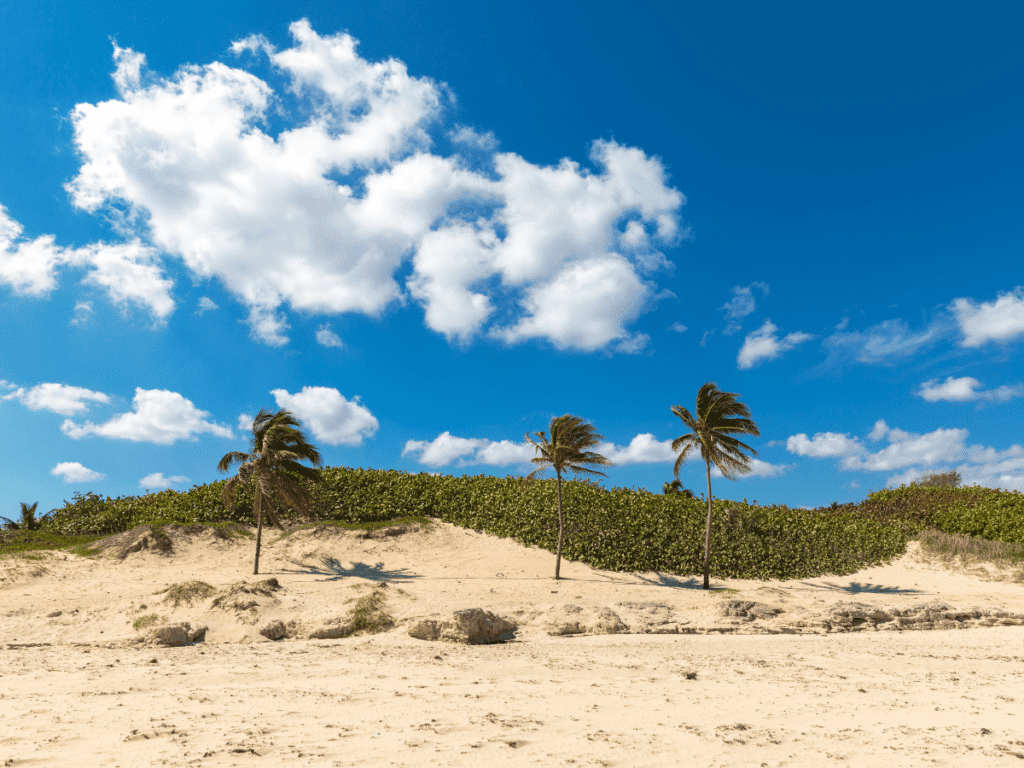
5. Visit Playas del Este
Havana proper doesn’t have any true beaches – you’ll have to travel just east of the city to the aptly-named Playas del Este to experience the nearest beach! The beaches at Playas del Este are relatively easy and inexpensive to access, making them quite popular with locals and travelers with shorter itineraries.
Don’t expect the pristine beaches you’ll find at Varadero or on Cuba’s cays , but don’t scoff at these beaches either! The nicest Havana beaches that are part of the Playas del Este are Playa Santa Maria and Playa Marazul. Here you’ll find beachside hotels and restaurants nearby, which make renting chairs and finding facilities during a beach day quite easy.
You can easily arrange private transport with a taxi from the city. For a cheaper yet comfortable option, you can take a Havana Bus Tour hop-on hop-off bus (on the T3 line) departing from Old Havana’s Parque Central.
Havana Beach Guides
- 7 Best Beaches in Havana
- Playas del Este: A Local’s Guide for Travelers
- 12 Best Beaches in Cuba

Things To Do in Havana at Night
Visit fábrica de arte cubano.
There’s just nowhere like Fabrica de Arte Cubano . This unique mixed-use space in the El Vedado neighborhood includes multiple bars alongside spaces for rotating fine arts installations, event venues for live music and performances, and much more .
Come for internationally renowned musicians and DJs, as well as fashion shows, documentary screenings, and much more on rotation nightly . Plan on starting the night by eating at El Cocinero (located right next door!), then spending the whole evening here; there will be plenty to keep you entertained!
Join Locals on the Malecón
Havana’s Malecón – a famous oceanfront promenade – is one of Havana, Cuba’s favorite destinations at night. Not only is this a great place to enjoy an unforgettable sunset, but it turns into a favorite gathering spot for locals and travelers alike at night.
You’ll find vendors walking up and down the sea wall selling alcohol and snacks, or you can bring your own and enjoy. Not only is this one of the best ways to enjoy the Havana sunset, but it’s also one of the many awesome (free!) things to do in Havana at night.
Get A Drink With a View
While there are plenty of bars and restaurants in Old Havana with beautiful views and rooftops, the pool decks and rooftop bars at the three newest luxury hotels in the city – Gran Hotel Manzana Kempinski, Iberostar Packard Hotel, and Royalton Habana – are fantastic spots to enjoy a happy hour drink and unmatched views .
My personal favorite is the Gran Hotel Manzana Kempinski , with its incredible view over Plaza Central and Havana’s beautifully restored theater. Drinks are delicious, prices are reasonable, and views are stunning. It’s one of the best date spots – or Instagram locations (if you’re into that) – in all of Havana.
Read More: 15+ Best Hotels in Havana
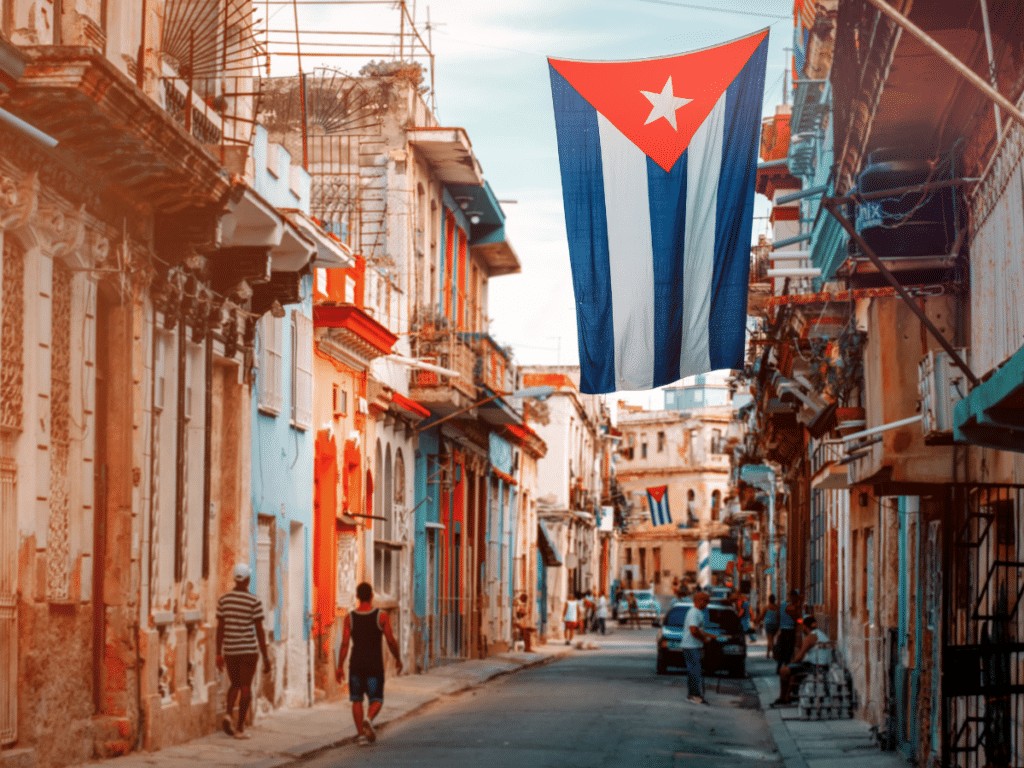
Where To Stay in Havana
It’s an exciting time to visit Havana, with an impressive number of new hotels and casa particular guest houses offering travelers more options than ever as they decide where to stay. We’ve created Havana accommodation guides galore (our best: Ultimate Guide to Where To Stay in Havana ), but here are some of our favorite places to stay in Havana, Cuba:
Casa Giraldilla
$ | Old Havana | Aguacate #51
The tiny, three-bedroom Casa Giraldilla in Old Havana is one of the best casa particular guest houses in Old Havana . Beautiful interiors are only bested by balconies perfect for morning coffee, overlooking residential streets, and perfect for people-watching. Hosts Carmen and Carlos are lovely; they’ll prepare an excellent breakfast and bend over backward to help you enjoy your stay.
Reviews and Bookings: Casa Giraldilla
Casa Flamboyan
$ – $$ | El Vedado | Calle 19, Between Calle E & Calle F
Casa Flamboyan is a stately yet welcoming mansion turned lovely casa particular guest house in El Vedado , now one of the best affordable places to stay in the area. While the interior design is relatively basic, common spaces like a shaded front patio and sunny rooftop terrace are perfect for enjoying long afternoons in one of Havana’s coolest neighborhoods.
Reviews and Bookings: Casa Flamboyan
Residencia Santa Clara – $$
$$ | Old Havana | Santa Clara #13
Residencia Santa Clara makes both our lists of best hotels in Havana and even the best hotels in Cuba , so you know it has to be something special. This boutique hotel in the heart of Old Havana has been awarded for its unique architectural charms, combining modern design with the neighborhood’s colonial buildings. Best of all, the fantastic, walkable location within Old Havana makes exploring the rest of the city a breeze.
Reviews and Bookings: Residencia Santa Clara
El Candil Boutique Hotel
$$ – $$$ | El Vedado | Calle 2 #457
One of the best examples of an immaculately converted and lovingly restored colonial mansion in the poshest areas of El Vedado, El Candil Boutique Hotel has all the modern amenities you could want and is among the best hotels in Havana , hands down. Gorgeous, historic details hit you the second you get in the door and continue through to the decor of the hotel’s spacious rooms.
Reviews and Bookings: El Candil Boutique Hotel
La Reserva Vedado
$$$ | El Vedado | Calle 2 #508
La Reserva Vedado is easily one of my favorite Havana hotels – this stunning historic home turned beautifully restored boutique hotel in El Vedado feels truly luxurious but won’t break the bank. Each room is unique and charming, and you’ll definitely make use of the lounge and garden for a sunset drink or morning coffee. The front porch and lush patio will make you feel as if you’re staying in a stylish friend’s personal home.
Reviews and Bookings: La Reserva Vedado
Iberostar Grand Packard
$$$ | Old Havana | Paseo del Prado #51
Among a handful of large, modern hotels in Havana, the Iberostar Grand Packard earns our recommendation as the best modern hotel in Havana. This 321-room hotel flawlessly combines a historic facade with new construction and all the amenities luxury-minded travelers could hope for. Perched along both the Paseo del Prado pedestrian thoroughfare and the Malecón oceanfront promenade, the hotel offers spectacular vistas across the city and bay, with an Old Havana location you can’t beat.
Reviews and Bookings: Iberostar Grand Packard
Havana Accommodation Guides
- Where to Stay in Havana, Cuba: Ultimate Guide!
- 15+ Best Hotels in Havana
- 6 + Best Resorts in Havana
- Best Casas Particulares in Old Havana
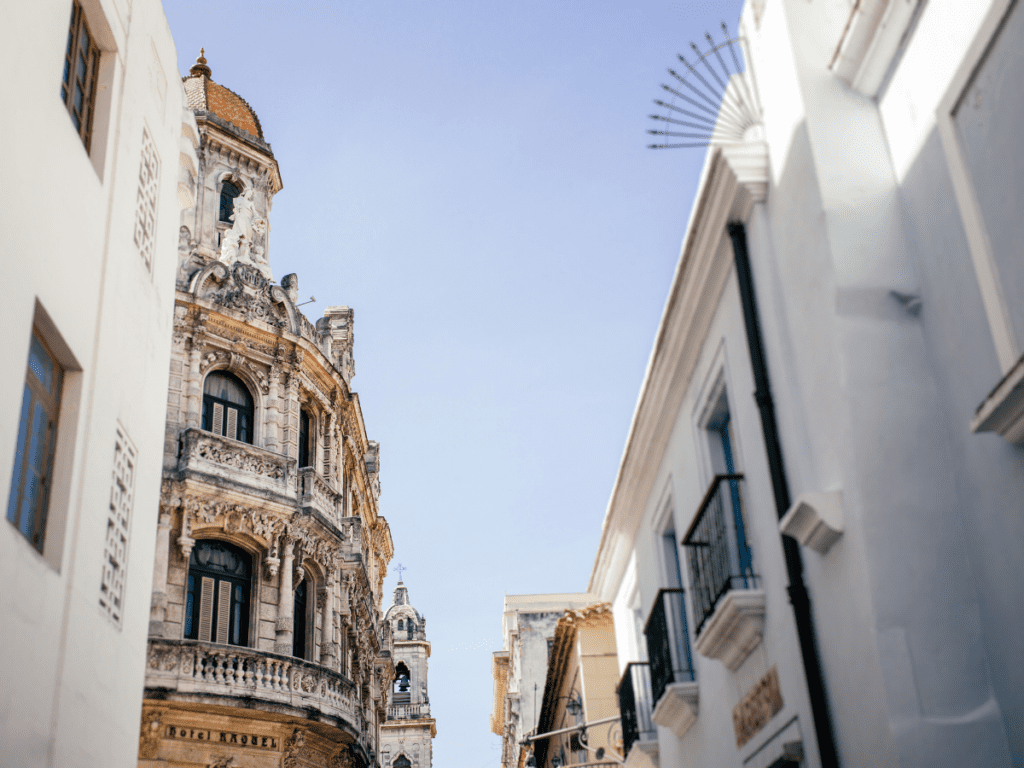
Where To Eat in Havana
Cuba’s economic struggles over the past few decades have certainly left their impact on Cuban cuisine, but with the impressive abundance of incredible and innovative restaurants in Havana , you’d hardly ever know it. An increasingly diverse array of restaurants, cafes, and bars serving Cuban and Caribbean classics alongside international favorites makes the Havana culinary scene increasingly exciting.
Before traveling to Havana, make sure to download the AlaMesa app to help you discover more places to eat. This is the Cuban version of Yelp or TripAdvisor for restaurants, and it lists locations across the country. It’s one of a few apps for travel in Cuba that we highly recommend for travelers.
El Café is our favorite cafe in Havana and a top recommendation I always share with travelers looking for a great place for breakfast, brunch, and coffee . Located in the heart of Old Havana, El Café serves delicious, fresh food and coffee all day. Breakfast sandwiches on sourdough are a favorite, as are granola with fresh tropical fruit.
El Café | $ | Amargura #358 – Old Havana
El Dandy is another breakfast, lunch, and brunch spot that turns into a happy hour spot in the evening. This place is small and quaint but always attracts a crowd and has affordable but delicious options throughout the day. Amazing cocktails and delicious plates of classic Cuban and international dishes are favorites with locals and visitors alike (though vegetarians, be warned, the menu can be a bit meat-heavy).
El Dandy | $ | Teniente Rey y Villegas – Old Havana
Jibaro’s, located in a quiet corner of Old Havana, is one of my go-to places and top recommendations for restaurants in Havana . This restaurant is known as one of the more vegetarian and vegan-friendly restaurants in Havana, so be sure to search it out if you’re sick of hunting down meat-free dishes around the city. The bar is a highlight that any guest will love, with increasingly more elevated mixology offerings.
Jibaro’s | $$ | Merced #69 – Old Havana
El del Frente
When the popular Havana restaurant O’Reilly 304 started to boom in popularity, owners quickly expanded down the street to meet demand, and El del Frente was born. While it might be sometimes overshadowed by its famous neighbor, I much prefer El del Frente. Its lovely rooftop dining space and bar are the perfect backdrop for its delicious, inventive Cuban dishes.
El del Frente | $$ | O’Reilly #303 – Old Havana
La Guarida is the most famous restaurant in Havana if not all of Cuba. Famous guests have included everyone from Madonna and the Kardashians to President Obama on his history-making trip to Cuba, who travel from far and wide to sample the best of Cuban cuisine.
La Guardia books up with reservations quickly and is pricey compared with most restaurants, but this place is worth the splurge for a delicious meal in a beautiful setting. Don’t miss the rooftop bar for an evening drink or meal with a view.
La Guarida | $$$ | Concordia #418 – Centro Habana
Havana Restaurant Guides
- 25 Best Restaurants in Havana
- The Best Brunch Spots in Havana, Cuba
- The Best Cafes and Coffeehouses in Havana, Cuba

Day Trips From Havana
There are so many things to do in Havana that you may never feel you have enough time here to see it all. However, if you’re looking to use Havana as a base to explore the surrounding areas in Cuba, you’re in luck; there are several excellent day trips from Havana that we always recommend to travelers.
Read More: 8 Best Day Trips from Havana
Day Trips from Havana to Varadero
Taking a day trip from Havana to Varadero – Cuba’s most famous beach resort town, home to one of the best beaches in the Caribbean – is by far the most popular way to escape the city for the day. Varadero is just over 2 hours east of Havana; frequent buses and private transport options connect the cities, making the trip an easy one.
Hotels and private rental hosts can arrange private transportation to Varadero, or buses leave several times a day from the central bus station in Havana near the Plaza de la Revolución. Day trips from Havana to Varadero with transportation included are generally affordable and a great option on a quick itinerary. We’ve had travelers use the Civitatis day trips to Varadero , to rave reviews!
Of course, you can never go wrong with spending at least one night in Varadero. There are countless resorts in Varadero to choose from, and a great array of cheap casa particular guest houses and small, locally-owned hotels within steps of the beach as well. Staying a few blocks away from the beach means you’ll have easy access to a beautiful stretch of ocean.
Plan a Trip to Varadero
- Varadero, Cuba: Ultimate Guide
- 10 Best Resorts in Varadero
- 12+ Best Things To Do in Varadero
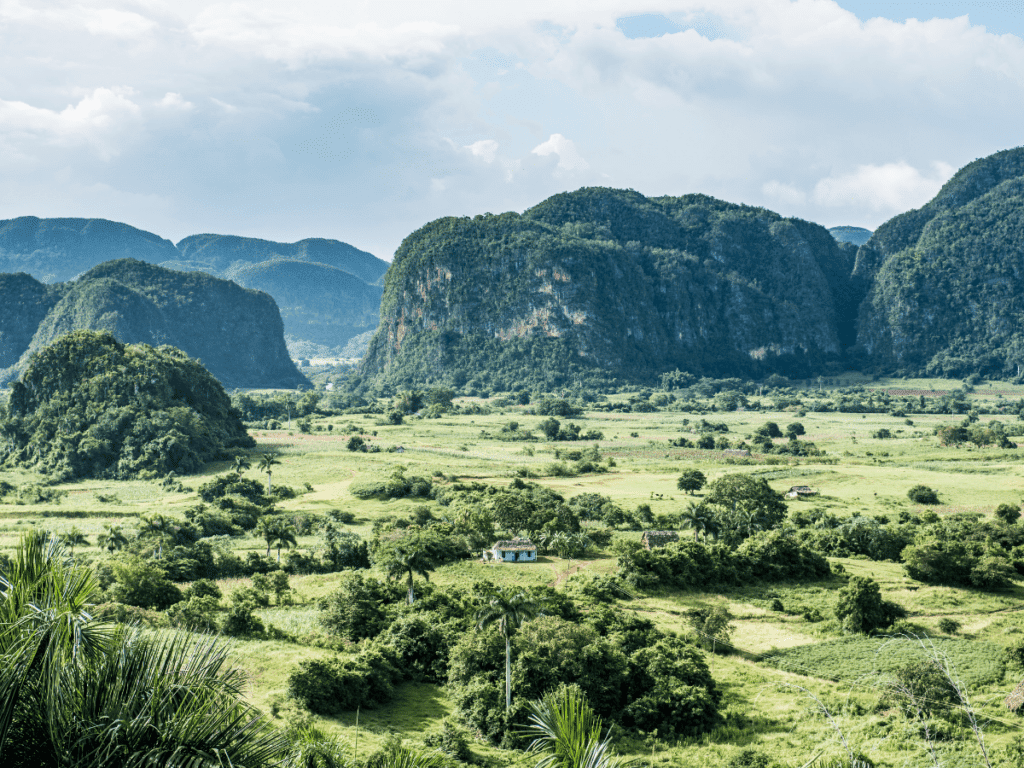
Day Trips from Havana to Viñales
Around 2 ½ hours west of Havana is Viñales , home to the Valle de Viñales and some of Cuba’s most beautiful natural landscape. Viñales is best known for its incredible limestone “mountain” structures that shoot straight up out of the valley floor and are covered with lush vegetation.
Viñales is also home to some of the best tobacco grown in Cuba, so it’s a perfect place to come if you want to learn more about the cigars that Cuba is so famous for.
On day trips to Viñales from Havana to Vinales , travelers can visit tobacco farms and meet farmers, see how they dry and store tobacco leaves, roll cigars, and try a sample! Viñales is also one of the best locations in Cuba for hiking ; you’ll find caves to explore and countless hiking trails through the natural reserve for some beautiful views.
Plan a Trip to Viñales
- Havana to Viñales Day Trip Guide
- Viñales, Cuba: Ultimate Travel Guide
- 12+ Best Things To Do in Viñales, Cuba

Getting To Havana, Cuba
Havana is the most accessible destination for travelers headed to Cuba and receives frequent flights from the United States, Canada, Latin America, and Europe. While recent announcements of a decrease in flights mean that travelers should book further in advance – if possible – Havana is still quite well-connected, relatively speaking.
Jose Martí International Airport
The Jose Martí International Airport in Havana is the largest international airport in the country. Located just outside of the city of Havana, it usually takes around 20 or 30 minutes to reach downtown Havana from the airport.
Taxis from the airport cost around $25 USD, though the official rate has recently changed and is posted at the airport . Make sure to settle on this rate with the driver before getting in the car. Alternatively, book airport transportation online ahead of time – this is how we always travel when we get back to Havana!
Reviews and Bookings: Havana Airport Transfer – Pre-Book Online

Bus Transportation in Havana
Havana is well connected to smaller cities in Cuba by both buses and private transportation routes of shared taxis. The central bus station in Havana is located near the Plaza de la Revolución and offers routes across the country on a regular basis. Cuba’s regional buses are branded as Viazul, and are generally quite comfortable.
Outside of the bus station, you’ll usually find mini-buses or private taxis headed to destinations around the country, filling seats at a per-person rate until they’re full and then departing. This is a reliable and safe way to travel (we usually travel this way when we can!) and ensures you’ll get to your destination faster and more comfortably.
Cuba Travel Requirements
- How to Get the Cuban Tourist Card (Required!)
- D’Viajeros Travel Form: Everything You Need to Know
- Cuba’s Required Travel Insurance: A Complete Guide to Travel Insurance Requirements
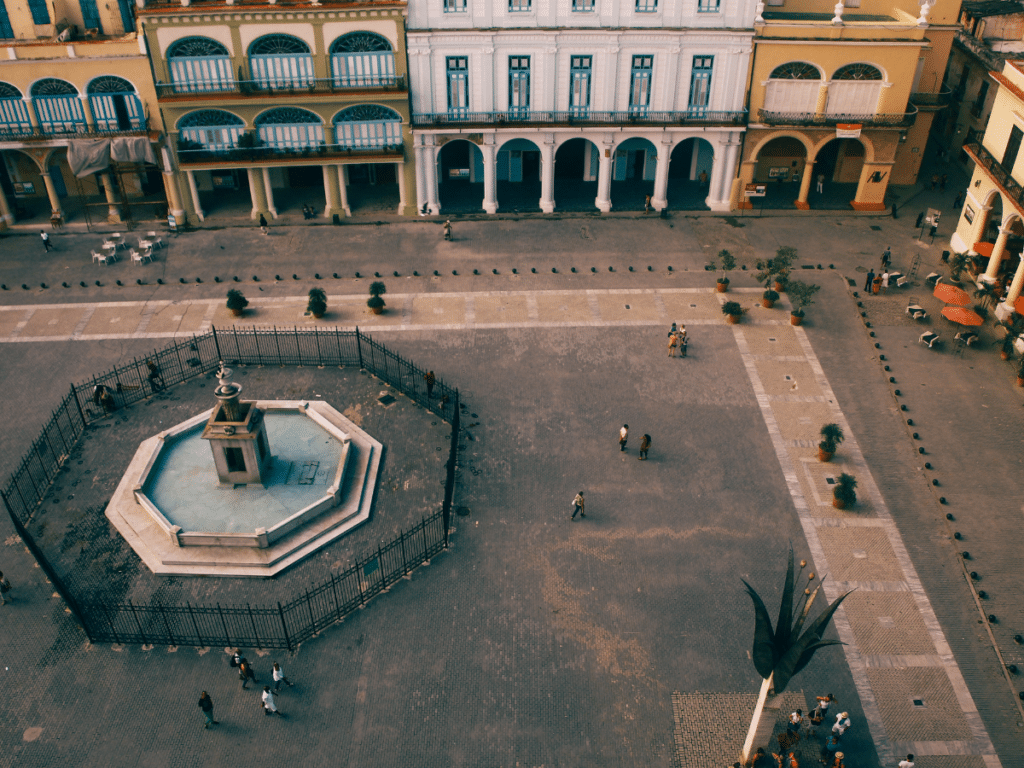
Havana Travel Tips
1. pack wisely.
The decades-long economic embargo imposed on Cuba by the United States means that it can be a challenge to find what some would consider to be basic items in Cuba. It’s hard to predict what you may or may not find on a daily basis in Cuba, so our advice to travelers is this: if there’s even a chance you may need something in Cuba, bring it with you.
Cuba is one of the only destinations we recommend travelers overpack for. Some things to consider adding to your suitcase? These are musts:
- Basic First-Aid Kit
- Medicines: Any medicine you regularly or occasionally take, including over-the-counter painkillers, pills for stomach issues, sleep aids, or the like. If you might need it, you need to bring it with you.
- Toiletries: it’s almost impossible to find recognizable brand names here, so bring exactly what you need – and then some! – when traveling to Havana.
- Feminine Hygiene Products , if applicable
- Diapers and Wipes , if applicable
- Tech Products or Camera Gear: You will not come across these items easily in Havana. If you need an extra phone charger, camera battery, headphones, or the like, you will likely be unable to find these things in Havana.
Again – if you think you’ll need it, you should bring it! In Cuba, it’s better to be safe than sorry when it comes to this; believe us!
What to Pack for Cuba
Check out our Ultimate Cuba Packing List to help you pack for your trip – we’re sharing exactly what to bring to Cuba and what we never travel without.
2. Be Knowledgeable About the Internet in Cuba
The internet in Cuba is slower than you’re probably used to, and there are far fewer places you can access wifi than you might be used to at home. Internet is now widely accessible across Cuba and especially in Havana, but don’t expect to be connected as much as you might be elsewhere!
Make sure to come with a VPN service (we’ve found NordVPN works best in Cuba and offers the fastest speeds in Cuba!) in order to access all the internet pages as you would at home. Otherwise, you may find some websites and apps inaccessible in Cuba. Read our guide to using a VPN in Cuba for more details.
Read More: Ultimate Guide: Using the Internet in Cuba
3. Cash is King
It’s important for travelers from the United States to be aware that American credit cards and debit cards will not work in Cuba – you’ll need to bring all the cash you plan to spend on your trip with you when traveling to Cuba.
Even if you don’t have U.S. credit cards or debit cards, cash is king in Cuba, and many restaurants, casa particular guest houses , tour providers, and more will not accept debit or credit cards . It is best to bring cash with you when you travel to Cuba and convert it to Cuban Pesos once you arrive.
Cuba’s national currency, the Cuban Peso, is currently experiencing significant inflation, which has led to two different exchange rates for foreign currency. What does this mean for travelers? Whether you’re visiting Cuba from the United States or from anywhere else, you’ll benefit greatly from bringing cash to Cuba. Read our guide to currency in Cuba for more details.
Guide to Currency in Cuba
- How Much Money to Bring to Cuba

Carley Rojas Avila
Carley Rojas Avila is a bilingual travel writer, editor, content marketer, and the founder of the digital travel publications Home to Havana and Explorers Away. She is a serial expat and traveler, having visited 40+ countries and counting. Carley has written for publications like Travel + Leisure, MSN, Associated Press, Weather Channel, Wealth of Geeks, and more. Find her front row at a Bad Bunny concert, befriending street cats, and taste-testing every pizza in Havana.

Cuba Travel Tips: 58 Things You Need to Know Before Traveling to Cuba (2023)
Traveling to Cuba? You probably already realized there’s a distinct lack of solid, practical Cuba travel tips for first-time visitors. Worse, the information may not be accurate at all in 2023!
Figuring out things like the Cuban currency, how to save money, what to pack, how to dress, how to access the Internet, or even how to stay safe and healthy can be confusing! This can be especially difficult for Americans since visiting Cuba was strictly forbidden for many years.
Until now! We’ve compiled the most complete list of things to know before traveling to Cuba, and they all work in 2023! We also cover the latest Cuba travel restrictions concerning the COVID-19 pandemic. Absolutely everything you must know.
Travel planning tips for Cuba
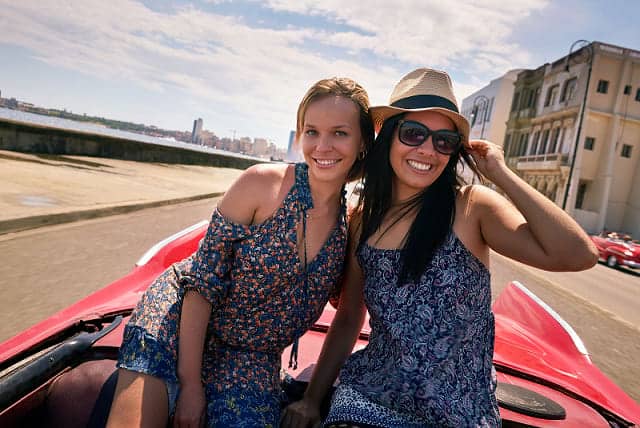
1. Travel in the dry season (November to April)
Although the beaches in Cuba remain absolutely beautiful at any time of the year, the rainy season in Cuba (May to October) can bring hotter and more humid weather. The tail end of the rainy season is also well-known for hurricanes and lots of mosquitoes!
Therefore, if the weather is a big priority for you, the best time to go to Cuba is the dry season.
2. Get the Cuban Tourist Card
Travelers from most countries will need a Cuba Tourist Card or Cuba Visa to enter the country.
Cuban Tourist Cards come in two colors: pink and green. If you travel directly from the U.S. to Cuba, you’ll need a pink Cuban Tourist Card. Otherwise, get a green Tourist Card.
You can get the Cuban Tourist Card online (through sites like EasyTouristCard) , from your airline or travel agency, or at your country’s Cuban Embassy. Technically, you can also buy the Tourist Card at Cuban airports for about 25 USD, but the reality is that you can’t even board your flight if you don’t have it.
3. Get travel health insurance
Travel health insurance is an entry requirement for Cuba , so you can’t skip it. Visitors to Cuba are required to have travel insurance to cover medical expenses on the island. Companies like Insubuy offer travel health insurance for Cuba starting at 8 USD per week per person.
Before you land in Cuba, review the medical portions of your insurance plan, so you know exactly what situations you’re covered for during your trip. If an emergency strikes, the last thing you want to do is have to shuffle through your insurance paperwork.
4. Bring the essential packing list for Cuba. Packing tips for Cuba
There are certain things you don’t want to travel to Cuba without.
With Cuba’s rationed economy, supplies are limited on the island. So, you may be unable to pick up some of your travel necessities if you forget to pack them in your bag. Double check this list to make sure your bags are ready to go before you board your flight!
- First aid kit
- Hand sanitizer
- Convenience kit
- Water bottle with filter
- Microfiber towels
- Mosquito repellent
- Portable charger
- Pin adapter (for Europeans)
- Travel guide
- Spanish-English phrasebook
For a full rundown of what you need to bring to Cuba, check out our ultimate packing guide for Cuba .
5. Bring appropriate clothes to Cuba. Dressing tips for Cuba
Dressing for Cuba will vary based on your style. Still, two things to consider are the weather and the kinds of activities you’d like to do while in Cuba.
Cuba has two seasons: the wet season (May – October) and the dry season (November – April). The wet season brings lots of rain, humidity, and high temperatures, so dress accordingly!
Here are recommended clothes for the hot, humid weather in Cuba:
For a woman traveling to Cuba:
- Light summer dresses
- Walking sandals
For male travelers to Cuba:
6. Rent your car in advance
If you stay a few days in a city, you won’t want to get into the hassle of renting a car in Cuba . Believe me, it can be complicated.
However, if you want to rent a car to visit all the fantastic places on the island, you better do it in advance. Car inventory is always limited, fleet management is inefficient, and the service is terrible. This is especially true during peak season.
Therefore, at least three months in advance, rent your car from online travel agencies like Cuba Travel Network , or Holiplus .
7. Fill out the health and customs forms online
Instead of borrowing pens, filing out annoying forms, and wasting your precious time in the airport, sign up for D’Viajeros .
D’Viajeros is the official website of the Cuban Customs, where you can complete all the required documentation to enter Cuba. Then, just print the documents and bring them with you.
8. Brace for arrival
There are a few things that you need to know about airports in Cuba:
- They are pretty disorganized: long lines, poorly-maintained bathrooms, and hot!
- There are certain items that you cannot take through customs. Check the Cuban Customs website for more details.
- If you want to exchange your home currency for Cuban Pesos (CUP) at the airport, prepare for a long line.
- Don’t count on ATMs! There are a few, but they are not reliable.
- You can connect to WiFi at 25 CUP/hour.
- Outside the airport, you can hire state or private taxis for transfers to the city. There are also car rental offices in most Cuban airports.
To learn more about arriving at Cuban airports, read our guide to Havana Airport .
Cuban currency tips
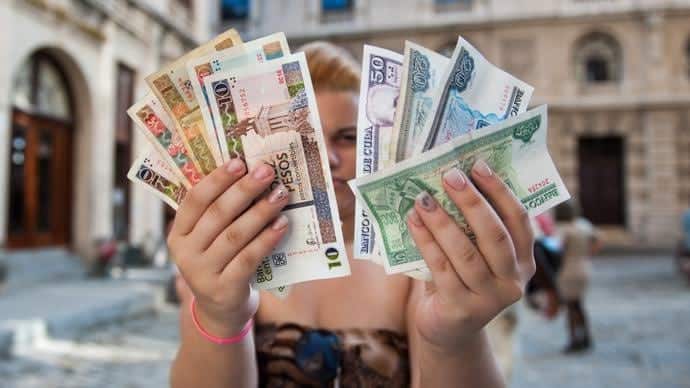
9. Understand the Cuban currency
Two official Cuban currencies circulated on the island until January 2021: the CUC (Cuban Convertible Peso) and the CUP (Cuban Peso). Contrary to what many outdated articles say, you can no longer use the CUC in Cuba! You must use the CUP instead (also known as “moneda nacional” or MN), which is accepted at most facilities and tourist attractions.
However, you must consider that all-inclusive hotels and some resorts won’t accept cash for non-covered services or products. They will still charge you in Cuban Pesos, but you must pay with your credit card and assume the currency conversion fees.
The CUP is available in bills of 1, 3, 5, 10, 20, 50, 100, 200, 500, and 1000. You should always have bills in lower denominations to pay for:
- Street vendors and food stalls
- Bus tickets
- Purchases at a flea market
- Purchases made at small local bodegas and convenience marts
Remember that the US dollar and other foreign currencies are not accepted at state facilities such as hotels, airports, and restaurants. You will have to use CUP to pay for products and services from these state facilities. However, most private businesses in Cuba welcome hard currencies.
You can exchange your currency for CUP at state currency exchange offices (CADECA) , airports, banks, hotels, and resorts.
For more Cuba travel tips related to Cuba’s currency system, check out this Ultimate Guide for Travelers .
10. Bring cash to Cuba, a lot
You can pay for all things in Cuba in cash. In fact, just a few businesses accept credit and debit cards, so you should always carry cash.
Due to US restrictions, credit cards issued by U.S. banks are not accepted in Cuba.
If you need to re-stock up on cash during your visit, Cuba has about 780 ATMs. They are mostly located in larger cities like Havana , Matanzas (Varadero), Santiago de Cuba, and Holguin. Again, credit cards issued by American banks won’t work.
11. Don’t count on bringing Cuban Pesos
The Cuban Peso (CUP) is the official currency in Cuba. You can’t get it in advance! And if you do, you can import only 2,000 CUP, which is like 80 USD. It’s better to wait until you land on the island to exchange.
12. Bring Euros if you can, but USD dollars are fine
If it’s not a hassle for you, bring Euros to Cuba. Euros have one of the highest exchange rates in Cuba and are widely accepted. They also incur the lowest exchange rate fee of 2%.
You can also bring US dollars and sell them to CADECA or in the informal market. Just consider that US dollars may not be accepted at some state-owned facilities in Cuba, and they will incur the highest exchange fee (8%).
How much money to bring to Cuba?

13. Calculate the approximate daily budget
Cuba can be quite affordable if you plan correctly.
Before you arrive in the country, you should get a feel for major expenses like accommodations, transportation, and food & drink costs. Here are the most common expenses to incur on a trip to Cuba:
- Accommodation costs: “casas particulares” cost between 20-50 USD/night. Hotels and resorts cost anywhere between 100-500 USD/night.
- Transportation costs: private taxis cost around 1.50-3 USD/kilometer. The Viazul bus ticket costs anywhere from 6 USD to 51 USD, depending on your interprovincial route. Renting a car will cost around 85 USD/day.
- Food and drink costs: Vary quite a bit! Breakfast at your casa can cost anywhere between 5-12 USD, while a sit-down restaurant meal can range from 10-30 USD.
- Entertainment costs: A tour of Havana in a classic car costs around 50 USD. Tickets to a baseball game cost 3 USD/each. Some museums are free, and others can cost up to 10 USD.
For a full breakdown of a realistic daily budget, check out our guide on the trip to Cuba cost .
14. Tipping in Cuba: who and how
Like many destinations throughout the Caribbean, tipping is common and even encouraged in Cuba .
Popular tippling locations include hotels, resorts, restaurants, guided tours, taxis, and spas. Anytime someone provides a service for you, like cleaning your room, waiting for your table, or transporting you in a taxi, you should strongly consider offering a tip to that person–especially if they do an outstanding job!
We recommend at least 1-3 USD for maids, porters, receptionists, street musicians, and taxi drivers. Local guides generally expect 5-10 USD, while 10% of the bill is the gratuity standard at restaurants in Cuba.
Money-saving tips for Cuba
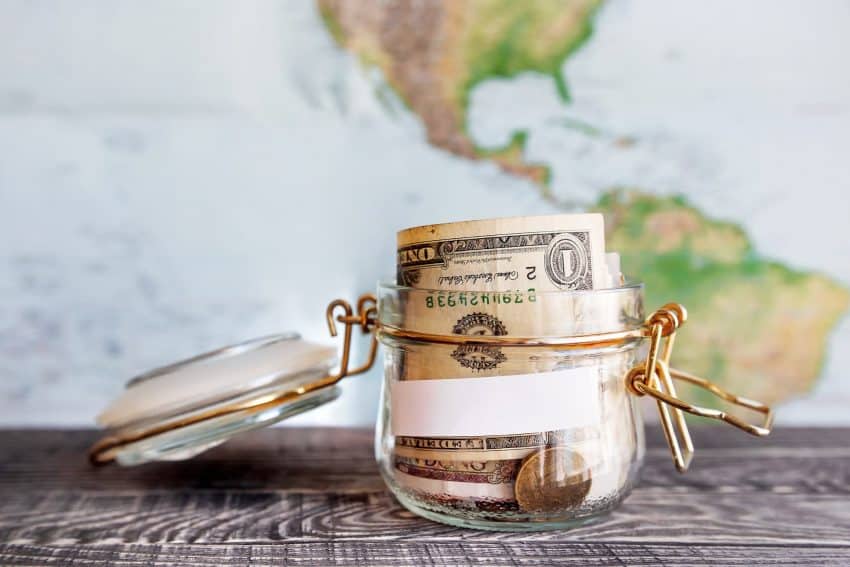
15. Stay in casas particulares (private accommodations)
This is a piece of Cuba travel advice you shouldn’t ignore!
Casas particulares are popular and highly authentic places to stay during your Cuba trip. A casa particular is similar to a bed-and-breakfast. Usually, it costs between 20-50 USD per night, making them much more affordable than resorts on the island. Check out availabilities!
For more on this, read our 13 tips to booking an Airbnb in Cuba .
Bonus tip: Be aware! You may be tempted to save money by staying at someone’s place for free. It’s illegal! Avoid trouble with the law and overpriced hotels by staying at a homey casa particular instead.
16. Book flights to Cuba with a flights search engine
Direct flights to Cuba–especially from the United States–are limited, and many airlines don’t fly to Cuba.
To book a flight to Cuba, it’s easiest to see ticket options from multiple airlines. You can check out a flight search engine like Skyscanner that covers flights to Cuba.
17. Eat at paladares (private restaurants)
Cuba has a growing restaurant scene where you can find everything from gourmet meals to comfort food.
Paladares are private restaurants typically owned by families. Paladares are an excellent way to get authentic Cuban food at an affordable price.
Cuba travel guides like this one from Lonely Planet often have lists of paladares you can choose from. It also includes culinary facts about Cuba and advice for its best restaurants.
18. Share urban taxis in Cuba
Cuba’s taxis are a convenient and authentic way to get around the cities, especially if you are on a backpacking adventure . Plus, Cuba’s almendrones (classic American cars) are world-famous and unique to the island.
Although it may be a little uncomfortable, sharing an urban taxi for short rides is a cheap and authentic way to experience Cuban.
19. Book the tours to Cuba before you leave
Guided tours offer an unparalleled, authentic experience of Cuba.
From walking tours of history-rich cities like Havana to hiking or horseback riding in the stunning countryside, an experienced guide can show you parts of Cuba that you’d miss out on if you traveled solo.
Tours can book up fast, so plan the itinerary and book your tour in advance . Plus, tour guides are experts in Cuban traditions and culture , so they’ll have tons of more helpful Cuba travel tips!
Cuba Travel Restrictions During COVID-19
20. no need to bring proof of covid-19 vaccination or a negative pcr test.
As of April 4th, 2022, you are not required to present proof of vaccination against COVID-19 or a negative PCR test at arrival. For a full rundown of COVID-related restrictions, check our guide to the current set of Cuba travel restrictions .
21. Fill out the Sanitary Statement for Travelers
If you didn’t complete the online documentation with D’Viajeros, as explained earlier, you would need to fill out the Sanitary Statement for Travelers ( Declaración de Sanidad del Viajero ), a sort of health declaration form. You will be asked to complete the form before checking in for your flight to Cuba or during the flight.
22. There are restrictions on facilities, attractions, and mobility
Like any other country struck by the COVID-19 pandemic, Cuba has imposed tight internal restrictions that may affect your stay on the island, specifically:
- Social distancing (5 ft) and face masks may be required at some establishments.
- You may be subject to contact tracing or random temperature checks.
- There is limited capacity and operating hours at most tourist facilities.
- Large gatherings are not allowed.
- Travel within and between cities and provinces may be restricted.
23. Avoid the fines for non-compliance
You read that right. You may be fined and even prosecuted if you violate the above measures. However, honestly, that would be very rare for international travelers.
Tips to avoid getting sick in Cuba
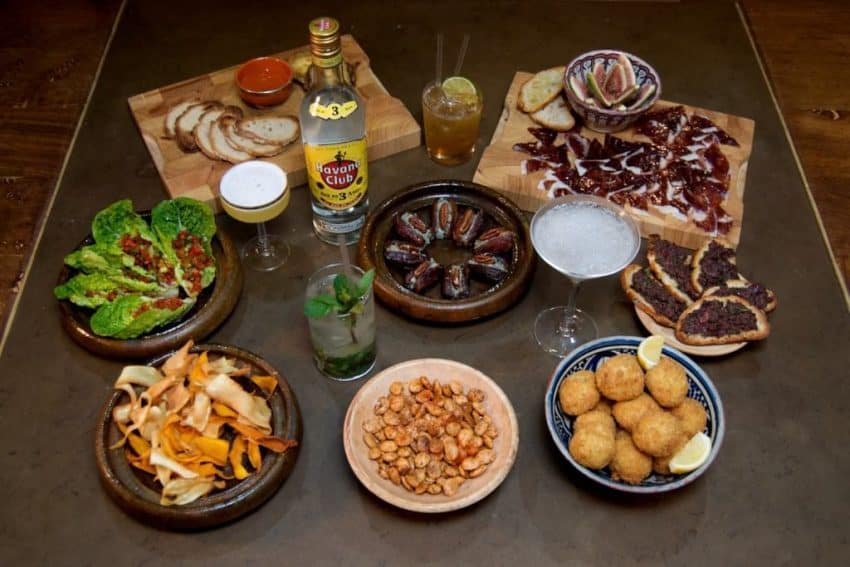
24. Bring your medications
Cuba’s physicians have a good worldwide reputation. However, you should still be prepared for minor illnesses or injuries that don’t necessarily warrant a hospital visit.
Pack an all-purpose First Aid kit with all the necessities like bandages, aspirin, and bismuth.
25. Don’t drink tap water in Cuba
We don’t recommend drinking tap water in Cuba!
Cuba’s water supply is home to its unique bacteria and microorganisms. The bacteria itself isn’t dangerous per se, but your body isn’t used to it, and it can make you very ill. Nausea, cramps, upset stomach, and other gastrointestinal issues that could wreck your trip are common.
Using water bottles with built-in filters is an easy way to keep your water clean and safe to drink during your stay.
26. Don’t buy street food
Cuba is home to delicious local food, but buying food from a street stall or vendor can make you sick. Street stalls are simple set-ups and don’t have the luxury of refrigeration and sanitation that restaurants have.
If you fancy yourself a dare-devil and indulge in street food anyway, you should be extremely careful about what kind of fish you eat. Certain local fish from Cuba’s southern shore can be poisonous ( siguato ) because they eat toxic sea vegetation.
27. Eat at the recommended restaurants in Cuba
Since food from street vendors can be iffy, you should instead eat at one of Cuba’s many private restaurants, referred to on the island as paladares .
Cuba travel guides like this one from Lonely Planet often have lists of paladares you can choose from. It also offers tons of Cuba travel tips for getting the best of Cuba’s culinary scene.
28. Take basic food safety precautions
You can avoid many potential illnesses in Cuba by exercising basic safety precautions regarding food, sanitation, and hygiene.
For example, washing your hands before meals will help eliminate harmful bacteria. When it comes to food, you should avoid eating anything raw or undercooked and forgo consuming unpasteurized dairy products. Washing and peeling your fruits and veggies also helps eliminate harmful germs.
29. Protect against mosquitoes in Cuba
You’ve probably heard of Zika or Dengue outbreaks in the media.
Cuba is a humid, tropical island home to lots and lots of mosquitoes –bugs are just one of those unfortunate facts about Cuba . And since Cuba is warm all year round, mosquitoes will be around no matter what time of year you visit.
The International Association of Medical Assistance to Travellers (IAMAT) recommends “taking meticulous anti-mosquito bite measures during the daytime. Pregnant travelers should seek counseling from a travel medicine practitioner and consider postponing travel to this country.”
Bring a potent insect repellant to keep away mosquitoes during your trip!
30. Write down the hospitals and physicians available
If you find yourself sick or injured in Cuba, you don’t want to be left scared and helpless because you don’t know who to turn to for help.
Did you know that the U.S. State Department put together a list of hospitals and physicians for all of Cuba’s major cities? Bookmark the list so you can use it as a quick reference if you or one of your travel companions needs medical attention.
Travel safety tips for Cuba
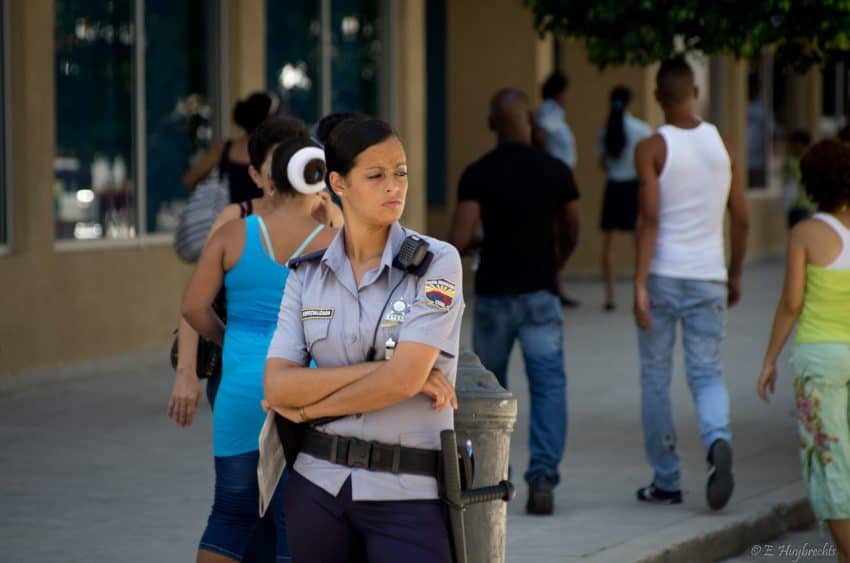
31. Get the emergency numbers
We don’t like to think about getting into emergencies while traveling, but the truth is, they can happen anytime. Write down these important phone numbers just in case of an emergency.
- Police: 106
- Fire Department: 105
- U.S. Embassy in Cuba: +53 7839-4100
- For Canadians traveling to Cuba , Canadian Embassy in Cuba: +53 7204-2516
32. Don’t exchange money with street vendors
Visitors to Cuba sometimes fall prey to currency scams. You should always exchange currencies at a legitimate location. CADECAs are located at hotels, airports, and banks.
Avoid exchanging money through informal means like street vendors. You might get the wrong amount of cashback or counterfeit money.
33. Don’t carry too much cash on you
It’s smart to carry cash on you while in Cuba, but it’s not smart to carry too much all at once. The more cash you have in your pocket, the more you could lose if you are pickpocketed.
Instead, carry what you need for the day and leave the rest in a safe place back in your room.
34. Avoid pickpockets
Cuba is one of the safest countries in the Caribbean to visit, but petty theft is commonplace. This is especially true in major tourist areas where thieves seek “easy” targets.
The best way to deter pickpockets and protect your valuables is with a money belt like this one from Peak Gear . A money belt is subtle, secure, and lightweight, so you can always keep your valuables hidden and close to you.
35. Don’t go to impoverished neighborhoods
Like any other country you visit, some parts of Cuba are safer than others.
Poor neighborhoods, especially in large cities like Havana, could be dangerous to tourists due to muggers and robbers. In Havana, certain neighborhoods in Centro Habana, Marianao, and Guanabacoa are especially dangerous. You should only consider going if you have a knowledgeable, trustworthy local friend.
If it helps, you should consider carrying a travel whistle like this NOOPEL Emergency Whistle.
36. Don’t show off
There’s something about vacation that sometimes makes people want to show off, but Cuba is not the place to do that.
Showing off symbols of wealth or status like luxury clothes, bags, watches, or expensive electronic devices, can attract the wrong kind of attention and mark you as a target for thieves or muggers.
Instead, keep your valuables home and bring only what’s practical and comfortable for your trip.
37. Hire only professional Cuban guides
Cuba is full of guides willing to take you on tours of the cities and beyond, but only some of them are legitimate.
Instead of hiring someone on the street, stick to reputable guides. Hiring the wrong guide can be a waste of money and potentially dangerous.
38. Lock your luggage
Locking your luggage can make the difference between keeping your stuff safe while traveling and having it stolen.
Although Cuba is a safe country to visit, it’s not unheard of for things to go missing from unattended bags. Keep your things safe with a TSA lock like this one .
39. Use your common sense
Cuba is a safe country with relatively low crime rates. That said, you should exercise common sense when traveling throughout the country to protect yourself from trouble.
Avoid walking alone at night, and don’t invite strangers back to your room. These are just a few Cuba safety tips you can learn from the Ultimate Guide to Stay Safe in Cuba .
Transportation tips for Cuba
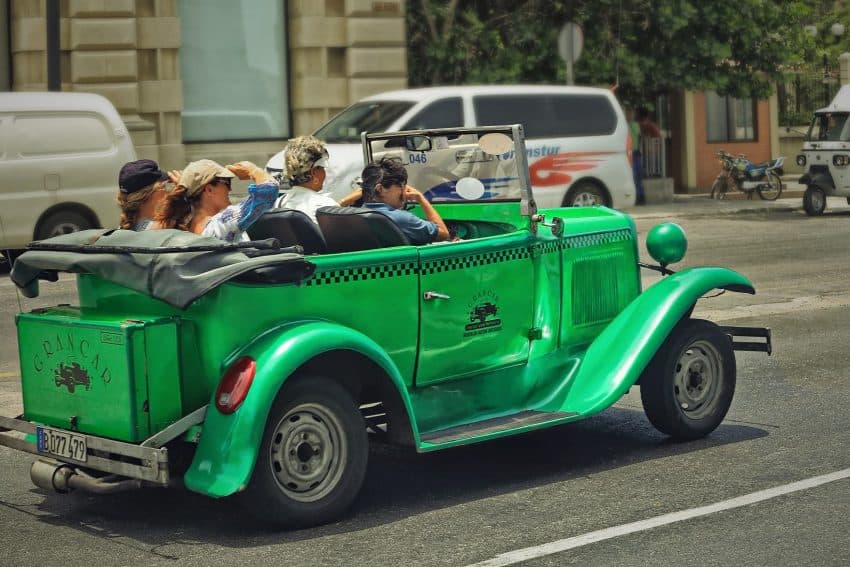
40. Plan your local transportation in advance
Cuba has a variety of transportation options for getting around the island. Your choice will depend on your budget and the distance you want to travel.
Taxis (state taxis or almendrones) are the most affordable option for getting around within a city or between two nearby cities. You can rent a car, but be aware that daily fees are pricey and road conditions in Cuba mean they’re not always safe to drive on.
For longer trips between cities or other parts of the island, you can take the Viazul bus . If your trip is longer than you’re comfortable traveling by bus, you can skip the Viazul and book a domestic flight across the island.
41. Get a street map of Cuba
You’ll probably spend a lot of time traveling on foot. With Cuba’s year-round warm weather and the beautiful old architecture of its cities, you’d be missing out if you didn’t hit the pavement.
For getting around Cuba on foot, a paper street map will be your best friend. Internet access in Cuba is spotty, so don’t assume you’ll have access to Google Maps or Apple Maps on your phone.
How to get Internet access in Cuba?
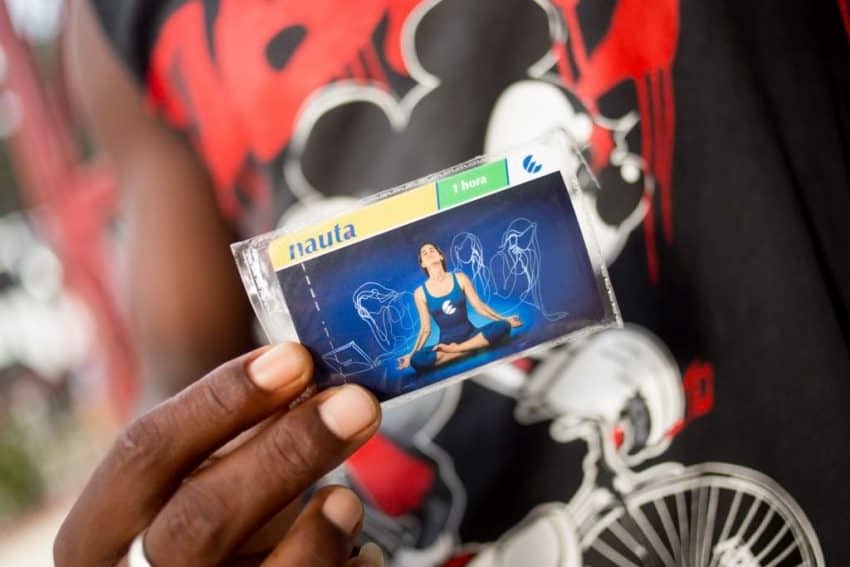
42. Don’t expect easy Internet access in Cuba
Cuba does have internet, but access is limited, and service isn’t available everywhere. The only Internet provider in Cuba is Empresa de Telecomunicaciones de Cuba (ETECSA). The best spots to find reliable internet access are hotels, airports, and public hotspots in the biggest cities.
Once you get connected, don’t expect lightning-fast speeds. Bandwidth is limited, so you should be fine making basic web searches and sending emails, but don’t expect to stream music and videos.
To know more about getting access to the Internet in Cuba, check out our detailed guide to get Internet in Cuba for tourists .
43. Know your options
You’ve got some options for connecting to the Web in Cuba.
A. Buy a NAUTA card
You can purchase a NAUTA card at ETECSA offices, but be prepared to wait in a long line. Travelers have reported that the lines in Havana can take up to two hours!
Some hotels also sell NAUTA cards, so you may be able to skip the trip to the local ETECSA center. A 5-hour card costs 125 CUP, and a one-hour card costs 25 CUP. Note: bring your passport! You’ll need it to buy the card. Also, if you buy the card at ETECSA, you must pay in CUP.
While we don’t recommend this option, you can also purchase an internet access card on the black market. If you go this route, expect to pay an extremely inflated price!
Once you have your NAUTA card in hand, you can connect to the web at any of these places:
- Public wifi hotspots. Here is a list of all the WiFi hotspots in Cuba .
- Hotels and resorts
- Salas de Navegación: d esktop computers at ETECSA offices .
B. Hotel and resorts that offer free Internet
Some upscale hotels and resorts offer free WiFi and desktop computers with internet access. In this case, you don’t need a NAUTA card.
However, this isn’t a universal commodity for all hotels in Cuba. You’ll want to research the hotel beforehand if this is your choice. A site like Skyscanner lists many of the services and features each hotel has to offer.
C. Ask your host to share Nauta Hogar
Nauta Hogar offers Cuban homeowners WiFi access in their homes and public hotspots. They need to pay a monthly subscription, which is not free and very limited.
For a price, your host may be willing to share their username and password with you. With access to a Nauta Hogar account, you can connect in your room, public hotspots, and airports!
D. Get the Cubacel Tur SIM Card
The Cubacel Tur SIM Card is a temporary phone line for tourists that ETECSA offers. It lasts for 30 days. The minimum package starts at 25 USD, including 2.5 GB of data, 20 minutes of international and national calls, and 20 SMS.
You can get the Cubacel Tur SIM Card in advance from ETECSA’s authorized providers , or buy it once you land in Cuba at any of ETECSA’s offices.
E. Rent a SIM card from your host
Some casa owners may be able to rent you a SIM card with Internet access for a price.
F. Buy or rent a SIM card online
A few online companies also offer Cuba SIM cards you can purchase ahead of your trip. Cellomobile and OneSimCard are popular companies that allow you to purchase or rent a SIM card for Cuba.
Cellomobile prices: Incoming calls $2.19/minute; outgoing calls $2.19/minute; free incoming SMS text messages; outgoing SMS messages $0.49/each.
OneSimCard prices: Incoming calls $0.65/minute; outgoing calls $1.25/minute; free incoming SMS text messages.
G. International roaming
Some major cell carriers like AT&T offer roaming coverage in Cuba. You can get an idea of what calls, texts, and data in Cuba cost by checking out the plan here .
T-Mobile’s Global Plus 15GB Plan also covers cell service in Cuba. Verizon and Sprint also have coverage but no roaming packages for Cuba.
AT&T prices: $3.00/minute for calls; $0.50/text; $2.05/MB for data
T-Mobile prices: $2.00/minute for calls; $0.50/text; $2.00/MB for data
Cuba travel tips for dealing with the ugly
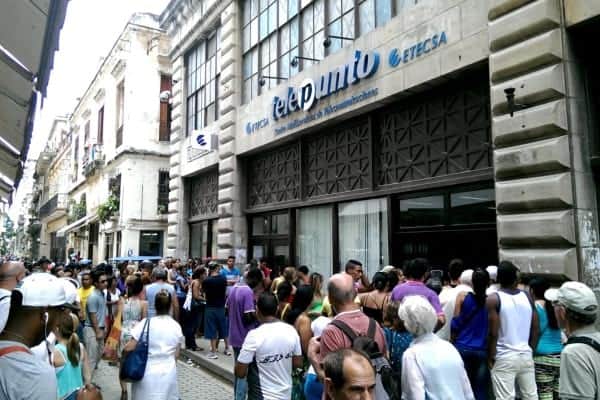
44. Be prepared for the long lines
Many goods and services on the island are still rationed and distributed via the state bureaucracy. Be prepared to wait in line at the bus stop, bodegas, banks, and cultural attractions like museums.
45. Many bathrooms are paperless
If you’ve spent a lot of time in North America or Europe, you probably take toilet paper for granted.
Many bathrooms in Cuba don’t have toilet paper or have toilet paper outside the stall near the washing basin. If you find toilet paper, there’s a chance it will be low-quality.
Instead of finding yourself S.O.L., you may prefer to bring a small supply of your own or a packet of travel kleenex when you’re out in town.
46. Don’t expect the entire menu to be available
Cuban restaurants are often working with limited ingredients depending on what’s available. This is mostly because the Cuban government still controls the availability of meat, vegetables, and other ingredients. This can impact the availability of certain meals and dishes on the menu.
47. Don’t expect high-quality service everywhere
Cuba is undergoing many changes, many of which you’ll notice during your stay on the island.
One of the most noticeable signs is the difference in the quality of service you’ll experience. While there are many outstanding businesses, restaurants, and hotels in Cuba, others may not meet what you’re used to experiencing in your home country.
48. Catcalling is common
Lady travelers to Cuba should know that catcalling (called piropo in Spanish) is common. Expect to hear lots of compliments like guapa , linda , and chula .
This is more likely to happen if you’re traveling as a solo female than in a group with males. Keep in mind that as annoying as the practice is, catcalling is typically harmless behavior and doesn’t lead to harassment or violence.
Respect and support the locals
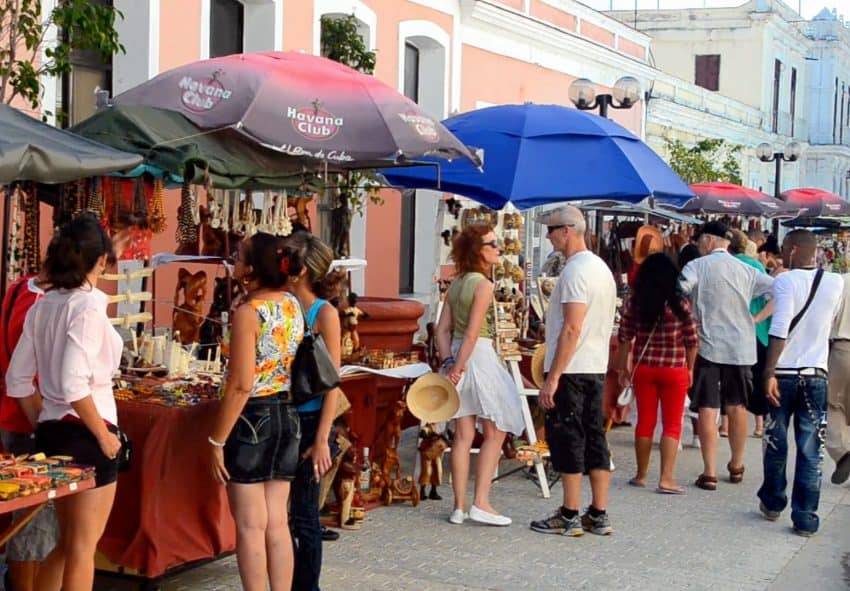
49. Learn some Spanish
Although some Cubans have conversational skills in foreign languages like English, it’s best to learn some Spanish to communicate in the local language.
Pack a Spanish-English phrasebook like this one that specializes in the Cuban dialect.
50. Avoid talking about politics
Politics is a passionate and complicated subject in Cuba. We recommend steering clear from politics while chatting with your new Cuban friends to keep the conversation light-hearted and pleasant.
51. Support Cuban local businesses
If you’re an American visitor traveling to Cuba under the Support for the Cuban People travel category , you’ll need to show that you’re supporting the Cuban people during your visit. Regardless of your travel designation, supporting local businesses is just a good thing to do!
A few popular ways visitors can support Cuban businesses include: staying in a casa particular; eat at paladares ; taking a dance class; and supporting local artists and musicians by attending their shows or purchasing their hand-crafted goods.
Airport tips
52. don’t bring huge amounts of cups to the airport.
CADECA offices in Cuban airports are no longer selling foreign currencies. Carefully plan your trip to Cuba budget , and don’t count on exchanging your leftover Cuban pesos back for your home currency.
If you end up with huge cash in CUP, exchange them in your hotel or at any CADECA office in the city. Don’t bring your leftover cash to the airport!
53. You can use mixed currencies in Cuban airports
Before the security check, you can spend only Cuban pesos. Past the security checkpoint, everything is in foreign currency only, but the change is in Cuban pesos!
Crazy, right? Well, don’t ask me!
Additional Cuba travel tips for Americans
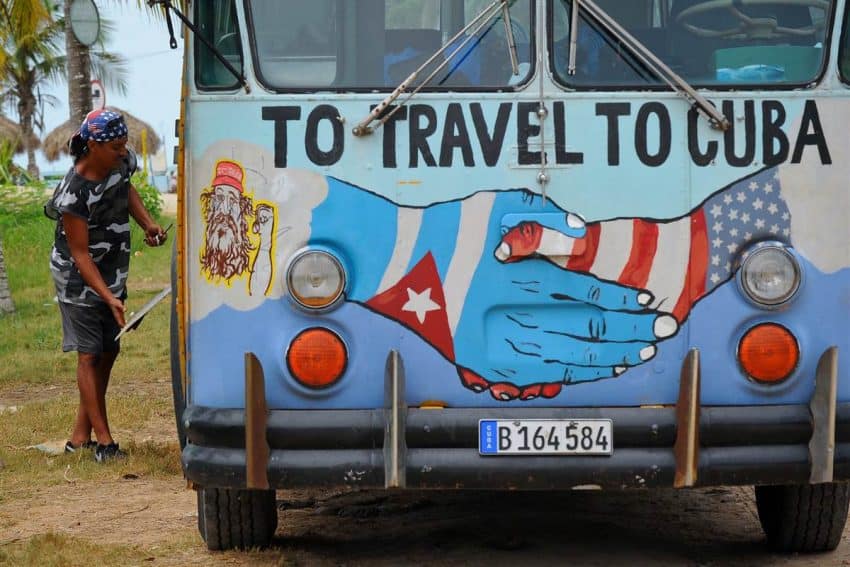
54. Make sure that your travel category covers your itinerary
Relations between the U.S. and Cuba have thawed significantly over the past decade. However, technically Americans traveling to Cuba for tourism is still illegal.
That said, you can still travel to Cuba from the US , and in fact, many Americans still visit Cuba each year. Among other things, you must declare your travels under one of twelve categories authorized by the U.S. Department of Treasury .
55. Don’t stay at the prohibited accommodations
Remember that you must not stay at any accommodation listed in the Cuba Prohibited Accommodations List . The list even includes some casas particulares !
56. Don’t spend money at restricted businesses
This is a heads-up for all American visitors to Cuba.
Due to lingering restrictions between the two countries, American visitors can’t spend money at Cuban businesses forbidden by the U.S. Department of Treasury. Any business affiliated with the Cuban military or security services is off-limits. You can view the full list here .
57. Keep your records
When possible, keep records of your travels, including accommodations, transportation, food, and miscellaneous purchases.
American travelers may be asked to provide documentation of their Cuban travels upon returning to the U.S. While anecdotally, this seems pretty rare, you should be prepared just in case it happens to you!
58. Don’t plan to bring back rum and cigars
You read that right! You can’t import Cuban-origin alcohol and tobacco products into the US , not even from third-party countries.
Buen viaje !
If this list had a #59, that’s what it would be! Armed with all the things you need to know before traveling to Cuba, you’ll be more prepared than ever for your trip. Now comes the fun part–packing and getting ready for your flight. Cuba awaits!
Have you been to Cuba before? Share your most helpful Cuba travel tips and advice in the comments below!
Share Article:
About the Author
Tour republic.
Tour Republic is a marketplace where you can discover, book, and review the very best experiences Cuba has to offer. We are a team of tourism professionals and journalists who have partnered with Cuban entrepreneurs to provide travel experiences that can transform your trip into a life-changing adventure. We also share our profound love for Cuba through in-depth travel guides, myth-busting articles, and captivating narratives. Whether you want to explore Cuba's wonders or understand its intricacies, our blog posts are your gateway to the heart of this extraordinary country.
Leave a Reply Cancel reply
33 comments.
What is the current travel advice? Am planning to visit this December ’23, but am reading about critical shortages and rationing of fuel and possibility of getting stranded travelling through the country. What is the best way to stay up to date with the current situation?
Can you take your own fishing Equipment with you and fish on the beach
Ladies carry toilet paper/tissue. Bathrooms are very clean but rarely provide it. Also be prepared to leave a tip.. 50-200cup to help out.
hey thee – I just got back from 8 days in Cuba. ONE AND DONE FOR ME. Supposed 4-star hotels on Expedia or other services would be below a Motel 6 standard here. Think road side rural Alabama cleanliness. If you want good Cuban food go to Miami. Chicken is malnourished, beef is like chewing on your shoe sole and most of the lobster was chewing on rubber bands.
Everything I’ve read is that 2 main items you cannot bring back to the states are Rum and Cigars. Guess what – it’s ALL tobacco and ALL alcohol. Going through Customs last night in Tampa the agent asked me if I had any fresh fruit, vegetables, food, tobacco or alcohol. I said I had 2 cans of beer.
I got pulled into a room, was given 3 sheets of paper to fill out. Name, address, passport number, SSN, email and phone. A different agent then went through my bag and asked me if I had permission to enter Cuba. I said yes, I finished all the paperwork. He said no – from the US DOJ? I said no….I spoke with the airline and they told me all I needed was a tourist card – same as this website. He said NOOOO. You need to get a license to travel from the USA to Cuba and that I can be fined up to $250,000 for not having the correct approvals and potentially I could have federal agents knock on my door.
Info here is partially correct but more and better research.
Hi RR, Thanks for sharing your experience! In most cases, you do not need an actual “license” or authorization to go to Cuba. The only two travel categories that need authorization from OFAC are “Professional research and professional meetings” and “Public performances, clinics, workshops, athletic and other competitions, and exhibitions”. If you travel under any of those categories, then yes, you need a permit from OFAC. Otherwise, there is no legal paperwork required. Everything is explained here .
Thank you for a great article. A bookmark for sure! I travel April 11 to April 20 to meet family for the second and first times! I’ve only met my Aunt in the US. First timer.
Question – thanks for the list of prohibited resorts. Are any allowed? I’d like to treat them to a vacation Seems like it would be harder for me to get access than them… Advise if possible? TIA
Great information tips , Thank you . I have a french passport and a valid Esta visa . Can I Fly from Miami Cuba and enter back to USA with the same ESTA visa .
Hi Joseph, Unfortunately, it appears that you will need to apply for a visa to re-enter the United States. Read more here .
Wow I love this article, so very helpful.. When you say Americans, it’s inclusive only of US Passport holders right? I’m Canadian and hold a Canadian passport, not sure if we also fall on some prohibitions that you had listed in this article? thank you
Hi Nicole, That’s right. US citizens are subject to tougher travel restrictions to Cuba. If you are traveling from Canada, check out our Cuba travel guide for Canadians .
Thanks for a helpful article. As this was updated early 2022…wondering if any insight to bringing back rum or cigars to US? The article link is from 2020. Thanks
Hi Rosalba, You still can’t bring Cuban cigars and rum back to the US.
Just came back from Cuba on 1/1/2023. Most points in the article is right. 1) USD is accepted everywhere cash is accepted. Rate 120-170 CUP to $1. 1 euro = 1 USD. Bring lots of cash (no way for Americans to get money in Cuba!!!). Exchange at a restaurant and you get the good rate. 2) most large stores do not accept cash, only non-US visa/ Mastercard. 2) Get the local SIM (1 year), 1000 CUP ($8.5) for new SIM and 3.5GB data. Add 500 CUP get you total 10.5GB data, should be enough for the trip. Do not buy the wifi card.3) book casa particular through Airbnb, paid in the US before going. Same for Viazul bus. 4) use your casa host to hire taxis or tours.
Hello, I was told Cuba was a very poor country and that bringing gifts such as toothpaste or headwear like caps, even kitchen tools are highly appreciated by the cooks and room service. Is this true?
Hi Nancy, Gitfs are welcome in Cuba. Please, read our guide to bringing gifts to Cuba . Thanks!
We’re going in next month mid-October and staying all inclusive in Valedaro – is there any tips for getting to Havana for the day? ideally we’d like to stay in a hotel for one night and have two days in Havana and then travel back
Thank you for this – and the related posts. GREAT detail, most helpful for trip-planning.
My daughter is travelling around Cuba at the moment (and loving it). But money (cash) has quickly become a serious issue. The official exchange rate at the bank is £1=26 pesos. The “unofficial” rate is £1=100 pesos – as apparently Cubans need foreign currency to be able to purchase certain items but cannot get hold of it officially themselves. She had planned on simply getting money from ATMs / banks but now realises that this will make everything four times as expensive. So the message is definitely pay for things in advance where you can and take as much cash with you as you think you will need. Don’t rely on local banks / ATMs. Euros and sterling in particular seem to be popular (I’m not sure about USD).
Those are great tips, Richard. Thanks for sharing! By the way, we wrote a whole guide to using money in Cuba here . Check it out!
Be sure to keep some local currency coins available at all times for public bathroom attendants. It is expected always!
Ohh dear!! – How can I experience the Wonders of Beautiful Cuba if it is this much trouble to get there (getting a pink Cuban tourist card) getting currency exchanged, finding a direct flight to Cuba from US, flights are limited, and many airlines don’t fly to Cuba?
Yes we want to “support the locals” and “local businesses” ….How, if its sooo difficult to get there?
What is wrong with the Cuban Government? Clearly they dont want tourists or our money??…. Poor Cubans – your great and detailed article has sort of soured our hopes to travel there??
Hi Mini, Yeah, Cuba is not your regular travel destination. It’s been challenging to get there since the beginning of the pandemic. However, the Cuban Government recently eased some travel restrictions, and the island is opening up for tourism again. To answer your answers: – Cuban Tourist Card: it’s not that complicated. Most of the time, airlines include it in the ticket price. For more, read our guide to the Cuban Tourist Card . – Cuban currency: definitely one of the most complex matters for travelers. You basically need to know that 1) you will need to use CUP (or “Moneda Nacional”) everywhere in Cuba; 2) US credit/debit cards are not accepted; 3) ATMs are scattered so bring some cash (Cuba is a cash country!); 4) tip in your home currency. Read our detailed article about the Cuban currency . – Flights from the US: actually, it’s the US Government who restricted flights to Cuba in 2019. The Cuban Government did limit flights due to the COVID-19 pandemic, but they are now allowing the usual number of regular flights. Hope this is helpful!
Good article. I haven’t been to Cuba in 21 years (sigh) Last time I was there, US dollars and baseballs were great tips. Much has changed in 21 years–my weight for one (LOL) Thanks for putting this together, As a Canadian I will be adding an extra layer of confusion by converting my tip money to Pounds. 1 Pound per night for Housekeeping? Or more?
Hi Dan, One Pound per night is enough. Thanks for your nice words!
This blog is really helpful. It is comprehensive, tackles all the essential travel in Cuba essentials, and it is very informative.
Hello. Can I bring into Cuba 83 CUC that is equal to almost 2000 CUP? I see on the customs website it says export of CUC in any amount is prohibited but says nothing about bringing in CUC? Can I exchange the CUC to CUP through official currency exchange or black market? Where do the locals exchange the CUC to CUP? Can I spend it at shops and then the shop owner exchange it? It must still have value until july? Thanks Paul
Hi Paul, Unfortunately, importing CUC into Cuba is also forbidden. Even you managed to get the CUCs into Cuba, it will be hard to get rid of them once you are in the country because almost no one wants CUCs anymore. You won’t be able to spend it at shops either because only Cuban residents enjoy the 6-months timeframe to exchange or spend the spare CUCs. Please, read our guide to the Cuban currency to understand the latest changes in the Cuban monetary system and how they impact you as a visitor.
Please be aware that as of 6 months ago there is no longer convertible pesos in cuba it is just pesos. ALSO FOR THOSE OF YOU WHO HAVE MEDICATIONS YOU NEED A DOCTOR NOTE SAYING THAT YOU ARE PRESCRIBED THIS TO BRING INTO CUBA ESPECIALLY PAIN MEDICATIONS AND HEART MEDICATIONS BLOOD PRESSURE ETC OR YOU WILL HAVE THE MILITARY AT THE AIRPORT SEIZING IT AS THEY TRIED WITH ME AND WIFE
Hi Tom, That is correct – as a traveler, you can no longer use CUC in Cuba. We are working on updating this article as we get more information about the reform of the Cuban monetary system. In the meantime, please read our updated guide to the Cuban currency , which covers the latest changes.
Hello all … I would like to send some money to my cuban friend during these hard times of The Covid19. He is not working because the hotel is closed however receives a bit of help from them. I sent 15cuc which was 25 CAD. Does 15cuc help?
Looking forward to all responses. TTFN 🙂
Hi Natalina,
Any help is appreciated, especially during this crisis. Please, learn more about the value of the Cuban currency and the exchange rate in our guide to the Cuban money .
Thanks for helping!
very helpful
You might also like

Cuban Currency: The Ultimate Guide for Travelers (2024 Update)
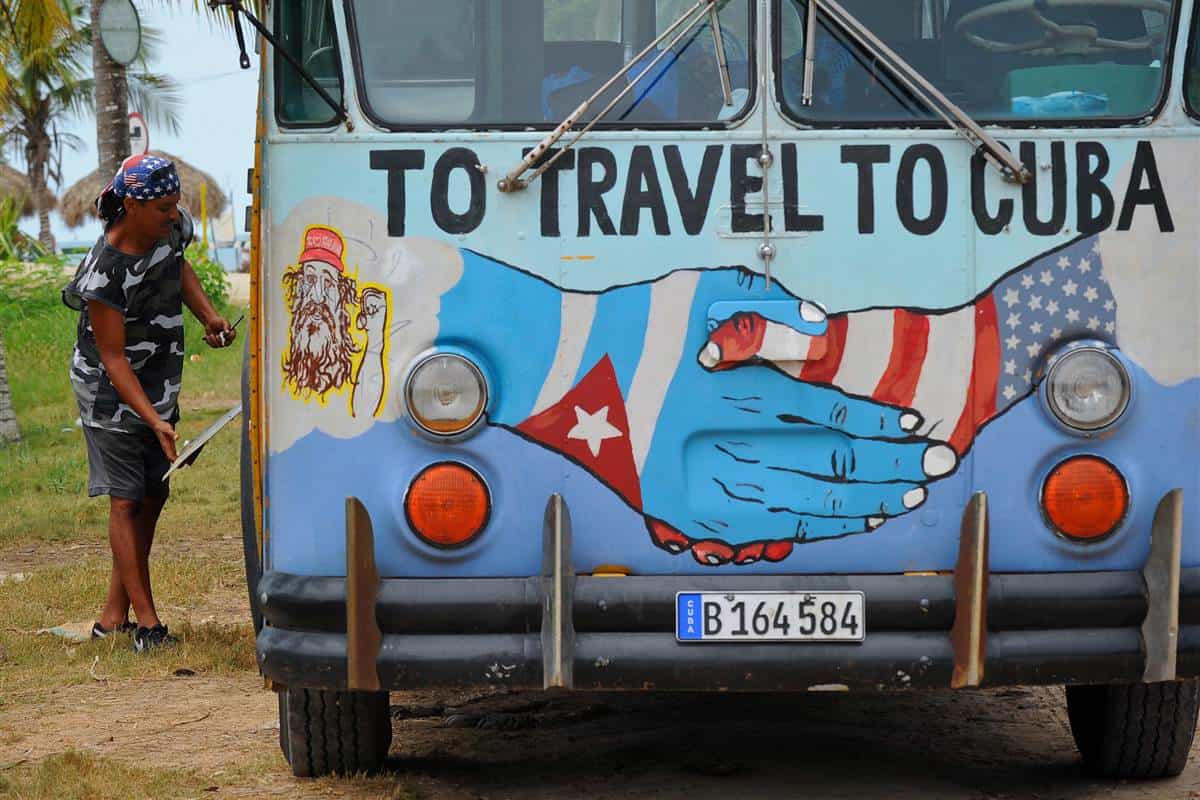
Beyond the Ban: A Guide to Americans Visiting Cuba in 2024.
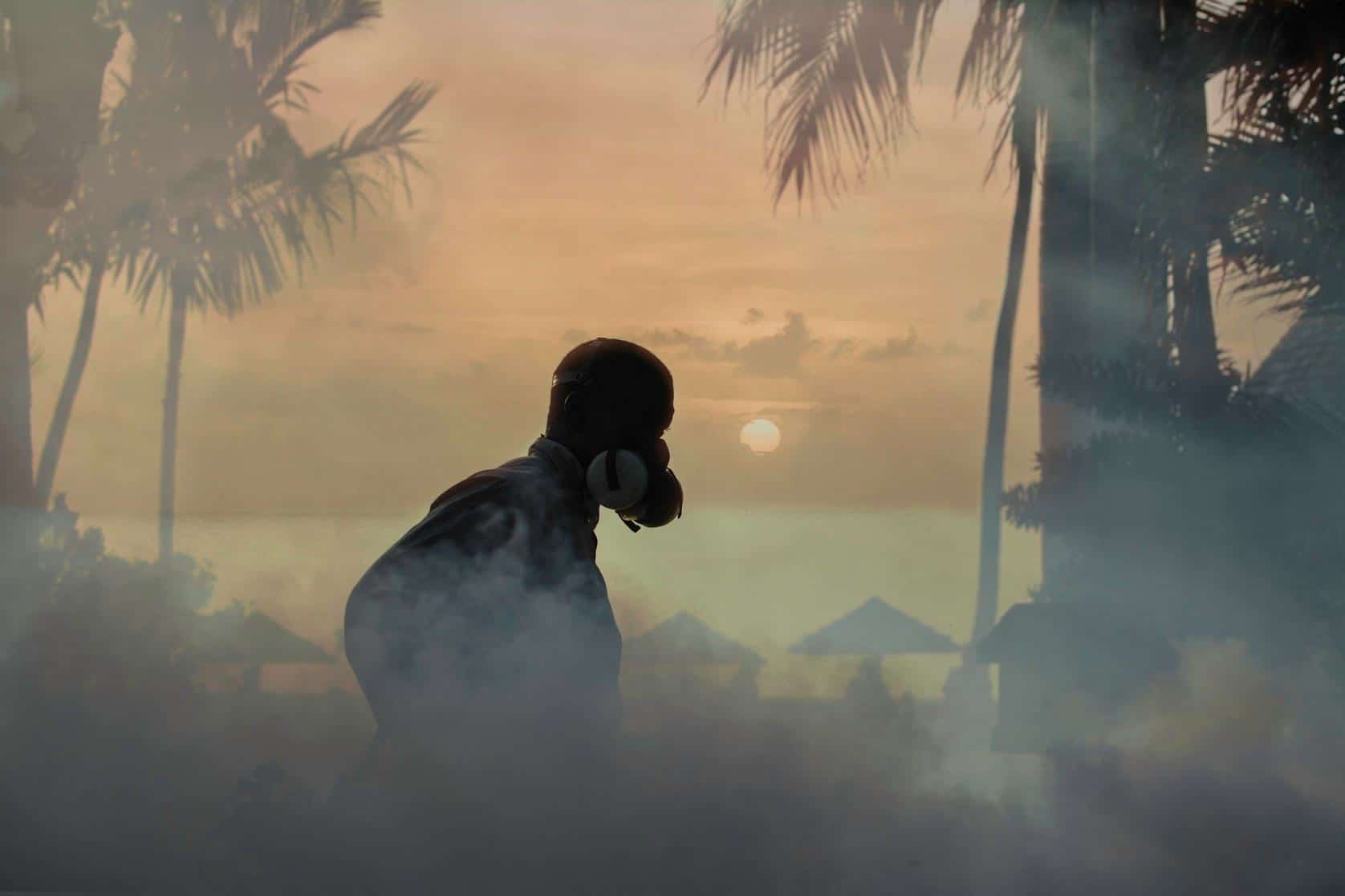
Sand Fleas and Mosquitoes in Cuba: The Survival Guide (2024)
Other stories, how much does a trip to cuba cost a realistic travel budget (2023), generation y: unusual cuban names.

16 BEST Things to do in Havana, Cuba [Travel Experts Blog]
Cuba is one of the most unique, interesting and challenging countries I have traveled solo to. Even with so many super interesting things to do in Havana, I was struggling to figure out basics like – language, directions, internet, food.. the list goes on.
That being said, the lack of internet and language barriers in Cuba allowed me to explore the country at a slow and easy pace.
Going to bed without a phone, waking up without a screen in my face, figuring out how to get to places without GPS and relying solely on the feeble public wifi or wifi cards in hotels for my work/ research.
Using internet for just 30 mins a day was a blessing in disguise. I wasn’t living in one of the fancy hotels but a local homestay, which is why there was no luxury of wifi in the hotel lobby.
With classic cars all around, people walking on the streets actually smiling at you (vs buried in their phones), felt like I was back in the 80’s.
Cuba fascinated me !
With my lack of pre-planning and research, I simply landed in Cuba with zero intel and no idea what to expect and I returned feeling refreshed and surprised that a country like this still exists in our modern world.
Luckily, I with a sweet girl from Guatemala via Couchsurfing (my fave solo travel app) whose Spanish was bang on. This ensured we both “Tackled” Cuba together.
However, with lack of internet, even the time we planned to meet etc had to be set in stone and stuck to. Which was fun – going back to being a teen without a phone, yes, why not. We were up for the challenge!
16 Best Things to do in Havana Cuba

When you think of Havana you think of salsa, cigars, cabaret, classic ca r s and of course “Che” Guevara 🙂
Havana is all of that – and much more. Here I have collated a list from my own personal experience plus notes from other travel experts and curated this epic list of “ Top things to do in Havana, Cub a ” in this Havana travel blog.
Smoke a Cuban Cigar

When in Cuba.. smoking a lovely hand rolled Cuban cigar is an absolute must. Infact, I got several packs back home as gifts .
If you buy these cigars from the factory in Vinales, they are much cheaper (Though not branded) than the ones you find in luxury hotels in Havana.
In Vinales, we even got a complete tutorial on rolling and smoking a Cigar 🙂
Watch the Cabaret at Tropicana

Booking a cabaret was one of the fanciest things we tried in Havana. Even though tickets start at $100, this was the best time we had in Havana.
It gave us a chance to dress up and witness a beautiful night of colors, music, drinking and grandeur.
Most shows are at dinner time, so its good to watch on a full stomach. Try to get your cabaret show with an all-inclusive meal. We booked the one at Tropicana as we heard its the best – I have to say we were impressed.
Surely this is one of the best things to do in Havana at night.
Walk along the Malecon

Stretched across 8 km along the Havana seafront, the Malecon is a popular hangout spot for tourists and locals alike.
It attracts fishermen and bystanders, runners and first timers to its banks.
Ride a Classic Car

This is one of the most popular things to do in Havana – hands down. All tourists love to ride in one of these jazzy classic cars with open tops.
With wind in your hair and a chauffer to drive you around this lovely town, there’s no reason why not to try a vintage car tour, whilst here.
From Cadillac’s to Buick’s, you can pretty much take your pick!
Take a HoHo Bus Tour

The best way to both commute and sightsee is taking a Hop on hop off bus in Havana.
They depart every 20-30 mins from Parque Central and cost just around $10. You can then explore at your own pace, getting off places where you would like to spend more time.
It can easily take an entire day and at an easy pace and will give you a good insight of Havana for 10 bucks!
Free Walking tour of Old Town Havana

Yes that’s right – Havana has tons of “free” tours. One of the best free things to do in Havana is taking the old town tour.
Even though these tours are free, it is advised to give some tip to the tour leader.
The tour we undertook was fun and interesting. We walked across all the cool spots – like Hemingways haunts in Havana, local markets, gawked at old town architecture, and wrapped it up by eating at a rooftop restaurant.
Live in a Casa Particular

You absolutely MUST stay in a Casa particular for an authentic Cuban experience.
Skip the hotels, even though those are the only places you can be assured of getting wifi. However, you can chalk out few days of digital detox and book a cute casa particular.
You get to live with a local family which is an incredible experience.
Cubans are very warm and welcoming. Living in a casa particular helps the local economy and I would rather support them then tha big hotel chains.
Please know that you are staying in a simply local house with basic amenities so please don’t expect anything more and you will be thrilled.
Take Pictures around Plaza de la Revolucion

Plaza de la Revolucion aka Revolution square is one of the top spots in Havana for taking those Insta worthy photos.
This iconic plaza is among the world’s largest and definitely worth a visit. This will be one of the stops on your HoHo bus tour.
Take a Day Trip to Vinales

Vinales is absolutely stunning and it was a great decision to take a day trip there from Havana.
I loved how green, pretty and refreshing Vinales is. You can visit the Cigar making factory where you can learn how to roll Cigars and buy some at more affordable rates. You can even buy amazing coffee / coffee beans here.
Mural de la Prehistoria is another epic point of interest in Vinales with a large open air mural on huge rocks. This is a sight to see and the artwork is stunning. Plus there are valleys, caves, villages – all making your day trip to Vinales worth every penny.
Things to do in Havana (From Other Travel Experts)
Since one person can only see and explore as much – I decided to add some flavor to this piece by inviting fellow travel bloggers to share their favorite things to do in Havana.
With so many activities in Havana Cuba to try, first time traveler can be spoilt for choices. So I went ahead and asked these 7 travel enthusiasts “ What to do in Havana Cuba ” and they came up with some interesting ideas.
Watch the Ballet at Cuban National Ballet
– By Suzanne from SuzanneWandersDelhi

Most people think of salsa and rumba when it comes to Cuban dance. But did you know Cuba is home to one of the best ballet companies in the world, the Cuban National Ballet ?
Not only that, but the Gran Teatro where the ballet company performs is a destination in itself, on many Havana tour itineraries. It’s a beautiful, neo-baroque, white confection and one of the most luxurious theatres in Latin America.
The ballet school and company was started by Alicia Alonso in 1959 when Fidel Castro endowed the school with annual funding. He wanted to ensure ballet would be accessible to everyone. Alonso was a powerhouse, directing the company and breaking many ageism stereotypes by performing well into her 70s.
Enjoying the ballet with a mostly Cuban audience in such a gorgeous venue was one of my favourite experiences in Havana. It felt like an authentic evening out and much more budget friendly than the tourist targeted evening shows.
Some things to remember:
– Tickets can be purchase at the theater directly (you will pay more going through a third party)
– There is a dress code – no flip flops or shorts
– Photography is prohibited during performances but we did take pictures before and after
– Give yourself extra time to tour the theatre – it’s beautiful
Explore the Best Rooftop Bars in Havana
– By Agnes from The Van Escape

Havana offers amazing activities. So, after an exciting day of attractions such as a vintage car ride, smoking a Cuban cigar, walking the Malecon, or taking a salsa class, you may feel a little exhausted. Especially since the sun is blazing all day long.
One of the best ideas for a relaxing evening is to explore the best rooftop bars in Havana and enjoy cocktails and views of the city. The choice of places where you can enjoy excellent cocktails while admiring the sunset over Havana is quite large.
Several hotels have rooftop bars that are not only open to hotel guests. Without spending a fortune on a night in a hotel, you can visit four- and five-star hotels with rooftop bars.
One of the best views has the modern hotel SO Paseo del Prado La Habana, with an amazing 360-degree rooftop terrace. The view of the sea and the Malecon is breathtaking.
If you’d rather admire the sunset over Old Havana, choose the Iberostar Parque Central. The most famous Hotel Nacional de Cuba is also worth a visit, as it has a rooftop bar and a beautiful garden terrace.
Enjoy Cuban Street Music
– By Beck from Meet Me In Departures

When you think of Cuba, I’m sure one of the things that pop to mind are people smoking Cuban cigars whilst sitting in a bar listening to live music! Both are synonymous with the country, so much so that just wandering the streets it’s not uncommon to see groups of musicians.
You may find just a lone guitar player, serenading passers-by, or a whole group playing cheerful songs. Because of the colonial past, Cuban music is a rich myriad of the Spanish guitar twinned with African percussion.
It’s difficult to stand still and passively listen to the music, as the energetic rhythms play. You’ll frequently see locals dancing, children right through to elderly people, the rhythm is in their blood and they all move so effortlessly, somehow not tripping over on the cobbled streets.
Music players pop up all over the place and begin busking. Although you don’t buy a ticket to listen, it’s customary to tip them. Some even have a CD (not sure who uses CDs now) for sale!
The best way to encounter street musicians is by walking through the streets of Havana, in particular the old town, before too long you will probably come across them.
Visit La Guarida Restaurant
– By Nicola from Polka Dot Passport

An institution of Havana, this is one of the city’s most famous and most loved restaurants. A visit to La Guarida is about more than just the food- the restaurant itself is an experience.
As you enter the unassuming entrance and take the first set of stairs, you enter into a chandelier-clad ballroom that you picture being the height of grandeur in its hey-day.
Ascend the sweeping staircase and you arrive at the restaurant- to one side, a festoon-lit terrace area and to the other, an eclectic indoor space, walls laden with photos and memorabilia of the restaurants previous owners.
On the menu, you’ll find refined takes on Cuban dishes. Appetizers are mostly light and fresh, with the likes of beef carpaccio, melon gazpacho or tuna tartare making a feature.
Mains are protein-centred with an extensive choice of sides. Think confit suckling pig, roast chicken in honey sauce or the fish of the day. The wine list is impressive, but of course in true Havana style, the cocktail menu is the star of the show.
Eat Ice Cream at Coppelia, the “Cathedral” of Ice Cream
– By Adam McConnaughhay from CartagenaExplorer.com

Located in the Vedado area of central Havana not far from the Hotel Nacional is one of the more unique things to do in Havana and a good chance to rub shoulders with locals.
Coppelia was built in 1966, not long after the Cuban Revolution and has an interesting modernist architecture. It is made up of an entire city block and is one of the largest ice cream parlors in the world.
According to legend, Fidel Castro himself helped plan the building and hoped it could produce better tasting and more varieties of flavors than American ice cream shops.
Celía Sanchez, one of Castro’s long time close colleagues named the place after her favorite ballet.
You will most likely encounter a long line outside to get in. Once inside the massive park, you’ll find stands serving up the ice cream and seating in the shade of trees scattered around. You can also head to the central area where there is some limited indoor seating.
The ice cream is quite good and quite cheap since it is meant to be affordable for the average Cuban. Bring along some pesos nacionales with you.
There is often only a limited number of flavors available daily, but usually there will be at least a few choices. Eating ice cream here is definitely one of the more unique and fun things to do in Havana!
Visit Fábrica de Arte Cubano
– By Carley from Home to Havana

A Havana nightlife and cultural hotspot that you can’t miss, Fábrica de Arte Cubano is a must on any Havana itinerary. A visit isn’t just one of the best things to do in Cuba , it’s one of the best things to do anywhere! Time Magazine selected it for its illustrious 2019 list of the World’s 100 Greatest Places.
This former cooking oil factory turned mixed-use arts and cultural space has revolutionized Havana’s nightlife and art scene since it jumped on the scene just a few years ago. The building is divided into several “naves,” offering unique areas to explore as you spend an evening here.
Spread among the space are rotating fine arts and photography exhibits, pop-up shops, five unique bars, a small restaurant, and several performance halls.
Open from Thursday to Sunday from around 9PM until the wee hours of the morning, Fábrica de Arte Cubano offers a rotating lineup of DJs, musicians, short plays, fashion shows, exhibits, talks, and more.
Recognizable faces can always be spotted in the crowds, and everyone from Michelle Obama and Questlove to Anthony Bourdain has visited this unique destination. You don’t want to miss it!
Take La Lanchita de Regla

If you’re looking to travel from Old Havana across the Havana harbor to visit such famous sites as El Morro or El Cristo de la Habana, you don’t have to take a taxi or bus through the tunnel under the harbor. Take La Lanchita de Regla instead!
For years the small ferry known as the “Lanchita de Regla” has taken visitors across the harbor to two important spots in Havana: the neighborhood of Regla, and to just below the Cristo de la Habana statue of Christ that towers over the harbor. It’s a great way to see the city from the water, while traveling comfortably and affordably to your next destination.
Be careful when traveling! While colloquially known as “La Lanchita de Regla,” most tourists use it to travel across the harbor to “Casablanca.” At the station in Old Havana, you’ll find lines for passengers heading to both destinations. The “Regla” line heads to “Regla,” and the “Casablanca” line heads to the Christ statue.
Walk from the ferry arrival point up the hill to the statue for stunning views over Havana. In fact, this is one of the best spots in the city to enjoy a sunset!
Pro tip – Always, always carry your travel insurance. I use the annual multi-trip insurance by Heymondo which is just perfect for my nomadic needs. I don’t have to buy or renew before every trip and its valid worldwide, plus it covers Covid 19 too. Click here to buy this annual worldwide insurance for 5% off as a WanderWithJo reader. You can also get this 5% discount on single trip or long stay policies here .
These were our favorite things to do in Havana, Cuba – which are yours? Share in comments below.
- Recent Posts
- Finding Tranquility at a Yoga Retreat in Rishikesh, India - April 28, 2024
- Exploring the Camino Route of Ferrol to Santiago: What You Need to Know - April 25, 2024
- From Dollars to Digital: Which Airlines Accept Cryptocurrency? - April 16, 2024
Related Posts
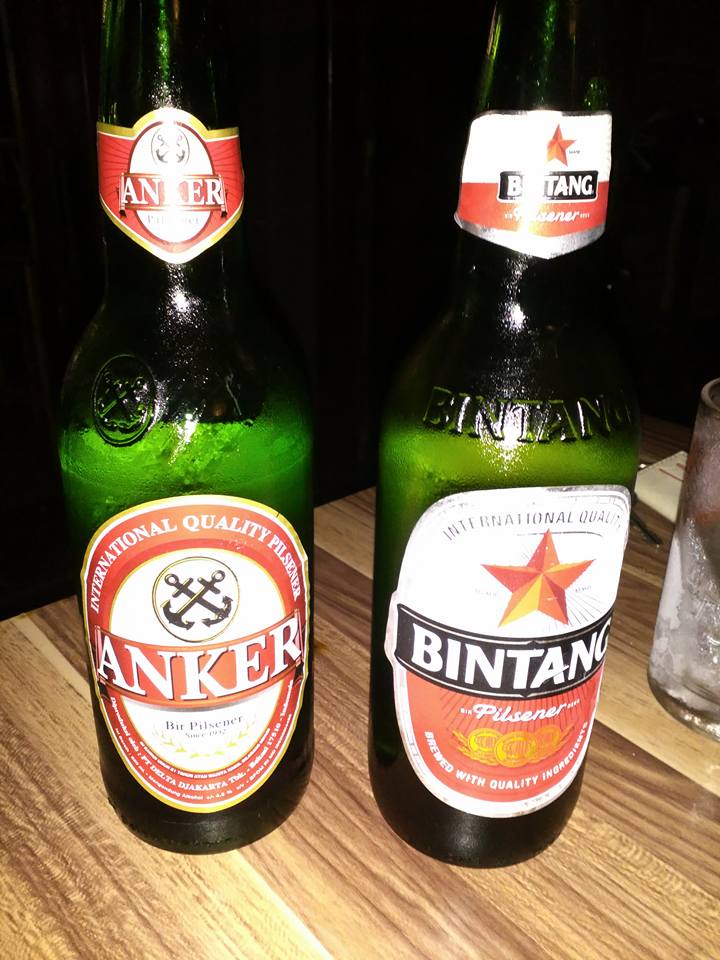
Uncovering Secret Drinking Holes & Top Bars in Bandung , Indonesia

To Kenya, With Love

How I Flew to 3 Countries for Just $115 Using AirAsia ASEAN Pass
Leave a comment cancel reply.
Your email address will not be published. Required fields are marked *
Start typing and press enter to search

BLOG & NEWS
News & events.
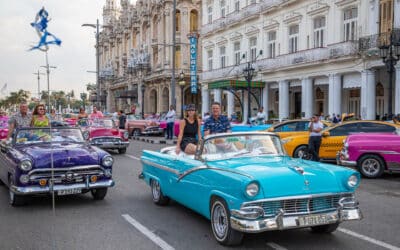
Cultural Cuba Founder David Lee is honored to be selected as a Condè Nast Top Travel Specialist for the 6th consecutive year
by Stephen | Blog , News
Cultural Cuba Founder David Lee is honored to be selected as a Condè Nast Top Travel Specialist for the 6th consecutive year. This award recognizes the Cultural Cuba team's expertise in providing seamlessly managed enjoyable and enriching experiences. Plan Your Next...

It’s the Perfect Time to Plan Family Travel to Cuba!
by David Lee | Blog , Highlights
With something for everyone, Cuba is the perfect destination for Family travel. Create lasting memories with your loved ones by experiencing the vibrant culture, warm hospitality, and breathtaking...

CUBA: A 2023 HOT DESTINATION
Featured on the New York Times List of Places to Go in 2023, there is no better time to book a trip to Cuba! With daily 50 min flights leaving from Miami, and direct flights from Newark and Houston, it...

Delicious Food from our Favorite Havana Restaurants!
Contrary to popular belief, the Havana cuisine scene is bursting with talented chefs creating delicious and innovative interpretations of...

Podcast | David Lee: Experiences Transcending Politics
by David Lee | Podcast
View the episode show notes page: bellandblytravel Listen to the podcast on Apple Podcasts Listen to the podcast on Spotify Listen to the podcast on Stitcher Radio Listen to the podcast on Google Podcasts
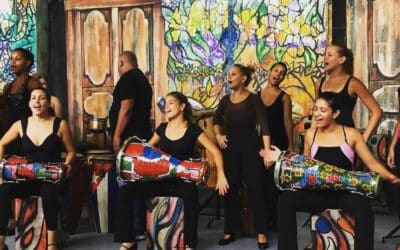
8 Questions With Cultural Cuba’s Founder David Lee
by David Lee | Tips
Read all about why entrepreneur David Lee "naively" founded the destination management company Cultural Cuba and his advice to anyone looking for a meaningful and transformative travel experience in this interview conducted by CIRE Travel highlighted as our latest...

Cuba Is Open to All Travelers
by David Lee | News
For our latest blog post we decided to share Gay Nagle Myers' interview that appeared Nov 23, 2021 in Travel Weekly. "Cuba is open!" said David Lee, founder and owner of Cultural Cuba, a company that provides travel to Cuba for Americans. "We've been waiting for this...
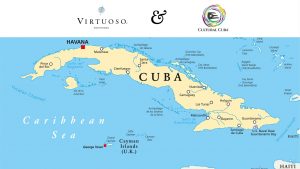
Cultural Cuba Accepted Into Global Luxury Travel Group Virtuoso®
CULTURAL CUBA ACCEPTED INTO GLOBAL LUXURY TRAVEL GROUP VIRTUOSO® ORLANDO, FL (July 1, 2021) – Cultural Cuba has been accepted into Virtuoso®’s exclusive portfolio of luxury travel partners, comprising more than 2,000 preferred suppliers in 100 countries. According to...

See Cuba Through The Eyes of a Travel Expert
Peek into a travel industry expert's "trip diary" for an insider's view of planning custom private travel to Cuba. Sekita Ekrek's "Exploring the Magic of Havana." blog highlights the enriching benefits of Support for the Cuban People travel to Cuba for both...
TRAVEL TO CUBA BOOKING INQUIRY
- South Africa
- Afghanistan
- North Korea
- Adventure + Outdoors
- Amusement Parks
- Backpacking Trips
- Boating + Cruises
- Budget Travel
- Bus + Train Travel
- Coasts + Islands
- Country Trips
- Fall Vacations
- Family Vacations
- Green Travel
- Heritage + History
- Honeymoons + Romance
- Inspiration + Guide
- Landmarks + Attractions
- LGBT Travel
- Markets + Bazaars
- National Parks + Reserves
- Nature + Wildlife
- Parks + Gardens
- Pets + Animals
- Photography
- Airlines + Airports
- Budgeting + Currency
- Business Travel
- Celebrity Travel
- Customs + Immigration
- Deals + Rewards
- Family Travel
- Hotels + Resorts
- Luggage + Packing Tips
- Offbeat News
- Photography Tips
- Responsible Travel
- Solo Travel
- Tech + Gear
- Travel Etiquette
- Travel Warnings
- Bars + Clubs
- Celebrity Chefs
- Restaurants + Cafés
- Wine + Vineyards
- Beach Hotels
- Boutique Hotels
- Hotel Openings
- Hotel Reviews
- Luxury Hotels
- Mountain + Ski Resorts
- Spa Resorts
- Vacation Rentals
- Asia Cruises
- European Cruises
- Festivals + Events
- Museums + Galleries
- Style + Design
- Travel’s Best
- Hotel with Agoda.com
- Hotel with Booking.com

Leh Ladakh bike trip itinerary — How to spend 6 days…
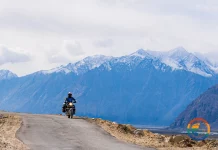
Leh Ladakh bike trip blog — Ladakh bike trip guide &…

Guide to Shenzhen nightlife — Top 5 things & what to…
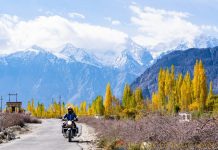
Ladakh trip cost per person from Delhi — How much does…

India trip tips — 9+ things to know before going to…

All about tips in Nepal — How much to tip in…

Cambodia travel tips — 15+ what to know & things to…

When is the best time to visit Kyoto? — The best,…

Must eat in Hong Kong — 7+ must eat & must…

Must eat in Georgetown — 10+ famous, must-eat & best street…

Must eat in Melaka — 10+ famous Malacca street food &…

Hong Kong Soya sauce Chicken Rice and Noodles — The first…

Top hotels in Siem Reap — 8+ best places to stay…

Top hotels in shanghai — 15+ best hotels in Shanghai

Top hotels in Malacca — 10+ good & best hotels in…

Top places to stay in Bali — Top 10 best areas…

10 must-know things for your best first time European river cruise

Top 3 best luxury cruises in Halong Bay, Vietnam

Cherry blossom festival Korea 2024 — Top 5 cherry blossom festivals…

Ghibli museum blog — The fullest Ghibli museum guide for first-timers

Kyoto festival — Top 10 best events & most famous festivals…

National Palace Museum Taipei blog — What to see in National…

Japanese waterfall — Top 10 most beautiful waterfalls in Japan in…

19+ most beautiful towns in Europe every tourist need to visit…

Georgia travel photos — 20+ captivating photos show Georgia is heaven…

Explore Damnoen Floating Market — The oldest floating market of Thailand

Visiting Fenghuang Ancient Town — One of the most charming ancient…

Mekong Delta travel blog — Beyond rivers of Southwestern Vietnam

14 reasons why you should travel when you are young

Shigaraki Tanuki – An animal symbol of good luck in Japan

Living in the charms of cave houses in Andalucia, Southern Spain

20+ jaw-dropping tiny homes around the world
Havana blog — the fullest havana travel guide for a great trip for first-timers.
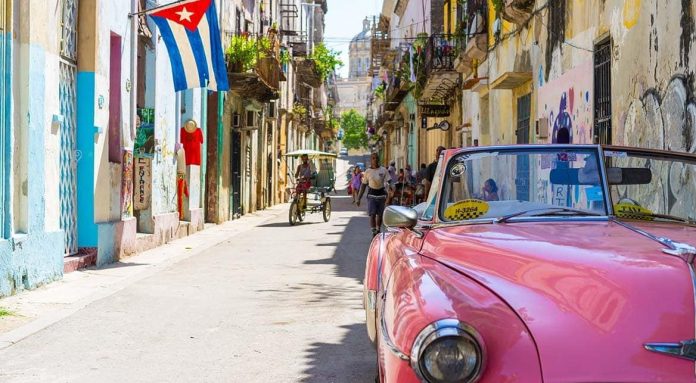
An UNESCO World Heritage Site, a piece of history that is still well-preserved today. The scene that opens before your eyes will be a picture of Cuba from 200 years ago with cobblestone streets, magnificent buildings in Baroque and Neoclassical architecture style. Havana is the capital of Cuba also known as La Habana, a city with many strange things and is considered quite expensive for tourists despite the average local people’s life. Havana is one of the best places to visit in Cuba in particular and Caribbean in general. So, what to do and how to plan a budget perfect trip to Havana – the colorful and vibrant capital city of Cuba for the first-time? Let’s check out our Havana blog (Havana travel blog) with the fullest Havana travel guide (Havana guide, Havana tourist guide) from how to get, best time to come, where to stay, best places to visit and top things to do to find out the answer!
- 8 best places to visit in Cuba 2017
- Trinidad travel blog — How to spend a perfect day & things to do in Trinidad, Cuba
- What to buy in Cuba? — 11+ must-have Cuban souvenirs, gifts & best things to buy in Cuba
- 21+ photos that show the many sides of life on the streets of Havana
- Street life photos in Cuba through an iPhone lens
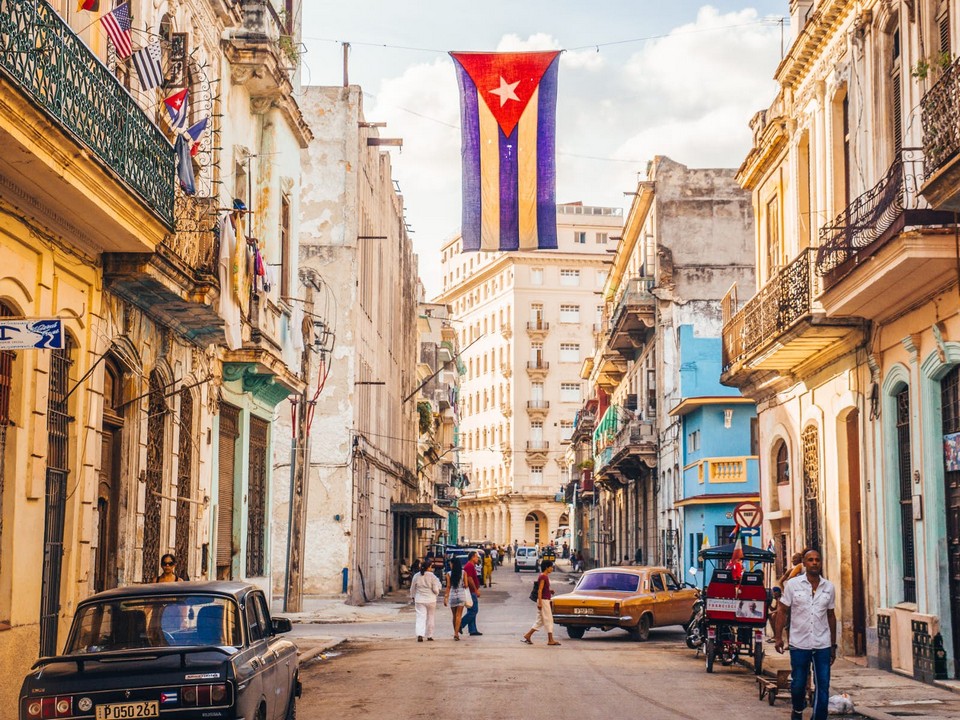
Havana – right from its name is tinged with ancient colors. The full name of this city in Spanish is La Habana, formerly San Cristóbal de la Habana. It is widely believed that the name of the city may be derived from Habaguanex – the name of an Indian chief who holds control of the area and is quoted by the painter Diego Velázquez in his submission to the King of Spain.
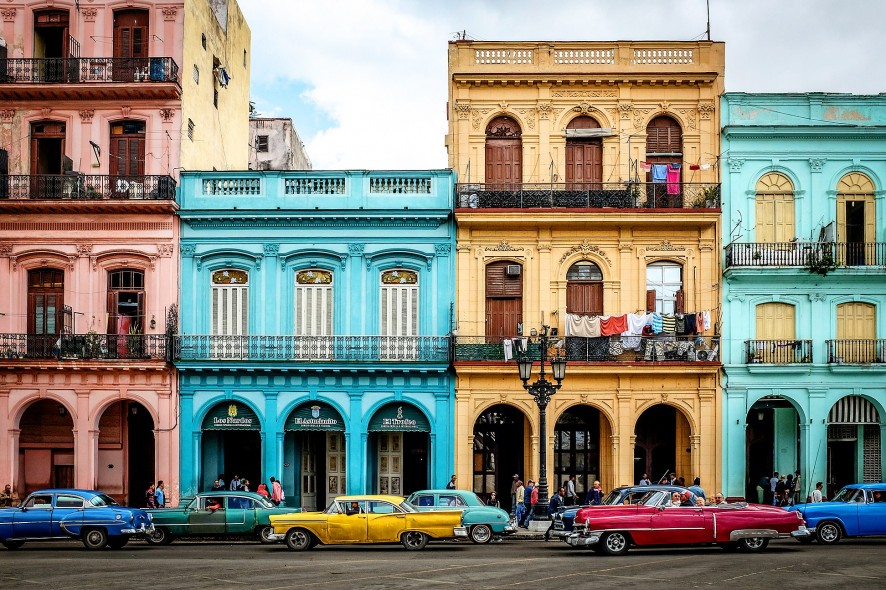
Havana blog: Overview of havana
Referring to Cuba’s tourist destinations, the first name must definitely be Havana. Not only known as the heart of Cuba, but Havana was also voted one of the most beautiful cities in the Caribbean and Latin America. Havana is a colorful ancient city, because everything here from buildings, houses to cars have an ancient look. You can even see old 1950s cars still running on the roads.
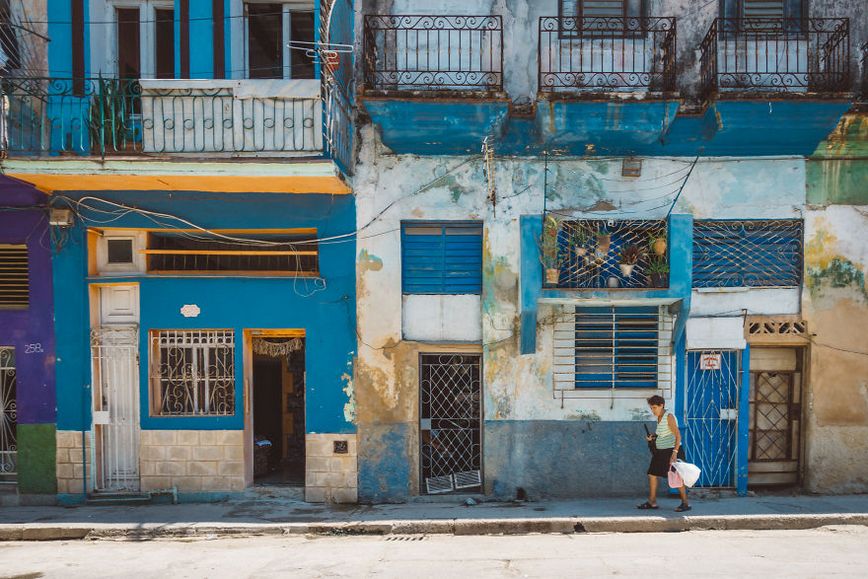
Currently, the capital of Havana still well preserves nearly 100 works of cultural and historical value, more than 800 environmental works and nearly 2,000 other value architectural works. Havana is the capital and one of the 14 provinces of Cuba. With a population of more than 2.2 million people and an area of 728.3 km², Havana is not only the political, cultural and economic center of Cuba but also the largest city in the Caribbean.
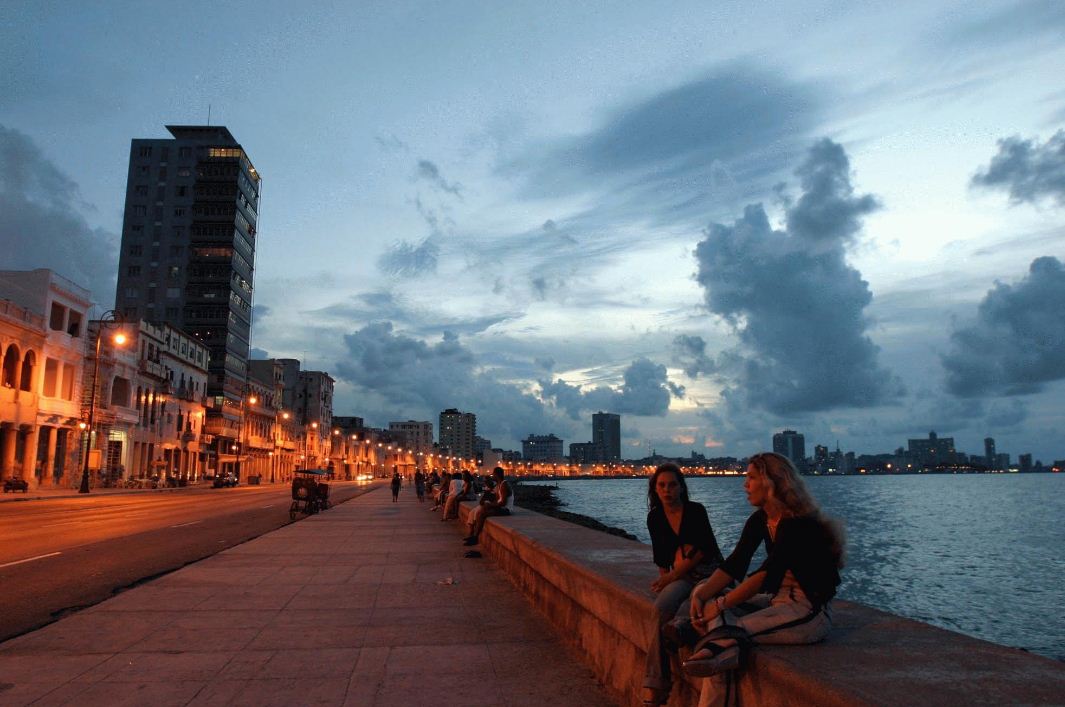
Previously, this city was fully named San Cristóbal de la Habana and was visited by Europeans by sea in 1509. By 1510 the first Spanish colonialists invaded and occupied Cuba. Havana was founded on 25/8/1515 on the south coast of the island near the present day town of Surgidero de Batabanó. The 17th century is considered the flourishing period of the capital La Habana when there are many religious structures built such as The convent of St Augustin, El Morro Castle, The chapel of Ermita del Humilladero, The Torreón de la Chorrera (Tower of la Chorrera)…

Many people say that Havana is ‘the City Stuck in Time’. This place records the imagination unlike anywhere else. Faded glamour is combined with colonial reconstruction with an irresistible color scene. Traveling to Havana, take the time to walk on El Malecon – the vivid coastal road, visit the old quarter of Havana and the Cathedral of San Cristobal, indulge in salsa dancing, explore flea markets and overnight parties… All will make colorful and unforgettable experiences for visitors.
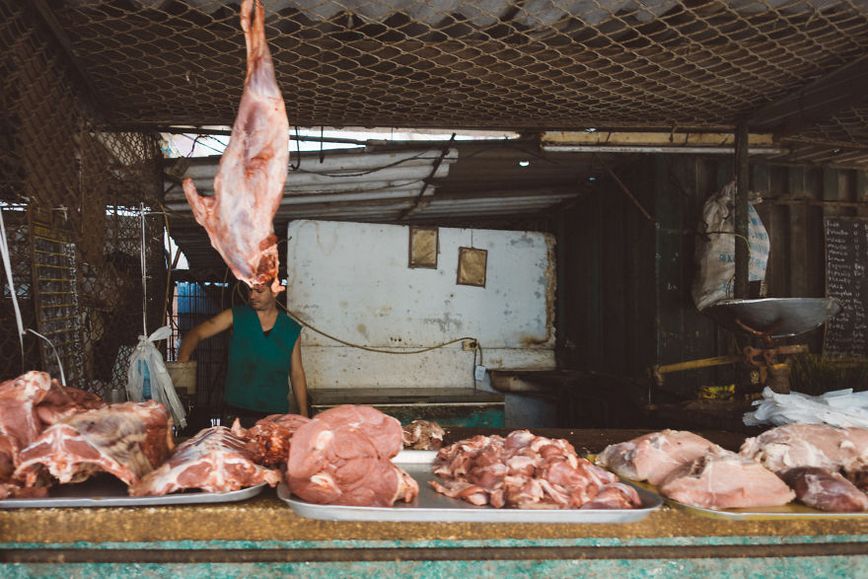
Havana blog: When to visit?
Belonging to a tropical monsoon climate, but the weather in Cuba is extremely pleasant, not harsh. The average temperature in this country is only around 26 -27 degrees Celsius, and the best time to travel to Cuba is from September to December, which is also the time of season change from autumn to winter. At this time, Cuba is a bit cold, but there is no storm. Havana Jazz Festival also held in December is a huge music event of the city of Havana.
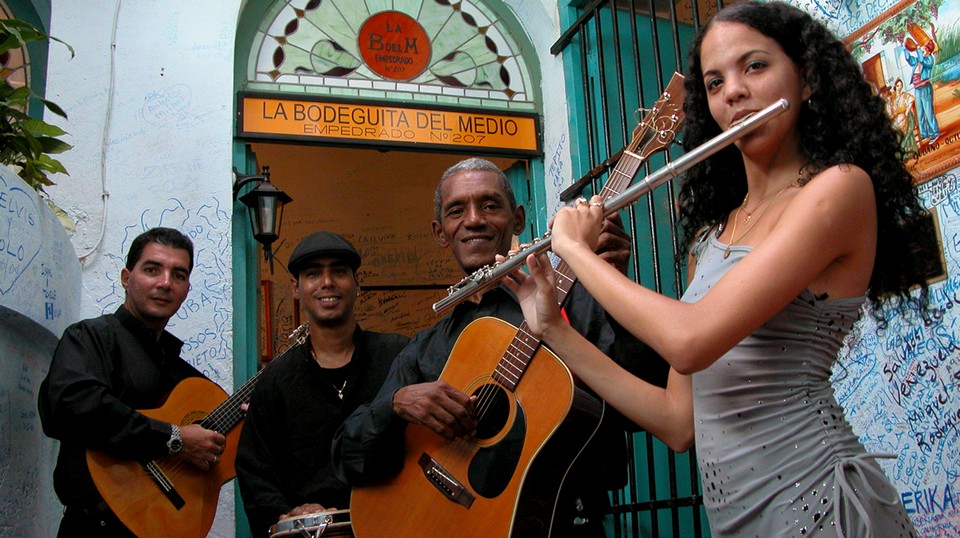
Like in Vietnam, Cuba climate is divided into 2 seasons, that is the rainy season lasts from May to October and the dry season lasts from November to April next year. The time of typhoon and flood usually starts from June to August, you should avoid going at this time.
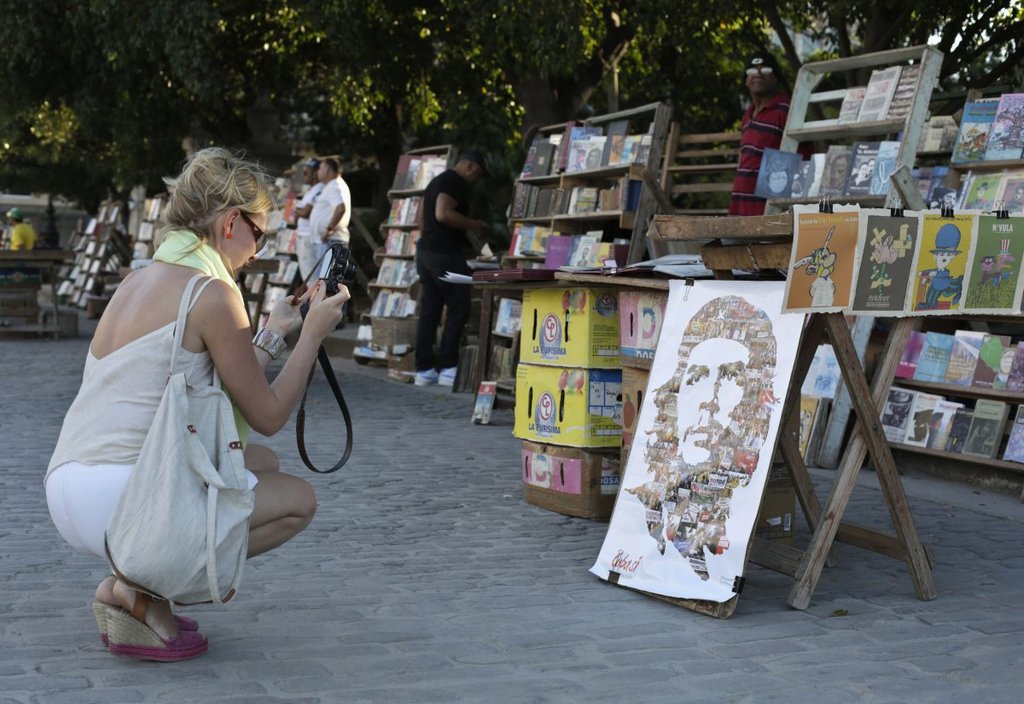
Prepare clothing
In a country where the weather is quite pleasant, not too harsh, you can freely choose cool, colorful outfits to walk on the beach or participate in the vibrant dances here. Besides, all the personal belongings like towels, slippers, shampoo, etc. you should also bring. Because these items in Cuba are quite difficult to find, even hostels and hotels are not prepared for guests.

Besides clothes, remember to prepare dried food, instant noodles, etc. Because Cuban food is quite greasy, Asian guests will feel bored and unfamiliar. You should also bring common medicines such as cold medicine, stomach ache medicine and also necessary personal items such as sunscreen, towels, slippers, etc. In addition, if you are more careful you should bring toilet paper, device to switch plug from flat to round because there is no such thing in Cuba.
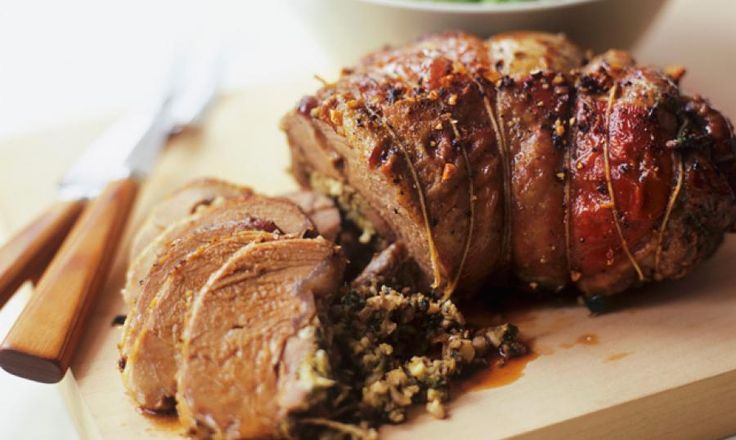
Havana travel blog: Some things to know before traveling to Cuba
If you do not know, the official language of the Cuban people is Spanish, so if you know a few Spanish words or sentences, it will be more convenient for your trip. Most countries in the world choose English as its second language, but not so in Cuba, the number of people who know English is very small. If you go to some tourist destinations like Havana, Cienfuegos, communication in English is a little easier.
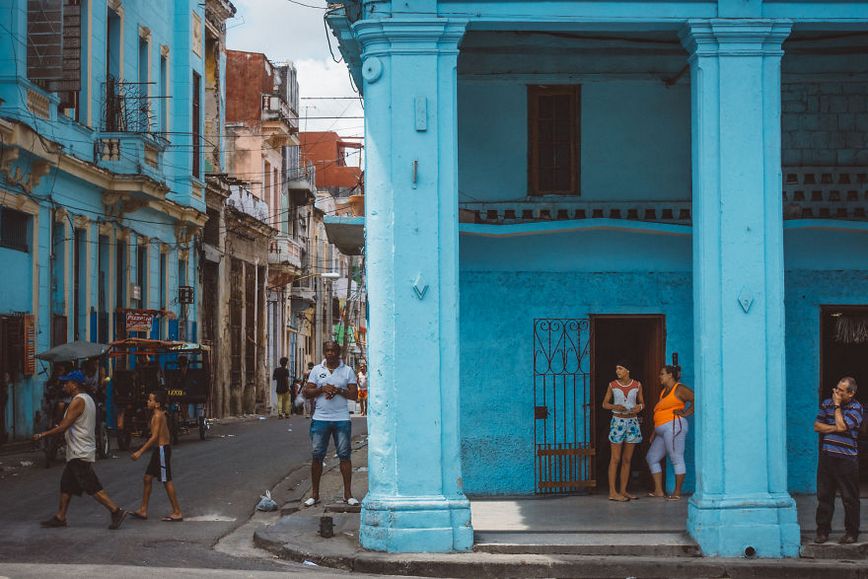
When traveling to Cuba you need to know clearly the monetary system here, because there are up to 2 currencies. Specifically, this country uses CUC (short for Cuban Convertible Peso) for tourists and CUP for locals. The CUC is worth more than the CUP, 1 CUC is approximately equivalent to 1 USD and 1 CUP is approximately equivalent to 1,000 VND ($0.05). Thus, if you do not want to spend too much money, you should exchange to CUP to spend.
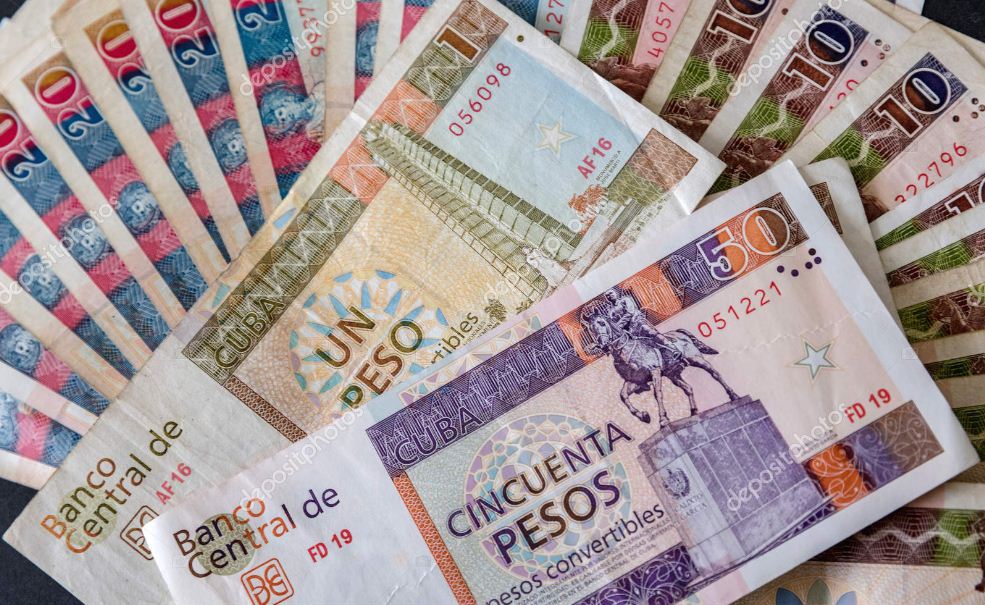
In Cuba, you can exchange them easily at airports, banks or money exchange shops. However, because the USD exchange rate here is quite low, you should prepare EUR in advance, to bring it to Cuba to exchange to Cuban currency. One more thing to note is that in Cuba, credit cards are accepted but extremely rare, if have, you must include your passport. Therefore, it is best to bring cash with you.
If in most countries in Southeast Asia you can use free WiFi or use pocket WiFi device very easily, WiFi in Cuba is quite expensive. It is only free in parks, squares in cities and crowded centers. So, in case you want to share pictures of your trip with friends, buy scratchcards then go to free WiFi hotspots, select the ETECSA WiFi network and enter the card number and password.

If you want to buy scratch cards to access free WiFi, go to the post offices scattered throughout the big cities. Because a lot of people need to use the same service you do, it takes a little while for queueing. Then, there will be a few people like “decoy” in Vietnam will recommend you to buy scratch cards for 1.5-2 CUC, which is twice as expensive as buying at the post offices. Usually, it only will validate within 1 hour.
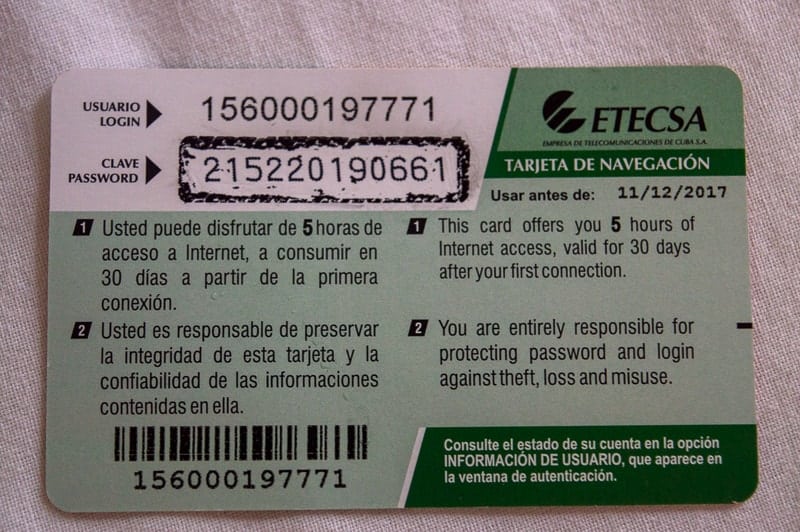
You can rest assured, because Cuba is one of the countries with the lowest robbery rates in the world. Although at night, the streets are quite deserted, not bustling like in Vietnam, but not dangerous. Occasionally, you will come across men or prostitutes standing in the alleyways, however they only offer you service and are completely harmless.

Havana travel blog: How to get to Havana?
There is currently no direct flight from Vietnam to Havana, so you have to transit. Normally, from Vietnam to Cuba, there will be many choices about routes, depending on each flight you have to transit at 1 or 2 airports. Ideally, you should choose the Russian airline Aeroflot, transit in Moscow (Russia) or fly with Air France, transit in Paris. Currently, only these two airlines allow you to fly from Vietnam to Cuba with only one transit.
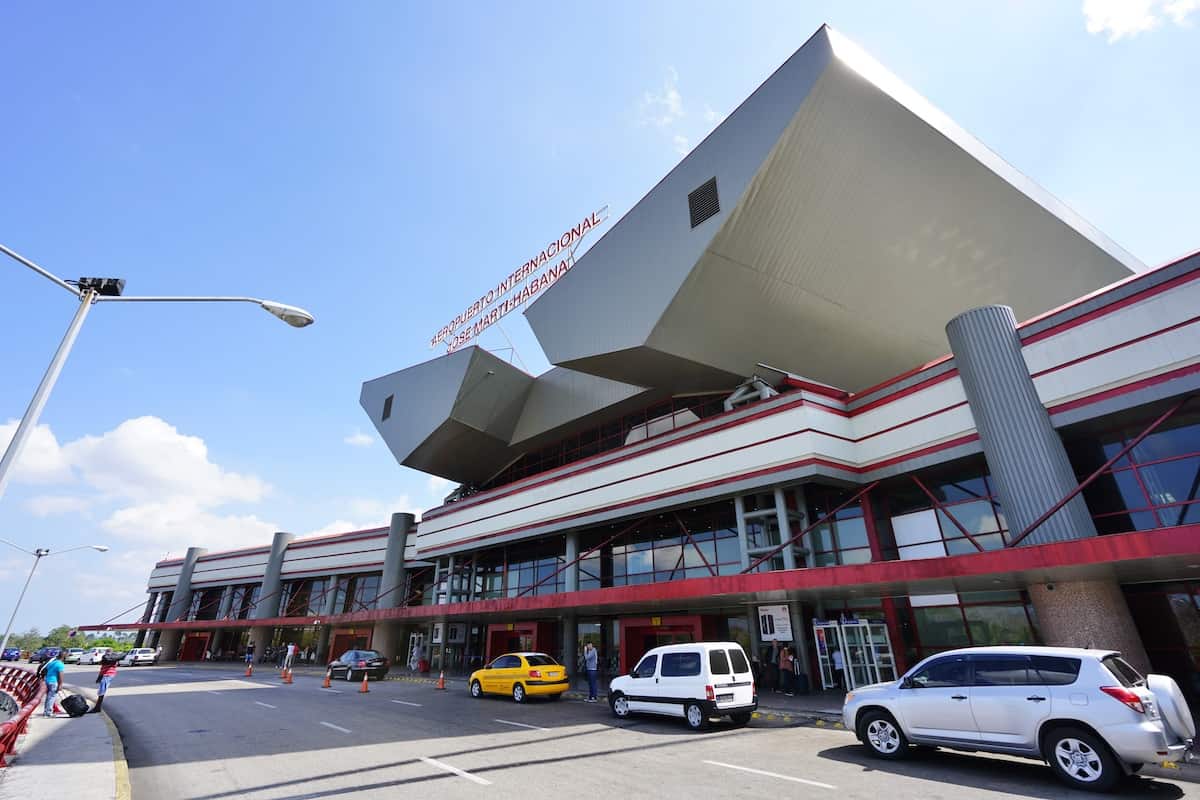
If you choose only one transit in Moscow (Moscow Airport), accept a little bit of trouble because the transit time is quite long. At Charles De Gaulle Airport (France) it is about 10 hours, the total flight time is around 34 hours, and at Moscow Airport (Russia) it is about 14 hours, the total flight is around 37 hours. You also check to see if you need a transit visa or not, if so, the procedure is quite simple. That is when you intend to stay in France or Russia to play for a few days, otherwise there is no need to apply for a visa.
But that is not the only option, because you can also choose to connect one in American countries such as the US, Mexico, Canada or connect twice in some Asian countries like Taiwan, China, South Korea. But normally, visitors will choose to transit once for good. Moreover, at present, the US and Cuba still have not normalized relations, so when you choose to transit, you must submit a visa to the U.S. Department of the Treasury, even though you have been granted a visa to Cuba before.
Havana travel guide: Transportation in Havana
In Havana, you can take a taxi if you want to visit places in the city, with prices ranging from 5-10 CUC/trip, and if you take a taxi from the airport to the city center, the price is quite expensive, about 25 CUC. To save money, you can choose to walk in the old town of Havana because this area is also quite small.
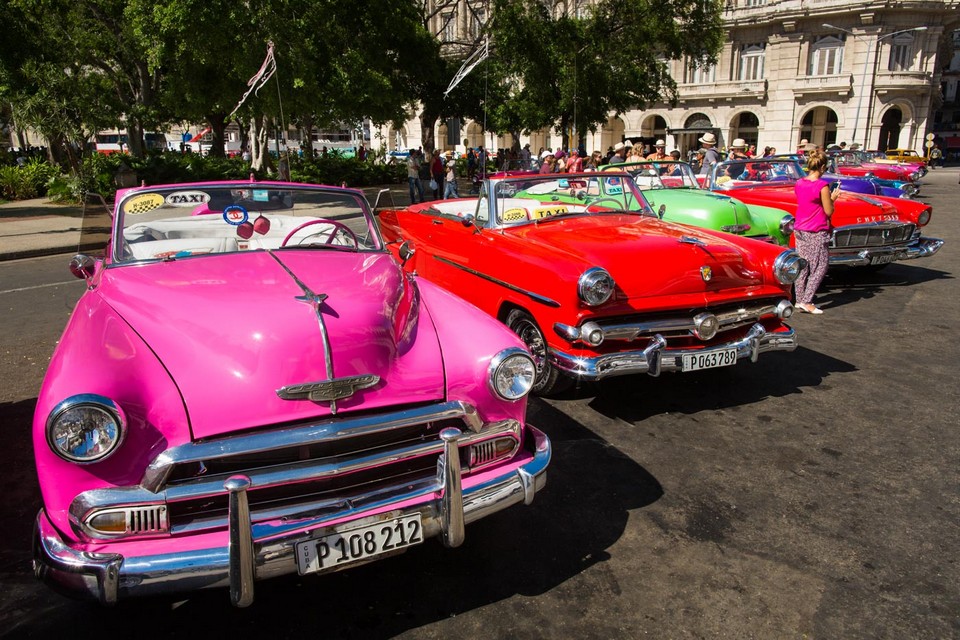
In Havana and Varadero there is a sightseeing Hop On Hop Off Habana Bus Tour that running through the attractions of the city for 5 CUC / day. In addition, you can rent a bicycle for cycling around is also very convenient because the streets in Cuba have their own bike lanes, bike rental price from 5 CUC / hour and 20 CUC / day.
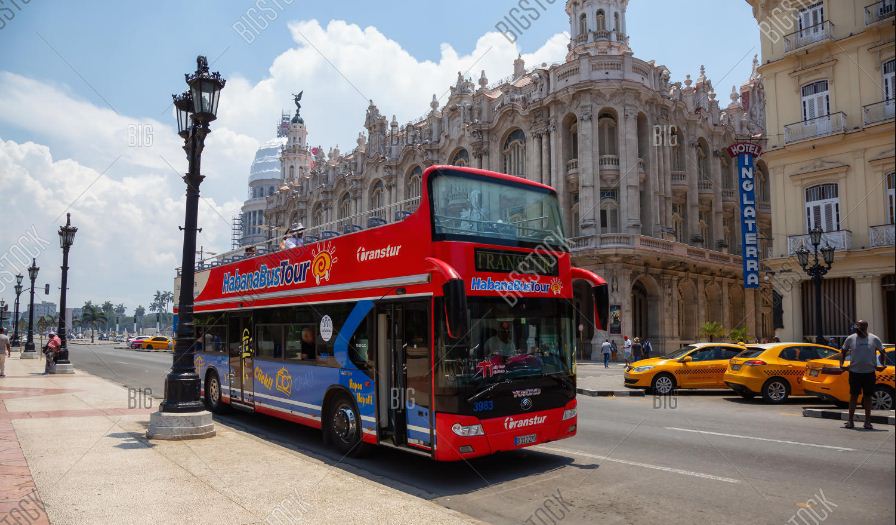
To save more money, you can choose to travel on Three-wheeled taxis such as Coco, a typical vehicle very popular on the streets of Cuba and very popular in the cities of Havana, Camagüey, Holguin. Before you get on the vehicle, remember to ask price in advance because many drivers will ask for a high price when meeting tourists, they will usually ask for 2 CUC/trip or more depending on the distance.
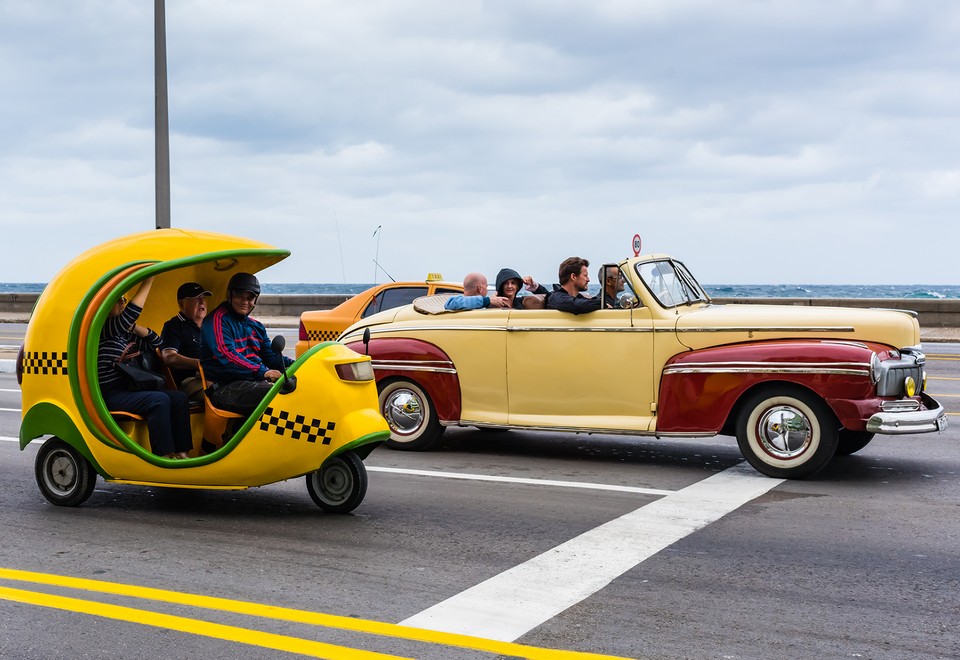
In addition, you can also rent a car to travel by yourself, but the price will definitely be more expensive and you have to pay more as prescribed.
If you want to traveling between cities, you can go by bus which can be booked in advance online to avoid running out of tickets. Once you’ve already made your schedule, simply book your ticket, pay with an international card and they will send the ticket via email. Then, you just need to print out the ticket, be there 30 minutes in front of the counter for them to give you the pass. Each trip like that will cost about 15-25 CUC.
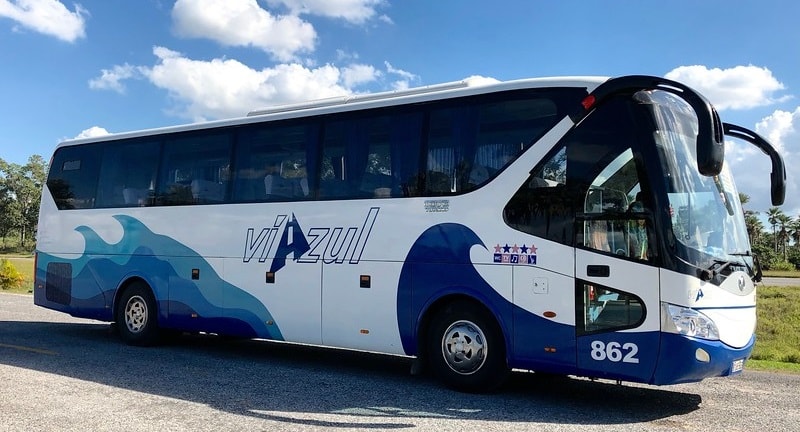
Havana blog: What to do and where to go?
Old havana (la habana vieja).
Havana Old Quarter is not only located in the center of the capital but also an UNESCO World Heritage Site. This old town still retains 88 works of high historical and cultural value, 860 works of ecological value and 1,780 other architectural works. You can visit the small house – where Cuban national hero Jose Marti was born over 130 years ago or La Bodeguita Del Medio’s favorite pub on Empedrado Street by great writer Hemingway.

You can join some walking tours to explore Old Havana, including attractions such as the Havana Old Square – home to the city’s main Roman Catholic of Havana Cathedral (Catedral de San Cristobal), the Plaza de Armas where there are a lot of street vendors selling coins and souvenirs bearing the picture of Ernesto “Che” Guevara, and the sunny Plaza Vieja – a favorite place for Cuban students to play, or the cool and windy Plaza de San Francisco de Asís (Saint Francis of Assisi Square).
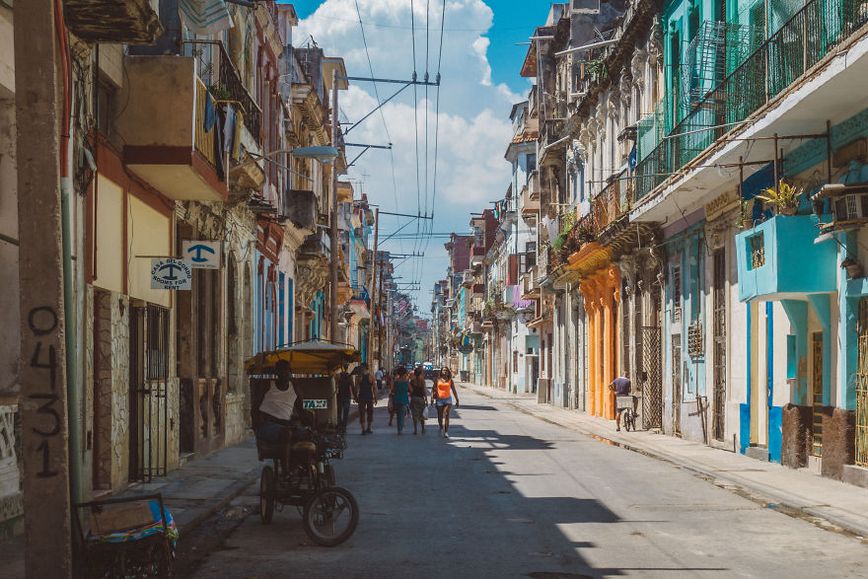
And finally one thing particularly interesting for tourists is old ladies smoking cigars in colorful clothes, ready to take your arm and leave a wonderful kiss on your cheek. The goal is for you to take pictures with them in a polite manner but you need to pay them a little money.

Revolution Square (Plaza de la Revolución)
Havana Revolution Square is a historical place you should not miss when coming to Cuba. This is the place that once kept a lot of events of the Communist Party of Cuba before. During the time of President Fidel Castro in power, an estimated one million Cubans gathered in this square on International Labour Day (May 1) to attend the parade. The José Martí Memorial and the steel carving portrait of Che Guevara are works that you will admire when you come to this square.
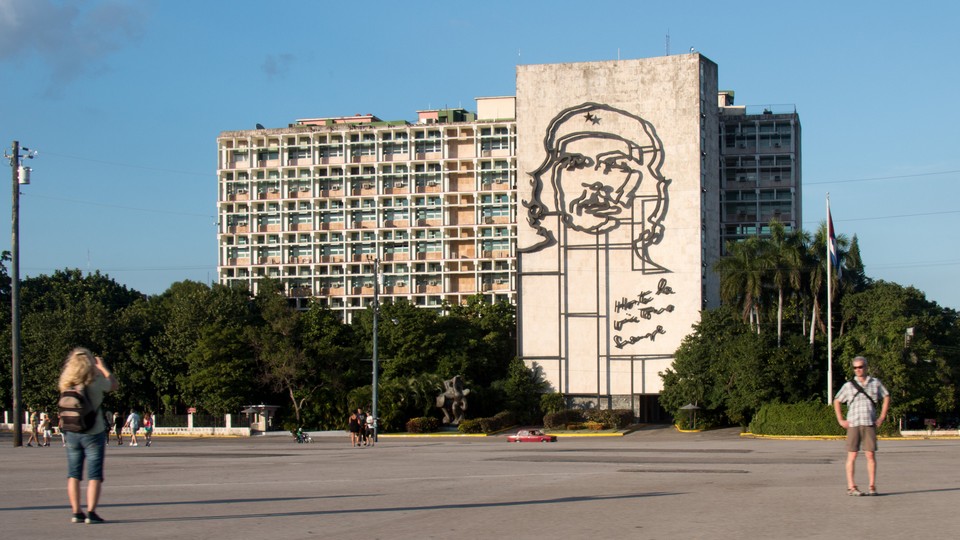
Address: Avenida Paseo, La Habana, Cuba Area: 12 km² Hours: Open 24 hours
Morro Castle (Castillo De Los Tres Reyes Del Morro)
One of the most famous places to visit in Havana that I want to introduce to you, is Morro castle. This is a massive architectural work, a large fortress with a towering lighthouse. Morro is known as a typical symbol of the capital city of Havana. Going inside the fortress, you not only discover the unique and impressive architecture, admire with your own eyes many artifacts of historical and special value, but also understand more about the foundation, development of the city.
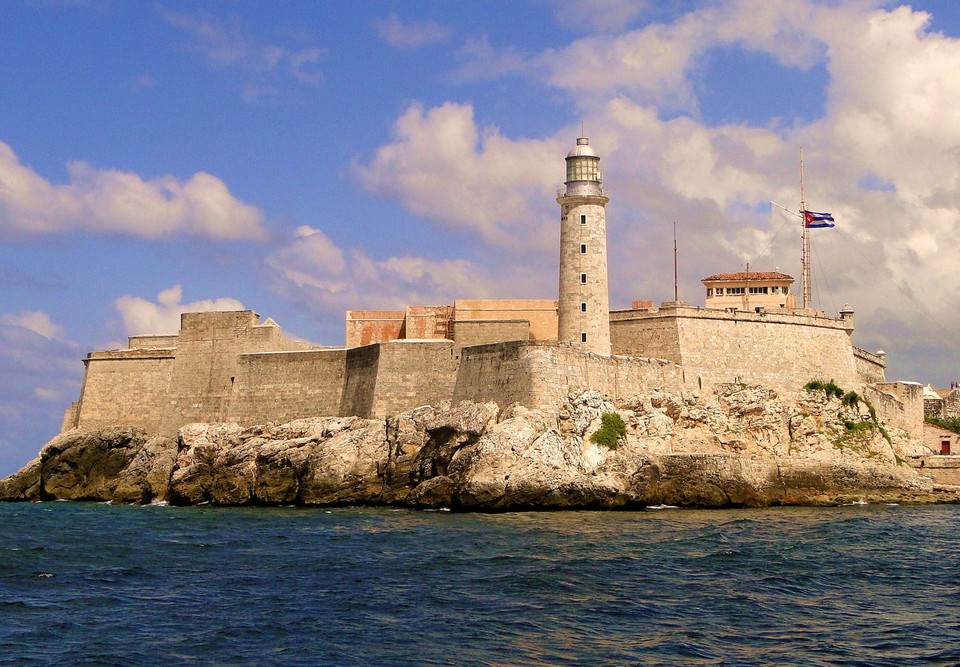
Address: Havana, Cuba Opened: 1589 Hours: 10AM–7PM Function: Fortification
National Museum of Fine Arts
If you are wondering where to go in Havana, consider the National Museum of Fine Arts, for the chance to learn and explore the long history of this beautiful Cuba country. Visitors will have the opportunity to admire many famous and long-standing works of art by Cuban artists from the colonial period to today. In particular, Wifredo Lam’s works are always abstract and full of meaning.

Address: Havana, Cuba Opened: April 28, 1913 Hours: 9AM–5PM/Sunday: 10AM–2PM/Monday: Closed
Museum of the City (Museo de la Ciudad)
Another interesting sightseeing spot in Havana, that is the Museo de la Ciudad (Museum of the City), which attracts the attention of many tourists. Because this place will reveal to you about the interesting history of the city of Havana.
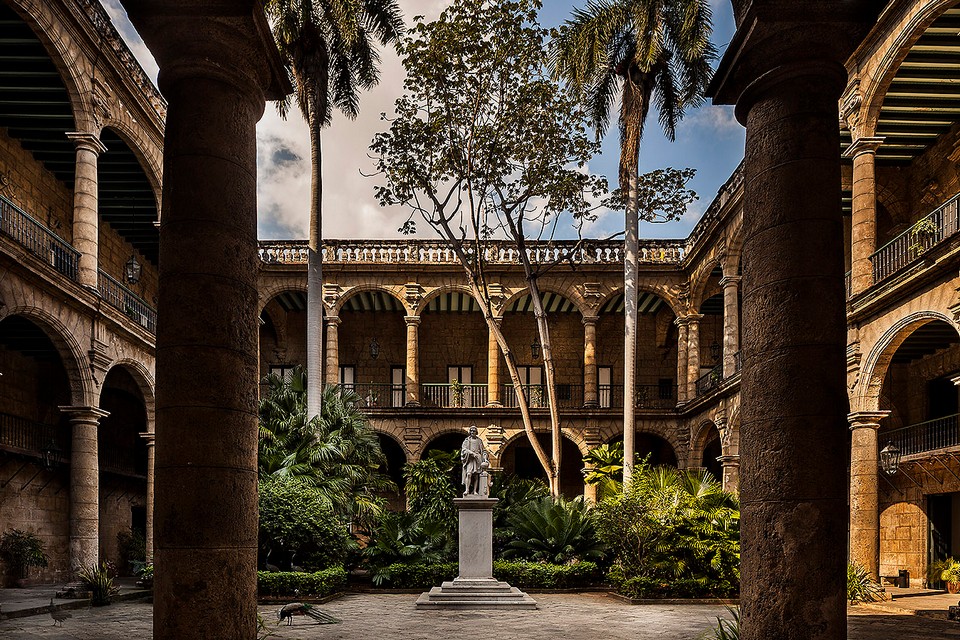
When arriving at the city museum, the first spot you should come is the Hall of Heroic Cuba – The place contains many artifacts dating back to the revolution. The next is Espada cemetery, the resting place of famous French painter named Vermay. But the most highlighted place at the museum is probably the Salon de los Espejos (Hall of Mirrors) – A large room decorated with many old nineteenth-century mirrors. Besides, this house is also the place where ended up the Spanish rules which was enacted in 1899.
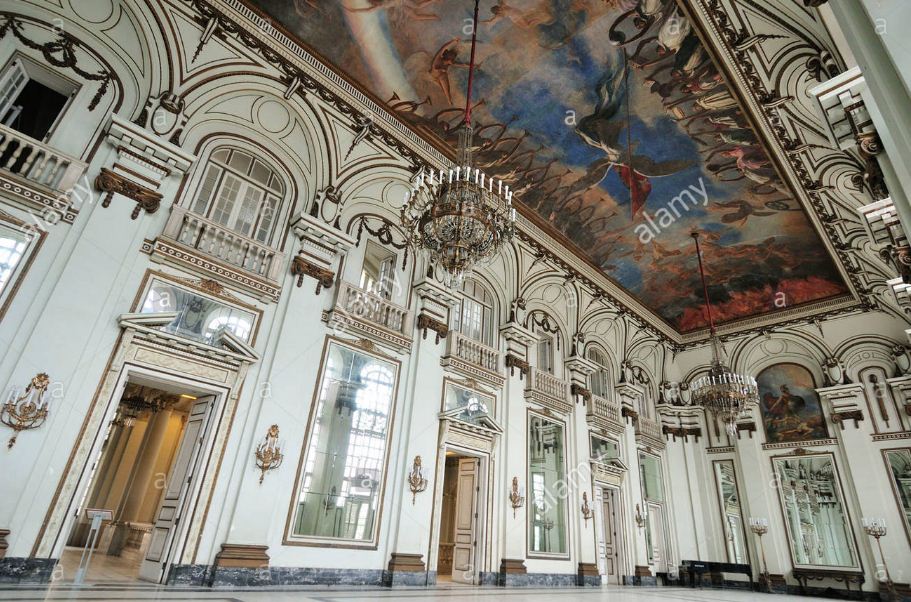
In addition, at the Museo de la Ciudad, there are still many other interesting things for you to explore such as Iglesia Parroquial Mayor Church, the ancient bronze statue of La Giraldilla…
Address: Cuba Tacón, La Habana, Cuba Hours: 10:30AM–5PM/Sunday: 9AM–1PM/Monday: Closed
Callejón de Hamel Art Center
This is a art, cultural preservation area and the values of the people here which is extremely interesting and attractive. You can admire the street art, the permanent murals, attend the live music performance, dancing or even learn Rumba dancing here.
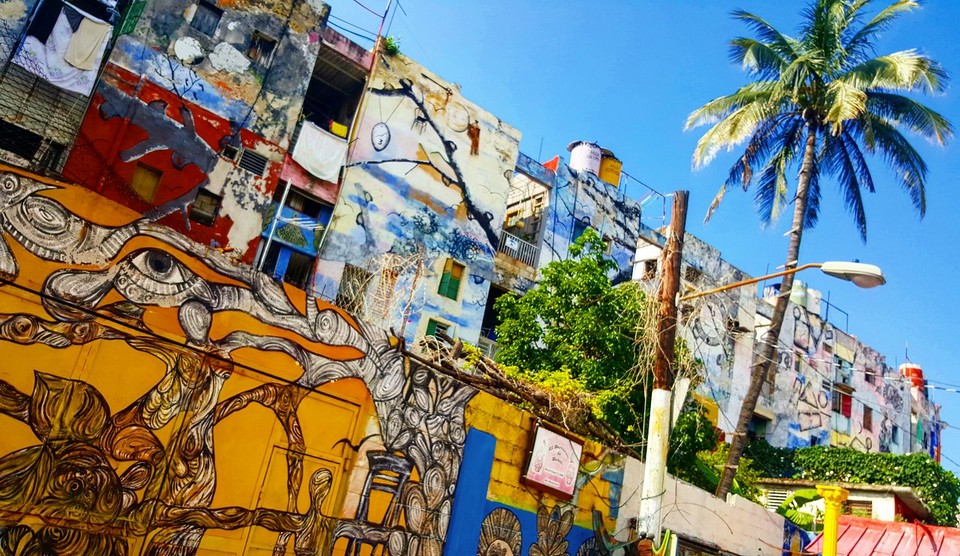
Visiting the city of Havana on old cars
The highlight as well as the specialty of Havana is that visitors can driving, sitting on old Cadillac, Ford, Chevrolet … cars from the 1950s that are still running on the streets with colorful colors. Old cars are everywhere in the city and we highly recommend visitors do not miss this exciting experience. These cars are also used for weddings, the groom picking up the bride on the road, towards the Capitol building, where tourists can come to see the car and feel nostalgic time.
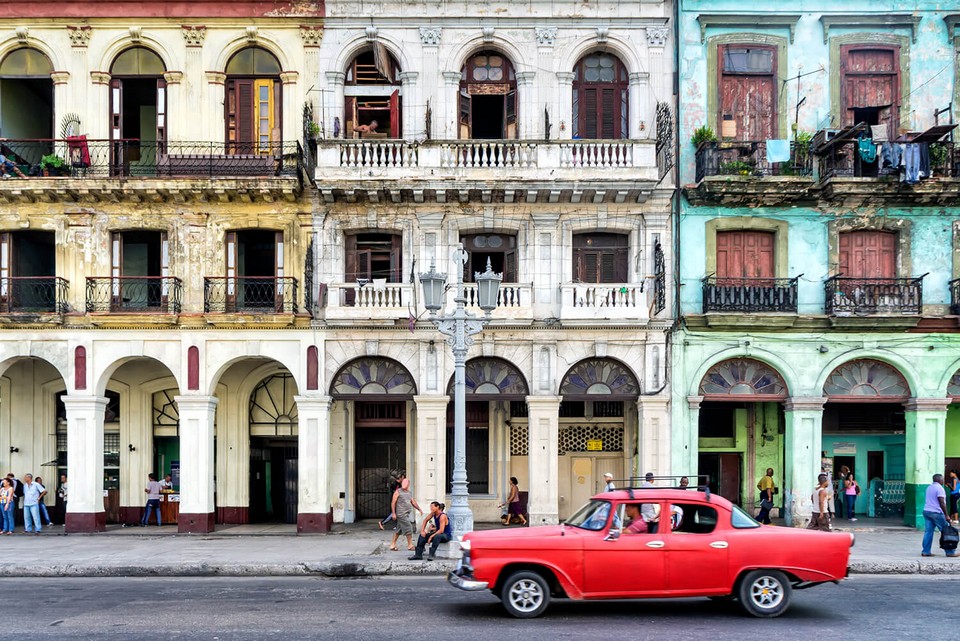
Motorbike lovers also have the opportunity to gather at the Harley-Davidson club at the Nacional hotel to show off their classic motorbikes, usually held every Saturday afternoon.
Fusterlandia
Perhaps this is the tourist place that attracts the most visitors. Because Fusterlandia is known as an impressive art complex, with colorful, whimsical mosaics walls, fictional characters originating in Cuba, … all create an unique space. And this is also a beautiful photography spot in Havana that is interested by many young people.
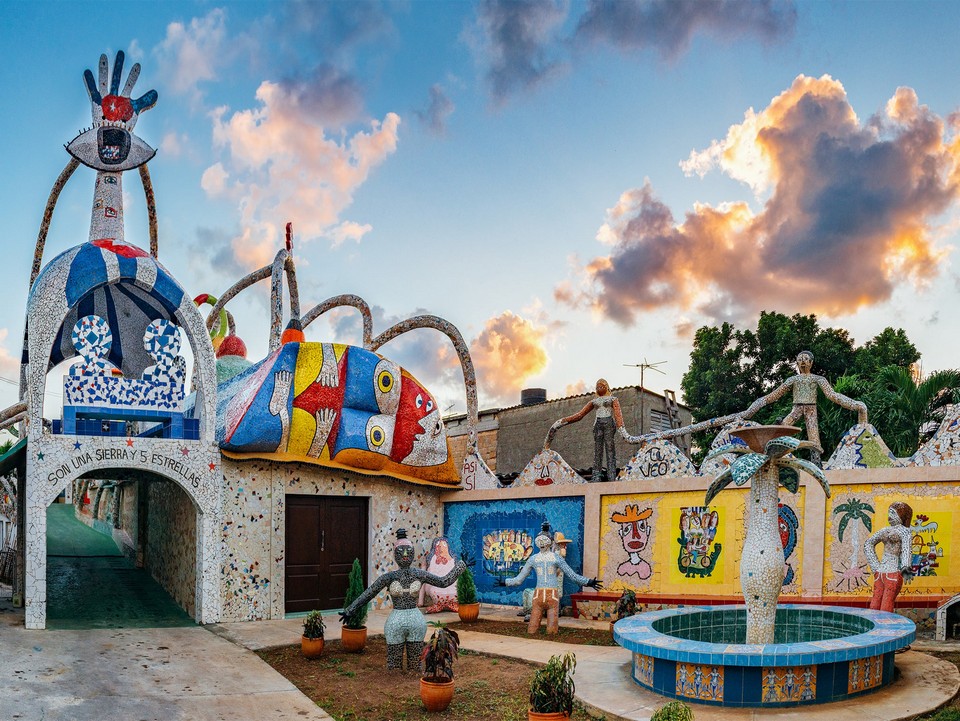
Address: Havana, Cuba Hours: 9:30AM–4PM
Chat with the artists
Heading to the art gallery of Taller Experimental de Grafica to chat with artists in Havana. Founded in 1962 under the guidance of Che, this place hosts dozens of artists who are friendly and want to interact with the public.
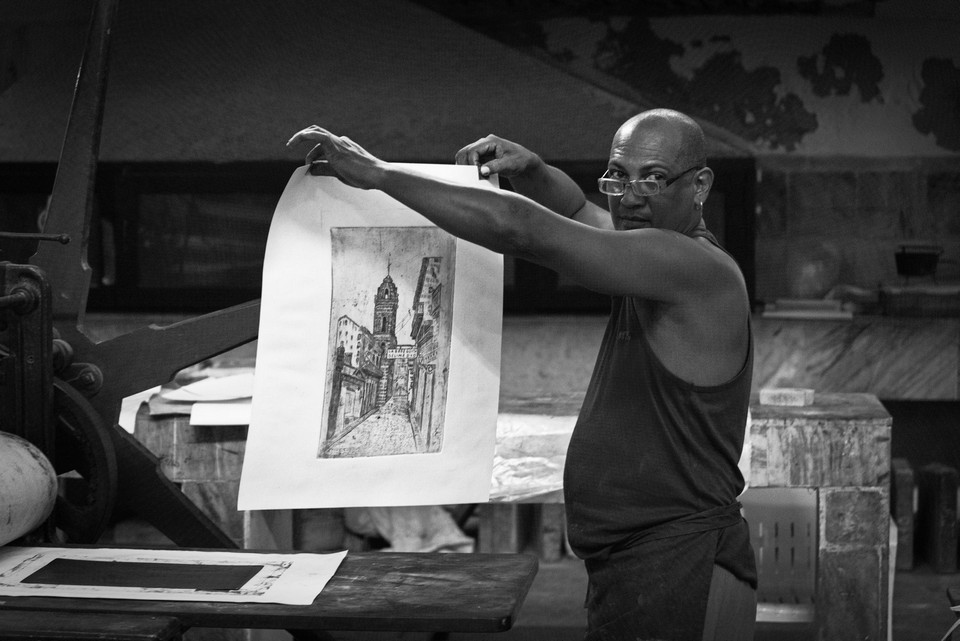
Or art lovers can wander along the 23rd street also known as La Rampa or the Ramp, where dozens of mosaics made by Cuban masters like Wilfredo Lam create a gallery on the sidewalk for visitors can admire them.
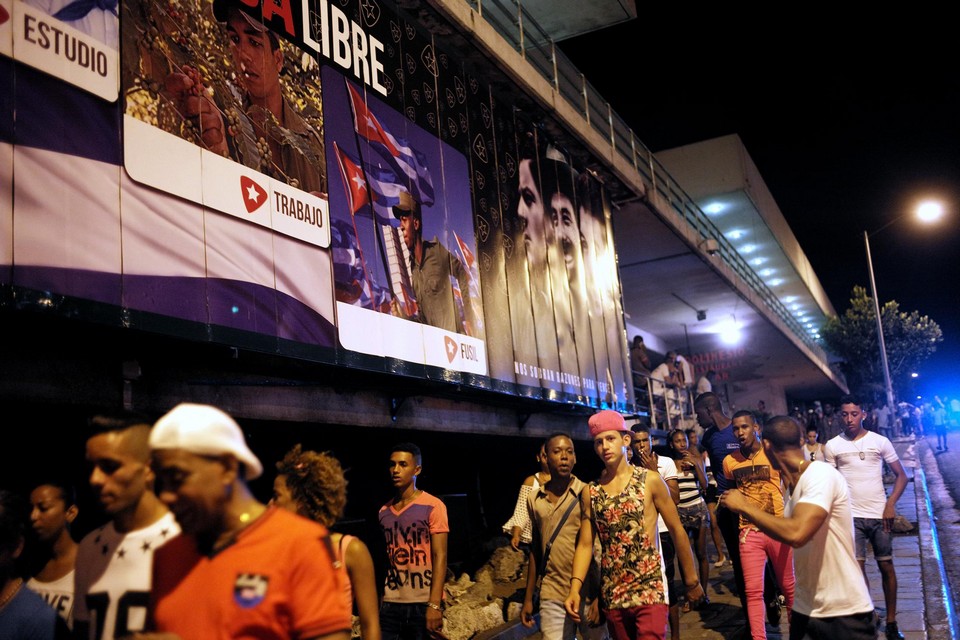
Rumba dancing on the street
Although still a backward country compared to other countries, Cubans still know how to make fun for themselves, simple from lively Rumba dances. Those are sexy dances mixed African and Spanish styles. Rumba are often primitive dances, impromptu but very satisfying. If you are a tourist, do not hesitate to immerse yourself in vibrant dances with the locals.
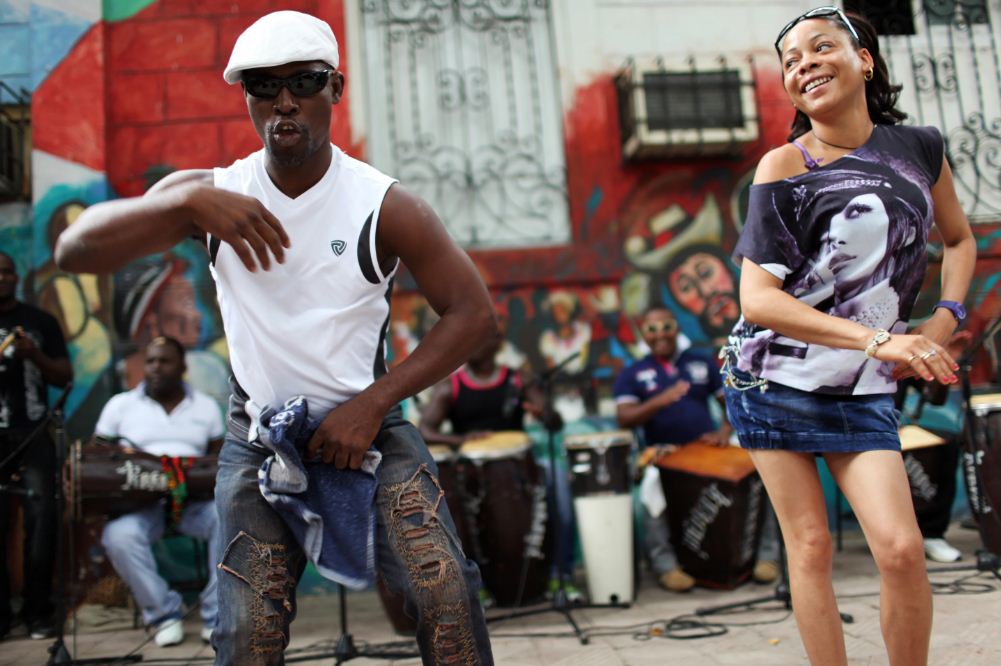
Try cigars in Cuba
Being famous for the best cigars in the world, so if you have come to Cuba in general or Havana in particular, in addition to bringing some cigars as gifts for your relatives, you can also try cigars directly in this country. Because Cuban cigar is made from delicious aroma of fresh tobacco leaves, many tourists come to Cuba just to enjoy cigars.

Visit Ernest Hemingway Museum
The writer Ernest Hemingway once praised Cuba: “People want to live on this island because the freshness of the morning makes it possible to work better and feel more comfortable anywhere else in the world”. And so there is no reason you can refuse Havana – the city of these pillars. The writer spent 7 years living in the city of Havana and the Ambos Mundos hotel, where he wrote his famous novel “For Whom the Bell Tolls”.
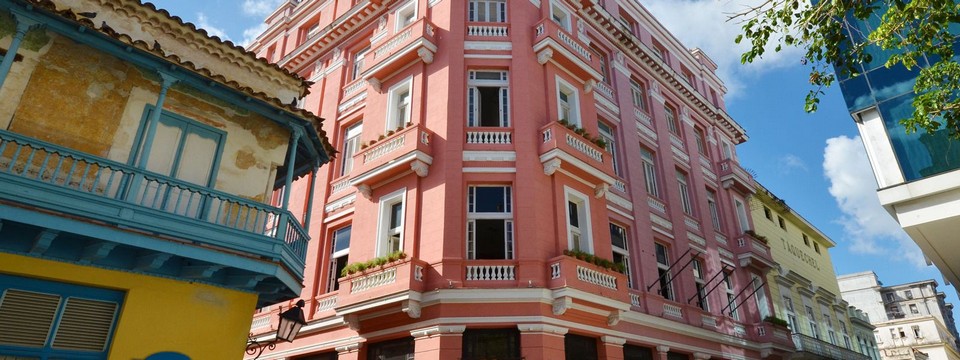
The room where Hemingway lived in the Ambos Mundos hotel has become a museum for visitors to visit. Later, he moved to live on a farm near Havana and this place has also been turned into a museum.
The famous small room 511 with simple furnishings and bookcases is full of his works translated into many languages around the world. It is known that every day, Hemingway went up there to eat breakfast and someday he stayed and wrote all day and night.
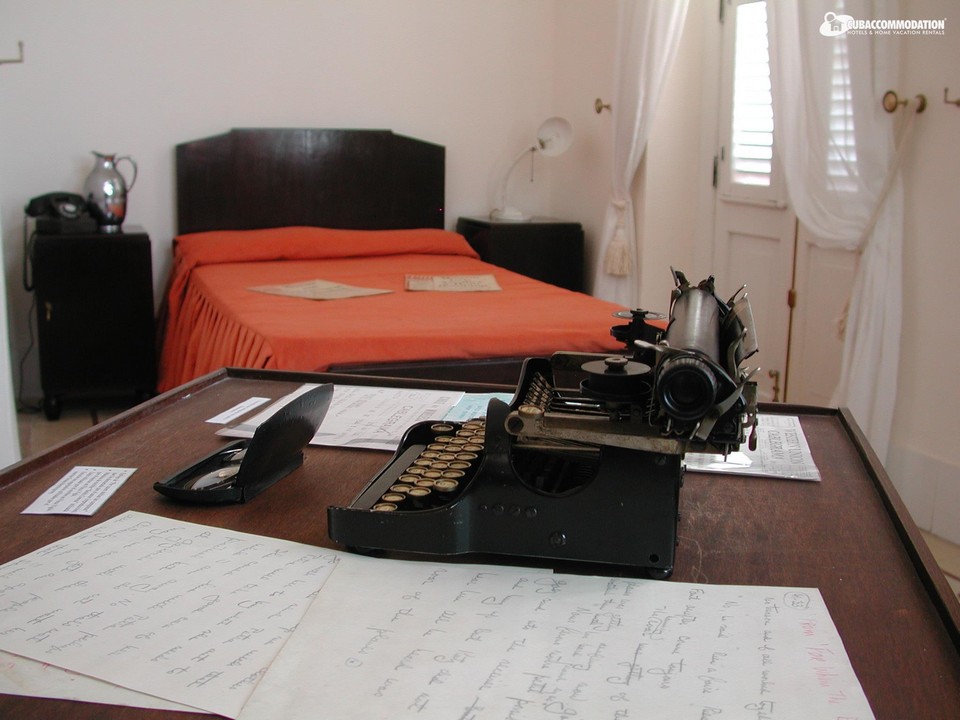
The writer also likes to walk in Cojimar, the west district of Havana, and here Hemingway met the man who inspired him to create the main character in his another famous novel “The Old Man and The Sea”.
Address: Finca Vigía Km. 12 ½, La Habana, Cuba Opened: 1886 Hours: 10AM–4PM/Sunday: Closed
Watching a baseball game in Havana
Cubans are crazy about baseball and those who love the sport won’t want to miss out on Central Park which is the hottest spot of the city.
If you are a football lover you will know that most Spanish-speaking countries are fan of the sport of football. However, baseball is the most favorite sport in Cuba, because partly Cuba was once a US colony. That is manifested in that, most cities in Cuba have stadiums for baseball.
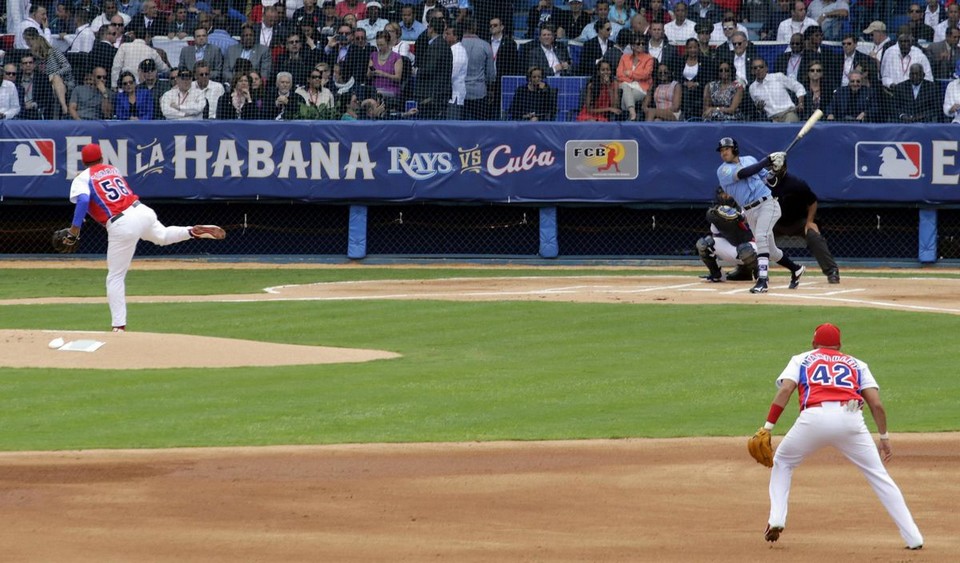
Beaches near in Havana
You should definitely not miss the beaches in this beautiful city. Havana beaches with clear blue water, white sand, the beaches are very clean and visitors also love to visit, have fun and swim and take part in water activities. Some best beaches near Havana you should go such as: Santa María del Mar for a Beach Party; Playa Boca Ciega: Escape the Crowds; Playa Guanabo: A True Charmer; Playa Bacuranao: Going the (Short) Distance; Playa El Salado: The Saltiest Salt Water.
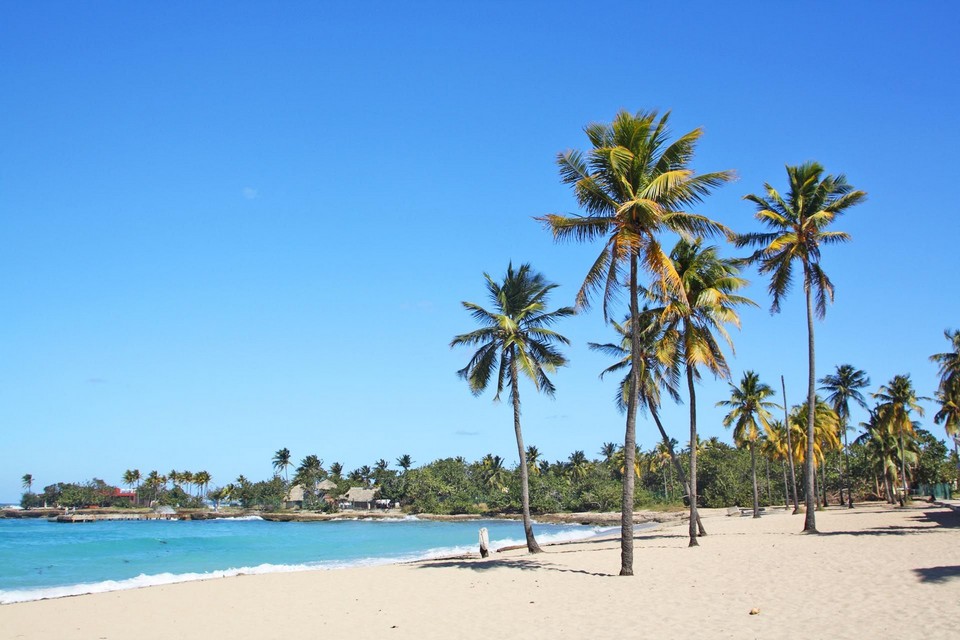
Malecon Road
The road has a stone wall used to prevent waves about 6km long running from the old town to the Almendares river. It runs through many large squares where performances, festivals and outdoor events are held, and is a favorite daily gathering and promenade of the people of the capital, especially when the sunset falls that creating a romantic scene, many couples choose this road for their dating.

On the weekends on 23rd and Malecon streets, these 2 places are really full of partying atmosphere in a mellow and vibrant atmosphere on the concrete paved road, Paseo Avenue meets Florida Strait.
Vibrant nightlife
Tropicana club.
A revolution broke out that caused many of Hanava’s clubs to be shut down, but Tropicana survived and became the largest club in Havana. Over 200 performers in glamorous costumes dance on retro music background. The décor is not too formal, but one thing is for sure, when you come here you must bring a relatively large amount of money.

- Havana: Cabaret Tropicana Admission Ticket
Address: 72 A, La Habana, Cuba Hours: Open 24 hours Founded: 1939
Casa de la Musica de Miramar Club
This is Havana’s biggest dance club, which attracts fans who can really burn the stage every night. The club owner is not afraid to spend a large amount of money to invite foreign artists, famous Cuban bands to come here to perform.
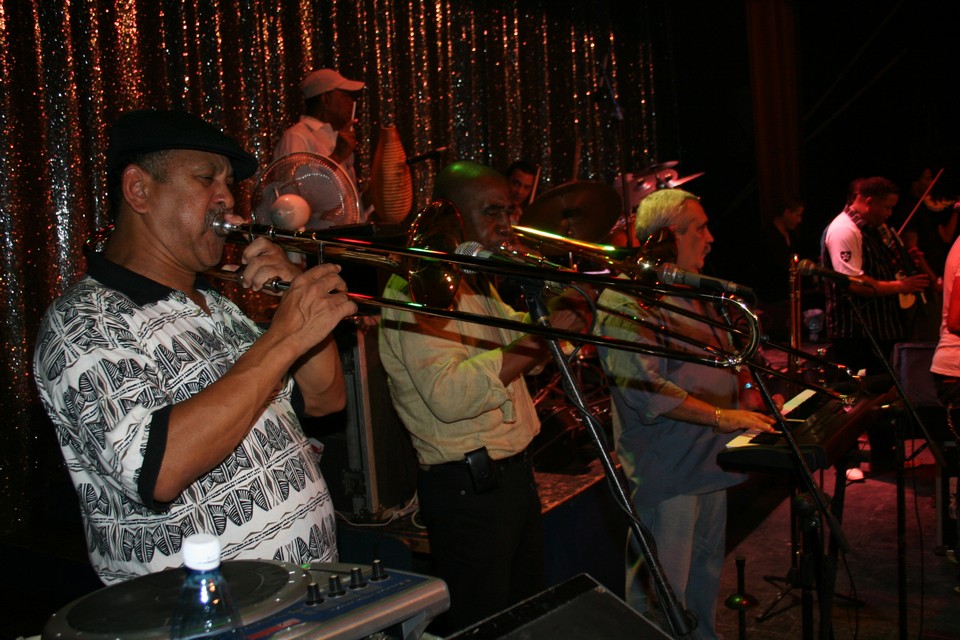
Address: 20, La Habana, Cuba
Havana travel guide: What to eat?
Cuban black bean soup.
This is a traditional Cuban dish, very popular and seems to be very popular in the life of the people of this country. Black bean soup is a dish made from black beans, butter, and oregano vegetables, pepper, bay leaf… that are all stewed until cooked. Some places people often choose to eat black bean soup with bacon. If you love Cuban cuisine, it will be very interesting to try it once.
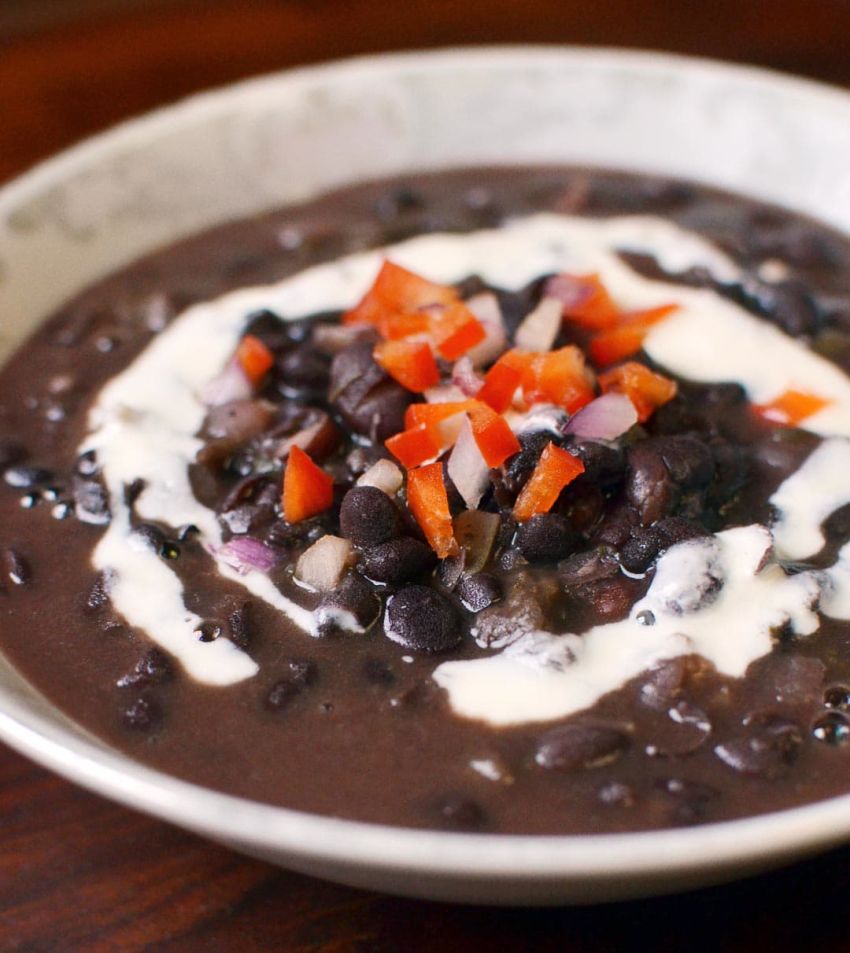
Cuban Sandwich
The sandwich is food you cannot miss while traveling in Cuba, a hot, crispy sandwich with pork, chicken, mojo sauce and cheese inside.
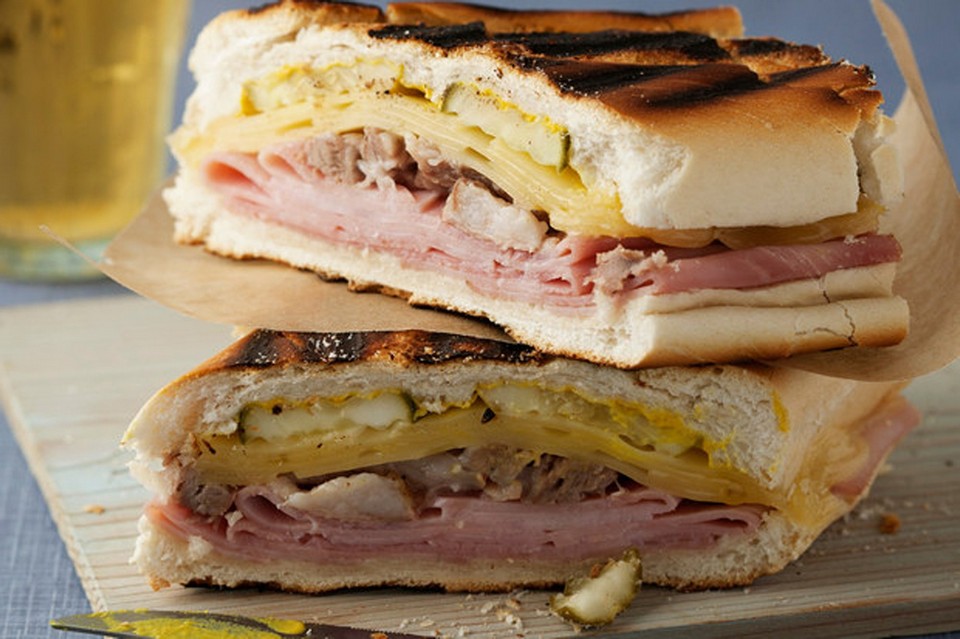
If you know about Vietnamese Youtiao (Fried Dough Sticks), Churros is similar, it is made from sugar, salt and flour then deep fried.

Guava BBQ Ribs
You really can’t resist this savory dish in Cuba. The ribs are marinated with a mixture of spices before being grilled to have a stronger aroma and flavor. The soft, fragrant ribs of garlic, chili, onion, and laurel leaves and poured with red BBQ sauce will awaken all your senses.
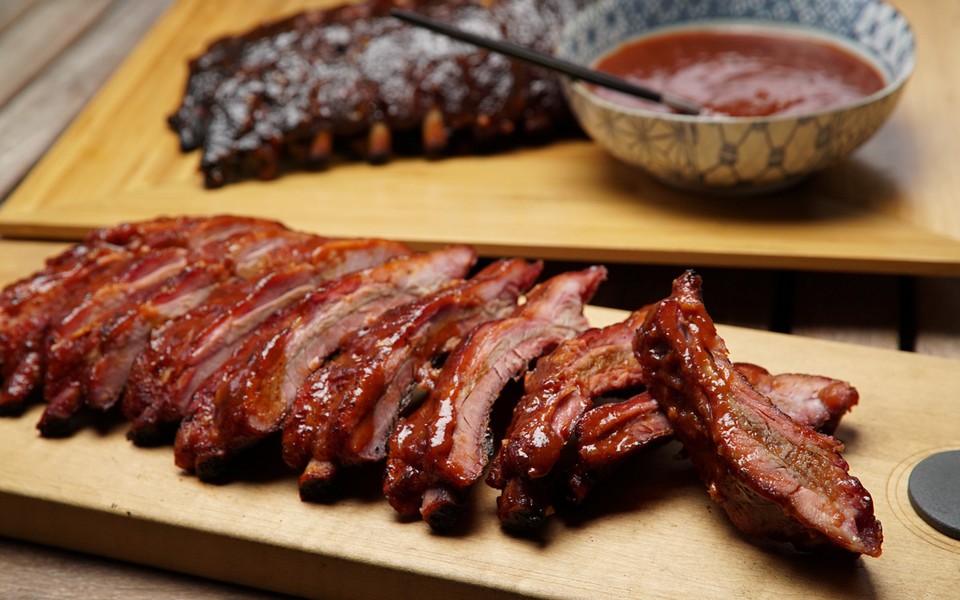
Try the Tamales corn cake once to make sure you will be fascinated immediately, it is a corn cake made from cornstarch, ground corn, minced pork and margarine. To make this dish, they will mix the cornstarch with minced pork, then wrap it in corn husks or plantain leaves, tie it tightly and boil in dilute salt water.
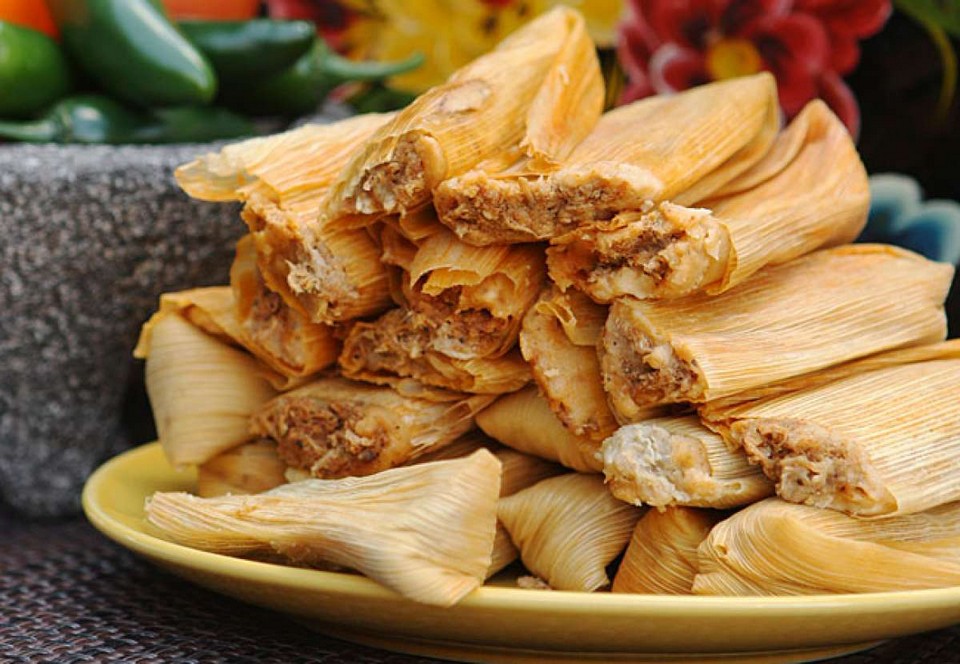
Tostone, also known as fried banana, is another favorite dish in Cuba. After slicing each piece to taste, the sliced banana will be seasoned and fried through 2 times of oil. The first time it will fry quickly that the bananas are cooked evenly, the second time with deep fried to create a golden crust and crispy on the outside. When enjoying, it will be sprinkled with a little salt on top to create the balance flavor of the dish.
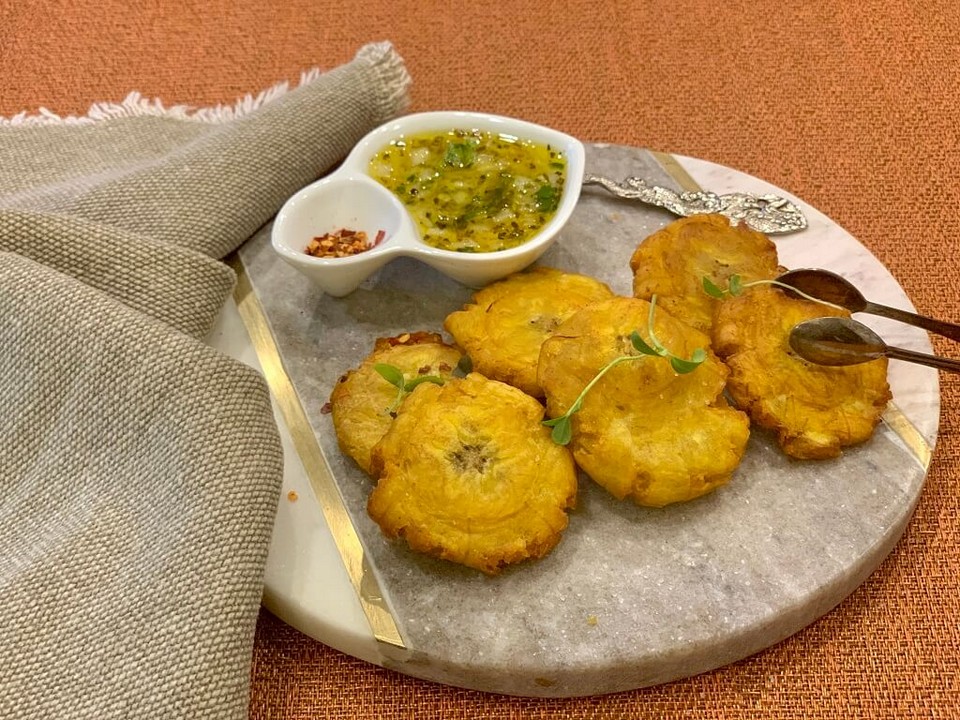
Paella Habana
This is a mixed seafood rice dish. The type of rice used for processing is rice paste, cooked with mussels, squid, shrimp, whole clams, peas, turmeric, etc.
The color of the dish is very eye-catching because of the bright yellow of turmeric along with the green color of vegetables and the red color of seafood. In addition, seafood also makes the rice taste sweet, the more you eat it, the more you like it.
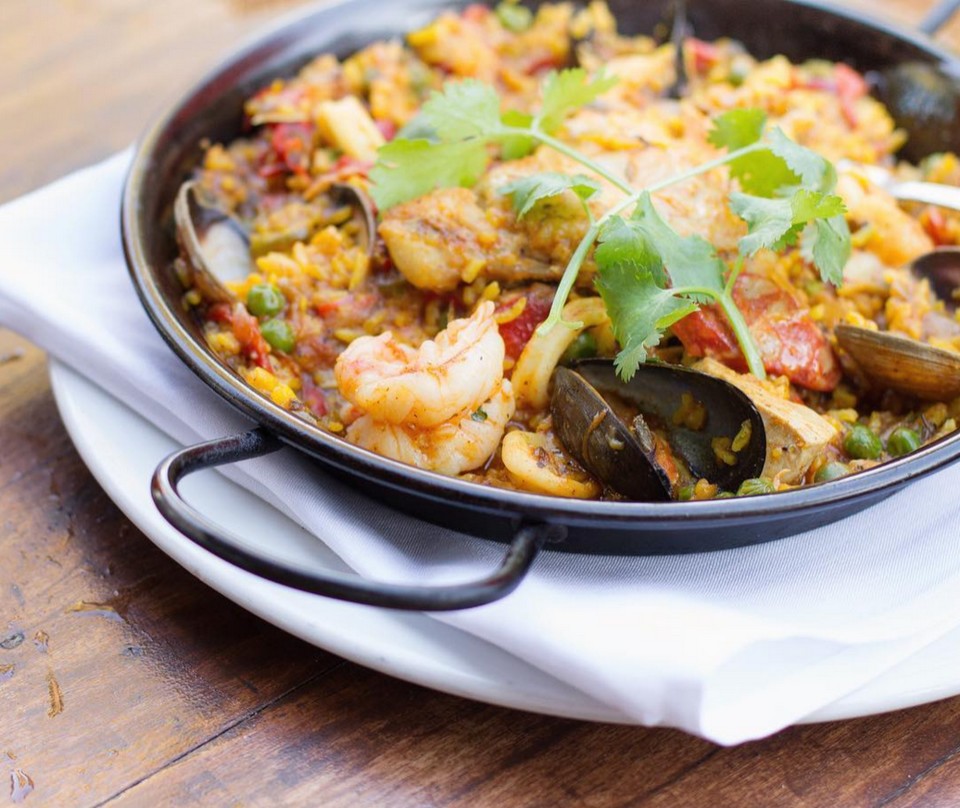
Mojito Cocktail
Mojito is a very famous drink in Cuba. This drink is a wonderful blend of Rhum liquor and lemon soda with mint leaves, a bit of salt to creating a very seductive taste.
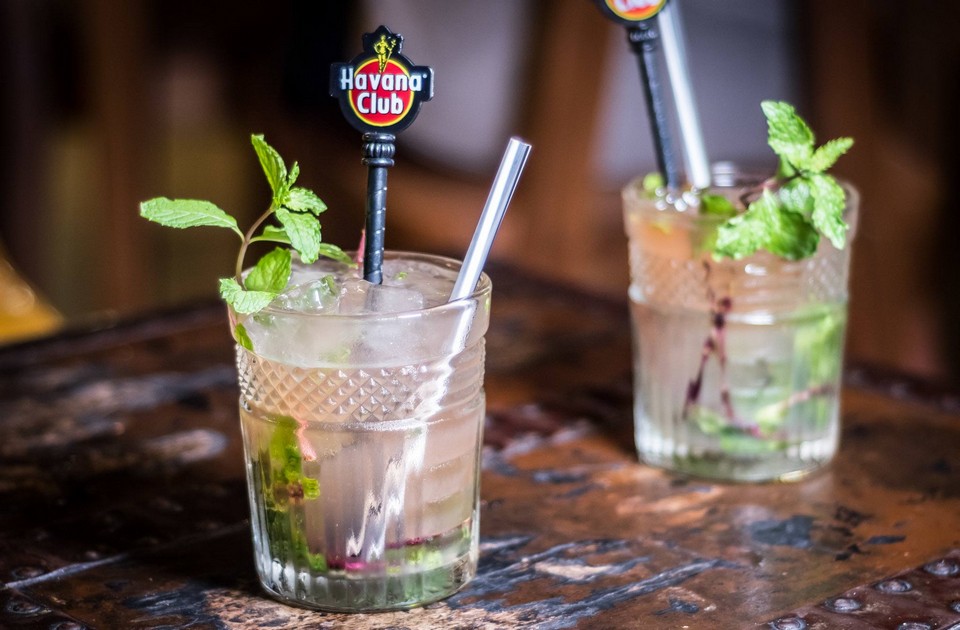
Havana blog: What to buy as a gift when traveling to Havana?
Rhum liquor.
While was still a colony, Cuba was considered the most delicious and famous producer of Rhum in the world. That is why Cuban Rhum brand has a certain position in the world spirits market. Referring the best Rhum, it is Rhum Bacardi Gold. Thanks to its excellent quality, Rhum Bacardi Gold is selected to create a wide range of fine cocktails, mixed with soda or used as ingredients for baking and seasoning. It possess a very distinctive amber color, with unique flavors of vanilla, banana, caramel and oak perfume.
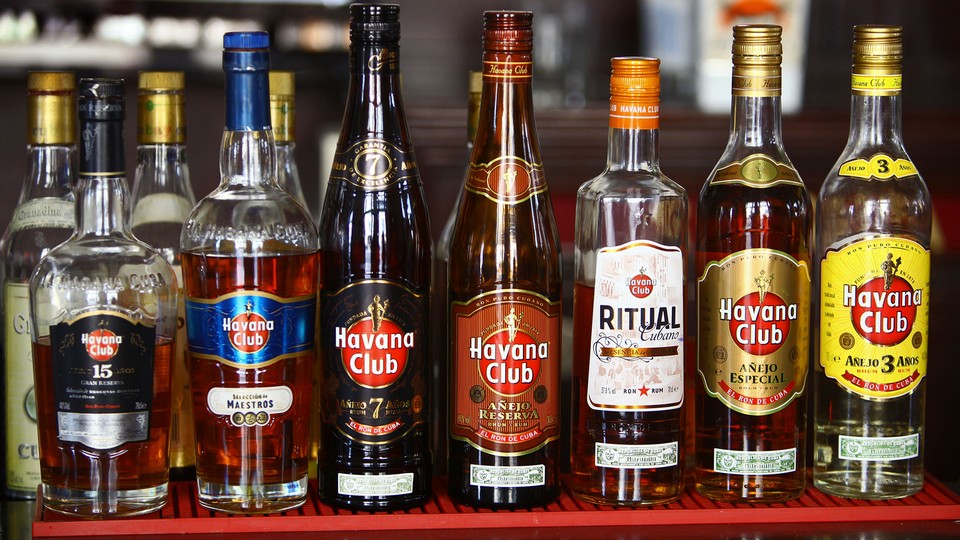
Rhum is a perfect gift to bring back. If you want more choices, you can look to supermarkets in Cuba to buy many types of Rhum such as Añejo blanco, Añejo 3 años, Añejo especial, Añejo Reserva, Añejo 7 años, etc …
Cigars are what I think of right after Rhum, because it is a characteristic of Cuba. Cuba has long been known for the most famous tobacco farms in the world, especially Cuban cigars possessing a very special taste, delicious and unlike any other cigars. If you have a loved one who loves cigars, then there is no reason not to bring a few boxes as gifts, affordable but meaningful.
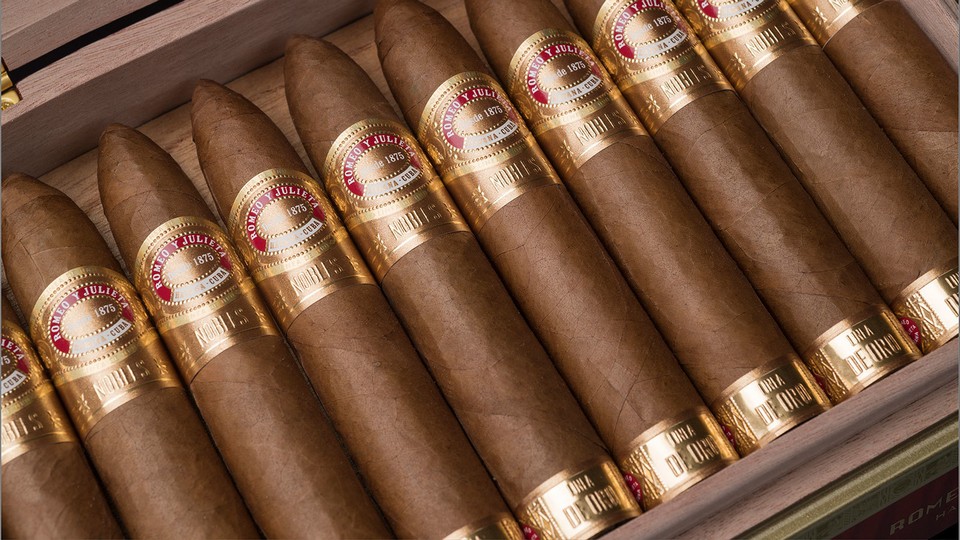
As you may not know, there are many paintings in Cuba, because Cuba is also a country with a large number of artists that no Latin American country can keep up with. To choose to buy paintings, you should go to Havana Vieja (Old Havana), where you will see thousands of colorful paintings. You can choose a painting you like or ask the artist to paint a picture according to your idea, they will be very happy.

Clothes and caps with Cuban icons
Show your love for Cuba by buying hats and shirts with Che Guevara portrait or “In Love Cuba” words. T-shirts, hats are probably the most chosen gifts in Cuba. Latin-style shirts are comfortable and simple, but also very polite. You can choose from a variety of styles from casual to high-end.
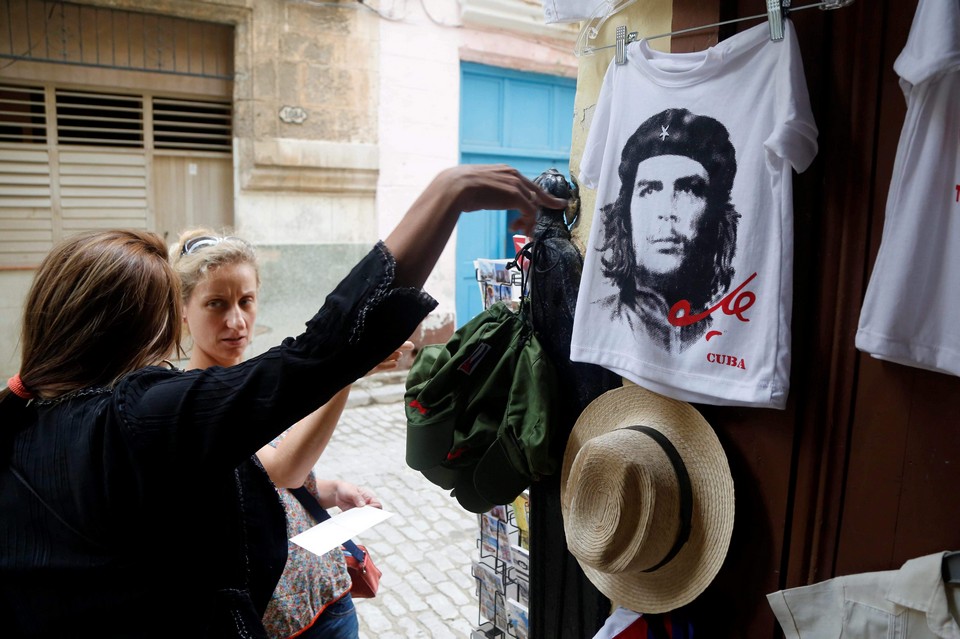
Souvenirs, handicrafts
If you want to buy souvenirs, you can choose bracelets, cigar boxes or vintage car models, all of which are meticulously carved by Cuban artisans. In addition, Cuba also sells a lot of things such as Wine Racks, Wine Bottle Stoppers, etc … Or Cuba also sells a lot of effective drugs and food supplements such as vidatox, marine drugs, algae, ppg, etc.
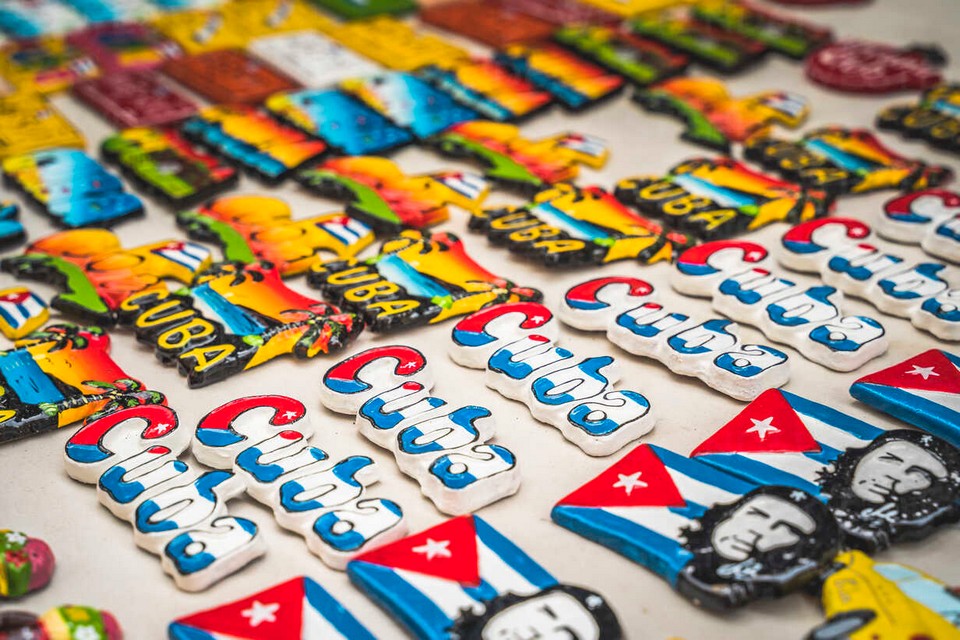
Havana travel blog: Where to stay?
When you book Cuba package tours, they will book 3-4 star hotel for you. But if you traveling alone, you should choose to stay in a homestay. However, those will be the rooms are rented out by Cuban families, the price will be very affordable.
Cuba is very lack of 5-star hotels. If you have a abundant budget, you should think about book luxury hotel rooms or resorts, with more expensive room rates, but there will be premium services.
Below we recommend more best cheap, budget, mid-range and upscale hotels with good ratings and reviews you can refer to.
- Saratoga Hotel , a top rated 4-star hotel with room rates from $213/night (Check rates Booking.com ).
- Hotel Boutique Casavana , a top rated 4-star hotel with room rates from $79/night (Check rates on Booking.com ).
- Havana Dream , a top rated 5-star hotel with room rates from $170/night (Check rates on Booking.com ).
- Residencia Santa Clara , a top rated 4-star hotel with room rates from $80/night (Check rates on Booking.com ).
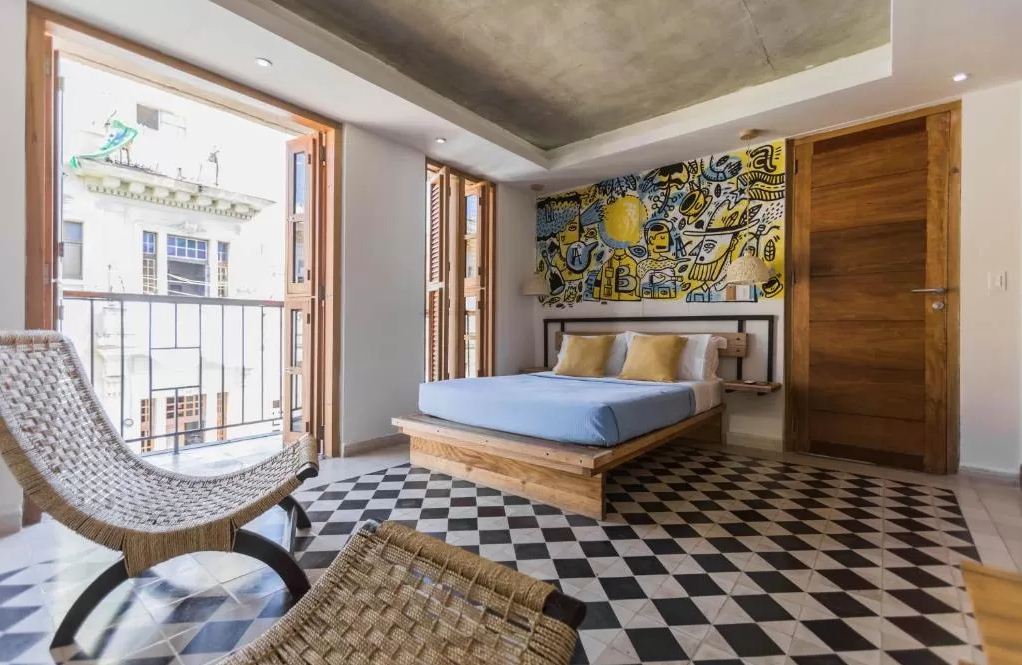
Not being invested in tourism as much as like other countries in Asia, in fact, hotels in Cuba are not very luxurious and comfortable. This is also partly due to the results of war. In return, the people are quite friendly, hospitable and the living space is relatively cozy. You can choose between a state-run hotel or a casa (homestay) depending on your needs and financial conditions. That is also the reason that when traveling to Cuba, you should not ask for a luxurious and modern accommodation. However, you still possible to book beautiful rooms but the price is not too expensive. You can find more hotels in this city on Booking.com .
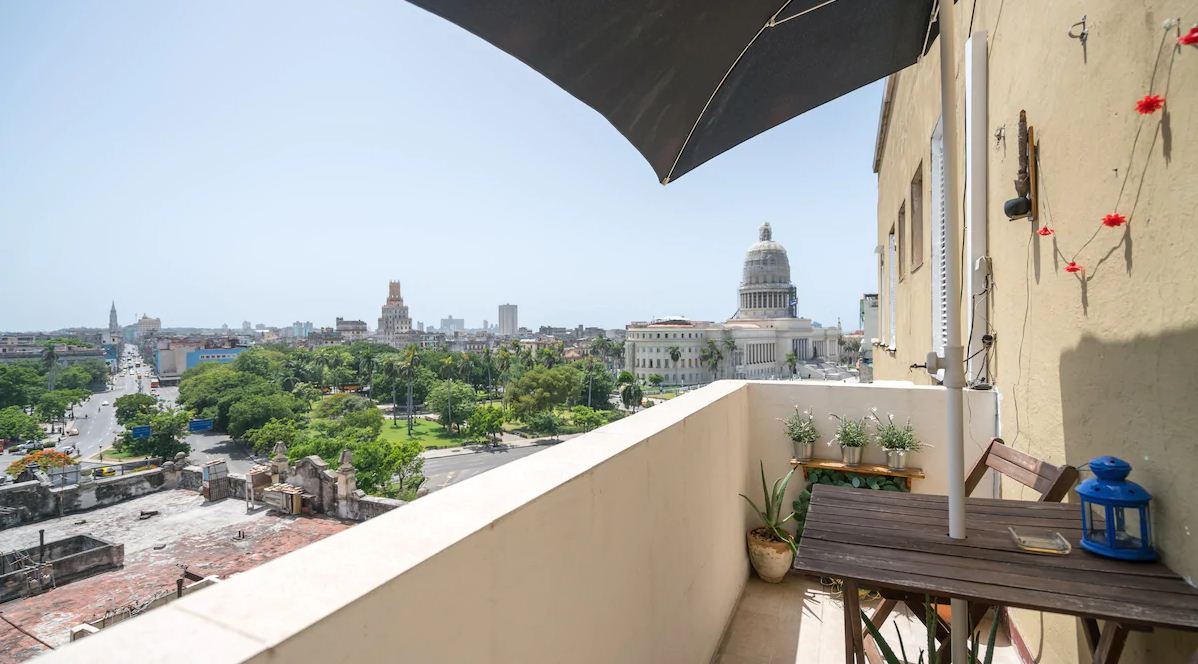
Some best day tours, trips, activities and transfer services, tickets in, from and to Havana you can refer to
- Havana City Tour
- Welcome to Havana: Private Tour with a Local
- Havana: Full-Day Tour From Varadero
- Discover Old Havana: Small Group Walking Tour with Lunch
- Havana: Panoramic City Tour with Lunch
- Havana: Ernest Hemingway Tour with Cocktails and Cuban Lunch
- Havana: Old Havana Walking Tour with Cocotaxi Ride
- From Havana: Trinidad and Cienfuegos Private Tour
- Havana: On the Trail of Ernest Hemingway Tour
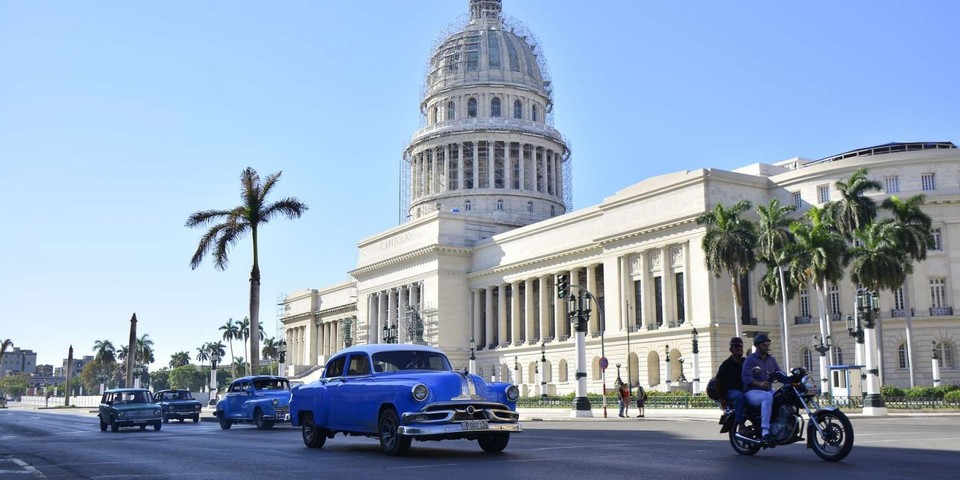
Are you looking for more top things to do in Havana: Tours, activities, attractions and other things? Let’s check it out here .
Related articles
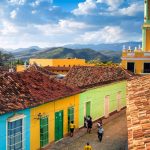
RELATED ARTICLES MORE FROM AUTHOR
Leh ladakh bike trip itinerary — how to spend 6 days in ladakh by motorbike, leh ladakh bike trip blog — ladakh bike trip guide & tips for first-timers, guide to shenzhen nightlife — top 5 things & what to do in shenzhen at night, ladakh trip cost per person from delhi — how much does ladakh trip by bike cost.
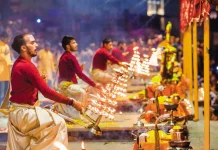
India travel tips — 25+ what & things to know before traveling to India
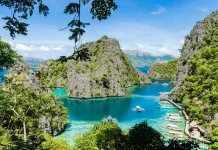
Coron itinerary 5 days — What to do & how to spend 5 days in Coron?

Arashiyama travel blog — The fullest Arashiyama travel guide with top things to do in Arashiyama
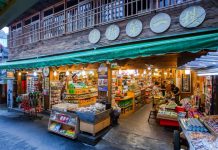
Explore Fenqihu old street — What to do in Fenqihu in a day trip?

Where to go in Kunming? — 15+ top Kunming attractions & best places to visit in Kunming
Editor picks.

Leh Ladakh bike trip itinerary — How to spend 6 days...

Leh Ladakh bike trip blog — Ladakh bike trip guide &...

Guide to Shenzhen nightlife — Top 5 things & what to...
Popular posts.

What to buy in USA? — 17+ must buy in USA...

Must buy souvenir in Taiwan — Top 17+ most famous, cheap...

Must buy in Korea — Top 23 cheap, famous & best...
Popular category.
- Inspiration + Guide 1461
- Trip Inspiration 468
- Thailand 209
- Food + Drink 208
- Coasts + Islands 193
- South Korea 168
- Vietnam 166
- Travel Photos 144
- Work for Us
- Terms & Conditions
- Privacy Policy
M anifesting trave l
Cuba travel blogs, cuba's all-inclusive paradise: a guide to cayo coco.

Playa Santa Lucia: the secret Cuban beach only the locals know about

Viñales, Cuba Travel Guide

The best farm to table and agritourism experience in Viñales, Cuba

Tobacco Field Tours and Cigar Rollers in Viñales, Cuba

Cave exploring and mystical underground lakes in Viñales, Cuba

C uba travel blog s
Thanks for subscribing!
S ubscribe to our lis t
There is a rhythm in Cuba, a current, or maybe it’s a heartbeat. It runs down the center of the island and through the veins of its people. You can see it in their smiles, hear it in their music and feel it on the streets of Havana where the grand old mansions sit and decay. Cuba is a mystery to most and a daydream for many, with soft, sugary sands and the most sparkling waters you’ve ever seen lining the beaches of Varadero, Cayo Guillermo and Cayo Coco. But it’s also a place of stark contrasts, cities like Camaguey with its labyrinth-like streets and the colorful cobblestone village of Trinidad expertly portray both grit and grace. If you’re manifesting a trip to Cuba, picture images of fourth-generation tobacco farmers, tilling their lands along the lush green mogotes in Viñales, the colonial cathedral in Santiago de Cuba, sultry carnival festivals that take place all over the island and the millions of crimson crabs who flood the roadways in their annual migration to the Bay of Pigs. The island is home to a plethora of protected ecosystems, including wetlands, waterfalls, rainforests, mangroves and some of the most unspoiled coral reefs in the entire world. It’s estimated that nearly 22% of the island is protected by conservation efforts, making it the most environmentally safeguarded island in the entire Caribbean.
- Best time to visit Cuba
Book your individual trip , stress-free with local travel experts
- roughguides.com
- best-time-to-visit-cuba
Plan your tailor-made trip with a local expert
Book securely with money-back guarantee
Travel stress-free with local assistance and 24/7 support
written by Joanne Owen
updated 25.04.2024
Boasting a bounty of beautiful beaches, along with extraordinary wildlife-watching experiences, adventure opportunities and festivals, Cuba has much to commend it whenever you visit. That said, the best month to visit Cuba depends on what you most want to do, and your budget, along with your opinion on the likes of tourist numbers, and the potential risks of the hurricane season. With these factors in mind, here we present the best time to visit Cuba from different perspectives. One thing’s for sure, Cuba is the kind of sparky destination that first-timers often find themselves longing to return to.
- Overview of weather and tourist seasons
December and January — best for winter sun and high season vibes
February and march — best for outdoor adventure, april and october – best for shoulder-season balance, may, june and september — best for budget travellers, july and august — best for high energy cuban culture, overview of weather and tourist seasons .
Cuba has a tropical climate, with a November-April dry season , and a May-October wet season. Though the dry season is generally considered to be the best time to visit Cuba, note that downpours are often (but not always...) short-lived in the wet season, and temperatures are high.
- The Atlantic hurricane season runs from 1st June through to 30th November, with September and October often being peak months for tropical storms and hurricanes.
- Coinciding with the dry season, Cuba’s tourist high season runs from November to April, though visitor numbers often drop-off from — and through — April.
- The wet season months of June, July, August and September see low season levels of crowds, and corresponding lower costs, with visitor numbers increasing through October as a drier period beckons.
- It’s also worth knowing that while July and August see smaller numbers of international visitors, these months are busy for local tourism.
They're also the hottest months of the year — worth bearing in mind when planning your Cuba itinerary , along with the factors detailed below.

Cayo Coco, Cuba © Shutterstock
Kicking off with the obvious, according to a huge number of travellers, the best time to visit Cuba is during the peak high season months of December and January.
Given that these months sit in the region’s dry season — at a time when many of us are seeking respite from colder climes — visitors to Cuba in December and January can expect gloriously sunny, rain-free days.
With warm temperatures sitting comfortably below the sizzling heat of summer, these are arguably the best months for enjoying the best beaches in Cuba .
At the same time, December and January being high season months means major tourist hubs (among them Havana , Varadero and Guardalavaca ) will be busy with like-minded travellers hoping for fun in the sun.
Beyond the entertainment offered by tourist resorts, this time of year sees Cuba stage a number of major festivals that are worth visiting for in their own right.
For example, Havana hosts an international film festival in December. Come January, celebrated jazz festivals take place in both the Cuban capital and Santiago de Cuba .
The flipside of these attractive reasons to visit Cuba in December and January are the usual high season trappings. By which we mean higher costs for flights and accommodation, packed attractions, and busy beaches.
That said, you could always opt to explore lesser-travelled paths on an independent backpacking adventure, or on a customised Cuba itinerary that’ll take you off the beaten track .

Love film and music? December and January could be the best time to visit Cuba for notable festivals in Havana © Shutterstock
Though still sitting in the dry high season, February and March see visitor numbers drop-off from their December and January peak. These months also offer optimal conditions for diving and snorkelling.
The same is true of hiking and biking. Being cooler than the heady heat of summer, but still dry and warm, these are top months to explore the country’s wilder walking trails. They're also a great time to take advantage of Cuba’s relatively car-free roads on a cycling trip .
On the subject of cycling, if that kind of active trip sounds appealing, take inspiration from our customisable Bike Cuba itinerary, or our longer Western and Central Cuba by e-bike itinerary.
Bird-watchers, note that this time of year sees over 260 migratory species flock to Cuba. Ciénaga de Zapata in the Matanzas province, and Peninsula de Guanahacabibes in Pinar del Rio are notable hotspots.
Editor’s tip: travelling with kids? Check out our Active Adventure Family Trip .

Visit Peninsula de Zapata in February and March for amazing birdlife © Shutterstock
If you’re looking for a balance between high season crowds, warm weather and more moderate rainfall, April might be the best time for you to visit Cuba.
Sitting at the end of Cuba’s main high season — though Easter sees a spike in visitor numbers — April is quieter than January-March. It’s also cheaper and warmer than the preceding months, and drier than the months that follow.
Nature-lovers will also want to note that turtle-watching season kicks off at this time of year. For example, if you visit Cayo Largo between April and September, you might just get to see loggerhead, hawksbill and green turtles come ashore to nest.
A similar kind of balance can be had in October, which isn’t as hot and humid as June-September. Bargains can often be had in October, too.
Just be mindful of the fact that the official hurricane season runs until the end of November.

Playa los Cocos. Cayo Largo. Cuba © Shutterstock
While Cuba is eminently do-able on a modest budget around the year — especially if you stay in casas particulares — May, June and September offer the biggest bargains.
With these months still sitting in turtle season, they especially suit nature-lovers who are keen to curtail costs. Also note that a second bird migratory season takes place from September to November.
As a bonus, May sees Holguin stage Romerias de Mayo. Presenting performances from local and international musicians, along with parades, dance and art shows, it's fair to say this traditional religious festival has been given a modern makeover.
Meanwhile, the fabulously flamboyant Fiestas San Juaneras takes place in Trinidad at the end of June.
Again, be aware these months sit within the wet season, so expect rain showers and high humidity. Also note that tropical storms and hurricanes are a possibility in June, and more so in September.

Trinidad, Cuba © Shutterstock
Though low season months for international tourism, July and August see an increase in domestic tourism. At the same time, temperatures rise to their annual peak.
In terms of the numbers, average daily highs typically hit 32-34 º C in August.
Hosting two major cultural events, July is an especially great time to visit Santiago de Cuba . First up, Fiesta del Fuego — a three-day fire festival, which is held in early July.
Officially known as the Festival del Caribe, this sees the city transformed into the stage for all manner of costumed parades, performances, and giant congas through the streets.
Stick around until the end of July and you’ll also get to experience one of Cuba’s liveliest events — the Santiago de Cuba carnival.
Come August, Havana hosts its own carnival, while Varadero’s Josone Music Festival showcases the talents of top jazz and son Cubano musicians.

Santiago de Cuba © Vadim Nefedoff/Shutterstock
Whenever you decide is the best time for you to visit Cuba, wise up on the best things to do in Cuba , and get yourself The Rough Guide to Cuba to help plan your trip.
Not keen on planning? Browse our customisable Cuba itineraries , or talk to our local experts .

Joanne is a Pembrokeshire-born writer with a passion for the nature, cultures and histories of the Caribbean region, especially Dominica. Also passionate about inspiring a love of adventure in young people, she’s the author of several books for children and young adults, hosts international writing workshops, and has written articles on the Caribbean and inspirational community initiatives for Rough Guides. Follow her @JoanneOwen on Twitter and @joanneowenwrites on Instagram.
- Travel Advice
- Travel Tips
- Inspiration
Planning your own trip? Prepare for your trip
Use Rough Guides' trusted partners for great rates
Travel advice for Cuba
From travel safety to visa requirements, discover the best tips for traveling to Cuba
- Eating and drinking in Cuba
- How to get to Cuba
- Getting around Cuba: Transportation Tips
- Travel Tips Cuba for planning and on the go
Find even more inspiration for 60 here

Ready to travel and discover Cuba?
Get support from our local experts for stress-free planning & worry-free travels.
- Where to stay
- Itineraries
- Travel advice
A millennial Lyft driver who used the gig to explore all 50 states explains his strategies for maximizing earnings and tips
- Kreskin J. Torres, a Lyft driver, has traveled across all 50 states, documenting his dining experiences.
- Torres is working on a book, an app called Rideshare Foodies, and is organizing a national potluck.
- He said gig driving is just temporary and has helped him achieve his larger goals.

Kreskin J. Torres, 35, has eaten his way through all 50 states — including Alaska and Hawaii. His ticket to doing so? Driving for Uber and Lyft .
The Army veteran and Baltimore native has documented his dining on his blog Rideshare Foodie . After seven years, he's learned the most profitable times of day to drive, the best locations to find riders in each city and the optimal strategies for maximizing tips .
"You just got to work smarter, not harder," Torres said. "From my experience, I've been in every state, so I know how every city works now."
At the same time, he's been able to pursue his foodie passions. Torres is now working on a book called "Taste of the States," his recommendations app called Rideshare Foodies, and planning a series of events to honor dishes from various states and their history.
While driving for ride-hailing services like Uber and Lyft can be a flexible way to earn money for people like Torres who have more than one hustle, it can also be a recipe for burnout. Among the dozens of drivers Business Insider has spoken with over the past few months, many are already dreaming of what's next — starting a business or finding new modes of employment .
And that's Torres' main career advice for those considering it. After all, he's not planning to do the job forever, as he hopes to transition away, though it helped him jump-start new paths for his future.
"Do not make this the end all be all," Torres said, noting how Uber and Lyft have threatened to pull out of Minneapolis. "When it started, it was advertised as a gig, a side hustle."
Traveling the country as a gig driver
As a veteran, he said this job has been relatively stress-free and helpful for not feeling lonely, a similar sentiment he's heard from veterans with PTSD.
"I enjoy meeting and connecting with different people and getting to see different places," Torres said.
He decided to spend his next few years on the road using driving to fund his adventures and to meet locals who could point him to the best restaurants and experiences.
"The great thing is you get to learn about different cities and how everything operates," Torres said.
Related stories
He moved to San Antonio , though he works mainly around the more-profitable Austin area, and has explored the South and Southeast.
While he doesn't make much money from his blog, he said driving has allowed him to try everything from Navajo tacos in Arizona to biscuits in chocolate gravy in Arkansas to huckleberry swirls in Montana. Driving has led him to some of his favorite restaurants like I693 Red Zone Grill in Jackson, Mississippi; Strawberry's BBQ in Holcomb, Missouri; and Rice & Roll by Xing Xing in Wichita.
Learning the most profitable places and times to drive
Torres noticed he would get more profitable rides driving around suburbs, airports, and sports stadiums, locations coveted by drivers as they get more tips and sometimes elevated fares.
He learned New Year's will always be profitable , though rides slow down around February before picking up in mid-March. It's led him to be more methodical about the types of rides to take, as well as planning when to save more of his earnings and when to splurge a little on food and travel.
"After seven years, I'm a lot more experienced. It depends on the time of the season, so I usually can do a lot more business in college towns," Torres said. "I would visit a city, see what they're known for, a little history behind it."
Torres was making enough to comfortably travel the country, though he's always been careful since he said passengers are sometimes confused by his out-of-state license plate. He also faced a permanent deactivation from Uber last year over a dispute over the color of his car.
He doesn't have a wife or kids, nor does he have an apartment, as he mainly lives out of his car to save money. He acknowledges that growing competition on the road and lower earnings could put a greater dent in savings for people with families or permanent residences.
Torres has transitioned to driving full-time for Lyft , and he typically is online for 12 hours a day but only actively drives five to six hours in between waiting around airports.
He said he's increasingly put himself in his passengers' shoes to determine the best places and times to drive — he likely won't put in the effort to drive during rain, and he's more likely to do later trips around concert venues or bars.
To continue supporting his travels, he said he sometimes does airport rides at 3 or 4 a.m., as well as rides between 6:30 a.m. and 10 a.m. during the morning rush. He also said being online around noon is fruitful for corporate workers, while 3 p.m. is right when schools let out. He usually tries not to drive around evening rush hours but sometimes resumes later at night.
He also devotes more time to driving between Wednesday and Sunday, when rides are more frequent, whether for "whiskey Wednesdays" or Friday afternoon happy hours. This is also when he can best network with passengers and hear their stories, as he said he occasionally gets to drive famous people.
Torres said drivers should consider this a short-term opportunity while working toward long-term goals. As he eases off the app, he has his eyes set on more international travel in the coming months. He's also investing more time in his food app, a local recommendation tool that functions like a Facebook group in which people ask questions about, for example, the best bartender in the area or where to go for particular dishes. It has launched on Android and set to be released on Apple by the summer.
"The most positivity that you can get out of it, do whatever you can and get the most out of it," Torres said. "The next few months will probably be my last time doing this because I'm focusing on other things, so I always had a plan for the things I was going to do."
Are you a ride-hailing driver who's struggling to pay bills or has had recent success? Have you recently pivoted to a new career from driving? Reach out to [email protected] .
Watch: How 'Grand Theft Auto' actually works, according to a former car thief
- Main content
- FANNATION FANNATION FANNATION
- SI.COM SI.COM SI.COM
- SI Swimsuit SI Swimsuit SI Swimsuit
- SI Sportsbook SI Sportsbook SI Sportsbook
- SI Tickets SI Tickets SI Tickets
- SI Showcase SI Showcase SI Showcase
- SI Resorts SI Resorts SI Resorts

Stiles Points: Last Season's Play-In Tournament Trip Could Prove Large Saturday for OKC Thunder
The Oklahoma City Thunder's play-in tournament win last season could loom large on Saturday.
- Author: Rylan Stiles
In this story:
The Oklahoma City Thunder have heard about their inexperience all year long. It is one of two concerns any consumer can raise about a 57-win team in the toughest conference the NBA has ever seen.
On Saturday, the team will embark on another first for this young group - their first playoff round game. Though, that is a bit of a technicality.
For all the hoopla that will follow Oklahoma City this postseason as they enter their year of firsts, the only place they have experience is inside the Smoothie King Center.
The exclamation mark on the 2022-23 season for the upstart Thunder is their play-in tournament win over the New Orleans Pelicans last April. Fighting their way through a sea of red to eliminate the Pelicans from the posteason.
Despite falling the next game in Minnesota to end a game shy of their first trip to the NBA Playoffs, the Thunder earned valuable experience on the road in a high stakes game.
Despite the rocking atmosphere in the Bayou, the Thunder weathered the storm and now knows what it takes to win in NOLA.
Without getting caught off guard by the road crowd, a win on Saturday afternoon would almost assure a series victory. In what is a pseudo must-win contest for the Pelicans as no team has ever mounted a 3-0 comeback.
Stiles Points
- The OKC Thunder have envisioned their position-less model for years and are now taking advantage of the league-shifting .
- Former Thunder first-round pick Darius Bazley explained what separates Shai Gilgeous-Alexander from other players in a recent podcast. This is yet another person who praises the Thunder stars work ethic.
- Saturday's game represents another early tip time which has been a boogeyman for the Thunder this season. Mark Daigneault sounded off on how they will handle it .
- What is the rule of thumb for the aux in a road trip that features vastly different music taste? It should be a universal law - the driver gets to pick the tunes.
Song of the Day: Louisiana Saturday Night by Mel McDaniel.
Want to join the discussion? Like Inside the Thunder on Facebook and follow us on Twitter to stay up to date on all the latest Thunder news. You can also meet the team behind the coverage.
Latest Thunder News

Thunder Trio Leads OKC to Close Win Over Memphis Grizzlies

Jalen Williams and Chet Holmgren Among League’s Most Efficient Shooters

OKC Thunder Superstar Shai Gilgeous-Alexander Secures Super Max Contract Extension Eligibility

Injury Report, Updated Odds (3/16): Memphis Grizzlies vs OKC Thunder

Injury Report: Oklahoma City Thunder vs Memphis Grizzlies
Carnival cruise ship rescues nearly 30 people from adrift vessel

A Carnival Cruise Line ship rescued nearly 30 people who were stuck at sea on Sunday.
The crew on Carnival Paradise saved 28 Cuban nationals who were signaling for help on a vessel that was adrift around 2:30 p.m. The cruise ship was headed from Tampa, Florida, to Roatan in Honduras at the time.
“The bridge team onboard spotted the vessel and turned the ship around to rescue them,” Carnival said in a news release . “All were taken aboard, given food and were seen by the medical team.” The cruise line also notified the U.S. Coast Guard Sector Key West and officials in Roatan.
The Coast Guard did not immediately respond to USA TODAY’s request for comment.
The ship was set to visit Roatan on Monday. Carnival Paradise is on a five-day Caribbean cruise that departed from Tampa on Saturday, according to CruiseMapper .
The news comes after Celebrity Cruises’ Celebrity Apex ship rescued seven people in a small vessel adrift between Cuba and Mexico earlier this month. Another Carnival ship, Carnival Jubilee, also rescued two people stuck in a kayak off the coast of Mexico’s Isla Mujeres in January.
Nathan Diller is a consumer travel reporter for USA TODAY based in Nashville. You can reach him at [email protected].
- Share full article
Advertisement
Supported by
What to Know About Venice’s Fees for Day Trips
Venice is trying to mitigate overtourism with a small fee on busy days. City leaders hope it will make visitors more aware of the city’s fragility.

By Elisabetta Povoledo
Reporting from Rome
After years of debate , Venice on Thursday began charging day visitors five euros to visit its fragile historic center on peak days, making it the first city in the world to adopt such a measure to counter overtourism.
Critics question whether a nominal fee will put people off from visiting one of the world’s most desired destinations. But officials hope that it might encourage some to rethink their plans and decide to come on weekdays or in the off-season.
That might help mitigate the impact of the estimated 20 million visitors who descended last year on the city’s beleaguered residents, who number fewer than 50,000, according to municipal statistics . About half of those visitors came only for the day, city officials said. Overnight guests are exempt from the fee.
The spirit of the initiative, city officials have said, is to make people aware of the uniqueness — and fragility — of Venice. Overtourism is creating an economy solely based on tourism that risks killing the city by pushing its dwindling residents out, said Nicola Camatti, an economics professor and expert in tourism at Ca’ Foscari University of Venice.
When will Venice start charging?
The fee went into effect on Thursday, a holiday in Italy. For 2024, city officials have singled out 29 peak days when single-day travelers in Venice between 8:30 a.m. and 4 p.m. have to pay. The days run until mid-July and are mostly on national holidays and weekends. The access-fee website provides a list of the dates.
Who must pay?
While just about everyone visiting the city has to register to obtain a QR code, not all visitors have to pay the fee. Overnight guests at registered accommodations like hotels or Airbnbs are exempt, because they already pay a daily tourist tax, as are people who study or work in Venice and those visiting relatives. There are other exemptions as well.
Residents of Venice, those born there and minors under 14 are among those who do not have to register. But they must have documents that prove their status.
It is possible that different fees will apply next year on a sliding scale that will depend on how many people city officials expect on any one day. City officials said the fees could be as high as 10 euros per day.
How will the system work?
Before coming to Venice on peak days, visitors should use the website to register and get a QR code.
The code will be scanned at points where visitors enter, like the train station, the city parking lot, the airport and the sprawling waterfront along the San Marco basin where boats dock. The access points will have one line for tourists and another for residents and what officials call city users, who are coming into Venice for reasons other than sightseeing.
At least for now, those who do not register ahead of time can do so at some access points or on their cellphones, officials said. Assistants will be available.
Initially, the controls will be “very soft,” said Michele Zuin, the municipal councilor responsible for the city’s budget.
Speaking to reporters at the foreign press association in Rome this month, Mayor Luigi Brugnaro said the fee was not about cashing in on tourists. “The costs of the operation are higher than what we’re going to make,” he said.
Why is Venice doing this?
City officials hope to relieve some of the stress that tourists put on the city by encouraging them to come on less busy days. They also say that by knowing ahead of time how many visitors to expect, the city can better deploy services.
“We want to better manage the numbers of tourists and disincentivize mass tourism” that makes it difficult for residents and visitors to “live in this city,” Mr. Zuin said this month.
To track the flow of visitors, the city already monitors them via phone location data and surveillance cameras, a system some critics have likened to Big Brother .
Venice has also fallen under the scrutiny of the United Nations’ culture agency, UNESCO, whose experts are concerned that not enough is being done to protect the city. Last year, Venice risked being added to UNESCO’s list of Endangered World Heritage Sites after experts at the agency listed mass tourism , along with climate change and development, as a major threat to its future. It urged City Hall to take steps to ameliorate the damage.
The municipal council approved the access fee just days before UNESCO was to vote on its status, and Venice stayed off the “in danger” list . But UNESCO officials said in a statement that “further progress still needs to be made” to conserve Venice.
Critics of the access fee note that officials have not capped the number of visitors, and they say that the nominal fee is hardly a deterrent. As recently as Friday, city officials said that about 80,000 visitors swelled the city’s narrow calli, as the streets are known, and the gardens of the 2024 Venice Biennale , still the world’s principal place to discover new art .
How else is Venice trying to restrict visitors?
Venice also has taken other steps it hopes will reduce what city officials call “mordi e fuggi” tourism, or “eat and flee,” referring to those who seek the city’s greatest hits — the Rialto Bridge and St. Mark’s Square — and who bring packed lunches and dump their garbage, contributing little to the local economy.
After years of heated debate and protests by vocal Venetians, the city banned cruise ships from its inner canals in 2021 , though Mr. Camatti, the tourism expert, said the ban on the ships had not reduced the number of day visitors.
This year, the city imposed a limit of 25 people per tour group and also banned the use of megaphones.
Elisabetta Povoledo is a reporter based in Rome, covering Italy, the Vatican and the culture of the region. She has been a journalist for 35 years. More about Elisabetta Povoledo

- PlayStation 5
- PlayStation VR2
- PlayStation 4
- PlayStation Store
- PlayStation Plus
- Portuguese (Br)
- Spanish (LatAm)
- Spanish (EU)
- Traditional Chinese
Join PlayStation Tournaments: Road to Evo and watch Evo Japan

Play for a trip to Evo in PlayStation Tournaments: Road to Evo and watch Japan’s premier fighting game tournament.
As we near the end of April, the fighting game scene truly begins to heat up. From April 27 to 29, the best of the best will gather in Tokyo to crown an Evo Japan champion. Then, players will gather for the world’s premier fighting game event, Evo 2024 in Las Vegas. Through the PlayStation Tournaments: Road to Evo program, players can compete at home and join online competitions for a chance to win a trip and showcase their skills at Evo 2024 in Las Vegas.
Win a trip to compete at Evo 24 in Las Vegas in PlayStation Tournaments: Road to Evo 2024
We’re excited to announce details for Road to Evo 2024 on PS5 Tournaments. Players worldwide are invited to compete to win a round-trip ticket to Evo in Las Vegas and play on the biggest stage in fighting games.
Road to Evo 2024 will feature Street Fighter 6, Tekken 8, Guilty Gear -Strive-, Mortal Kombat 1, The King of Fighters XV on PS5. Six regions are eligible to compete: North America, Europe, East Asia*, ANZ, and MENA. In the end, 15 PlayStation competitors will be given the opportunity to travel and compete in Las Vegas.
Players who join the PlayStation Esports Discord between April 25 to May 9 will earn a unique Evo-themed PlayStation Network avatar. To join the Discord channel, click here.
Last year’s Road to Evo champions accomplished some incredible feats battling through online and in-person challengers to reach the world’s biggest stages. We followed their journey all the way from their PlayStation consoles to the largest Evo of all time. Watch their inspiring story in this new documentary.
Evo Japan starts this weekend
The fighting game community’s eyes will be on Tokyo this weekend as players compete in Tekken 8, Street Fighter 6, Guilty Gear -Strive-, The King of Fighters XV, Under Night In-Birth II [Sys:Celes], Granblue Fantasy Versus: Rising and Street Fighter III: 3rd Strike.
Evo Japan marks Tekken 8’s first major tournament and will also feature the return of the fan-favorite Street Fighter III: 3rd Strike. Tune into the English stream on Evo’s Twitch channel from April 27th to April 29th. You can also compete at home in Tekken 8, Guilty Gear -Strive-, and The King of Fighters XV through PlayStation Tournaments on PS5.
Get ready for Evo 2024 in Las Vegas
From July 19th to July 21st, the biggest weekend in fighting games will commence at Evo 2024 in Las Vegas.
The weekend will feature the genre’s biggest titles, including new Evo debuts like Tekken 8, Mortal Kombat 1, Under Night In-Birth II [Sys:Celes], and Granblue Fantasy Versus: Rising. Street Fighter 6, Guilty Gear -Strive-, and The King of Fighters XV will also return to the Evo stage, and community classic Street Fighter III: 3rd Strike returns to Evo for the first time since 2009.
This year also features Evo in a new venue: The Las Vegas Convention Center. Fans can expect enhanced versions of the activities and experiences that define the show. Read more about the Evo attendee experience here. For those at home, you can watch Evo live on Twitch and YouTube.
We can’t wait for what Evo 2024 will bring, and we hope you’ll join us. Tickets are on sale now. See you there!
*Eligible East Asia territories are limited to Japan, South Korea, Hong Kong, Taiwan
Did you like this? Like this
Share this story
Join the Conversation
But don't be a jerk!
Please be kind, considerate, and constructive. Report inappropriate comments to [email protected]
Leave a Reply Cancel reply
You must be logged in to post a comment.
Trending Stories

PlayStation Plus Game Catalog for April: Dave the Diver, Tales of Kenzera: Zau, The Crew 2 and more

Adam Michel Director, Content Acquisition & Operations, Sony Interactive Entertainment
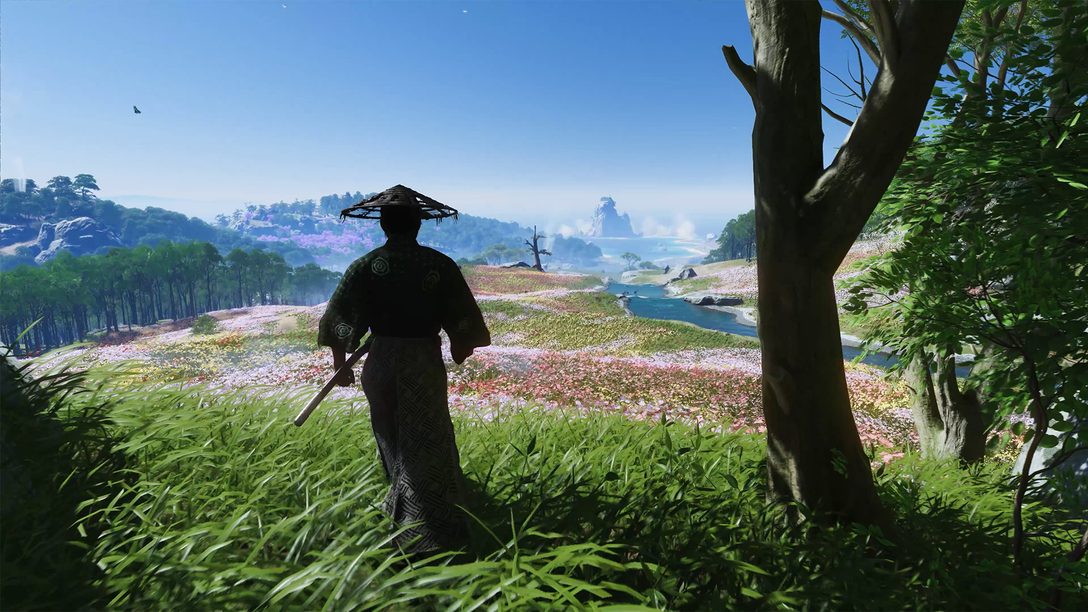
Ghost of Tsushima Director’s Cut PC cross-play and system requirements revealed

Julian Huijbregts Online Community Specialist, Nixxes Software

Helldivers 2 gets an explosive new Warbond on April 11

Katherine Baskin Social Media and Community Manager, Arrowhead Game Studios

May Savings promotion comes to PlayStation Store
Zack Garvey Digital Promotions Specialist, Sony Interactive

Dave the Diver plunges into PlayStation Plus Game Catalog April 16

Jaeho Hwang Director, MINTROCKET

Tales of Kenzera: Zau releases Day 1 into the PlayStation Plus Game Catalog on April 23

Joe Richardson Community Manager, EA

Players’ Choice: Dragon’s Dogma 2 voted March’s top new game

O’Dell Harmon Jr. (he/him) Content Communications Specialist, Sony Interactive Entertainment

Stellar Blade interview: creating stylish sci-fi action in a post-apocalyptic world

Sachie Kobari PlayStation.Blog Japan
Please enter your date of birth.
Sorry, you may not access this content..

COMMENTS
Highlight. Because Cuba is a warm tropical climate, there's not necessarily a right or wrong time to visit. However, the country does experience two distinct dry and wet seasons. The dry season runs from December to May, where you can expect sunny days with no trace of clouds in the sky, while the wet season runs from June through November.
We're José and Carley Rojas Avila, a Havana native and a serial expat turned travel writer. We're the creators of Home to Havana. We love Cuba and use our insider knowledge to help fellow travelers just like you discover all Cuba has to offer. Our ULTIMATE guide to travel to Cuba helps demystify Cuba travel. Written by locals, we share the ...
The Perfect 24 Hours in Havana, Cuba - Your One Day Havana Itinerary. From visiting Plaza Vieja to sipping on a mojito at La Bodeguita Del Medio, and enjoying the vintage cars and colourful buildings, here's how to spend the perfect 24 hours in Havana, Cuba. "You have to go to Cuba NOW before it's too late!".
Travel east to Trinidad on day nine, and the furthest point on your trip around Cuba. Trinidad is the Cuba you've always imagined. Colorful houses, straw hats and cigar toting locals. It's the second oldest city on the island. Trinidad was founded in 1514 and declared a UNESCO World Heritage site in 1988.
Cuba Itinerary: 3 Days In Havana. Havana is Cuba's vibrant capital, packed with colourful architecture, a cutting-edge arts scene and narrow streets which echo with rhythmic Cuban music. El Capitolio, Havana, Cuba. If you're visiting Cuba for the first time, then there are a few things you just have to do.
Cuba Travel Guide (2024) Last updated on January 22, 2024 by Shannon. Less than a hundred miles off the coast of the United States, Cuba is a step into a seemingly lost era. Travelers dreaming of visiting Cuba conjure images of classic fifties cars set against crumbling Spanish colonial facades. They picture lively street-side musicians and ...
2 Weeks in Cuba Itinerary Snapshot Start & Finish: Havana, Cuba Distance: appx. 1,060km (660 miles) plus tours and day trips. How long do I need: This is a two week itinerary for Cuba, focusing on the island's western half. Overnight stops: 3 nights in Havana, 3 nights in Viñales, 2 nights in Playa Larga, 2 nights in Cienfuegos, 2 nights in Trinidad and 1 night back in Havana.
18. Bring mosquito repellent for the sandflies at the beaches. You might not think to bring mozzie repellent for the beach typically, but this is one of our top tips for travelling in Cuba. You'll find sandflies at the beach and protecting yourself against them will stop them ruining a relaxing day in the sun! 19.
Cayo Levisa, Cuba: A Local's Guide for Travelers [2024] Home to Havana provides travel tips and guides to help travelers cross Cuba off their bucket list. Founded by José and Carley Rojas Avila.
Arrival in Havana. Arriving in Havana marks the beginning of your Cuban adventure. As your plane touches down at José Martí International Airport, the first step is navigating through Cuban customs. While still at the airport, you should exchange a portion of your currency for Cuban pesos.
This is one of the most vibrant, colorful, electrifying and exciting travel destinations on Earth. Cuba just has a romantic, sexual vibe to it and it's almost palpable. From the old cars and the rumba and salsa dancing in the streets of Havana, to the tobacco fields of Viñales, Colombia has more than enough to satisfy a travellers needs.
5. Tour Republic January 8, 2023. A typical seven days trip to Cuba costs anywhere from 1,200 to 3,000 USD. Check the full breakdown of a realistic holiday budget for Cuba.
Budgeting Accommodation. Budget: Cuba offers family-run bed and breakfasts (or casas particulares) for around 15 to 25 pesos per night. Mid-Range: For mid-range hotels, expect to pay roughly 70-130 pesos per night. High-End: Upscale hotels will cost about 150-250 pesos per night. Check out our favorite booking platforms Booking.com, Tripadvisor and VRBO for the best deals on accommodation.
Day 2 - Explore Havana inside and out. Start the day by visiting one of the most famous tobacco factories in the country: Partagás. Learn everything you need to know about the art of making and smoking Cuban cigars and take home some high-quality examples after your 4 days trip to Cuba. Once the visit is over, hop in a vintage American ...
These are all of my Cuba travel blogs at An Adventurous World. "Oh Havana na na na, my heart is in Havana na na na…". Yep, like everyone else I left a little bit of my heart in Havana. With its rustic charm of old colourful colonial buildings to the kind-hearted people you meet on the streets to its rich and vibrant history, Havana has a ...
Cuba Budget Travel Guide 2021. What draws people to the tropical Caribbean island of Cuba is much more than beaches and antique 1950's cars, although there are plenty of those! In Cuba, you can wander bustling city streets, go hiking in the mountains, learn about the history of tobacco, or simply soak up the country's 1950's time-warp appeal.
Havana is magic year-round. However, with Cuba's year-round hot weather, it's best to plan a trip during the relatively cooler, drier months of the year. Late November or December through April or May tends to be the best time to visit Havana for nice weather. High Season: December - April.
15. Stay in casas particulares (private accommodations). This is a piece of Cuba travel advice you shouldn't ignore! Casas particulares are popular and highly authentic places to stay during your Cuba trip. A casa particular is similar to a bed-and-breakfast. Usually, it costs between 20-50 USD per night, making them much more affordable than resorts on the island.
Location: Caribbean > Cuba > Havana. Phone Number: +53 7 8611332. Two must-try dishes at Dona Eutimia: Enchilado de la Casa: This delicious snapper fish was sautéed in white wine and a spicy red sauce. The meal was accompanied by a salad, black beans and rice, as well as the fried plantain chips on the plate.
Eat Ice Cream at Coppelia, the "Cathedral" of Ice Cream. - By Adam McConnaughhay from CartagenaExplorer.com. Located in the Vedado area of central Havana not far from the Hotel Nacional is one of the more unique things to do in Havana and a good chance to rub shoulders with locals. Coppelia was built in 1966, not long after the Cuban ...
Cuba Is Open to All Travelers. For our latest blog post we decided to share Gay Nagle Myers' interview that appeared Nov 23, 2021 in Travel Weekly. "Cuba is open!" said David Lee, founder and owner of Cultural Cuba, a company that provides travel to Cuba for Americans.
8 best places to visit in Cuba 2017; Trinidad travel blog — How to spend a perfect day & things to do in Trinidad, Cuba; What to buy in Cuba? — 11+ must-have Cuban souvenirs, gifts & best things to buy in Cuba; 21+ photos that show the many sides of life on the streets of Havana; Street life photos in Cuba through an iPhone lens
Cuba is an unspoiled travel destination loaded with a rich history and vibrant culture. Check out all our travel blogs for Cuba to find out what to pack, where to stay, where to eat and the best things to do on this beautiful Caribbean island in 2023.
To make the most of your trip to Cuba, read the Rough Guide to the best time to visit Cuba for different kinds of travellers. ... Destinations. Blog. Shop. Best time to visit Cuba. Tailor-made Travel. Book your individual trip, stress-free with local travel experts . I WANT TO TRAVEL IN: Apr 2024. plan my trip . roughguides.com; blog; best-time ...
Kreskin J. Torres, 35, has eaten his way through all 50 states — including Alaska and Hawaii. His ticket to doing so? Driving for Uber and Lyft. The Army veteran and Baltimore native has ...
The Oklahoma City Thunder have heard about their inexperience all year long. It is one of two concerns any consumer can raise about a 57-win team in the toughest conference the NBA has ever seen.
A Carnival Cruise Line ship rescued nearly 30 people who were stuck at sea on Sunday. The crew on Carnival Paradise saved 28 Cuban nationals who were signaling for help on a vessel that was adrift ...
Officials have had preliminary discussions about how to protect the former president in the unlikely event that he is jailed for contempt during the trial.
Venice is trying to mitigate overtourism with a small fee on busy days. City leaders hope it will make visitors more aware of the city's fragility.
Win a trip to compete at Evo 24 in Las Vegas in PlayStation Tournaments: Road to Evo 2024. We're excited to announce details for Road to Evo 2024 on PS5 Tournaments. Players worldwide are invited to compete to win a round-trip ticket to Evo in Las Vegas and play on the biggest stage in fighting games.